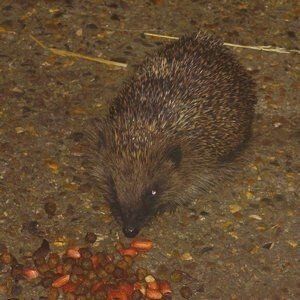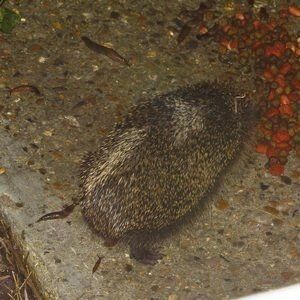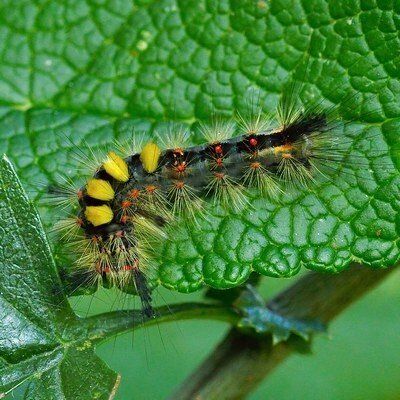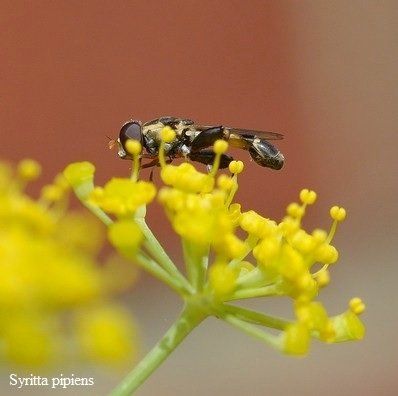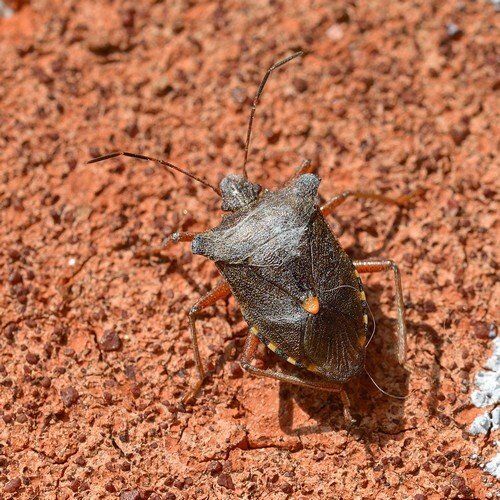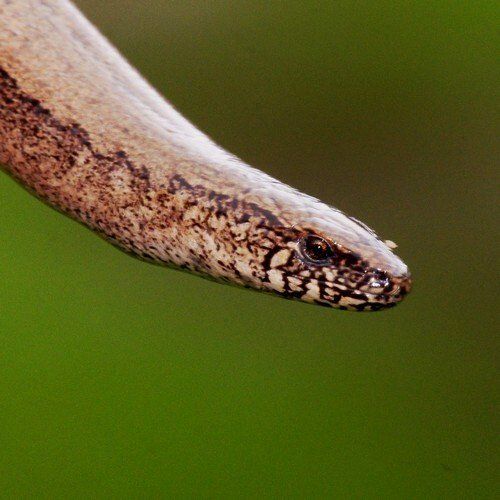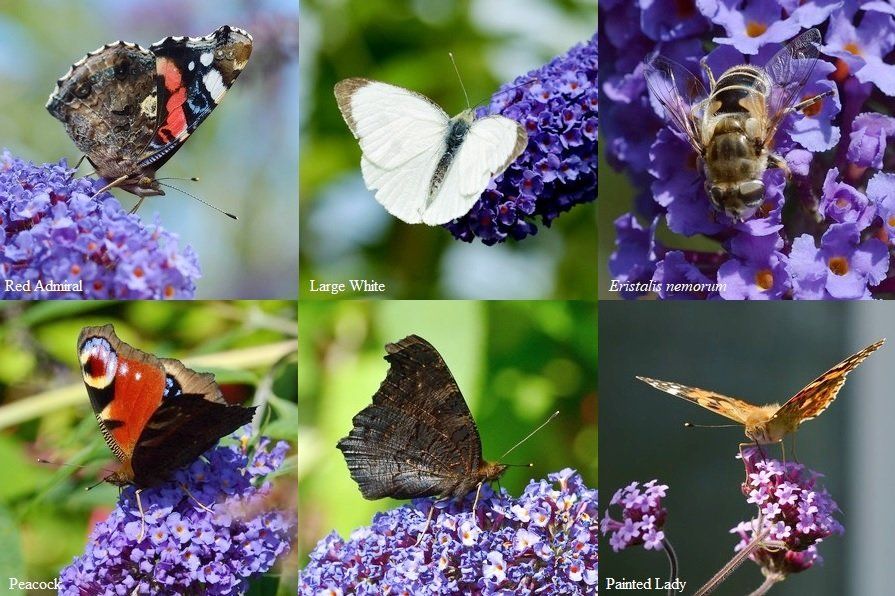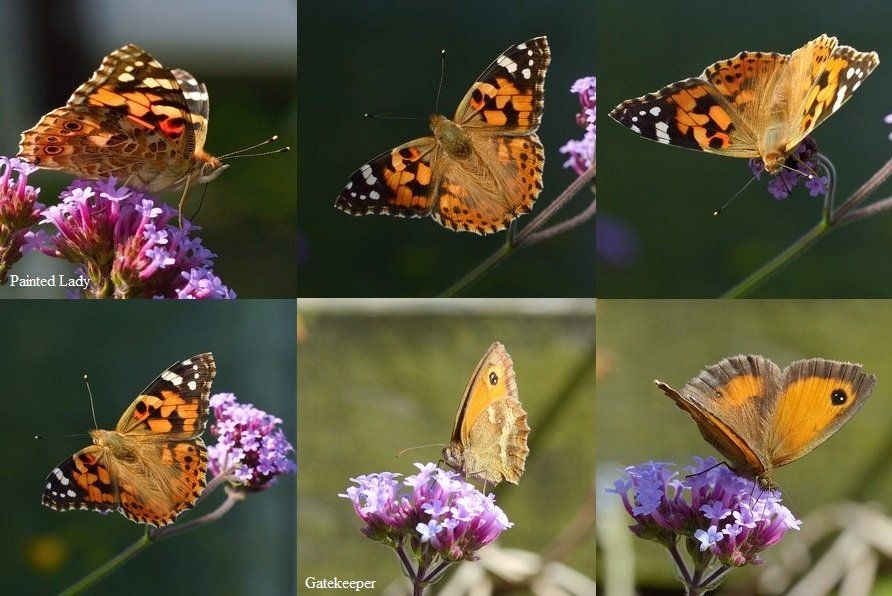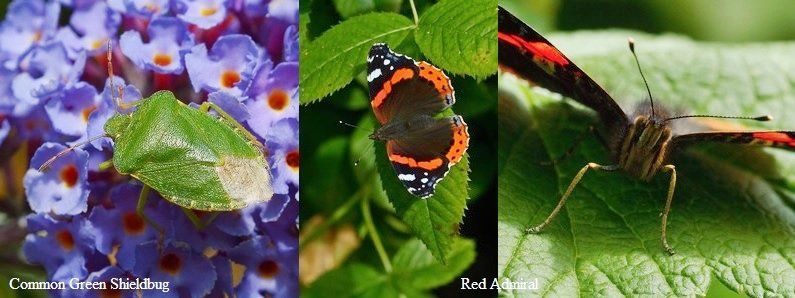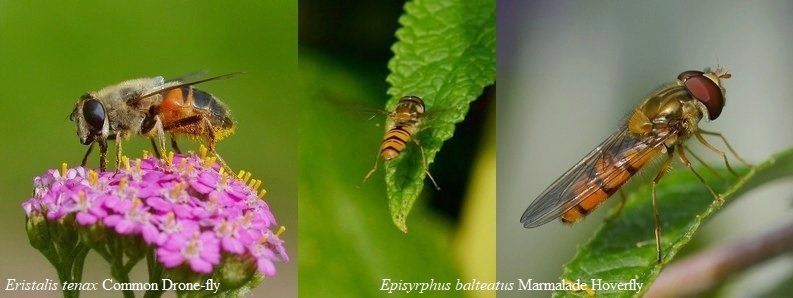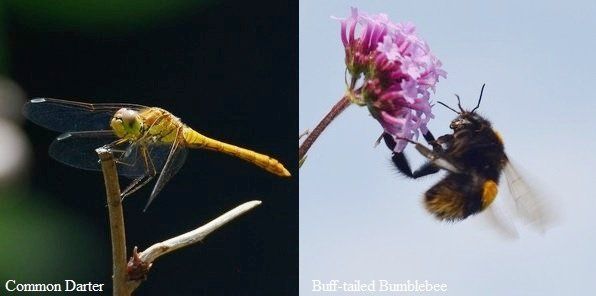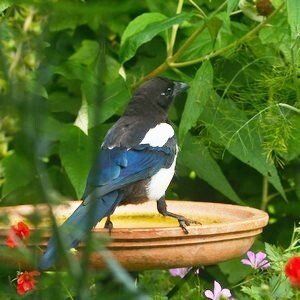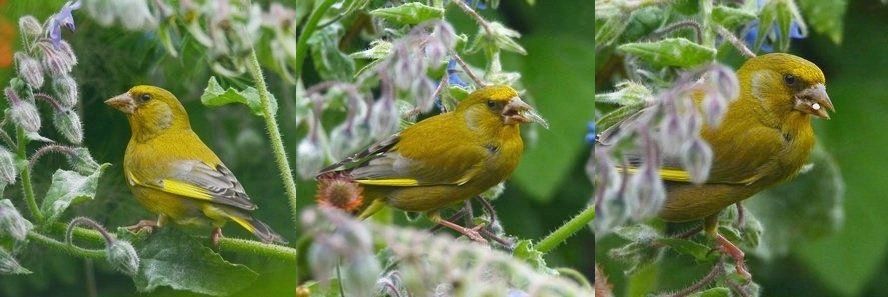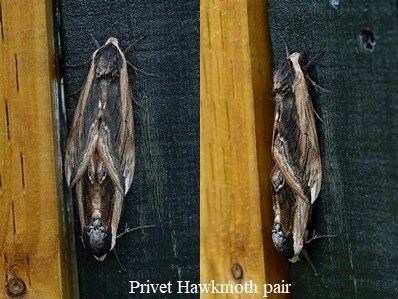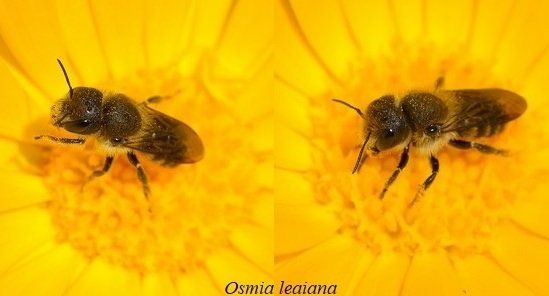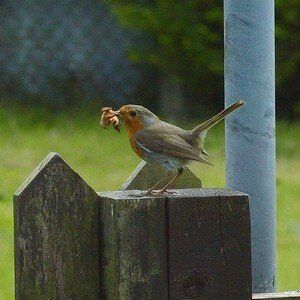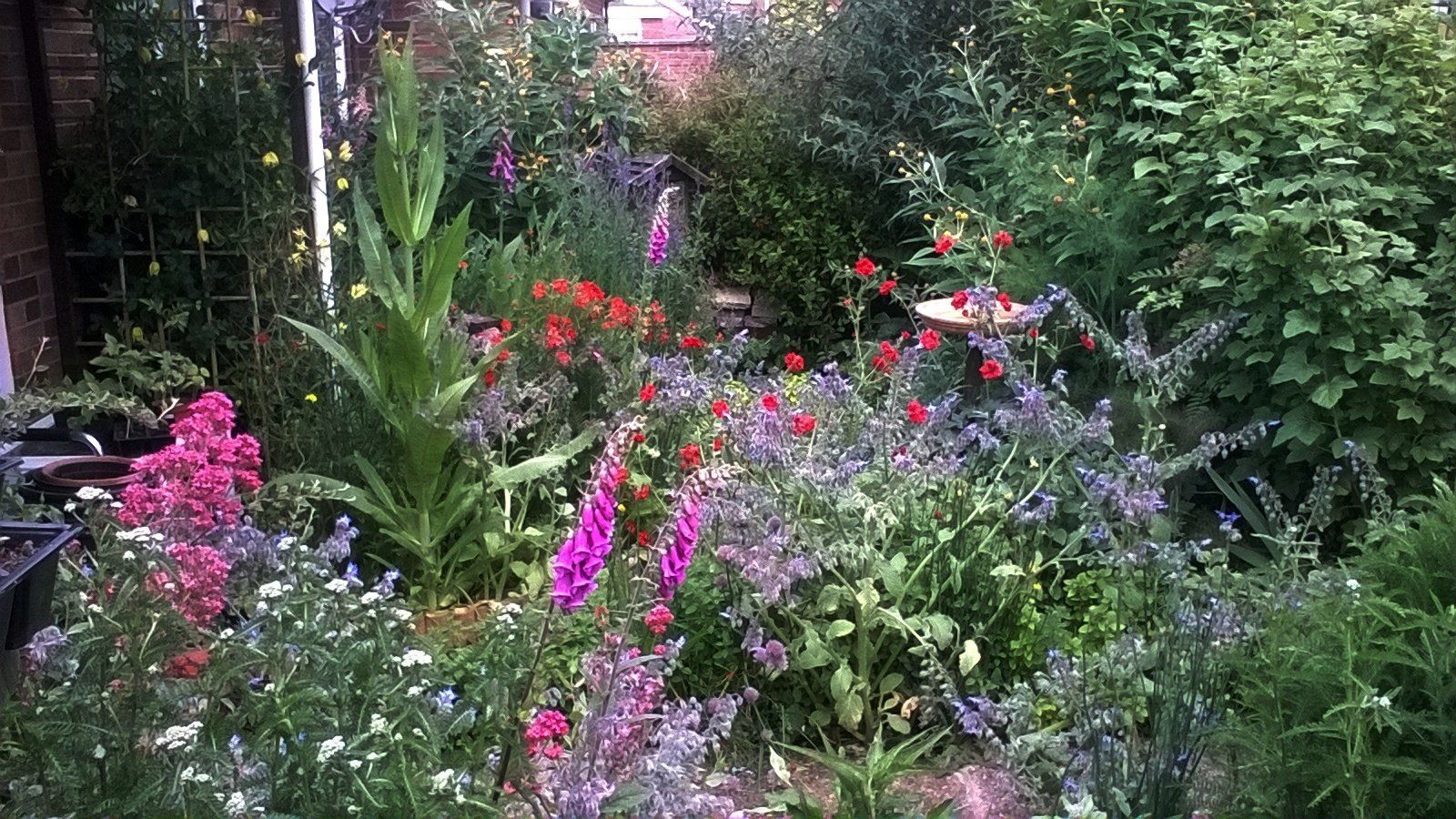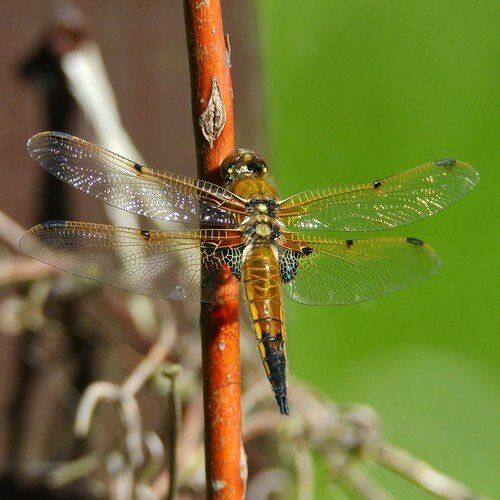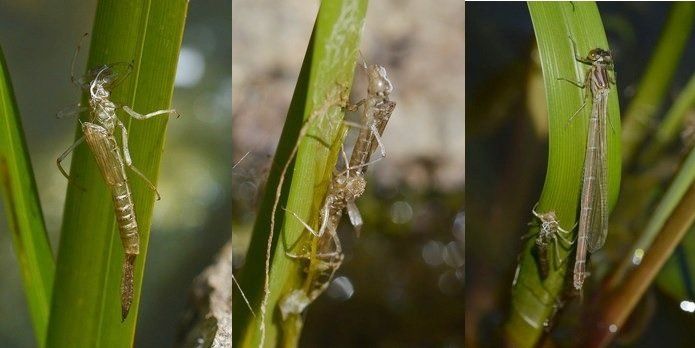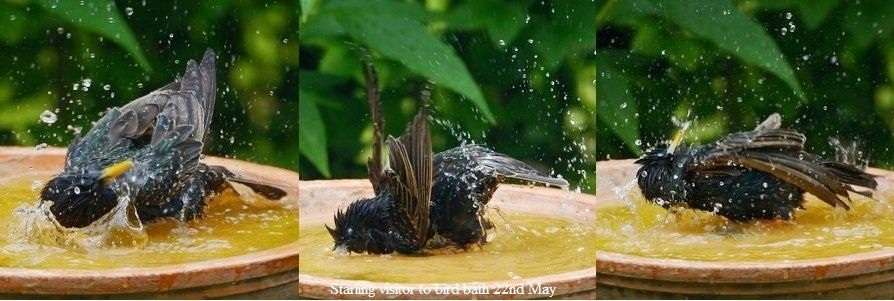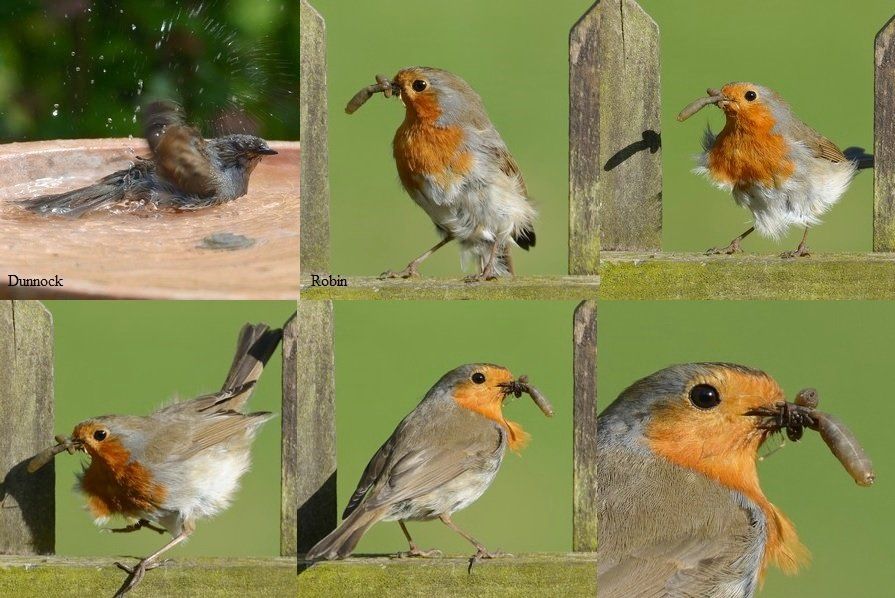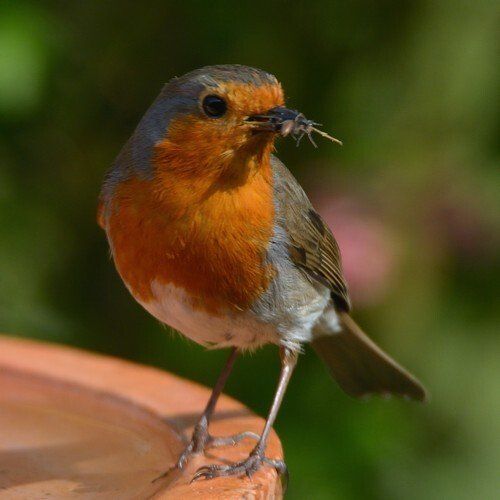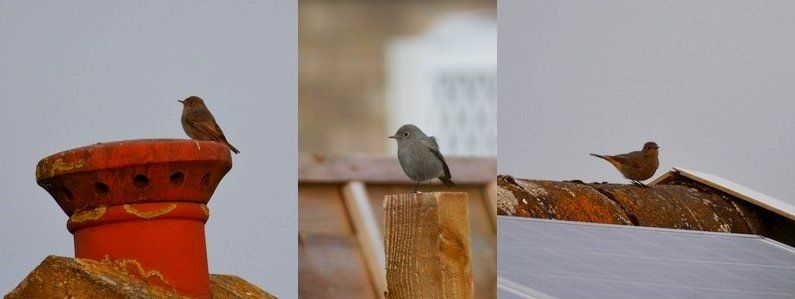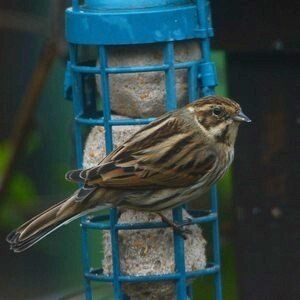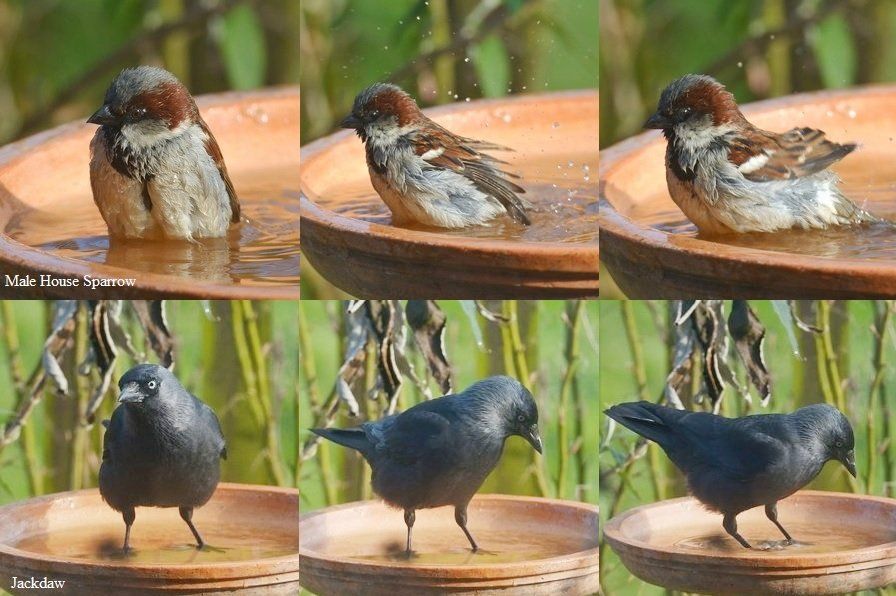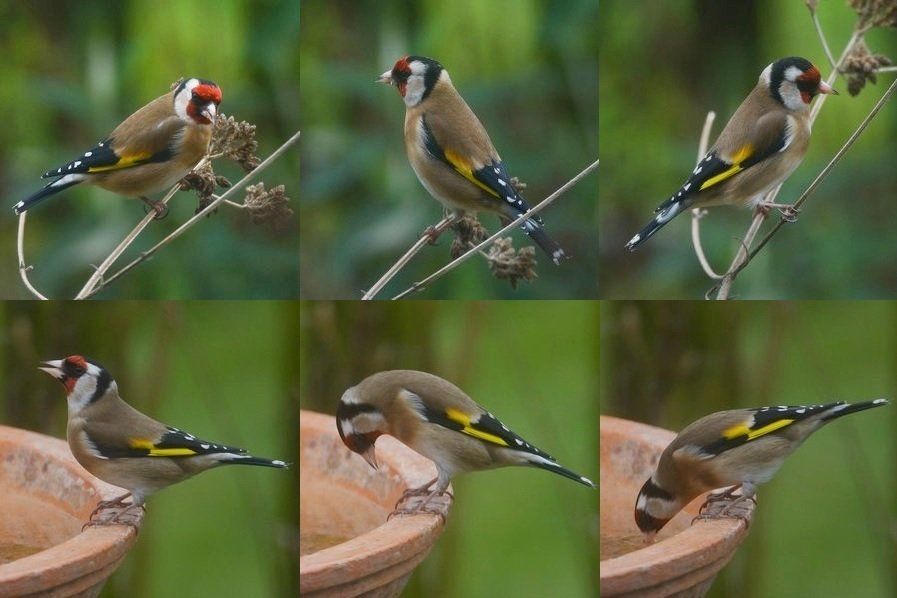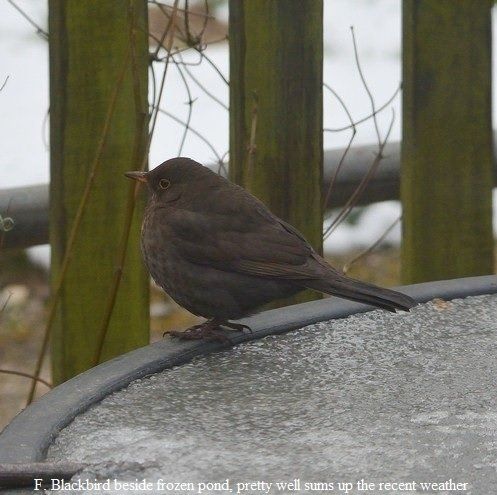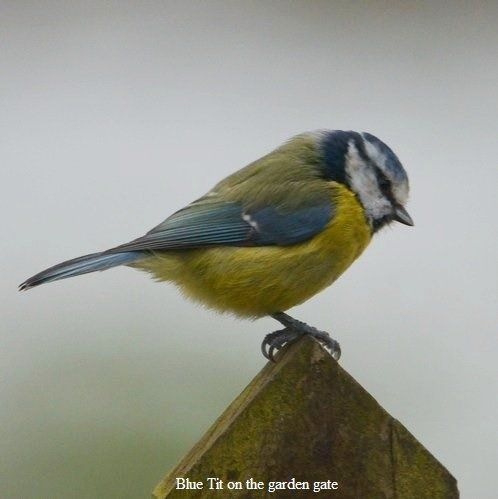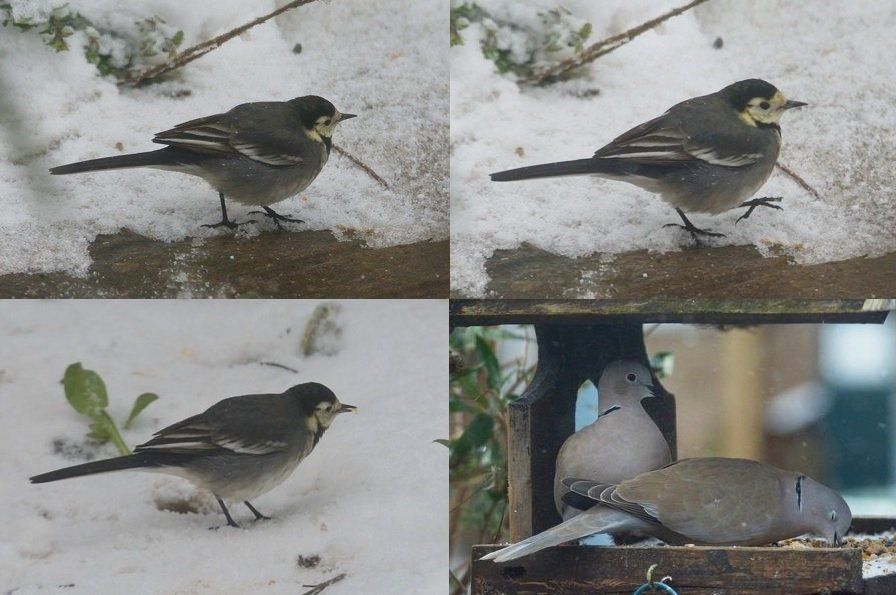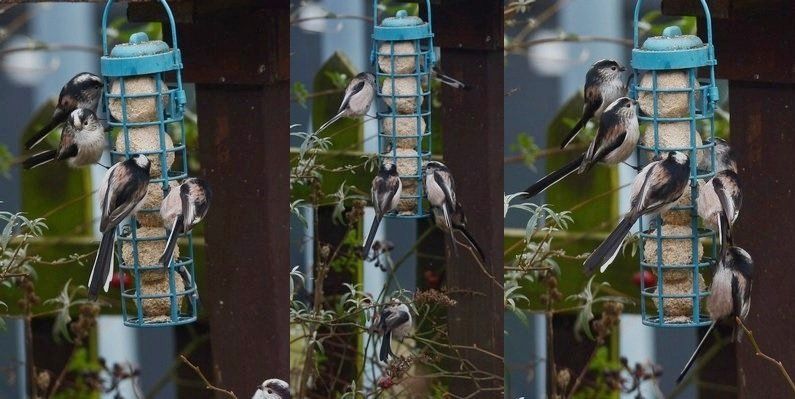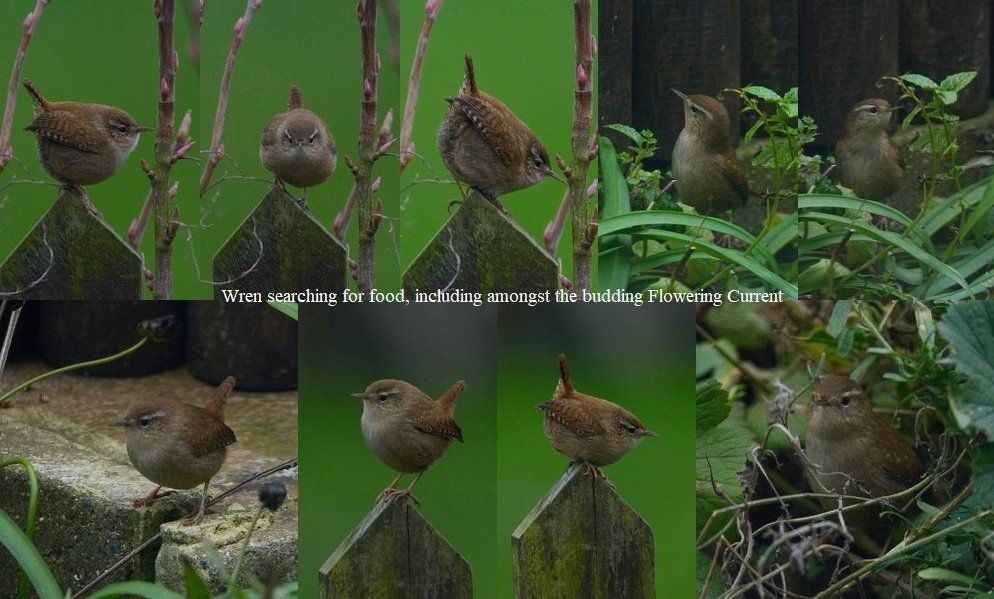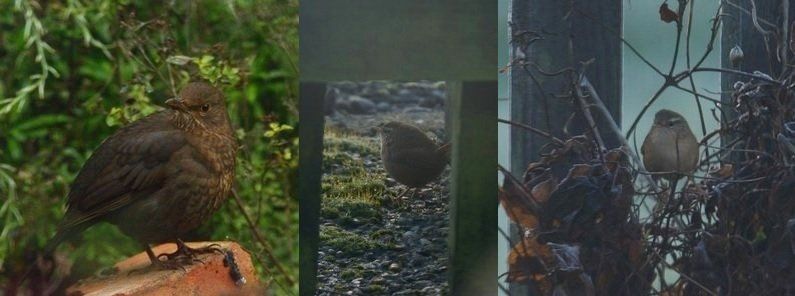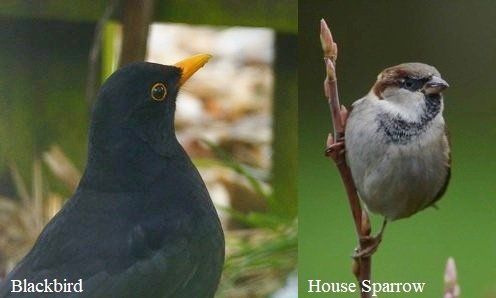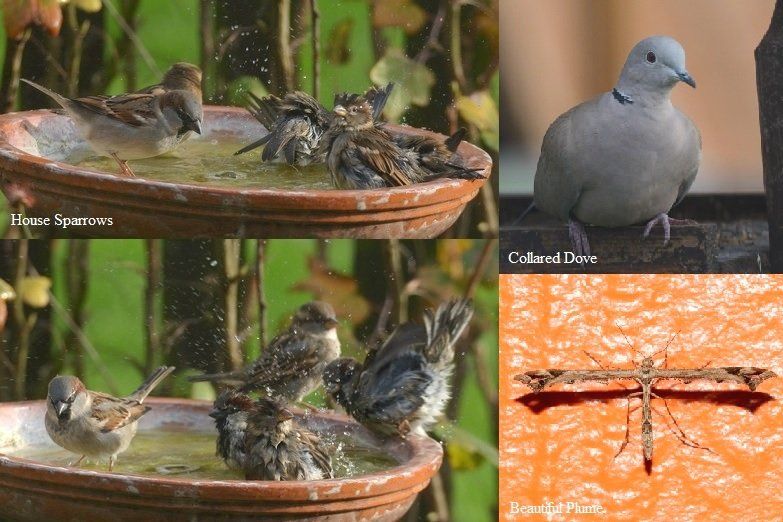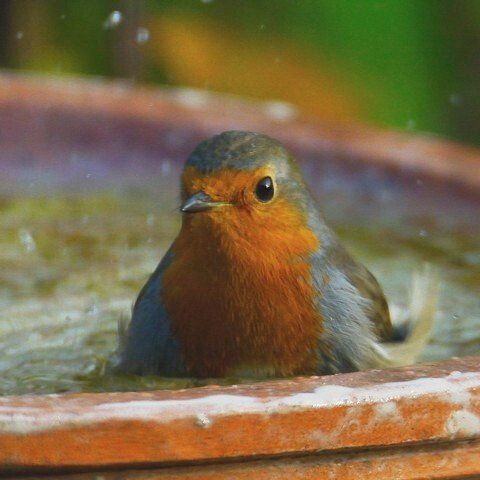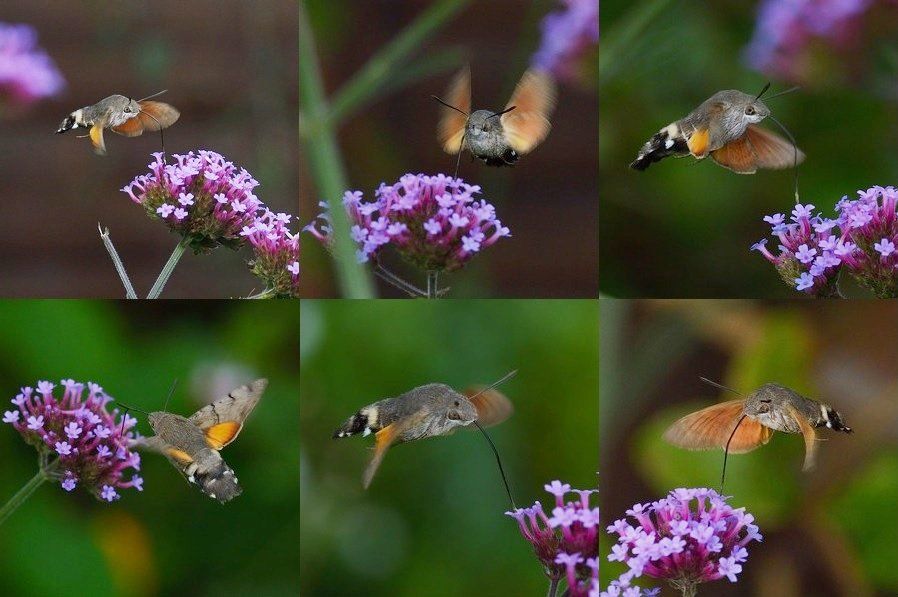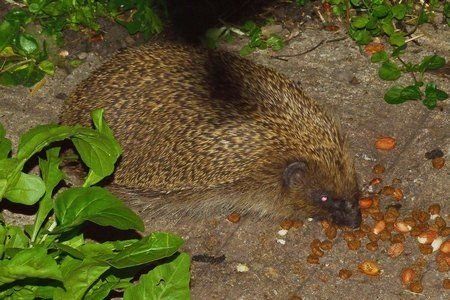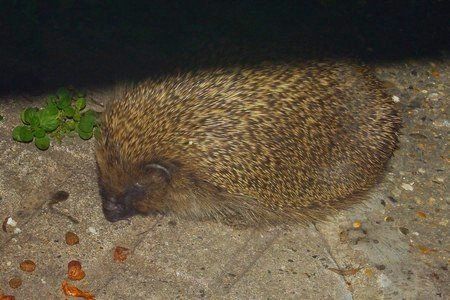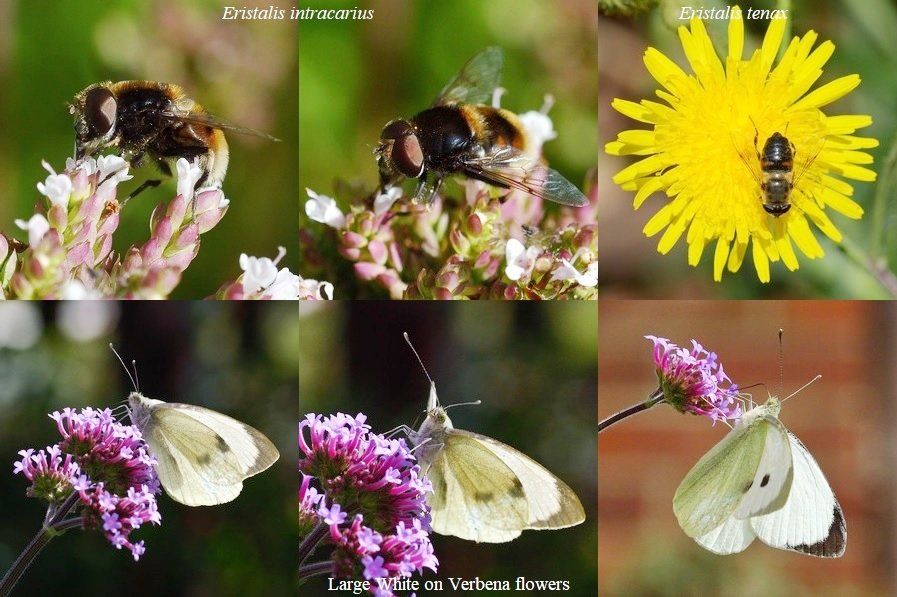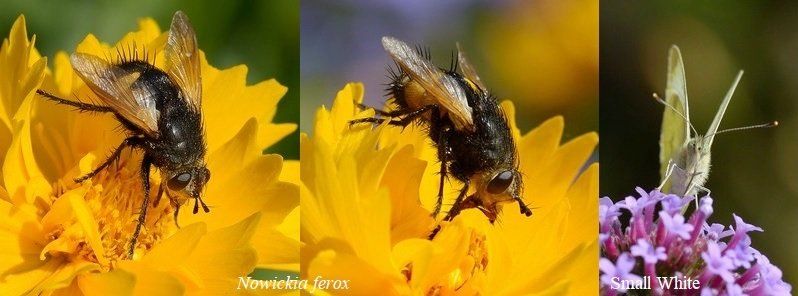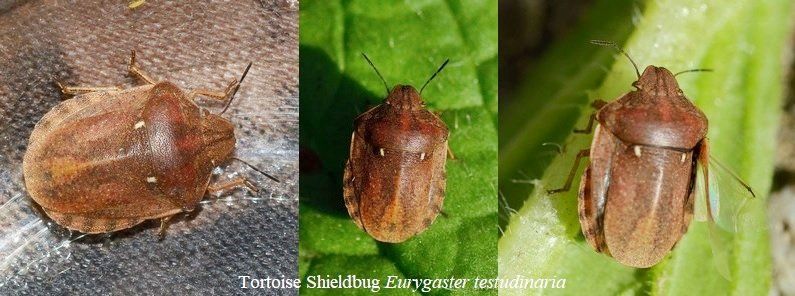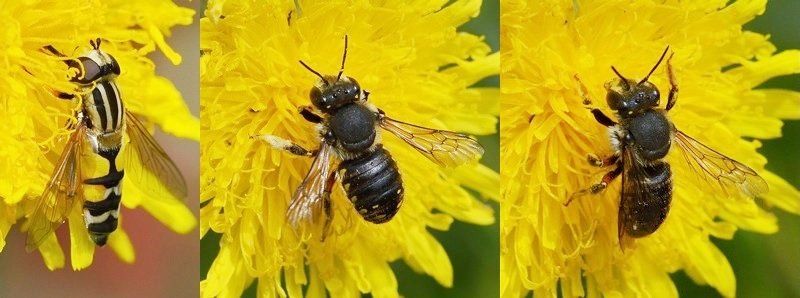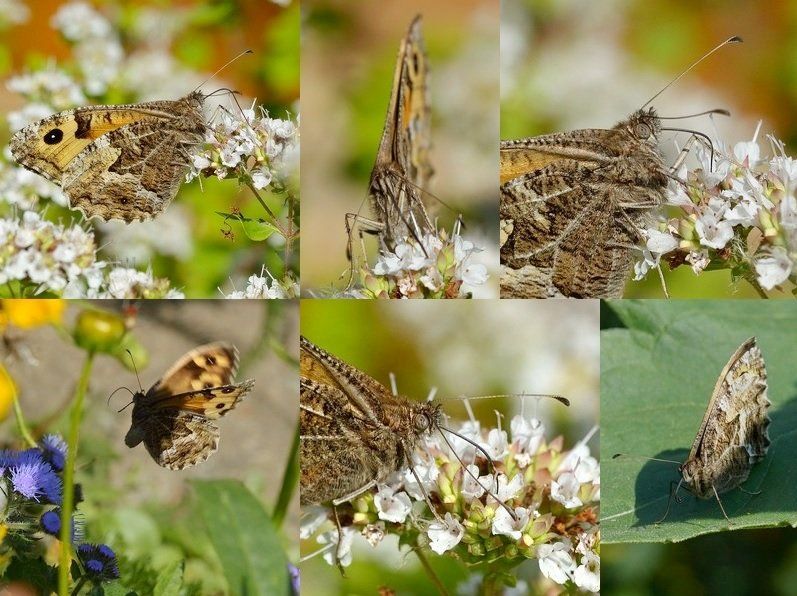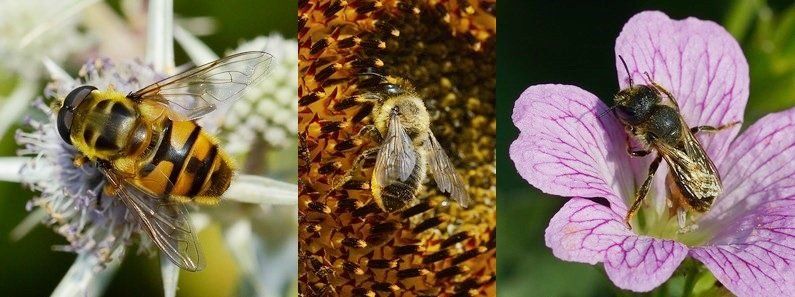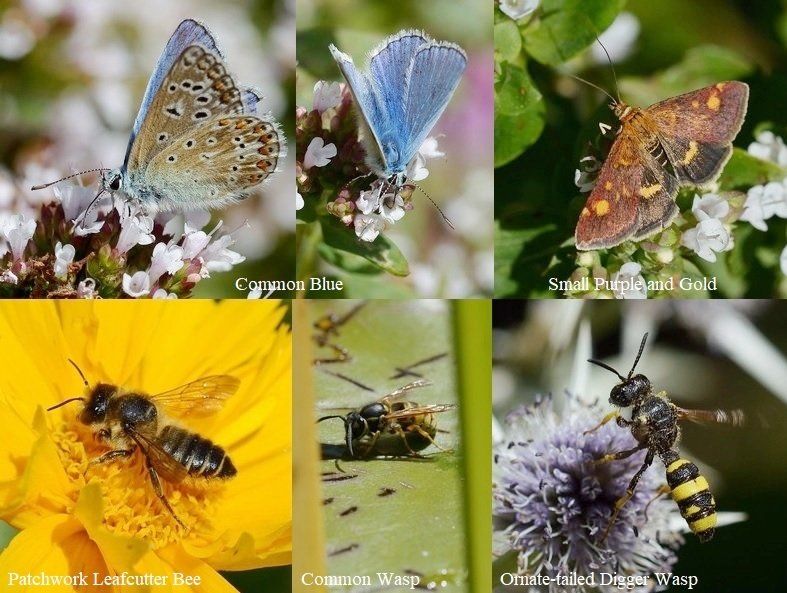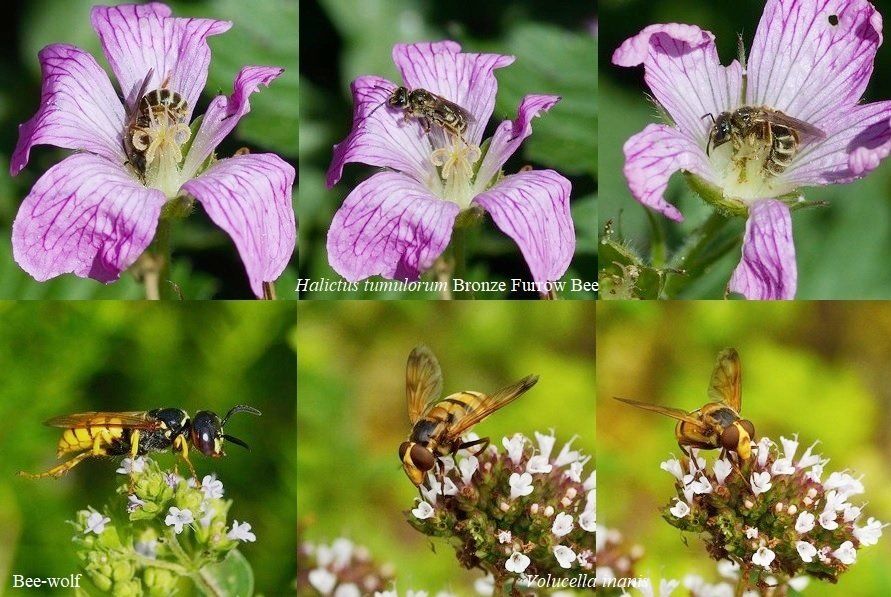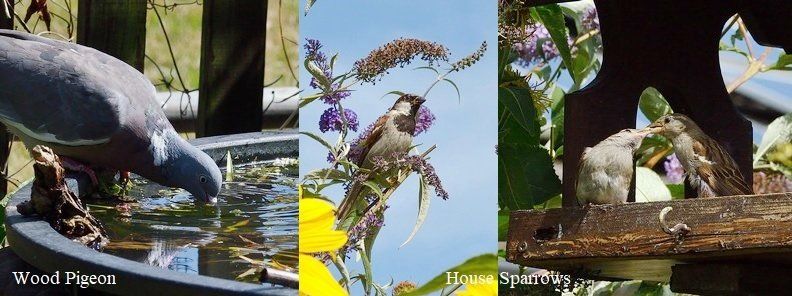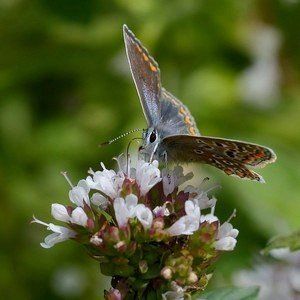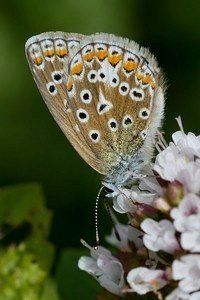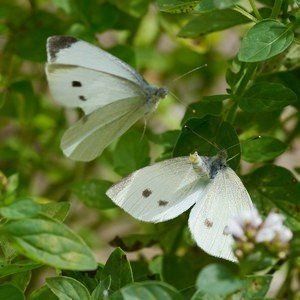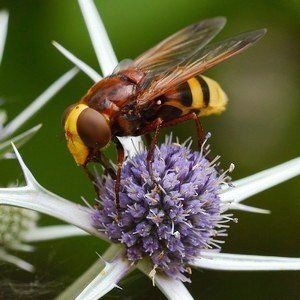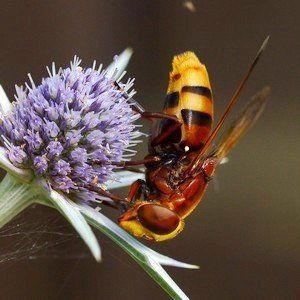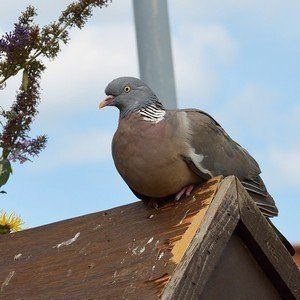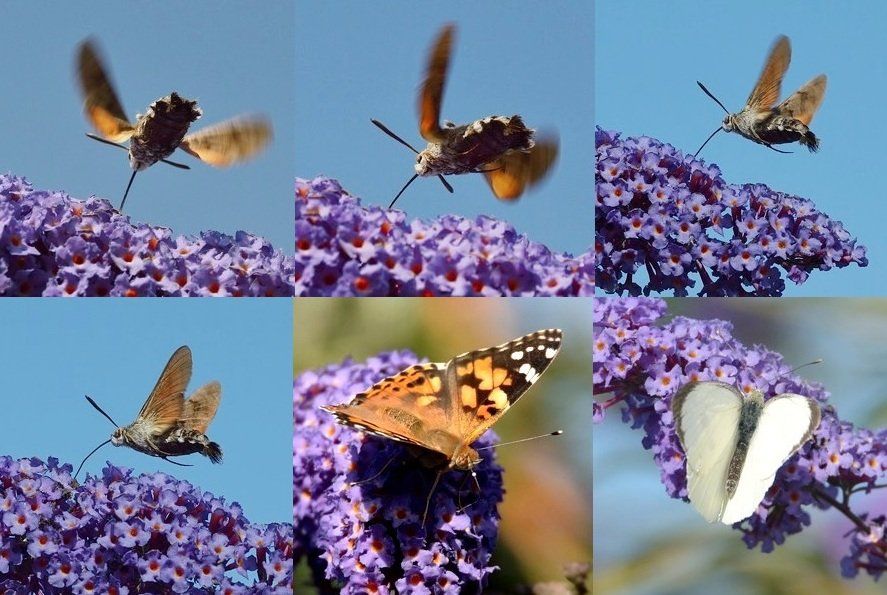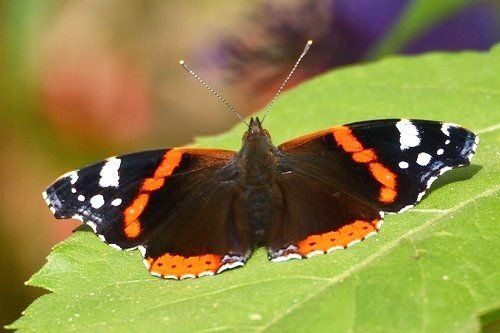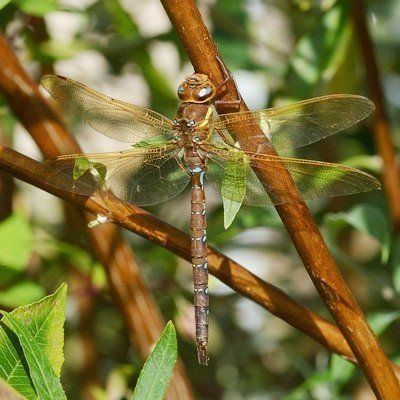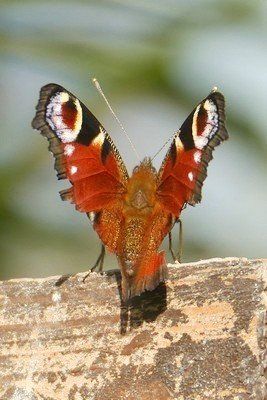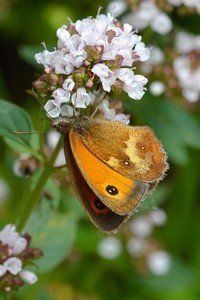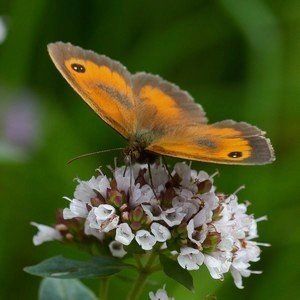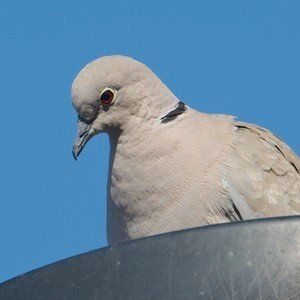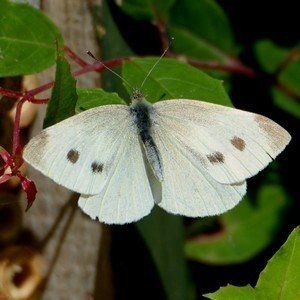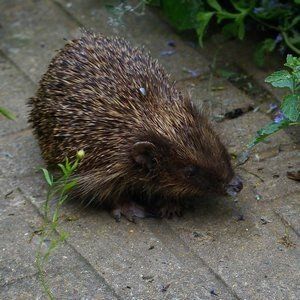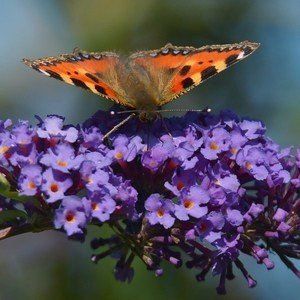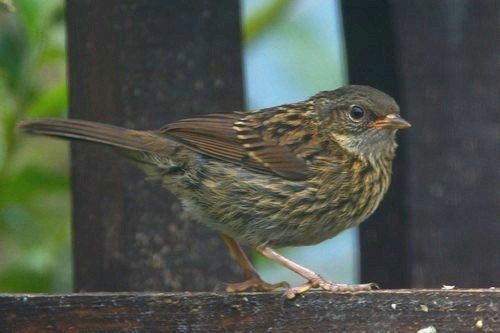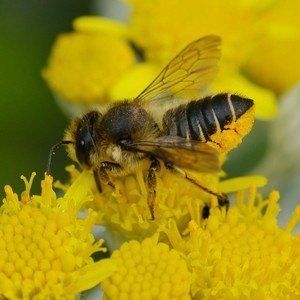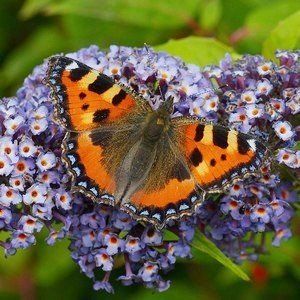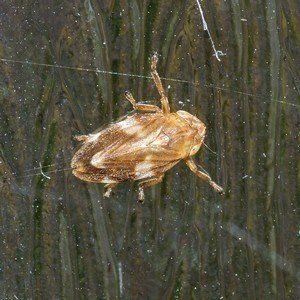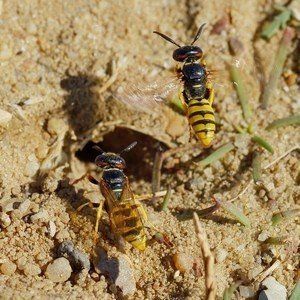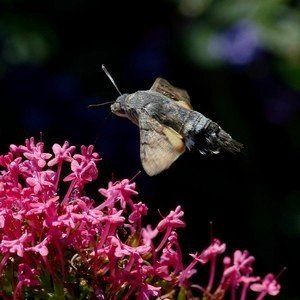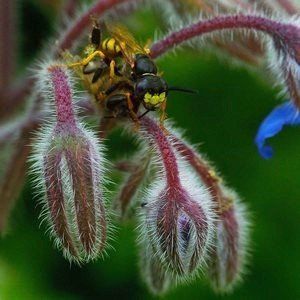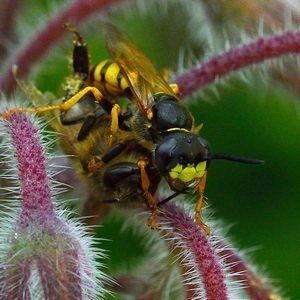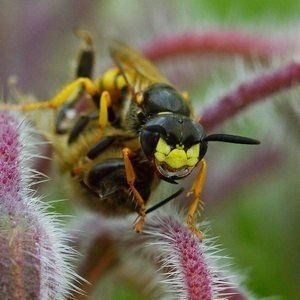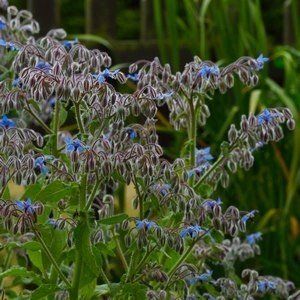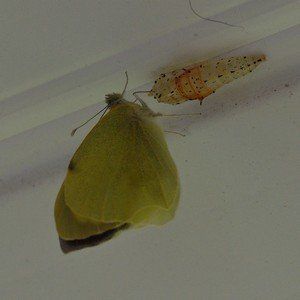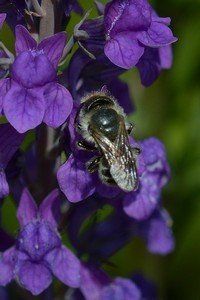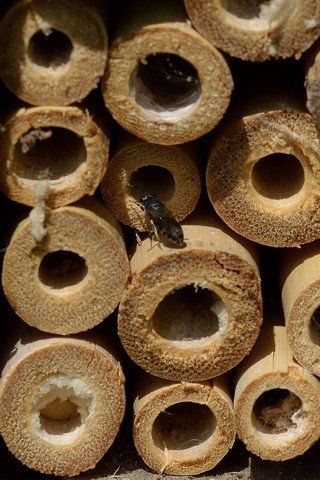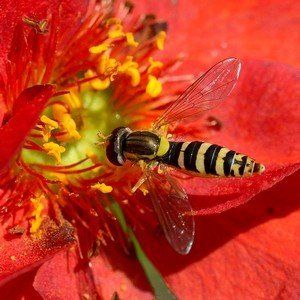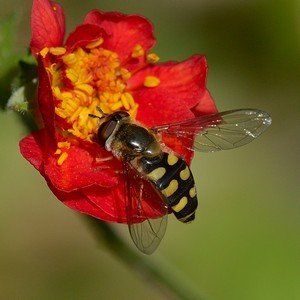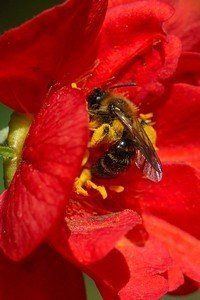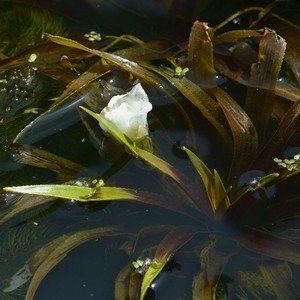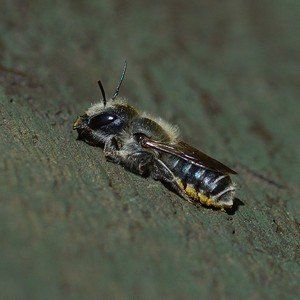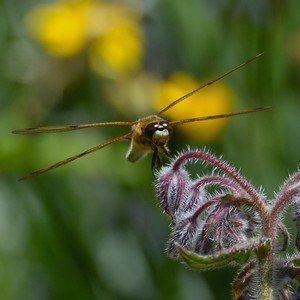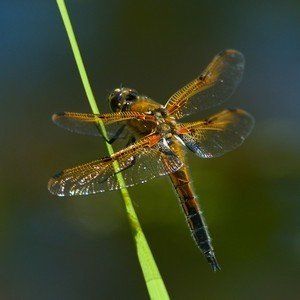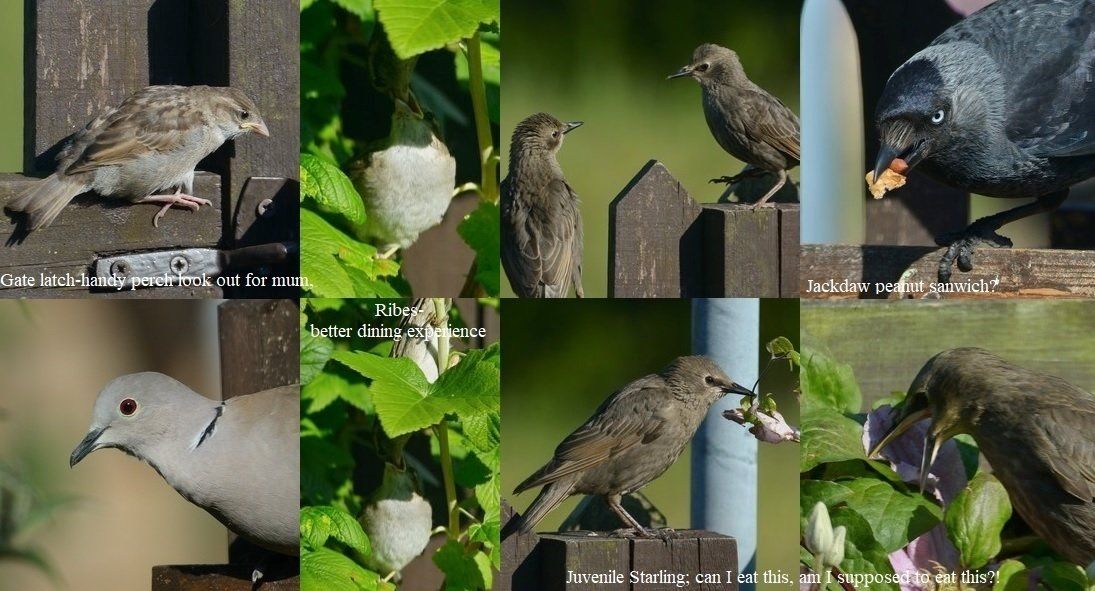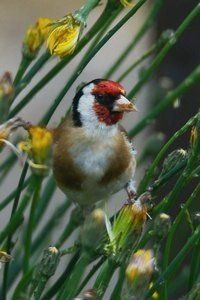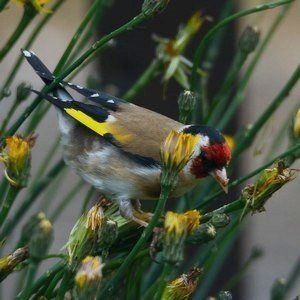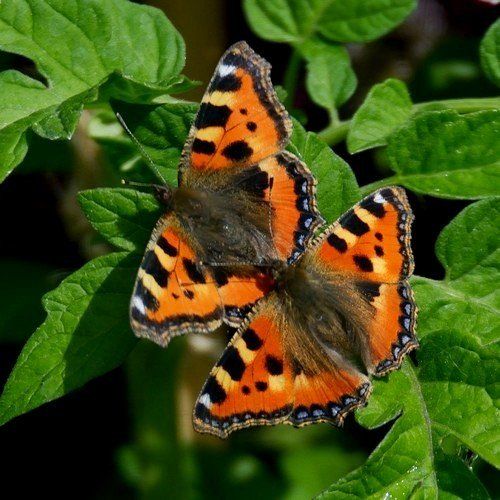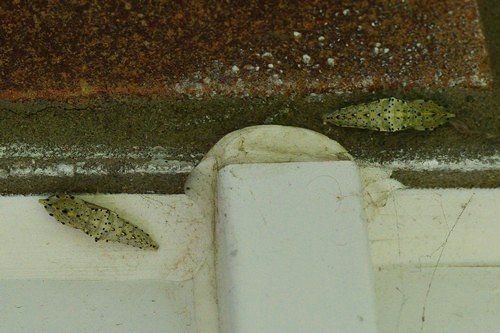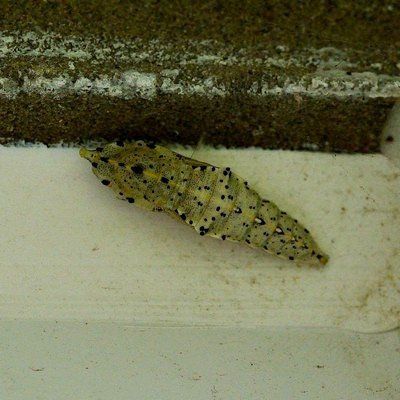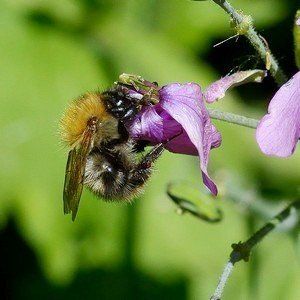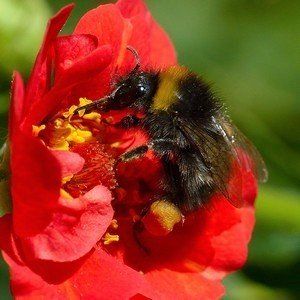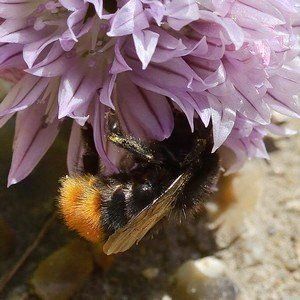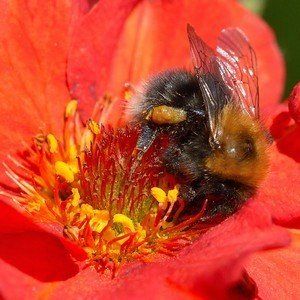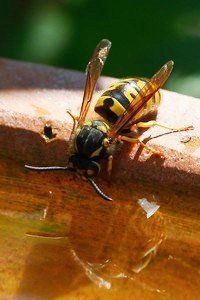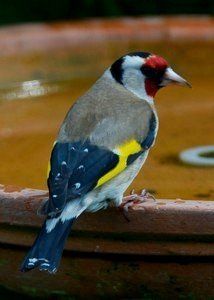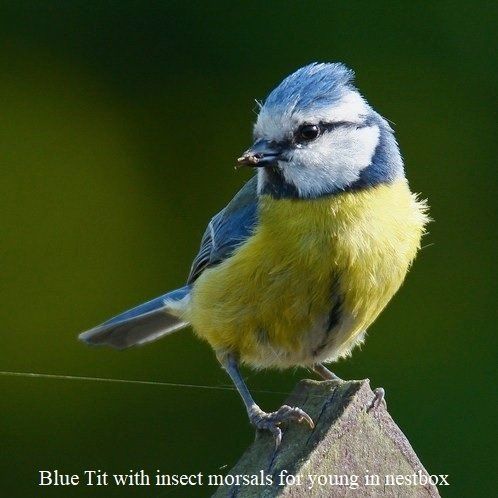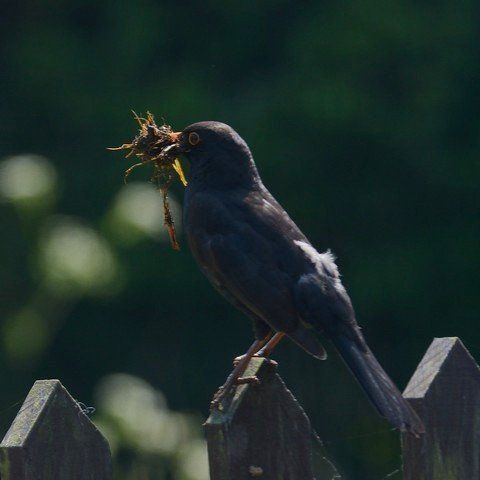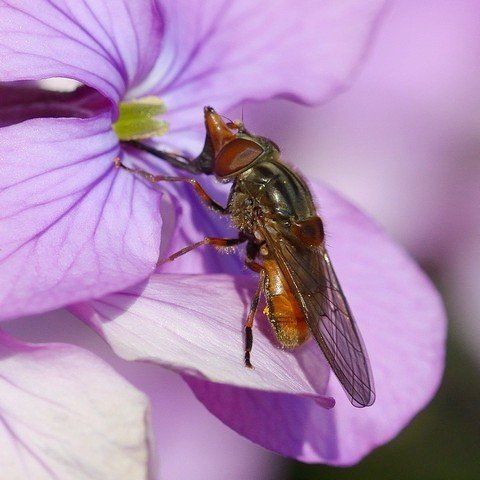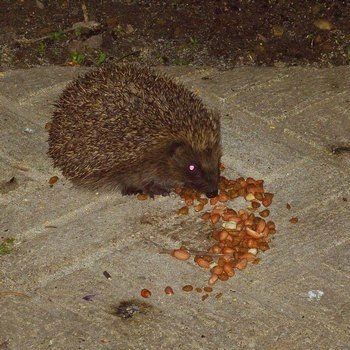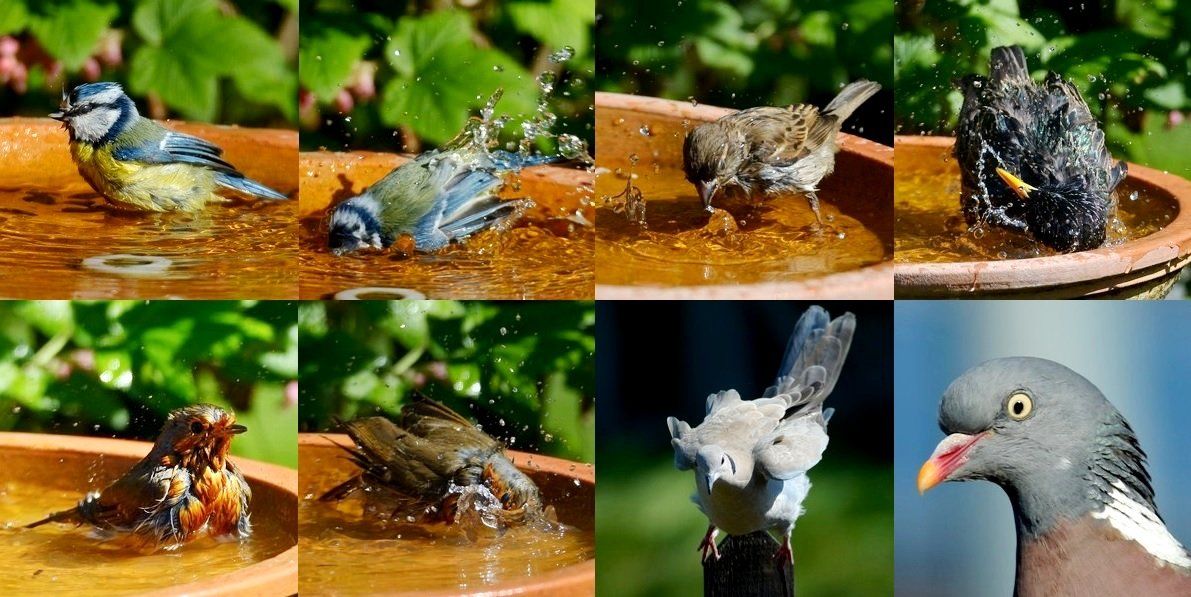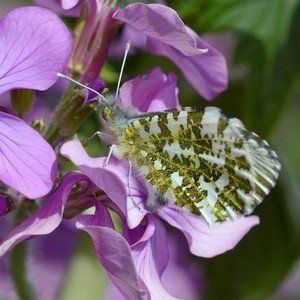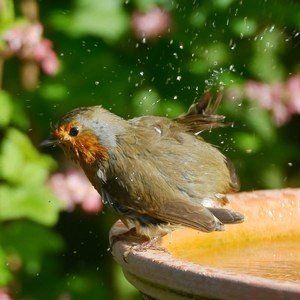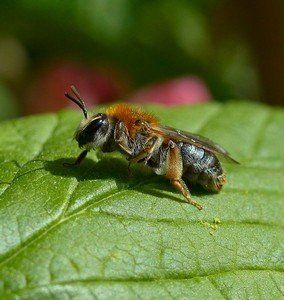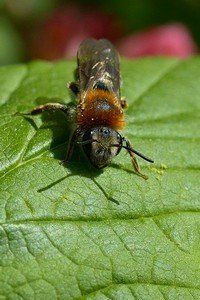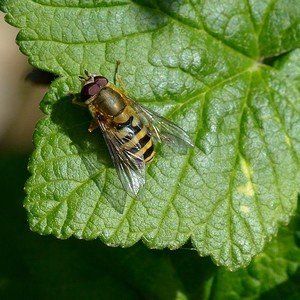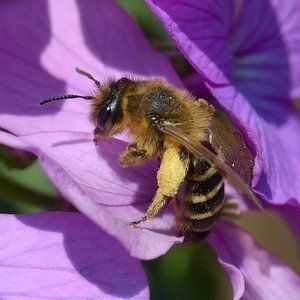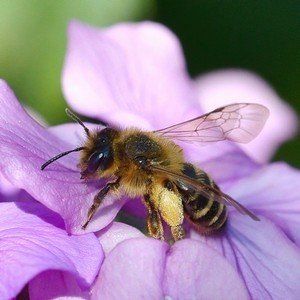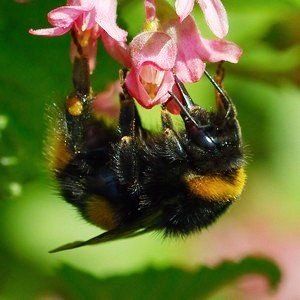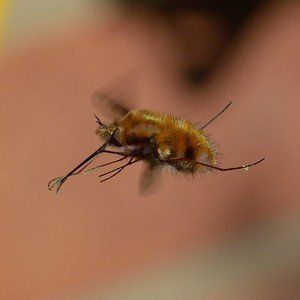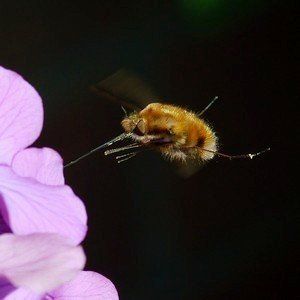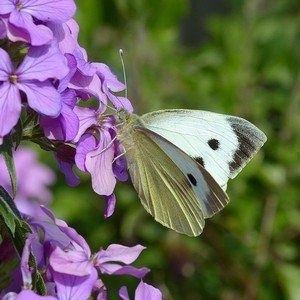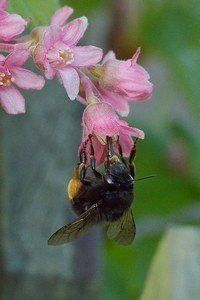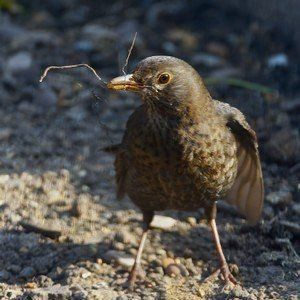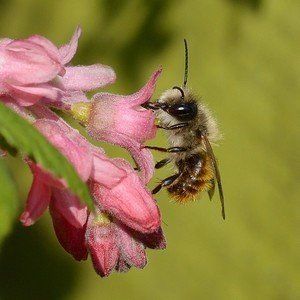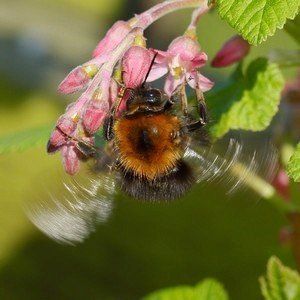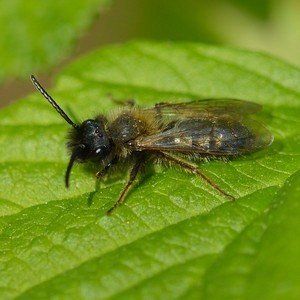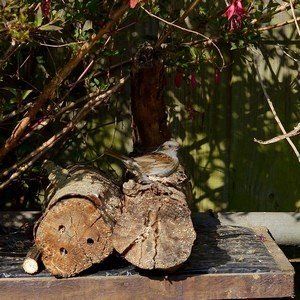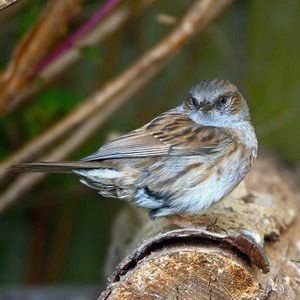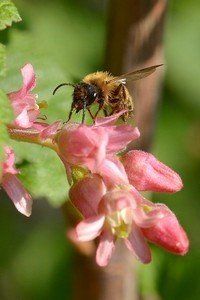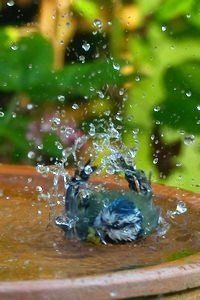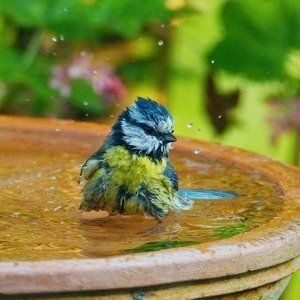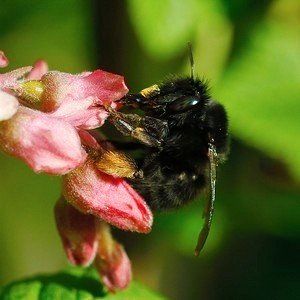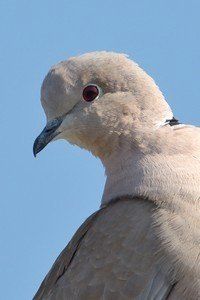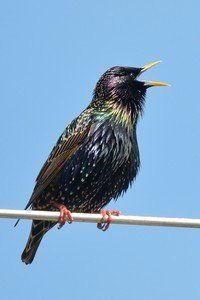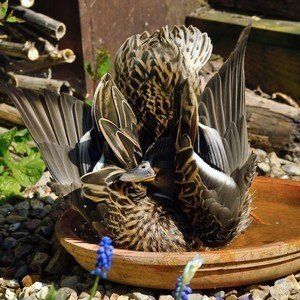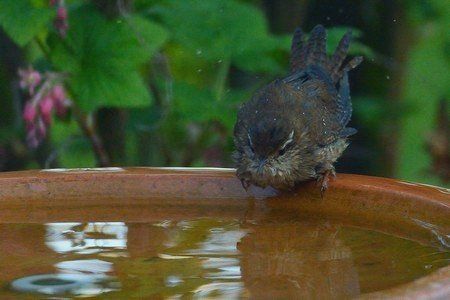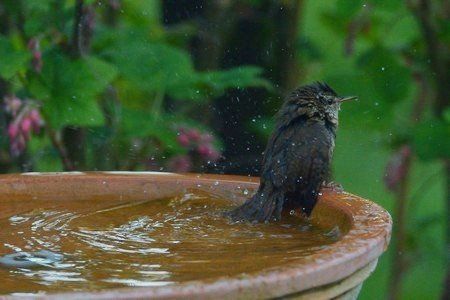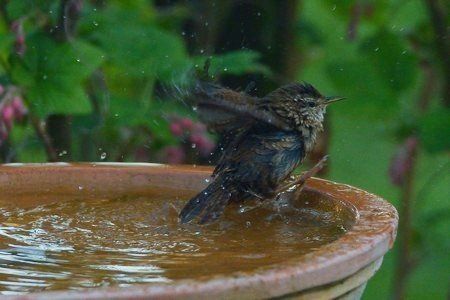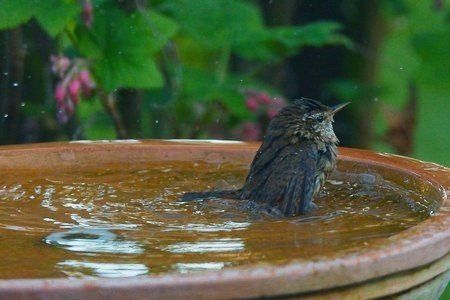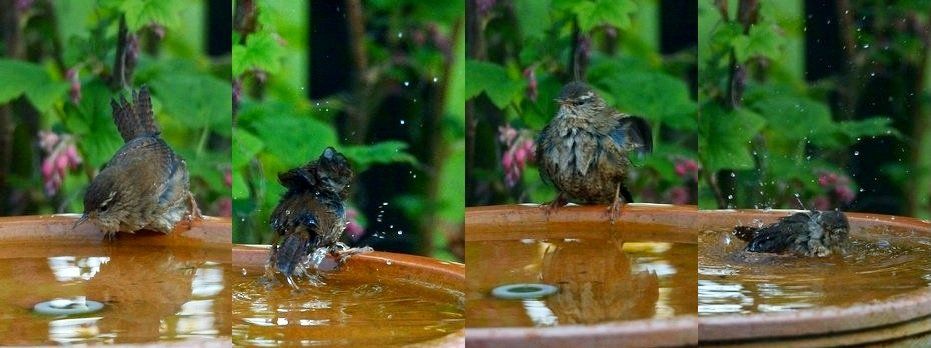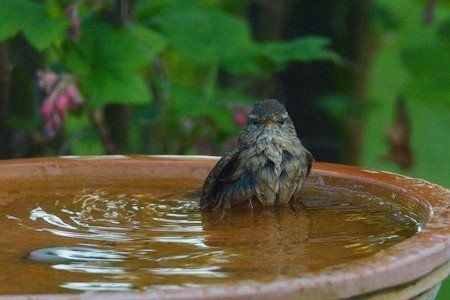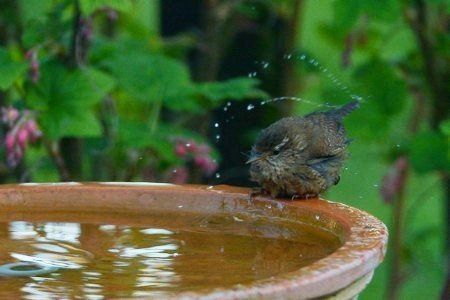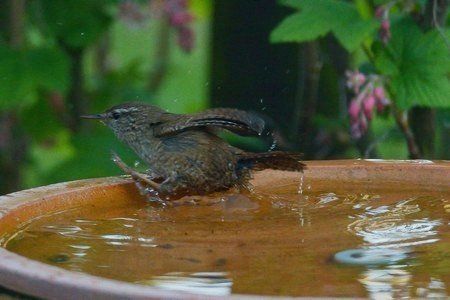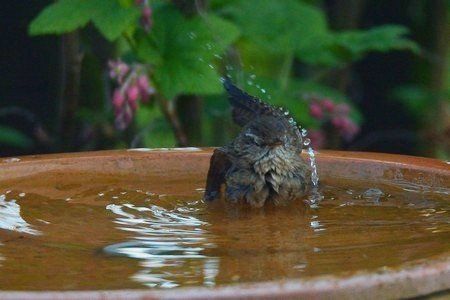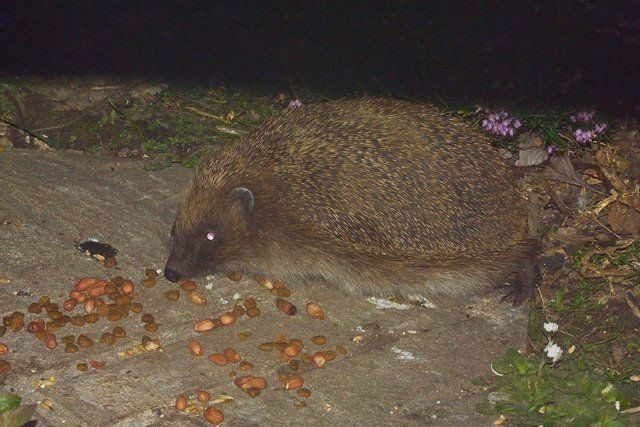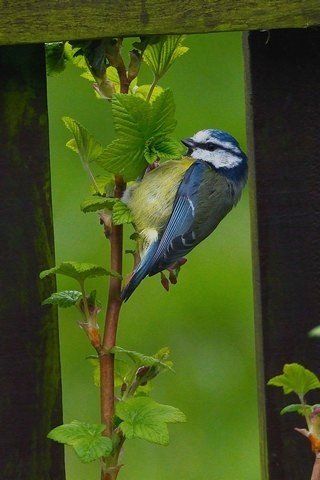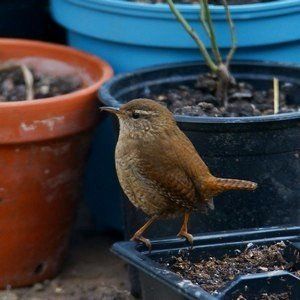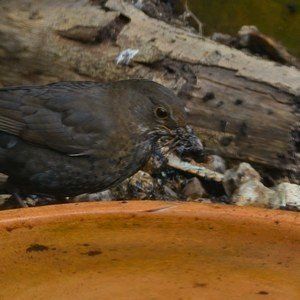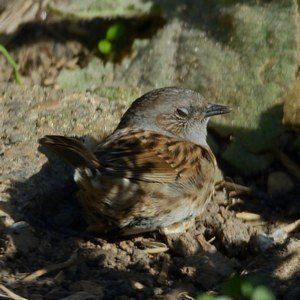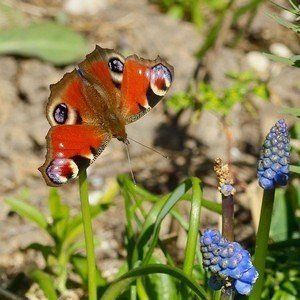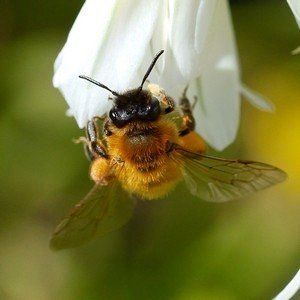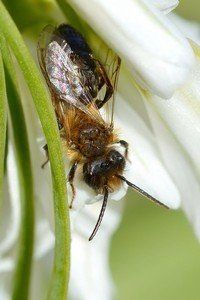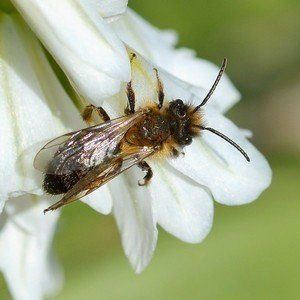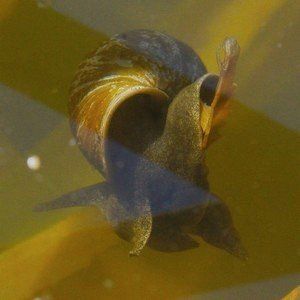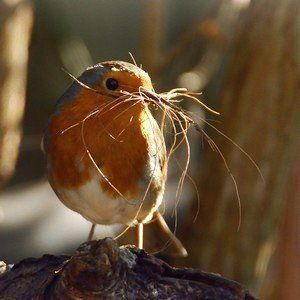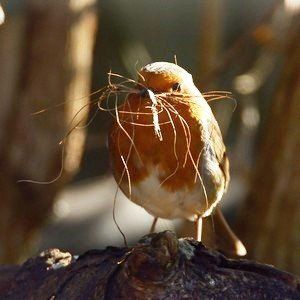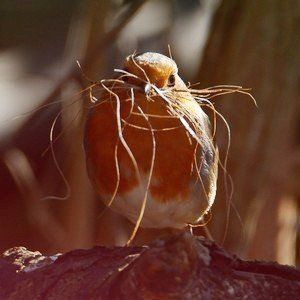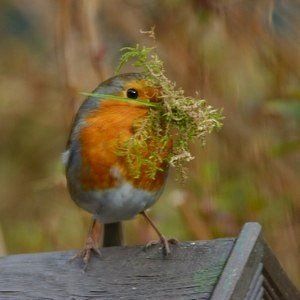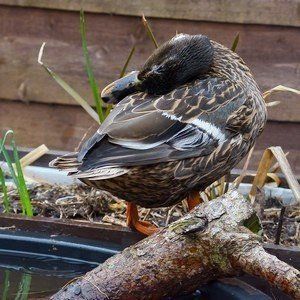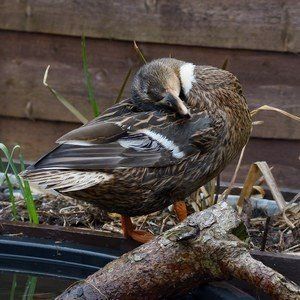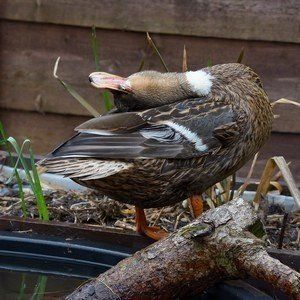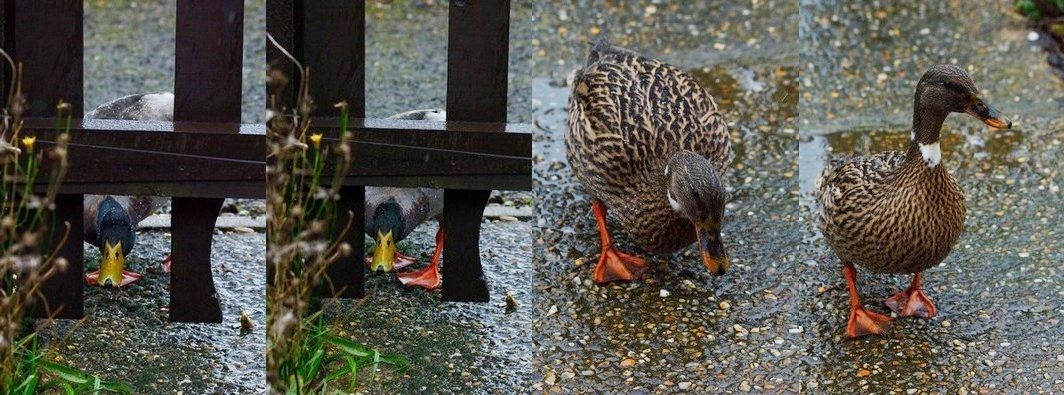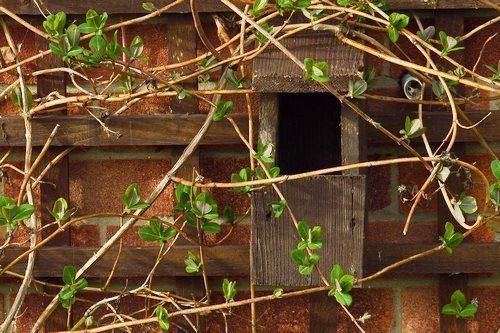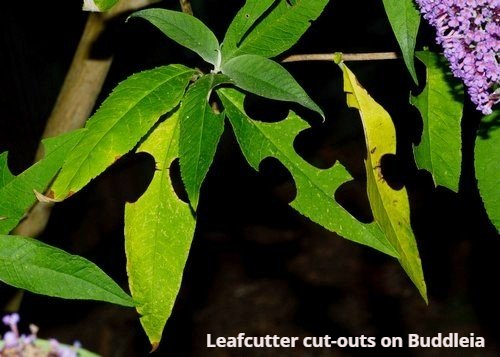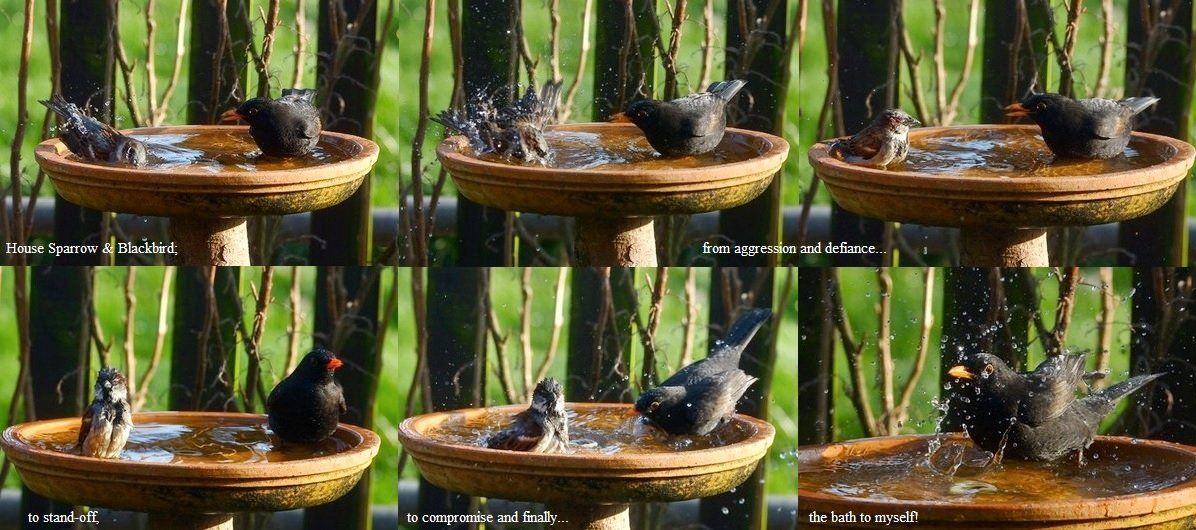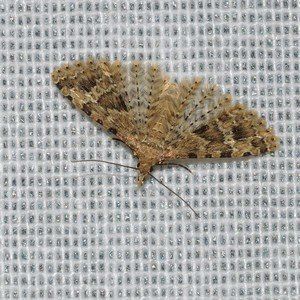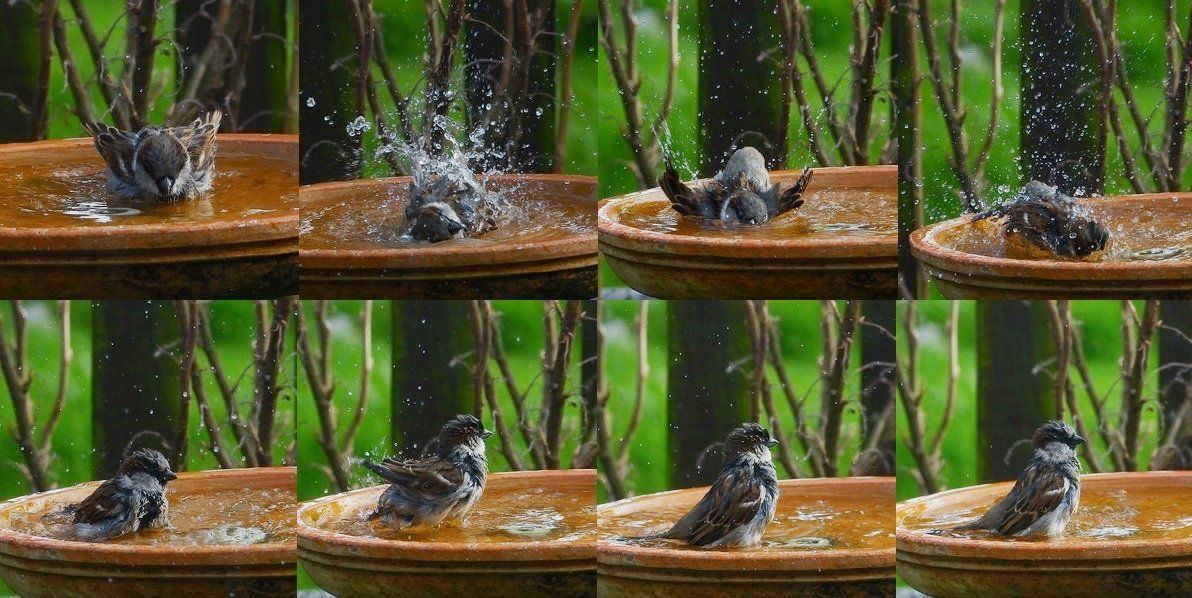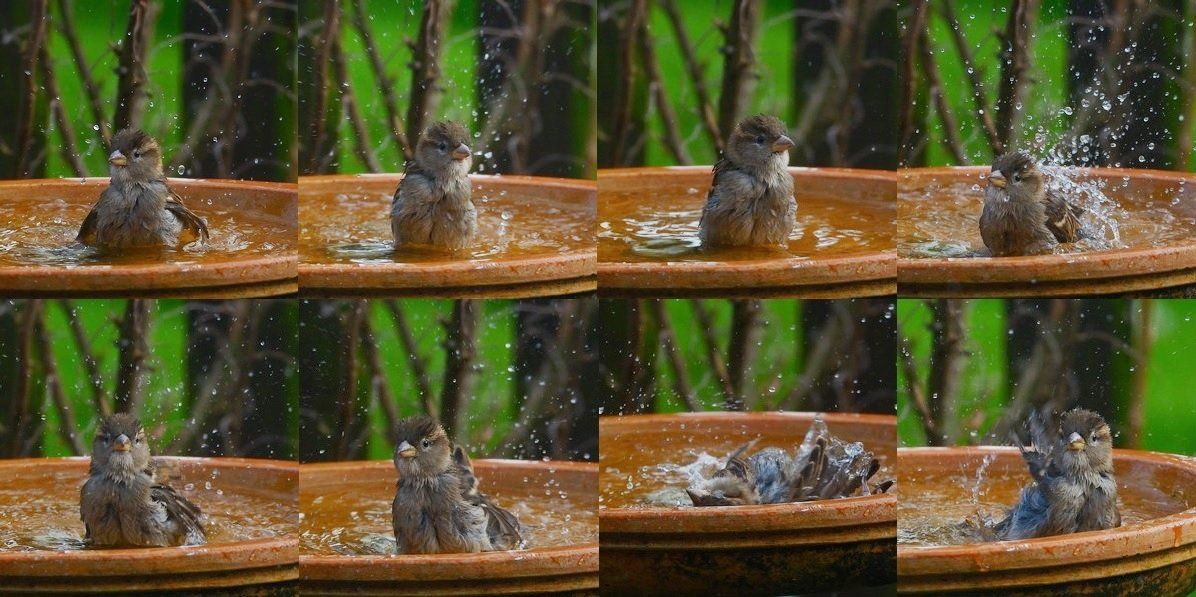
The Wildlife Garden Diary is all about how you can create a garden for wildlife and identify what visits your very own Nature Reserve, which is so, so important. Please see About the Martham Wildlife Garden: The Inherited Garden for the background to the garden and a gallery of the 26 species of Garden Butterflies recorded thus far in 3 Norfolk Gardens.
Wildlife Garden Diary 2024
April 2024
The Red Masons are out, as is the Toad!
The appearance of Osmia bicornis Red Mason Bees (at least 2) entering the Bee hotel were the first of the year (14th).
A/the female Common Toad was seen out on the bark path before going into one of the borders.
A male Orange-tip flying through the garden was a first for the year and again 2 Holly Blue were present.
2 Holly Blues and Tawny Mining Bee again......
2 Holly Blue was in the garden (13th) and 2 Great and 2 Blue Tits were of note.
A female Tawny Mining Bee (right) was again on the Flowering Currant.
Heron over......
A female Tawny Mining Bee was again present (12th), as were Hairy-footed Flower Bees, Holly Blue and a Peacock was seen out the front of the property.
2 Great and 2 Blue Tits were also present.
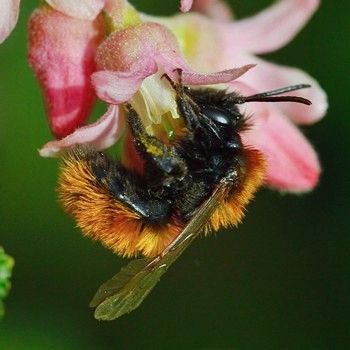
First Tawny Mining Bee......
A female Andrena fulva Tawny Mining Bee was the first for the year in the Flowering Currant (11th). Buffish Mining Bees were also seen as were Hairy-footed Flower Bees, Early and Buff-tailed Bumblebees, Holly Blue.
A Blue Tit was seen flying up to the central nestboxes on the side of the shed, so hopefully will nest again.

Mrs. Toad moves home!
A Holly Blue was once again present (8th) and a Great Tit was of note.
Under the directions of Mike (Linley) the female Common Toad was moved to another home so important planting could take place in the northern side of the garden.
The home was very much the same environment where the Toad seemed to have made her home, amongst the broken pieces of slabs on top of the Hedgehog box, that also needs replacing now.
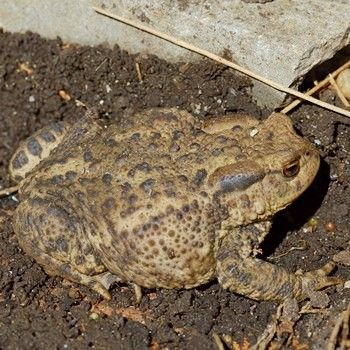

The Buffish Mining Bee's cleptoparasite arrives!
A ‘small’ white butterfly flitted through the garden (7th) possibly a Green-veined White an undersized Red Admiral also visited as did the first Holly Blue of the year.
Both male and female Hairy-footed Flower Bees were seen as were male and female Buffish Mining Bees. Early, Buff-tailed and Carder Bumblebees were also present as was a Tapered Drone-fly.
A male Nomada goodeniana Gooden’s Nomad Bee was visiting the Lungwort its presence somewhat opportunistic as Buffish Mining Bees are the host of this cleptoparasitic bee.
2 Great Tits continued their presence and Blue Tit, 3 Wood Pigeon, 6+ House Sparrow, 2 Blackbird, 3 Starling, 2 Collared Dove and a Dunnock were also seen.

Are the Great Tits going to nest?
2 Great Tits were present once again (6th); are they going to nest in the so far unused nestbox in the northern end of the garden or indeed in next door’s nestbox, which I installed some time ago?
Blue Tit, 2 Dunnock, 6 House Sparrow, 2 Blackbird and 2 Wood Pigeon were also seen.
Hairy-feet busy at the mud brick hotel and favouring 3-cornered Leek flowers......
2 Great Tit were once again present (5th) along with Blue Tit, 2 Blackbird (male and female), 3 Wood Pigeon, 7 House Sparrow and Starling.
Female Hairy-footed Flower Bees were favouring the Three Cornered Leek flowers over the Flowering Currant and there were a lot of earthworks going on in their mud brick bee hotel. Carder and Buff-tailed Bumblebees and Honey Bees were also seen.
Possible record of Wood Pigeons in garden......
6 Wood Pigeons were tolerating each other in the garden (4th). Also present were: Starling, 7+ House Sparrow and Blue Tit.
Flowering Currant being favoured by Bees......
A Carder 2 Buff-tailed and 2 Early Bumblebees sought food in the Flowering Currant flowers (1st). A female Hairy-footed Flower Bee was around the mud bricks, a Buffish Mining Bee was also seen and a Common Wasp.
A female Sparrowhawk caused Wood Pigeons and Starlings to take flight just outside the garden, as it coasted past and in the garden were: 2 Blackbird, Robin, 2 Blue Tit, 3 Wood Pigeon, 2 Collared Dove, 6 House Sparrow and a Dunnock.
March 2024
Presence of Great Tits!
A Great Tit was once again (31st) in the garden (as it was yesterday-30th). Are they hanging around with the intention of nesting in one of the boxes? If so it will be the first time ever I have had Great Tits nest in one of my nestboxes, of which there has been many!
Blackbird, 3 Wood Pigeon, Collared Dove, Dunnock and a Blue Tit were also seen.
Bombus lapidarius or the rarer B. ruderarius?
A queen Bombus lapidarius Red-tailed Bumblebee on the newly emerged Flowering Currant flowers (26th) was checked out with a few photos in case it was the rarer B. ruderarius Red-shanked Carder Bee but it lacked the reddish hairs on the pollen basket, amongst other more subtle features!
A Buff-tailed Bumblebee queen was also seen as was a male Hairy-footed Flower Bee.
Wren, 6 House Sparrow, Blue Tit, Great Tit, 2 Dunnock, Blackbird, Wood Pigeon and Collared Dove represented a nice selection of avian fauna in the garden.

Look out Buff-tailed Bumbles your cleptoparisite the Bee-fly is about!
The first Bombus pratorum Early Bumblebee was seen (25th) as was a Dark-edged Bee-fly Bombylius major.
Buffish Mining Bees were also seen along with a queen Carder Bumblebee and a Buff-tailed Bumblebee, with the main source of food being the Lungwort flowers although the Flowering Currant flowers are coming through now.
Kite in the skies......
2 Great Tits were in the garden (19th) and a Red Kite was seen to the south.
First Brimstone and Carder Bumble......
A male Brimstone flew through the garden (18th) on two occasions, the first of the year and looked to be slightly undersized.
A Bombus pascuorum Carder Bumblebee was also a first for the year and also present were Buffish Mining Bees.
Male Tapered Drone Flies Eristalis pertinax held territory in the garden and a couple of 7-spot Ladybirds were the first seen.
In the afternoon a look out of the kitchen window revealed something much larger than usual; a female Pheasant was eating spilt grain. Although cock Pheasants has been seen outside the garden, a couple of times this was the first Pheasant actually in the garden.
A dark-phase Common Buzzard flew over as did a Cormorant, whilst a Starling was adding the ‘quack-quack’ call of a Mallard to its song and Buzzard calls.
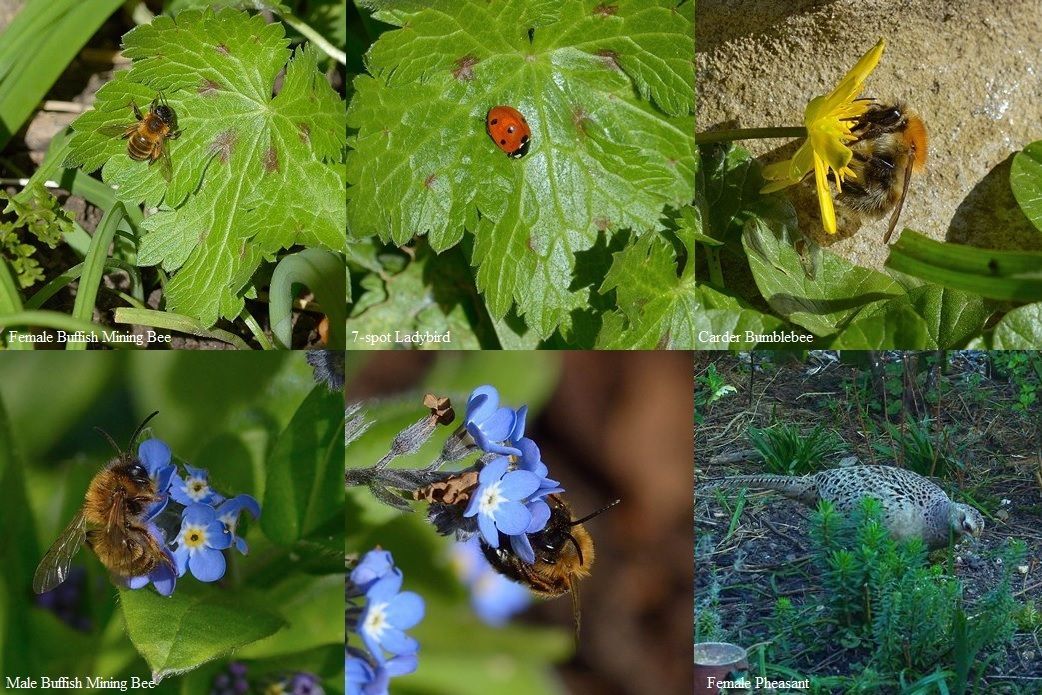
First Red-tail Bumble......
A Bombus lapidarius Red-tailed Bumblebee was the first of the year (15th) and also seen was a Buffish Mining Bee and a Bumblebee sp.
3 Collared Dove, 3 Wood Pigeon, Robin, Dunnock, 2 Blackbird, Blue Tit, Starling and 7 House Sparrow were also present.
Buffish Mining Bees make an appearance......
The first 2 Andrena nigroaenea Buffish Mining Bees (14th) were around the Lungwort (a cultivar with no spots on the leaves), a Bumblebee species and a possible Anthophora plumipes also.
Birds were represented by: 2 Dunnock, Blue Tit, Great Tit, 4 Blackbird, 2 Wood Pigeon, 2 Starling, 6 House Sparrow, Robin and a Wren.
Bunting behind the fork......
The 1st year Reed Bunting was once again in the garden (10th), this time feeding on the ground just behind the garden fork.
Male Hairy-foot in garden......
A Red Admiral was seen out the front of my neighbours at No 9 (9th) and our first Anthophora plumipes Hairy-footed Flower Bee (male) was in the garden exploring the wrong bee hotels! Buff-tailed Bumblebees were also seen-fleetingly!
A look out of the kitchen window in the late morning found a 1st year Reed Bunting eating seed and was seen again at 15.50 on the fatballs. Not the first Reed Bunting we have ever had in the garden but a very welcome visitor.
Other avian species included: 4 Blackbird, 2 Wood Pigeon, Collared Dove, Blue Tit, Robin, 2 Dunnock, Starling and 6+ House Sparrow.
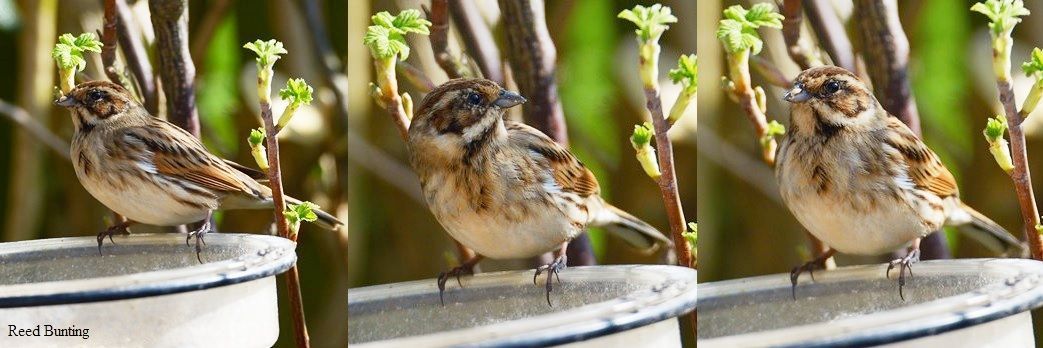
Rook-reaching......
A Rook was perched on one of the seed trays reaching up to the fatballs (8th) and also seen were: Blue Tit, 3 Blackbird, Robin, 2 Dunnock, several House Sparrows, 6 Starling 3 Wood Pigeon and a Wren.
Bumblebees were occasionally seen presumably queen Buff-tails.
Garden Diary Notes 4th-7th......
3 Blue Tits were in the garden today (7th) and also seen were: Blackbird, Starling, Wood Pigeon and Collared Dove.
A Rook perched briefly in the garden (5th) and a Wren was also seen again. House Sparrows, Dunnock, Blue Tit, Robin, Starling, Collared Dove, Wood Pigeon and 4 Blackbird were also present.3 Blue Tits were in the garden today (7th) and also seen were: Blackbird, Starling, Wood Pigeon and Collared Dove.
A queen Bumblebee (probably a Buff-tailed) tapped on the living room window (4th), the first defines sighting of a Bumblebee in the garden this spring.
Collared Dove, Blue Tit, 3 Blackbird, 2 Starling, several House Sparrow, Robin and Dunnock were also seen.
A surprise new addition to the garden's fauna!!
A bit or rearranging and preparing for spring in the garden (2nd) had a surprise in store!
Some time ago I had put some pieces from concrete slabs on top of the Hedgehog box, to hopefully aid insects and Spiders via the gaps in the layering of the slab pieces and to provide extra stability to the box. However, whilst removing the pieces of slabs to put elsewhere I came across a species new to the garden-a Common Toad (nothing common about it though)!
It had obviously been hibernating between the slab pieces and after grabbing a couple of camera shots I replaced the pieces carefully over its hibernation spot; the rearrangement in the garden would have to wait!
There have been no records of any Amphibians in the garden and I never thought I would ever have one of the very few species we have in the UK and a Toad was a very welcome addition to the garden fauna; I must be doing something right in the garden management! It just goes to show when you keep wildlife in mind in your garden, however big or small you never know what you might attract.
Birds in the garden today, included: 4 Blackbird, at least 16 House Sparrow, Robin, Collared Dove, Wood Pigeon and 5 Starling.
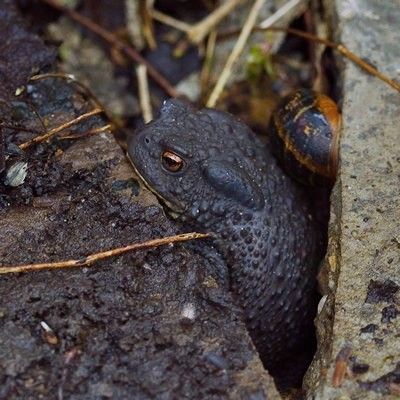
Officially Spring?!
The 1st of metrological spring found Blackbird, Robin, Blue Tit, 2 Wood Pigeon, Collared Dove and several House Sparrows in the garden.
The first Lesser Celandine flower has appeared and the Three-cornered Leeks are flowering and doing well!
February 2024
Wren searching for insect prey......
A Wren was seen perched on the garden gate (28th) before looking for food in the rest of the garden. 2 Blue Tit, Dunnock, Robin, 6+ House Sparrow, 10 Starling, Wood Pigeon and 4 Blackbird were also observed.
First Jackdaw for a while......
A Jackdaw ventured into the garden but like other Corvids was very nervous and left fairly quickly (24th). Also present were Blue Tit, Dunnock, Robin, 9+ House Sparrow, 3 Starling, Wood Pigeon and 2 Blackbird.
Butterfly!
The first Butterfly of 2024 was seen as a Small Tortoiseshell flitted past the living room window (23rd).
Birds included: 4 Blackbird, 2 Wood Pigeon, 3 Collared Dove, Robin, Dunnock, Blue Tit, House Sparrow (9+) and a Starling.
Hope for Blue Tit nesting in garden?!
A Blue Tit was seen to fly to nestbox complex on the side of the shed (17th). Also present were; 2 Dunnock, 3 Blackbird, 6 House Sparrow, Robin, 4 Starling, Wood Pigeon and a Wren again.
Robins in territorial chase-off and Wren present......
A Wren was present on both the 12th and 13th and the three days (12th-14th) saw the following with highest numbers noted: 2 Collared Dove, 2 Wood Pigeon, 2 Robin (territoriality), Dunnock, 15+ House Sparrow, 4 Blackbird, 2 Blue Tit (mainly 2 together) and 4 Starling.
2 Long-tails and news of early Amphibians......
2 Long-tailed Tits were welcome visitors to the garden today (7th) and also seen were Blue Tit, 11 House Sparrow, 4 Starling, 4 Blackbird, Wood Pigeon, Robin, Dunnock and Collared Dove.
Meanwhile, I received a text from Jason Nichols stating that he had just been sent an image of Frogspawn in his garden pond from his partner Vikki.
A further conversation later with Mike (Linley) also revealed more Amphibian news sent to him from his neighbour of Common Toad and what looked like Smooth Newt. Early amphibian activity; a sign of Spring?!
Apple still in favour with Blue Tit and Bumble at Filby......
Similar birds were in the garden (2nd and 3rd) with maximums of: 3 Blackbird, Dunnock, 2 Collared Dove, 3 Wood Pigeon, 7 House Sparrow, Robin, 2 Blue Tit (again feeding on Apple) and 2 Starling.
On the 3rd Ken Saul had his first Buff-tailed Bumblebee queen in his garden at Filby; come on you Bees!
Time flies, February here already!
The second month begins (1st) and I can’t help but think how fast the time goes; Tempus fugit!
It’s always good to see what is visiting the garden at the start of a new month (human timing, not Natures!) and today the following birds were recorded: 2 Blackbird, Dunnock, Collared Dove, Wood Pigeon, approx’ 6 House Sparrow, Robin and 2 Blue Tits, with one still consuming the apples ‘on a stick’!
January 2024
Garden Diary 1th-28th......
Observations done in the garden (28th 11.00-1200) for the Garden Birdwatch (as well as the usual notes) were: Blackbird, 8 House Sparrow, Dunnock, Blue Tit, Robin, 4 Starling and a Wood Pigeon.
A Great Tit was once again in the garden (23rd) and also visiting the feeding station was: 6 Starling, 6 House Sparrow, Blackbird, Wood Pigeon, Dunnock and 2 Blue Tit.
2 Great Tits were the highlight today (21st) along with 2 Blue Tits (one on Apple).
2 Wood Pigeon, Collared Dove, Dunnock, 5 House Sparrow, 2 Blackbird and a Robin were also seen.
A Lapwing flew over (20th) not seen very often here and 2 Blue Tits were in the garden with one consuming Apple again.
2 Cormorant were seen flying over (19th) and in the garden were: Collared Dove, Wood Pigeon, 5 Blackbird, 2 Dunnock, Blue Tit (feeding on Apple), 3 Starling, several House Sparrows and Robin.
Blue Tit attracted to Apple again and 9 Long-tailed Tits......
A Blue Tit was once again consuming Apple with another one also seen (17th) and 9 Long-tailed Tits were a welcome sight to see feeding on fatballs.
Also seen were: Wren, Robin, Dunnock, 2 Blackbird, Collared Dove, Wood Pigeon, 7 Starling and 6 House Sparrow.
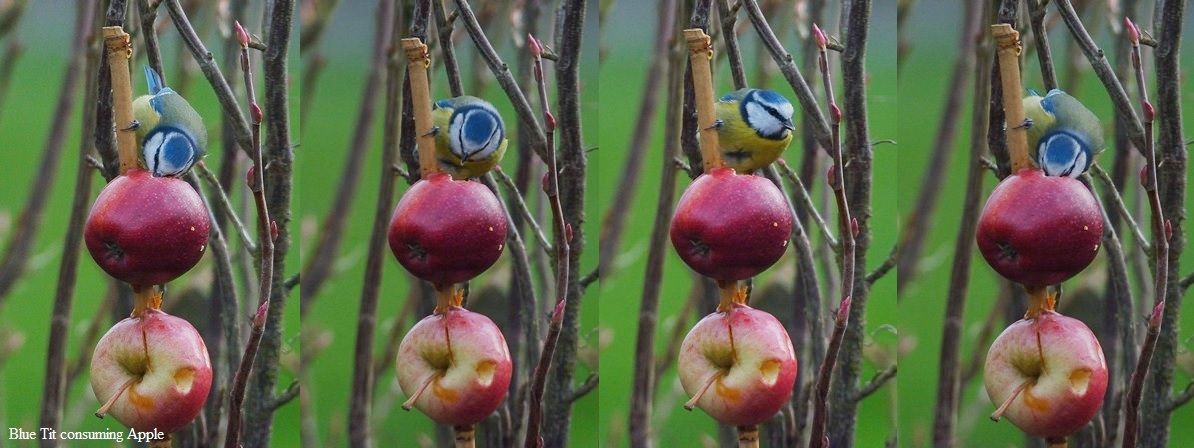
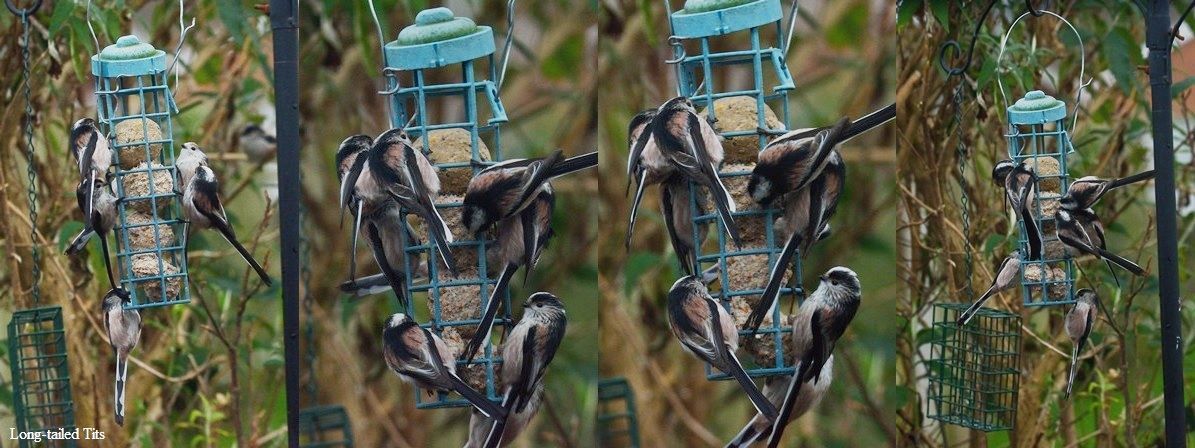
Snowfall and hungry birds......
A flurry of snow today (15th), was the first of the year, with more forecast and colder weather to come it was essential to make sure the avian visitors (and any other animals-barring those blessed cats!) had enough food and unfrozen water source/s.
The apples attracted 4 Blackbirds, although one male had dominance and is even chasing away smaller birds such as Dunnocks, which there were 3 today and House Sparrows, 12 recorded today.
Also coming for provisions was: 2 Starling, Collared Dove, Robin, Blue Tit and Wood Pigeon.
With the Garden Birdwatch coming up (26th-28th Jan) please use the following photos to sharpen your identification skills on some of the birds you may see in your garden. Yes, many people will find this easy but some won’t; every wildlife supporter counts and this website is also (and always has been) for those such people too! Answers below photos.
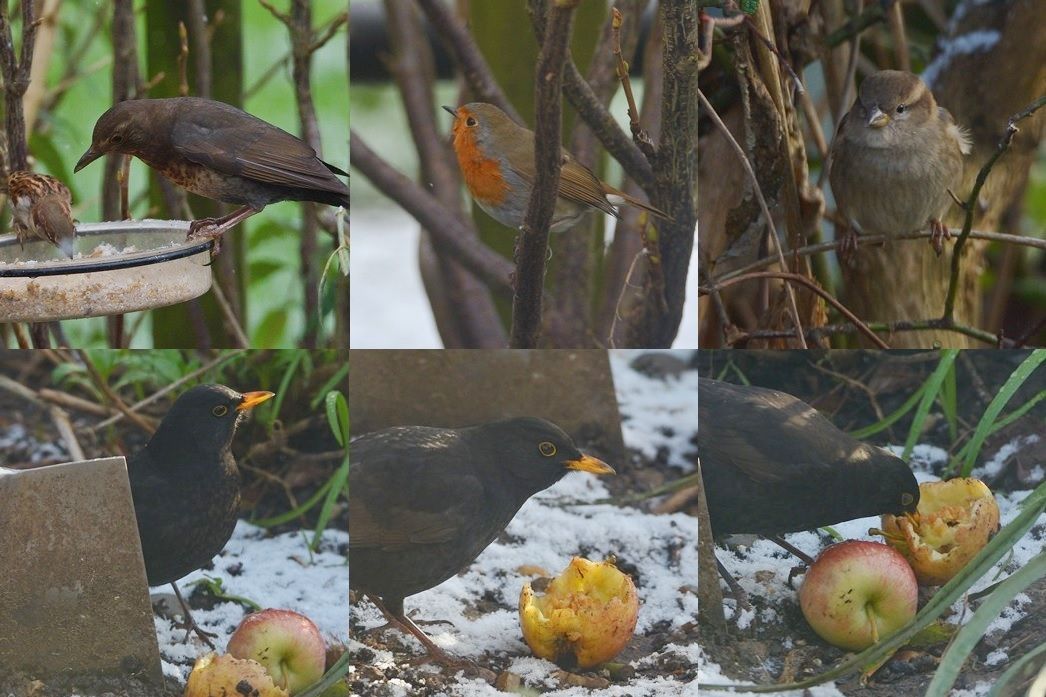
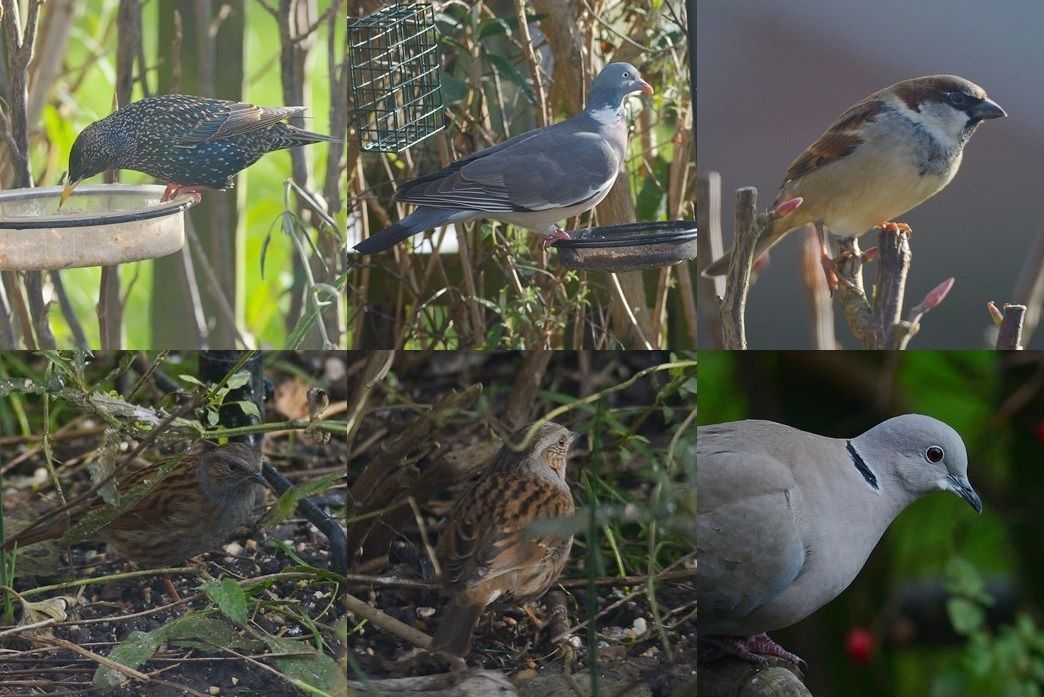
Above; L-R and Top to Bottom: Female Blackbird and House Sparrow, Robin, Female House Sparrow, Male Blackbird (3 images), Starling, Wood Pigeon, Male House Sparrow, Dunnock (2 images) and Collared Dove.
A selection of birds......
Birds present today (13th) were: Collared Dove, Wood Pigeon, 2 Blackbird, Robin, 2 Dunnock, 4+ House Sparrow, 4 Starling and Blue Tit.
14 House Sparrows......
3 Blackbirds were mainly consuming apples put out for them but a male was also eating Rosehips (7th). There was a good count of House Sparrows with at least 14 counted and also here were: 2 Collared Dove, 2 Blackbird, Dunnock, Robin and 7 Starling.
First Robin......
A Robin was seen (6th), the first of the year and also present were: Collared Dove, 2 Blue Tit, 2 Dunnock, 9 House Sparrow, 7 Starling and 5 Blackbird.
First Wren of the year......
10 House Sparrows were present today (3rd), as were: 3 Blackbird, 2 Dunnock, 2 Collared Dove, 5 Starling, Blue Tit, Wood Pigeon and a Wren (one of the very last birds we recorded on our New Year’s Day bird count).

A selection of birds starts the New Year......
With the 1st of January spent out all day seeing how many birds and other wildlife we could see, it wasn’t until today (2nd) that observations could be made in the garden.
A selection of birds visited the garden, mainly for provisioned food and water including 14 Starlings descending on the feeding station.
Other species were: 7 Blackbird, 2 Collared Dove, 7 House Sparrow, 2 Wood Pigeon, 2 Dunnock and 2 Blue Tit.
Most people are probably aware of the RSPB Garden Birdwatch towards the end of the month and are worth doing, although I would be interested to know how the results sent in by the general public are quantified. Still, if it gets people interested in the wildlife in their gardens it is worthwhile.
Wildlife Garden Diary 2023
December 2023
Starling feeding frenzy and supporting cast......
At least 14 Starlings were devouring the supplementary food put out for them (27th). However, this did not stop other species getting food and these included: 2 Blue Tit, Robin, 6 Blackbird, 3 Dunnock, Wood Pigeon, 2 Collared Dove and 10 House Sparrow.
Wren plus......
A good selection of birds in the garden today (15th) and whilst a Wren was the ‘star bird’ others that were also most welcome were: 3 Blue Tit, 5 Blackbird, 2 Dunnock, 8 House Sparrow, Robin, Wood Pigeon and 2 Starling.
Pink-foot flyover......
Before setting off for a day ‘in the field’ Jason Nichols informed me that approximately 50 Pink-footed Geese had just flown over (14th). Prior to that, 3 Blue Tits were in the garden.
Birds for a dull day......
A good selection of birds was seen today (10th) with infrequent visitors; Wren and Great Tit (2) amongst them.
Also seen were: 6 Starling, 3 Blue Tit, Dunnock, 3 Blackbird (male feeding on Rosehip), 11 House Sparrow, 2 Robin (briefly!), Wood Pigeon and a Collared Dove just outside the garden boundaries.
Another Beautiful Plume was found indoors and then released outside, after photographing.
Below are: Blue Tit, Robin, Great Tit, House Sparrow, Starling and Beautiful Plume.
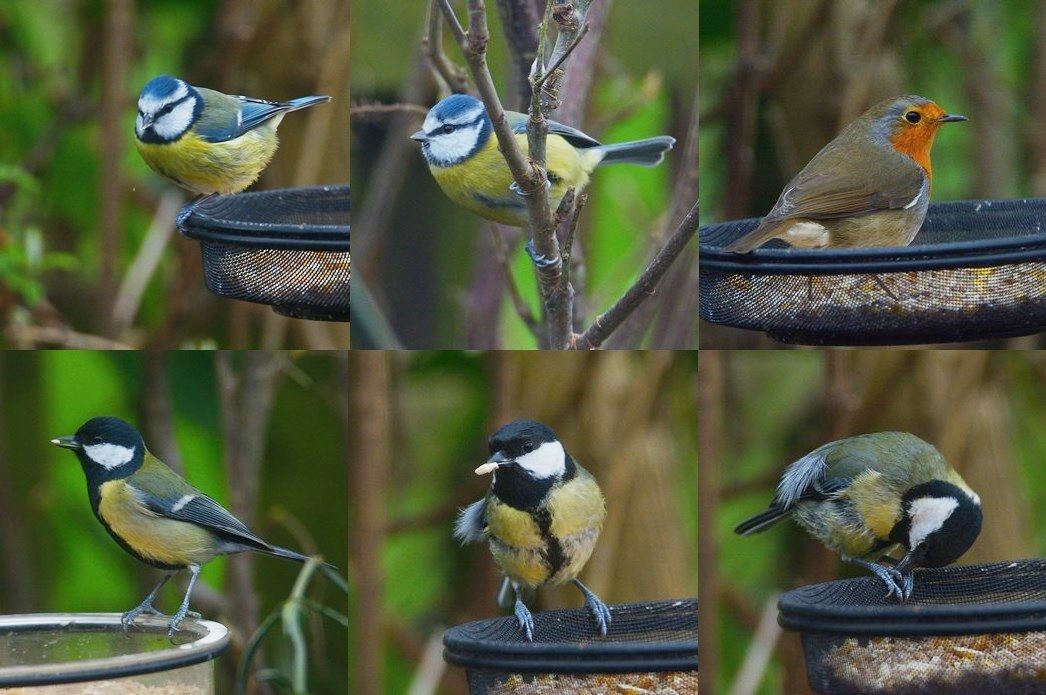

Birds of the first day of the last month......
The 1st day of the final month in 2023 began with the following species of birds visiting the garden: 4 Starling (eating Pear plus other provisioned food), 6+ House Sparrow, Robin, 2 Dunnock, Blackbird, Blue Tit and Collared Dove.
November 2023
Snowfall and birds......
The first fall of snow for the Autumn/Winter (29th) managed to attract a variety of birds to the feeding station, during several prolonged window-watches.
Species recorded were: 3 Blue Tit, 9 House Sparrow, 2 Starling, 5 Blackbird, 2 Dunnock, 4 Wood Pigeon, Robin and a Collared Dove.
Also in the last few days, new shrubs for the garden potted up (for now) were 2 Hazel, 2 Blackthorn and a Dogwood.
Long-tails back in the area......
A quiet ‘see see’ call made me look up from refreshing the feeding station to see 2 Long-tailed Tits flying over (26th). There may have been more and they would have probably visited the feeding station for food, but I guess my presence stopped that from happening. Good to see Long-tails back in the area though.
Beautiful moth!
A Beautiful Plume Amblypitilia acanthadactyla (opposite) was found on the inside of the kitchen window pane (17th). Thanks to Ken Saul for identifying the moth, who said:
‘Beautiful is one of the species that overwinters and hibernates as an adult moth. In recent years it seems to have become more frequent in gardens, and the larvae appear to feed on quite a variety of plants. I associate it particularly with Hedge Woundwort, as I bred one out from that plant several years ago. The caterpillars are attractive too, and amazingly well-camouflaged.’
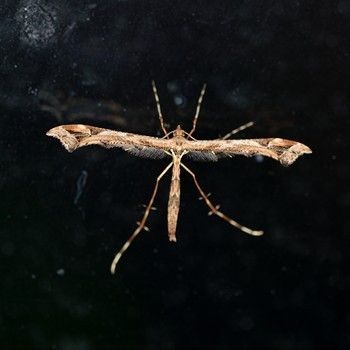
All quiet on the western, eastern, northern and southern front!
A Wren was good to see in the garden (16th), along with Blue Tit, 2 Blackbird and 6+ House Sparrow. This is very quiet time, in the garden at the moment with a selection of birds visiting the garden mainly for food and water and very little flying over too.
November beginning.....
Bird species present at the start of November (1st-7th) were: Wood Pigeon, Blackbird, Robin, Blue Tit, Starling and Dunnock.
October 2023
Geese and Garden Birds......
A selection of birds was in the garden today (30th) with 3 Blue Tit, Robin, 4 Blackbird, 7 House Sparrow, 3 Starling and 2 Dunnock present.
Pink-footed Geese were heard flying over and 40+ Grey-lag Geese were seen.
Garden Diary sightings 23rd-28th......
Gadwall was heard flying over on 27th and again 28th.
Somewhat worryingly, is that there has been no sign of any Hedgehogs for months now, either in my garden or my neighbour Annie’s garden!
What was most probably a Common Crossbill flew inland calling (23rd). Pink-footed Geese were heard and approximately 1000 Starlings flew over, the biggest murmuration I have seen here. Meanwhile 4 Blue Tits (veritably a flock here!) were in the garden.
Great Tit back in garden......
A Great Tit was nice to see back in the garden (18th) and along with a Blue Tit was searching amongst the Clematis for food. Also present were: 7 House Sparrow, 3 Blackbird, 2 Wood Pigeon and a Robin.
Seldom recorded wader......
A Golden Plover was heard flying over (16th) and in the garden were 4 Blue Tit, Dunnock, Wood Pigeon and 6 House Sparrow.
250 Pink-feet flyover......
A total of approximately 250 Pink-footed Geese flew south (9th) and a fresh queen Buff-tailed Bumblebee was on a remaining Buddleia flower.

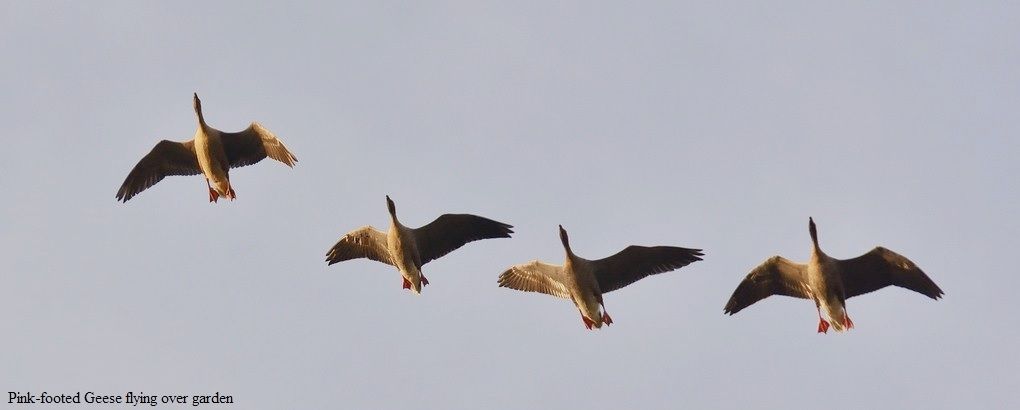
Increase in Blackbirds......
There was an increase in Blackbird numbers in the garden (8th) with 5 present, including a 1st winter male probably from the near continent.
10 Starling and a Blue Tit were also recorded, whilst a Small White was seen outside the garden.
Pinks and garden staples......
Pink-footed Geese were gain heard and then seen today (6th) with a total of 38 S.E.
A Common Darter was outside the garden and a Peacock flew over, while a queen Buff-tailed Bumblebee was in the garden, mainly visiting the Verbena and several Carder Bumblebees and Honey Bees were also present.
4 Blue Tit, Blackbird, 10+ House Sparrow, Robin and Starling were coming for food.
First Pinks!
The first Pink-footed Geese of the autumn from the garden were seen; approximately 30 heading S.E (3rd).
September 2023
Diary Notes 16th-25th......
Red Admiral, Large White and Small White were present (25th), along with Robin, Dunnock, Blue Tit and a few House Sparrows.
A queen Buff-tailed Bumblebee was present as were several Carder Bumblebees, now favouring the Agastache now the Purple Toadflax is no longer in flower and a Hummingbird Hawkmoth appeared right in front of my nose (literally) before exiting the garden.
Yet another sighting of a Hobby (23rd) and a Wren was in the garden.
Both Migrant Hawker and Common Darter flew over and both a Small and Large White were seen.
A Hobby was seen flying north (16th) and in the garden were Wood Pigeon, 6 House Sparrow, 2 Blackbird, Blue Tit, Robin and 2 Collared Dove.
Insects were represented by 2 each of Large and Small Whites and 2 Common Darters.
Hirundines overhead......
Small and Large Whites were in the garden and a Peacock was freed from a web in the front garden (11th).
Several Swallows and 7 House Martins flew over in the late afternoon.
Mediterranean Manoeuvres......
2 Common Darters were in the vicinity of the garden (9th) and in the late afternoon at least 3 Mediterranean Gulls were amongst Black-headed Gulls and Starlings presumably feeding on flying Ants.
Later in the evening a small Bat was seen, probably a Pipistrelle species.

Leafcutters still......
A Common Buzzard and 2 Swallows flew over (8th), a Common Darter was once again in the garden perched on top of the bird-feeding apparatus and Leafcutters (presumably Wood-carving) were entering the bee hotel.
Agastache favourite with the Carders......
What looked like a Wood-carving Leafcutter Bee was entering the bee hotel (5th) possibly at least two of them.
Carder Bumblebees were busy on the Verbena, Agastache and what is left of the Purple Toadflax flowers and a Common Darter and Small White were in the garden, whilst a Holly Blue flew over.
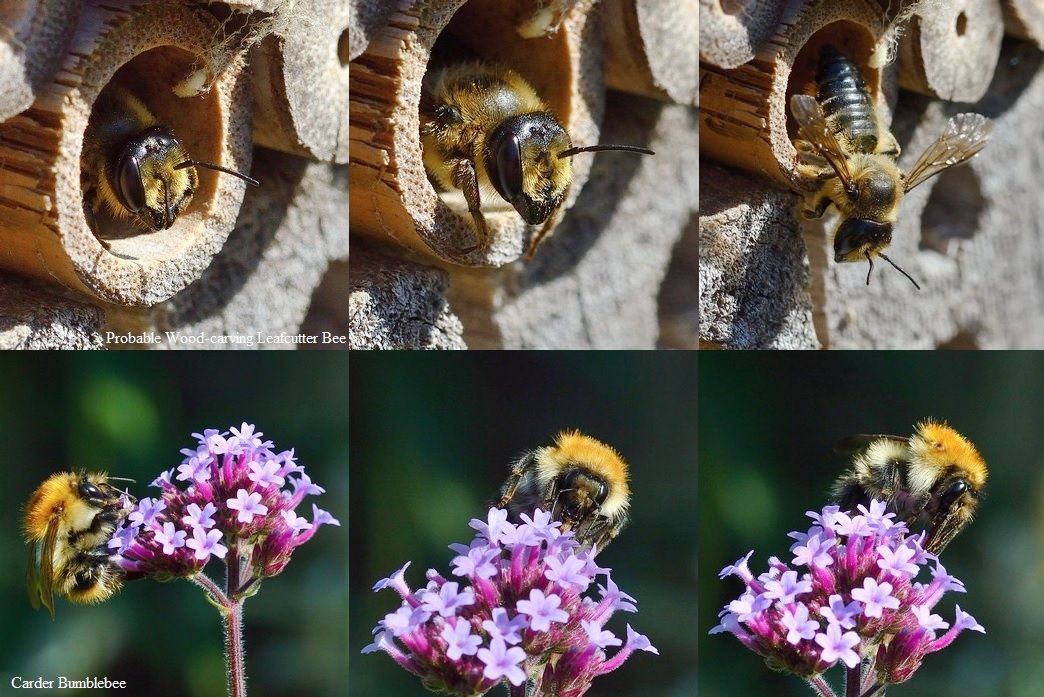
Darter on the garden fork......
2 Small Tortoiseshell, Small White, Red Admiral were seen today (2nd) along with a Common Darter perched on the garden fork handle.
August 2023
Garden Diary Notes 25th-30th......
4 Small Tortoiseshells were good to see (30th), as were 2 Red Admiral, 2 Small White and a Volucella zonaria.
2 Small Tortoiseshell, 2 Small White, Peacock and 2 Dunnocks were present today (28th).
Small Tortoiseshell, Small White, Red Admiral and Peacock were all seen (27th).
A Volucella zonaria aka Hornet Hoverfly was again present (26th), along with Small Tortoiseshell, 2 Small White and 2 Red Admiral.
A Hummingbird Hawkmoth once again paid a visit (25th) and a Red Admiral and Small White were also seen.

Hornet Hoverfly appears to like the garden......
The Hornet Hoverfly Volucella zonaria was again present (23rd) and Peacock, 4 Red Admiral Large and Small White and a Small Tortoiseshell (right-scarce this year) were also seen.
A male Common Darter, male Migrant Hawker was in the garden, whilst a female Southern Hawker flew over the garden.
One of the juvenile Blackbirds was feeding on berries from the Mountain Ash and a Dunnock, 2 Robins, 2 Collared Dove, 2 Wood Pigeon and a Blue Tit were also present.
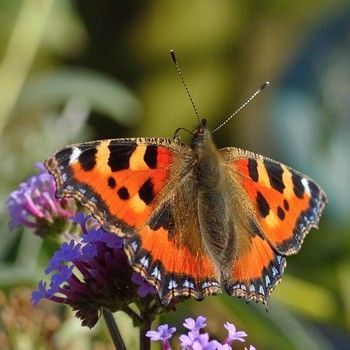
Hat-trick Hummy......
A Hummingbird Hawkmoth made three separate appearances in the garden (22nd); mainly visiting the Verbena and Red Campion.
Return of the Bee-wolf!
After a lack of activity around the Bee hotel recently; there was a few comings and goings today (21st). A Wood-carving Leafcutter was seen entering the hotel and possibly a Willoughby’s Leafcutter too. At least 2 female Orange-vented Mason Bees were also entering the hotel’s tubes and a very small wasp-like insect was also seen doing the same but too quick for the camera!
Queens of both Buff-tailed and Red-tailed Bumblebees were present along with workers of Buff-tailed, White-tailed and Carder Bumblebees.
A Bee-wolf Philanthus triangulum was present for the second time this year and stayed around for a much longer time making capture attempts on a Honey Bee on the Oregano flowers and also an attempt on a small worker Carder Bumblebee!
A male Migrant Hawker entered the garden and looked to perch but couldn’t find anywhere to its liking and flew out of the garden, but a Volucella zonaria was yet again present, as was an Eristalis tenax.
The flocks of Starlings that used to reduce the fatballs and bird feed to nothing in a short amount of time have lessened and only a couple of Starlings were seen today. At least 10 House Sparrow, 2 Blue Tit, Robin (juvenile nearly in adult plumage) and a Dunnock (not seen for some time) were feeding on the spilt seed from the feeding station. A female Sparrowhawk flew leisurely past just outside the garden.
A male Blackbird was once again doing its best to reduce the Slug population and feeding it to its impatient offspring that was not aware of how long it takes to prepare a slug for consumption! Another juvenile Blackbird was also in the garden but was seen off on several occasions by the resident male.
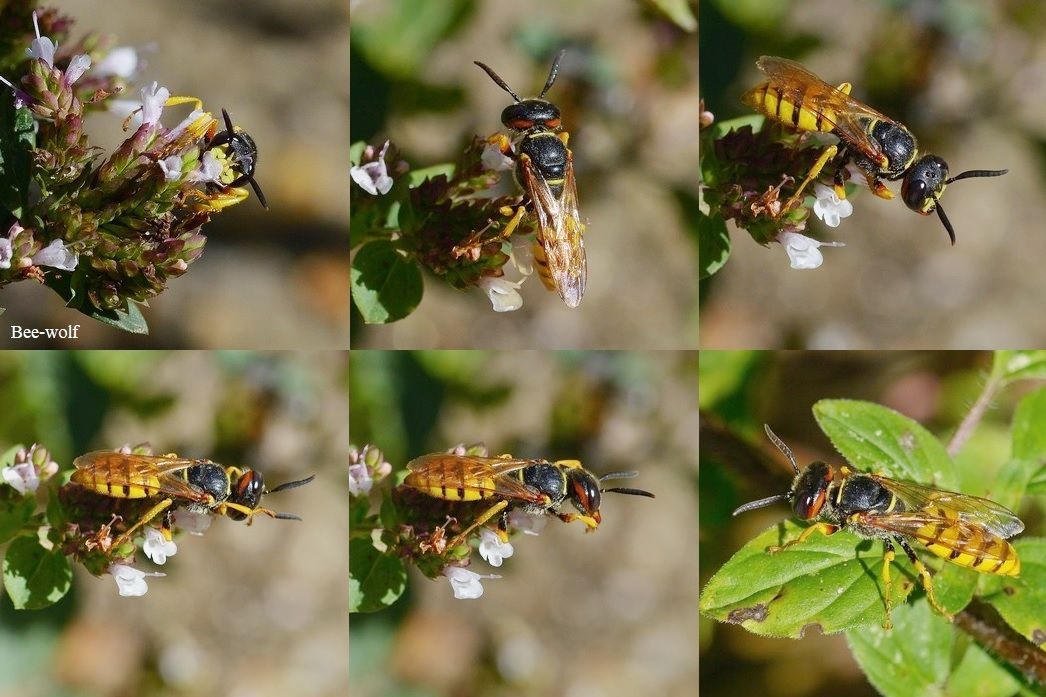

1st Brown Hawker......
The first Brown Hawker of the year paused briefly in the garden shrubbery (18th) and a Volucella zonaria was present again on the Buddleia.
2 Red Admiral, Peacock and a Small White were present and a Sparrowhawk flew over.
Hornet Hoverfly again......
A Volucella zonaria aka Hornet Hoverfly was once again in the garden (15th), as was a Ruddy Darter.
Red Admiral, Small and Large White and Holly Blue were all recorded and several Swallows and Hose Martins passed over as did a Sparrowhawk.
Last Swifts?
7 Swift were still present (14th) and a male Southern Hawker flew over the garden.
No Houseleeks but the Hoverfly turns up again for the second year running......
A Volucella zonaria was once again in the garden on the Verbena bonariensis (13th), also present were Red Admiral, Peacock, Large and Small Whites and a couple of Small Purple and Gold.
At about 17.30 a small dark Hoverfly was seen firstly on the Red Campion and then on the Oregano flowers. The hoverfly looked familiar and indeed it was as it first appeared in the garden last year; a
Cheilosia caerulescens Houseleek Hoverfly.
See also August 2022

Hummy, Hog and a lots of Slugs!
Despite the windy and dull conditions a Hummingbird Hawkmoth visited the garden on two occasions around 19.45 (12th).
4 Swift were still present and 2 Gatekeeper, Small White, Peacock and Red Admiral were in the garden.
Later a very small Hedgehog emerged on the bark path and then disappeared into the border. However, the cat biscuits were attracting not Hedgehogs but a long trail from the pond of slugs leading to a large gathering around the food! Slugs and snails have been a huge problem this year in raising any plants planted to the ground. My only defence against the slugs is one male Blackbird, which is constantly finding slugs in the undergrowth, rolling and wiping them in the bark or soil to remove the excess slime before ‘butchering’ them and carrying the pieces off to offspring.
Swifts on the move......
19 Swift glided over heading south-westwards in the late afternoon/evening (11th), whilst another 10 were seen probably feeding on flying ants alongside Black-headed Gulls, Starlings and approximately 21 House Martins.
A Small Purple and Gold and a solitary Wasp sp. were in the garden along with Holly Blue, Peacock, 4 Blue Tits and an adult and juvenile Robin.
Butterfly notes......
After a day out (10th) in ‘the field’, Holly Blue, Red Admiral, Peacock and Gatekeeper were of note in the garden, whilst male Brimstone was seen nearby.
Close quarter bird photography and insects in the garden......
Holly Blue, 2 Gatekeeper, 2 Peacock, Small and 3 Large Whites were around the Buddleia and Verbena flowers (9th).
A Ruddy Darter and Migrant Hawker were in the garden as were House Sparrows, Starlings, adult and juvenile Robin, 2 Collared Dove, Blackbird (male predating slugs) and a Marsh Harrier flew over.
A spot of close quarters photography was in order, after all the so-called 'common'' garden birds were close by.
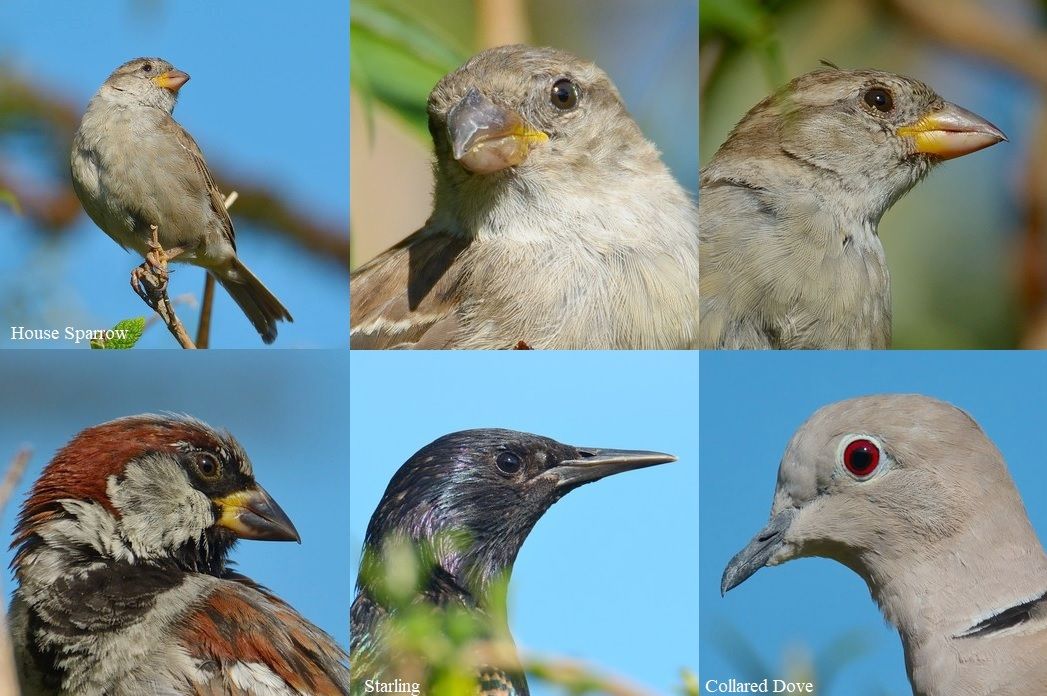
Butterfly underwing punctuation!
A Comma was present (8th) along with 2 Small White, 3 Peacock, and a Gatekeeper.
A Migrant Hawker was flying in the garden and overhead there were 3 Swift 6 House Martin and a Sparrowhawk.

Garden Diary notes 1st-5th......
5 Blue Tits were around the feeding station, on an inclement day (5th) as were Starlings and House Sparrows.
A small selection of butterflies were seen today (4th) with Meadow Brown, 4 Gatekeeper, 2 Small White, Red Admiral and a Peacock.
A Migrant Hawker flew over, as did a Hobby and one Swift remains.
A male Greenfinch hovered briefly over the area around the feeding station (3rd) but was no doubt put off by the numbers of Starlings present and flew off again. A juvenile Wren was also seen and a single Swift was seen also.
Red Admiral and Small White were present and there was a brief appearance by a Hummingbird Hawkmoth in the late afternoon.
It’s always good to see what is around as a new month begins (1st), although, this is purely a human divisional guide!
3 Gatekeeper, Red Admiral, Small and Large White were the butterflies present whilst there were Carder, Red-tailed and White-tailed Bumblebees and Honey Bees feeding on the Oregano flowers.
A juvenile Robin, 4 Blue Tit and a male Blackbird still collecting food for its offspring were in the garden and overhead were 5 House Martin, 6 Swift, a Common Buzzard heard and an unknown falcon flew over.
July 2023
Swifts still present......
At least 14 Swifts were in the skies (31st) along with at least 6 House Martins and a juvenile Swallow flew over and a Gatekeeper was in the garden.
Hobby fly-over......
Meadow Brown, Gatekeeper and a Small white were all seen today (30th).
A Hobby flew over and there were 12 Swift still present.
In the garden and taking full advantage of the new feeding station were juvenile Robin, 2 Collared Dove, Wood Pigeon, House Sparrows and Starlings.
Bee-wolf an ominous presence for the Honey Bees!
A Philanthus triangulum aka Bee-wolf was seen perched on a Flowering Currant leaf (29th), no doubt weighing up potential prey in the Honey Bees feeding on the Oregano flowers!
Red Admiral, Peacock, Gatekeeper, and Small White were present, as was a juvenile Robin but a different one to earlier July sightings.
What looked like a female Southern Hawker flew over and a Darter species was flying around the tree outside the garden.
There was sudden pandemonium coming from the Starlings and House Sparrows in the Buddleia and my thoughts to what might have caused this were confirmed when a female Sparrowhawk flew out! 4 Swift remain in the skies alongside 6 House Martins.
New feeding station and a Hornet Hoverfly pays a visit......
A Comma was good to see as were Gatekeeper and Large and Small White (28th).
A new feeding station was put in as the old bird table had along with its rotten post seen better days. The first bird on the ‘pole feeding station’ was a Blue Tit, but then the Starlings found it!
A Hobby flew over and a Volucella zonaria aka Hornet Hoverfly landed briefly on the garden arch and was the first Volucella to be seen in the garden this year.
The Fennel flowers are now receiving a lot of attention mainly from Common Wasps but also a few Hoverflies.

Coelioxys ID headache and Blue Tits fly-catching......
Both a Southern and a Migrant Hawker flew over the garden (27th).
Small and Large Whites and a Red Admiral were seen and a Sharp-tail and Leafcutter Bees, plus a Solitary Wasp were seen entering the bee hotel.
The Sharp-tail was identified as either Coelioxys elongata or C. Inermis, although from what Nick Owens tells me possibly C. elongata.
At least 12 Blue Tits were in the back tree; some of which were fly-catching (very successfully) and I can’t remember seeing them capture insects in this way before. Also in the tree were at least 12 Long-tailed Tits too, the first sighting of this species for some time and 8 Swifts were in the skies.
Finally, I am often fishing small Flies out of my wine, whilst sitting outside in the garden, but tonight it was the turn of a tiny Beetle. Like the flies I rescue I managed to get this animal out alive and photographed it on my leg and although I didn’t really expect to identify it; I hopefully have and it would seem to be a Glischrochilus hortensis. Where the flies are concerned I have found if I don’t get them out very quickly the wine turns sour. Obviously a chemical change but if anyone knows what this is please get in contact.
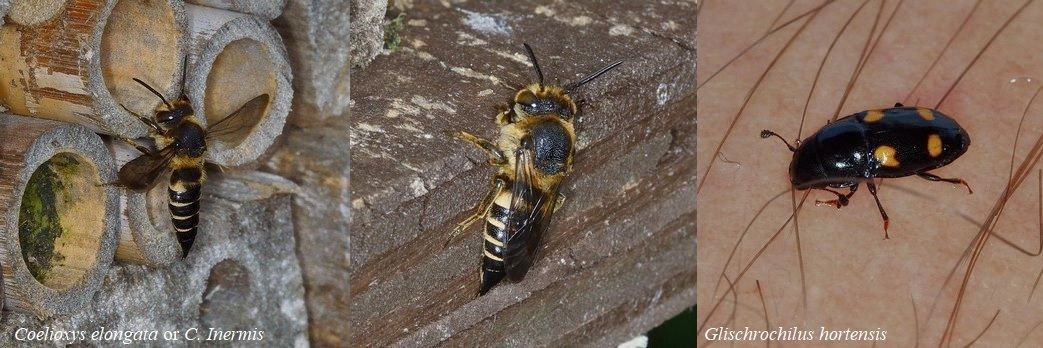
Leaf-cutting......
2 Small White, Large White, 2 Gatekeeper, Peacock, and Meadow Brown were the Butterflies present today (26th).
A Megachile ligniseca Wood-carving Leafcutter Bee was seen taking pieces of Rose leaf into the Bee hotel and was also seen and photographed cutting them out from the ‘wild rose’’
A juvenile Robin was once again present.

Spider in the kitchen......
Large and Small Whites, Meadow Brown and Red Admiral were present (25th) and a juvenile Robin and 4 juvenile Blue Tits also.
Inside the kitchen an Araneus diadematus Garden Spider had set up home in the window!
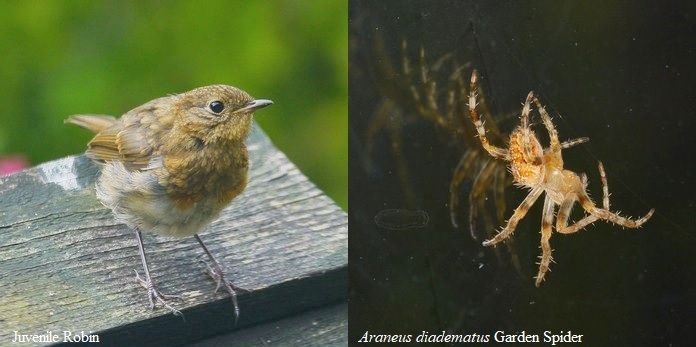
Black and White Hoverfly again......
A juvenile Robin, with a developing orange breast was in the garden (24th) along with 3 Red Admiral, Small White, Scaeva pyrastri Hoverfly and Carder, White-tailed and Red-tailed Bumblebees, the latter being seen very regularly of late
Male Bumbles......
At least 16 Swifts were overhead (23rd) and a Migrant Hawker flew over.
A Scaeva pyrastri Hoverfly, Red Admiral and Small White were also seen.
Both Bombus hortorum (Garden Bumblebee) with its very long tongue and B. terrestris (Buff-tailed Bumblebee) male Bumblebees were present (Thanks for Nick Owens for his help with these), along with Red-tailed workers.
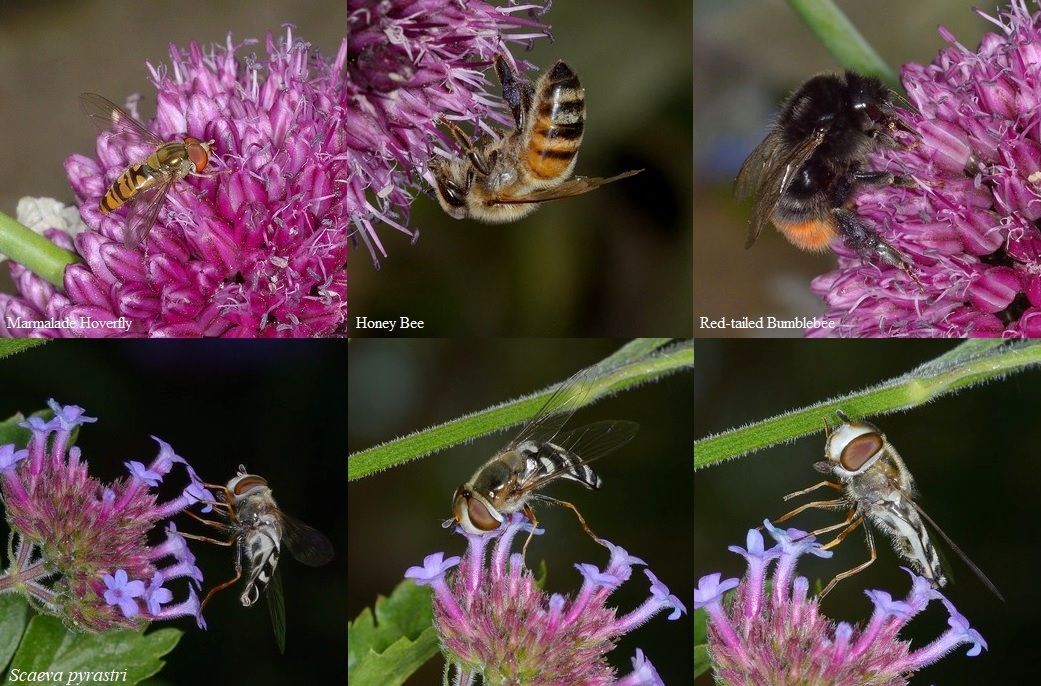

Butterflies.....
Peacock, Red Admiral, 2 Large and 2 Small Whites and a Gatekeeper were present (21st), whilst a Holly Blue was in my next door neighbours garden whilst I was doing some gardening work for her.
Small Dusty and two Woodpeckers......
A juvenile Dunnock was in the garden (19th) along with 2 juvenile Blackbirds and an adult male Blackbird still collecting food, illustrating to those who think the birds nesting season is well and truly over to think again before cutting back hedges!
A good selection of Butterflies was seen with a Red Admiral, Comma, all three whites: Green-veined (2nd brood), Small and Large, Gatekeeper and a Peacock.
A moth was photographed outside the kitchen door, which was a Small Dusty Wave Idaea seriata (right), depositing a fluid, which according to Ken Saul is something they do after emergence or when alarmed.
A Green Woodpecker was heard and a Great Spotted Woodpecker flew over; the first time both woodpeckers have been recorded in the same day here.
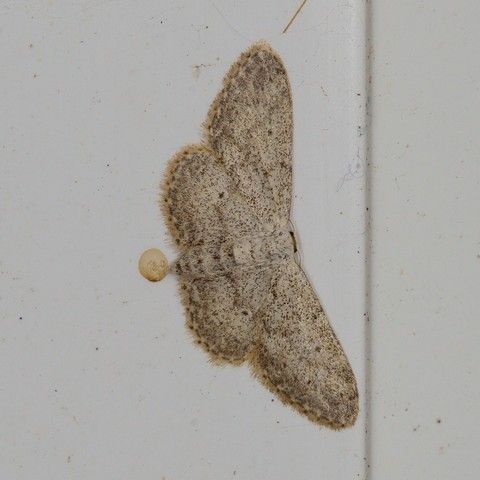
Patchwork on the Geraniums......
The first Small Tortoiseshell for some time was in the garden (18th), along with Gatekeeper, Large White and 2 Small White.
A juvenile Wren was good to see and a Hummingbird Hawkmoth paid a visit to the Red Valerian at 16.50, around the time that a Megachile centuncularis Patchwork Leafcutter Bee was collecting pollen from a Geranium flower (thanks to Nick (Owens) for his assistance once again).

First Gatekeeper......
The first Gatekeeper was in the garden (17th) as was a Meadow Brown and a Willughby’s Leafcutter entering the bee hotel.
A Chiffchaff was once again the garden constantly calling very close to where I was sat. It certainly has been a good year for Chiffchaffs in the garden. Also a juvenile Green Woodpecker was heard calling somewhere behind the garden and a shape resembling the said bird flew quickly over the garden and over the roof, but could not be found on looking out the front of the property.
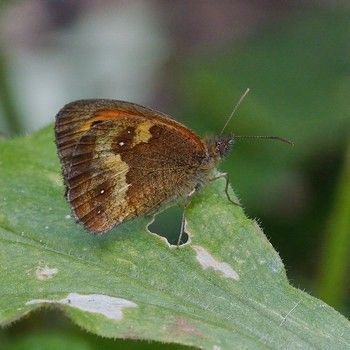
Return of the female Yaffle......
3 Small Whites were in the garden (16th) as were 4 species of Bumblebees: Carder, White-tailed, Buff-tailed and Red-tailed.
A Green Woodpecker was heard and subsequently seen (female) just outside the front window, obviously looking for Ants and other food items, particularly along the path.
Both an adult and juvenile Goldfinch were in the garden, as was a Blue Tit and at least 16 Starlings all having a bath (when space allowed!) and both Swifts and House Martins were overhead.


A Sharp-tailed Bee Coelioxys was seen investigating the bee hotel before settling on a piece of bamboo where it was photographed (13th). Again Nick Owens was consulted as I have very little experience with these bees and Nick suggested either a Coelioxys inermis Shiny-vented Sharp-tail Bee or C. elongata Dull-vented Sharp-tail Bee. Neither of these species I have encountered before, but clearly very difficult to identify from reasonable photographs!
A Leafcutter sp. was seen again and both Small and Large White (2) were in the garden along with a Red Admiral.
7 Swift were overhead along with 2 House Martins.

Green-wood calling......
A Green Woodpecker was heard calling from somewhere outside the front of the property (12th) but couldn’t be seen.
Meadow Brown, Small and Large White and Red Admiral were present and a Leafcutter Bee (probably a Willughby’s) was seen taking a leaf piece into the bee hotel.
Knapweed popular with Leafcutters and Masons......
A Willughby’s Leafcutter Bee was once again present (11th) again on the Knapweed flowers (at one time with an Osmia leaiana Orange-vented Mason Bee and a Marmalade Hoverfly!) but also on the Borage flowers too. A female Blue Mason Bee was also seen around the bee hotel. Once again, thanks to Nick for his continued mentoring!
A Hummingbird Hawkmoth was again present on the Red Valerian and the first Small White was in the garden along with a Meadow Brown.
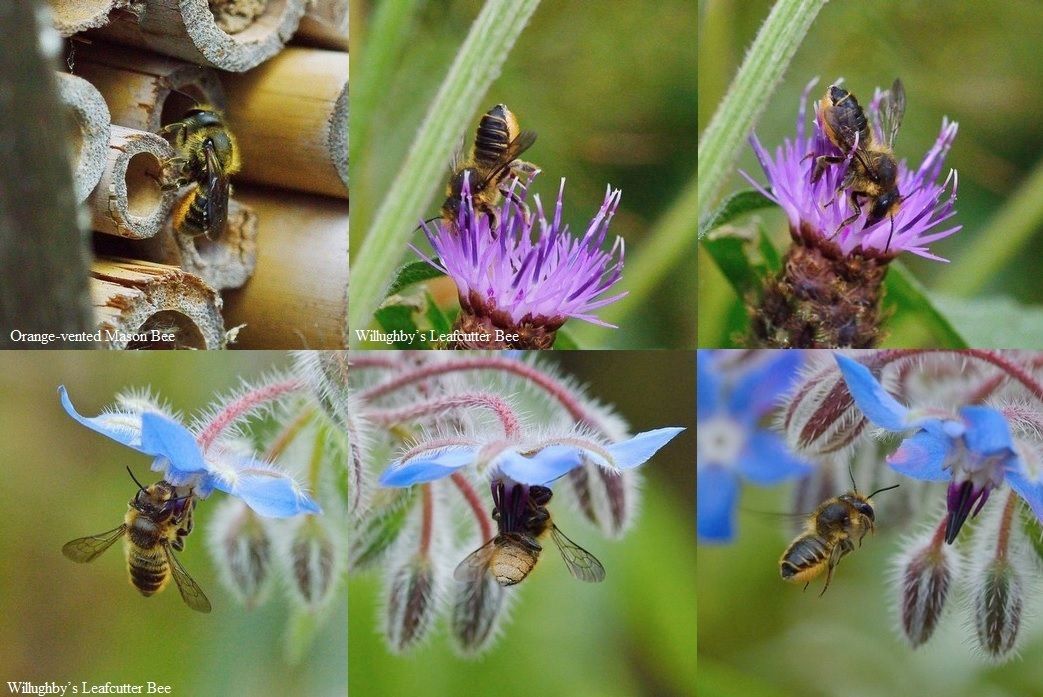

The first Leafcutter Bees appear......
The first Leafcutters Megachile appeared (10th) with a Megachile ligniseca Wood-carving Leafcutter Bee entering the bee hotel and a Megachile willughbiella Willughby’s Leafcutter Bee collecting pollen from the Knapweed flowers. Thanks to Dr. Nick Owens for his help in identifying the leafcutters.
A Large White was also present.
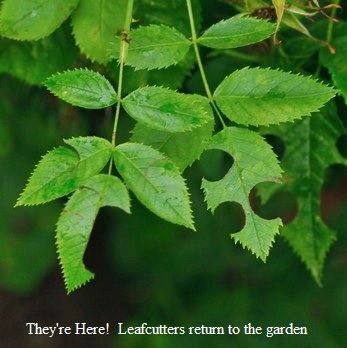
An evening's entertainment from the garden......
A Large White and a Meadow Brown were seen again (7th) and approximately 7 Common Crossbills flew in from the SE and then turned back again.
An interesting evening began with a couple of Swifts flying not too high in the sky and a little way away from my seat in the garden, so I decided to get the camera and take some shots. However, on returning with the camera they never came very close again!
A Ruddy Darter landed in the Flowering Currant and what could only have been (based on GISS) a male Southern Hawker flew repeatedly over the garden at 21.20.
Summer Chafers were once again present around the top of the tree (at least 8) outside the back garden and also flying over the garden (as they were last year) where there were at least 5 Silver Y moths favouring the Red Valerian.
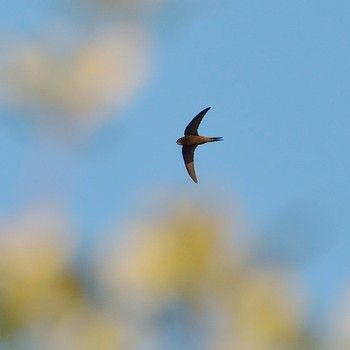
At 22.35 a small Hedgehog came for food but immediately turned around again and retreated up the concrete path. Maybe it was due to my presence or the sound of Greenslade playing, or both!
However, at 22.49 a large Hedgehog set about munching the cat biscuits, so it may have been this individual’s presence that set the smaller individual retreating out of the garden gate. The one thing that did stand out was the number of Slugs around and in amongst the cat biscuits, I estimated at least 30! No wonder nearly everything I have planted has been raised to ground zero this year!
White Butterflies......
Both a Small and a Large White visited the garden (6th), the small being the first of the year.
A female Blue Mason Bee was again entering the bee hotel and a Silver Y was found in the kitchen and released in the garden.
Blacky helping with the Slug population!
A Scaeva pyrastri Hoverfly was seen once again (5th), a female Blue Mason Bee was visiting the bee hotel and both a Large White and a Meadow Brown were present.
Both Carder and White-tailed Bumblebees were visiting the various flowers and a Hummingbird Hawkmoth was a welcome visitor once again feeding on the Red Valerian.
During the time I was sat outside having a cup of coffee the semi-tame Blackbird came down three times and every time found a Slug, which it rubbed against either the bark on the path or on soil, whilst gradually tearing the body up and flew off with the bits of slug, so no doubt is feeding offspring; anyone who thinks birds have stopped breeding at this time of year, think again!
July opens with a Hummy......
A Hummingbird Hawkmoth was visiting the Red Valerian at 14.20 (4th).
There are quite a few Episyrphus balteatus Marmalade Hoverflies present again favouring the Valerian and 5 Swifts were in the skies.
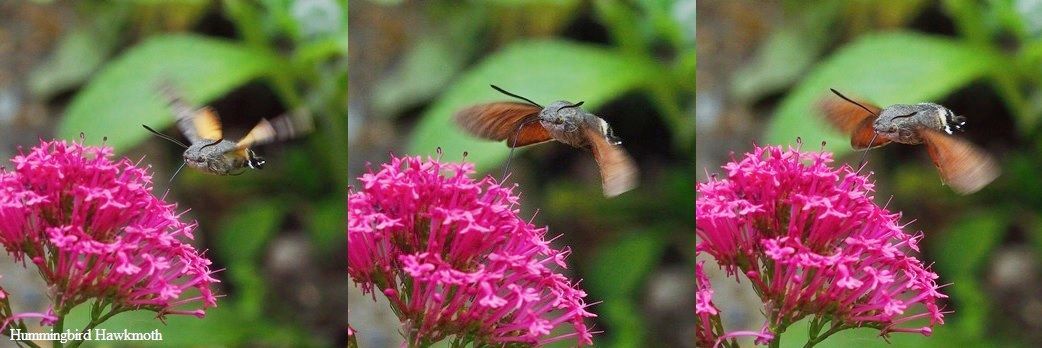
June 2023
First Large White......
A Meadow Brown was once again present (30th) along with the first Large White of the year.
4 species of Bumblebees were present: Carder, White-tailed, Buff-tailed and Red-tailed and a Hummingbird Hawkmoth visited the Red Valerian on several occasions with the last sighting at 20.40. 5 Swift and a House Martin were in the skies.
Hedgehog and first Meadow Brown......
A ‘large’ Hedgehog was seen drinking (29th) at 00.20, probably after consuming the cat biscuits put out for it and later the first Meadow Brown was seen.
Day of the juveniles......
A day of adolescence (28th) with juveniles of: Wren, Great Tit, Starling and House Sparrow in the garden.
A Scaeva pyrastri Hoverfly was again present the first Pyrausta aurata Small Purple and Gold micro moth was seen as was a female Blue Mason Bee entering the bee hotel.
7 Swift and 1 House Martin were overhead.
Look to the skies......
4 Swift and 3 House Martin were good to see in the skies (27th).
Blue Mason and Hummingbird hawk......
The first female Osmia caerulescens Blue Mason Bee was on the bee hotel roof (24th), a worker Red-tailed Bumblebee rested on a leaf, a Marmalade Hoverfly was seen and at 18.21 a Hummingbird Hawkmoth appeared and visited the Red Valerian for several minutes allowing a few images to be taken, but by this time it was not the greatest light!
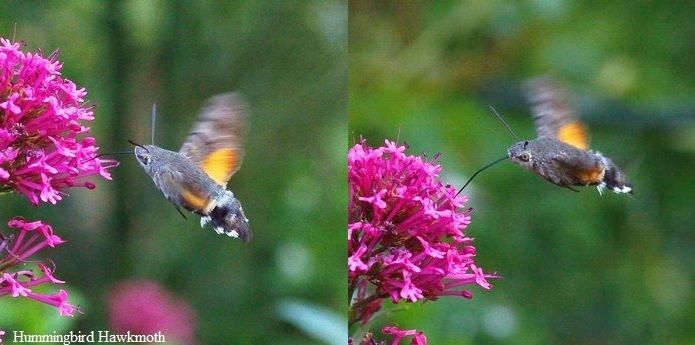
Late afternoon and early evening; a rewarding garden watch......
A very interesting late afternoon/early evening (21st) whilst sat in the garden where a Red Admiral was present.
2 House Martins were then seen albeit high in the sky; the first sighting of this species this year and then 3 Common Buzzards were soaring together before drifting southwards and 4 Swifts were also seen.
An Orange-vented Mason Bee was around the bee hotel and there was a brief appearance of a Hummingbird Hawkmoth on the Red Valerian.
A Hobby flew over and then a teneral Ruddy Darter perched on a Flowering Currant leaf; only the second dragonfly species in the garden this year and my first of the year.
A Holly Blue flew in, followed by 2 Chiffchaff seen in the large tree behind the garden before one flew in and perched briefly on one of the gardens arches.
Later still at least 10 Silver Y moths were in the garden, mainly around the Red Valerian, but also on a Foxglove flower at one stage. This is the most I have seen together in the garden.
Flock or Red Admirals?!
3 Red Admiral were in the garden (19th), a veritable flock, particularly this year when butterflies have been noticeably down in numbers, mainly due to last year’s drought conditions. An Orange-vented Mason Bee was seen as were 2 Silver Y’s.
Green Woodpecker-seen it at last!
I was just about to catch up with some sleep after a late night (17th) when I heard a familiar call. I wasn’t sure where it was coming from, so I checked the area at the back of the dwelling before parting the vertical blinds to look out the front and there was a Green Woodpecker! The woodpecker (a female-black centre to moustache) was on the ground at the edge of the grass next to the path and periodically calling, as I carefully placed the lens of the camera through the blinds, balancing it on the top of the sofa.
Several shots later, albeit through the windows glass the bird finally took flight, but not before I had captured it via the camera. Fantastic, but can’t really count it for the garden itself as the area it was on is council managed (badly) land, so it remains on the ‘seen from garden’ list.
It occurred to me that many people seem to think that these woodpeckers that feed largely on the ground only go on closely cut grass, but I think it is likely that on that terrain is where they are easily spotted, as opposed to looking for Ants and other insects in long grass, which it clearly does!
A juvenile Robin was in the garden along with 3 juvenile Blackbirds, one of which looked like the ‘injured’ juvenile from yesterday. It was sat on the bird table and I put some soft food on the table for it but it flew off quite strongly, so hopefully it will be ok.
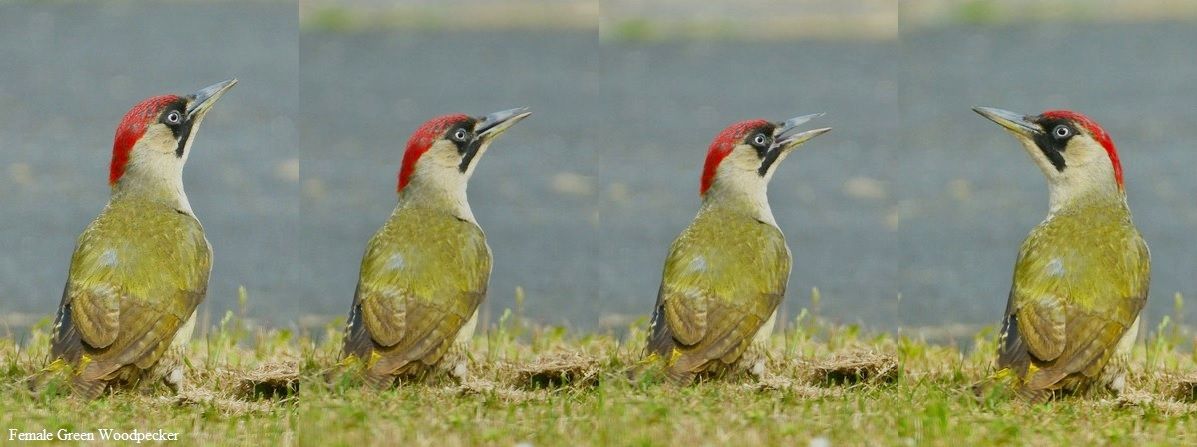
Red Kite in the skies......
A Red Kite was soaring above the garden (16th) and a Greenfinch visited the garden, which is not a common visitor.
Red Mason Bees are continuing to enter the bee hotel and a Tree Bumblebee was seen again.
A young Blackbird was found struggling with its balance in next door’s garden and after inspection was put amongst the vegetation in my garden (better cover).
The constant fluttering of the wings suggested it possibly being stunned by flying into a window, which several juvenile Starlings have been flying into lately. It was calling for food and a male Blackbird was searching for food in the garden, but it is not clear whether it was fed by the adult or not, or if indeed it was that male’s offspring. Somewhat in two minds what to do I left it in the hope it would recover and find food, although some mealworms were scattered around it in the hope that it would find them.
Blackbird finds another use for bark path!
A Hummingbird Hawkmoth (15th) was once again at the Red Valerian (3rd record for year), Red Masons are still at the bee hotel and a single Tree Bumblebee amidst the other Bumblebees and Honey Bees on the B. globosa.
The semi resident very confiding male Blackbird as well as hunting for food has also found another use for the bark path by cleaning its beak on the pieces of wood.
'Hummy' visit number two......
A Hummingbird Hawkmoth was visiting the Red Valerian this morning (14th), a Red Admiral was on the
Buddleia globosa, Red Mason Bees were still entering the bee hotel and a rare sight here (or anywhere nowadays!) a Cuckoo flew northwards.

If you thought nesting birds had any protection in this country, think again!
The hedge-cutting incident during the breeding season (as reported on the Wildlife Garden Diary 29th May 202), has had responses by the police, with a letter of acknowledgement (8th June) and a response from Sally Anderson assigned to the case (14th June).
The letter from Sally Anderson reads as follows and is directly copied from the email I received:
Good afternoon Perry,
I have been assigned your investigation regarding the protection of nesting birds. I have sought advice from our force Wildlife Crime senior point of contact regarding this and his advice is as follows:
It is not a criminal offence to cut a hedge during nesting season although it is advisable not to cut at this time. Under the Wildlife Crime Act, all birds and their nests are protected from damage or destruction (or egg theft) whilst in use and/or being built. Proving this offence is incredibly difficult and generally requires video footage of such offence of an active next that was once active but now is not.
Whilst there is a disturbance offence under the WCA which could be more applicable, this only relates to birds under Schedule 1 of the WCA which is not any common garden species and is unlikely to be a species involved in this scenario but once again, we would have to prove that the bird has actually been disturbed which isn’t very easy when it comes down to one word against another.
I am on leave after tomorrow and won’t be in the office until 2nd July. I intend to speak with your local beat manager with a view to them paying a visit to the property in question to give them words of advice regarding cutting their hedge during the nesting season.
Obviously, if you have any further information that contradicts the above, please feel free to get in touch. I’ll be in the office until 18:30 today then will be in tomorrow morning until midday.
Kind regards,
Sally
PC1590 Sally Anderson
District Crime Unit
Great Yarmouth Police Station
Howard Street North
Great Yarmouth
NR30 1PF
Clearly there is nothing the police are going to do apart from sending a beat officer around to the two people (who carried the cutting of a hedgerow that did not need cutting, was being used or nesting birds and was on the opposite side of their property, bordered by council owned land) but apart from my description, the police do not have the environmental thugs address, so how are they going to do that?!
It would appear that (from the legislation cited in the letter) it is NOT an offence to cut hedges where birds are nesting and that not to cut is purely in an advisory capacity.
‘Common’ garden birds have no protection under these laws and even schedule 1 species disturbance is very hard to prove. In my reply I remarked that these ‘common’ species of birds might not be common for long and whilst I could give a multitude of reasons, ecologically for not cutting hedgerows, particularly in the spring and summer months and the damage it causes to all wildlife (including Hedge-hogs!) I felt it would be pointless to do so in this instance.
What is clear here (although judge for yourself) is that our once woodland-edge species, now consigned to garden species (after mankind fell all but a few pockets of ancient woodland) have no protection whatsoever.
Please be very clear about this; the people who care about our wildlife are in a very small minority in the UK (if not the world) and until there is legislation to stop the practices of constantly keeping nature on a very short leash nothing will change.
I have thought for a long time that people’s housing tax should be evaluated on what their property does to help nature; people tend to take notice when actions affect their pockets and lifestyle!
The day when mankind lives in harmony with his environment and the
other species that cling on to life here due to man’s influence is just a dream.
Worker Bumblebees working hard......
Bumblebees were represented by: Red-tailed, White-tailed, White-tailed, Early and Carder (11th) the majority being workers.
Red and Orange-vented (visited a Perennial Wallflower) Mason Bees were again entering the bee hotel, a Holly Blue settled on a Buddleia globosa flower, where there was also a lot of attention directed by worker Bumblebees and Honey Bees and the first Scaeva pyrastri Hoverfly was seen.
4 Swifts were in the skies and a Common Buzzard flew over heading north.
Cockchafer new for garden and an interesting evening with the hogs......
A Cockchafer Melolontha melolontha was seen flying up from the garden (10th), a first for the garden.
A Holly Blue was once again in the garden, both Red Mason and Orange-vented Mason Bees were using the bee hotel and the first Red-tailed Bumblebee (worker) was the first for some considerable time.
4 Swifts were in the sky and a Kestrel (not often seen here) flew over.
Later after putting out some cat biscuits for the Hedgehogs, I sat in the garden from roughly 22.00 until just past 23.00 and waited for any hogs to appear and indeed they did, with some interesting behaviour!
The first Hedgehog appeared along the concrete path from the gate at 22.07 and briskly walked along the path, past the food past my feet, past the water bowl and disappeared along the bark path uttering what I can only describe as a ‘guttural chuntering’ all the time.
At 22.18 probably the same individual appeared on the concrete path, from the back of the border and still chuntering did the same walk but this time stopping briefly for a drink before walking through the water and off up the bark path again.
At 22.54 a Hedgehog appeared half way down the concrete path, where it is intercepted by a slab pathway to the south of the garden, once again chuntering all the time. At this point there seemed to be two hogs uttering this sound and the one I could see then went into the border, but then appeared again from bark path and started eating the cat biscuits with gusto! Also at this time snuffling noises could be heard from the north of the garden, further substantiating that two Hedgehogs were present, although I only saw one at one time. At 13.03 the Hedgehog left the food and headed out towards the gate.
A very interesting evening and an Oystercatcher was heard going over ‘piping’ at 22.33.
A blue piece of confetti?
A Holly Blue was in the garden (9th) fluttering down like a piece of blue confetti.
Red Mason Bee, Buff-tailed Bumblebee queen and workers, Carder workers and also Early Bumblebee workers and males were all seen.
Green Woodpecker confirmation......
Just before leaving to go out with Jason Nichols (8th) Jason saw a Green Woodpecker fly up from a properties front uncut garden, two bungalows from mine. This confirms what I heard briefly on the 5th and a new species from the garden.
Grey-patched comes to Allium......
A female Andrena nitida Grey-patched Mining Bee was on Allium flowers and the ‘wild rose’ (7th). Not the first record for the garden, but good to see and thanks to Nick (Owens) for confirmation.

More flower choices by Bumblebees......
Worker Bumblebees were feeding on various flowers (6th): Early on Cotoneaster, Red Valerian and Chive; Carder on Cotoneaster.
There was no feeding by the Blue Tits today and it looks like the young have fledged-be lucky!
The Buddleia globosa is now in flower and already attracting attention from worker bumblebees, Buff-tailed queen and Honey Bees.
Blue Tits still bringing in prey and a Green Woodpecker?
The Blue Tits continue to feed young (5th) and I am sure I heard a Green Woodpecker call and a Hedgehog were seen at 21.46 and again at 23.05.
Drifting Kite......
A Red Kite drifted north (4th) and a Pied Wagtail flew low over the garden.
Blue Tits were still feeding young in the nestbox and a worker Tree Bumblebee was seen.
Starling gathering......
9 Juvenile Starlings were in the garden (3rd) at the same time looking for food amongst the bark path, sunning there also and drinking and bathing it the various water sources.
A Small Tortoiseshell was seen outside the front of the dwelling and 4 Swifts and a Swallow were in the skies, but still no House Martin sightings, which although seen in 2022 did not nest.
Bee flower preferences......
It was interesting (as it always is!) to watch what flowers the Bees were feeding on in the garden (2nd), as an indicator to what to plant for pollinating insects.
Orange-vented Mason Bees were going to Borage, Allium and Red Campion, whilst their cousins the Red Mason Bees were feeding on Allium and Borage.
Bumblebee food preference for Early Bumblebee workers were Cotoneaster, Borage, Clematis (probably
C. Tangutica) yellow lantern type flowers (noticed to be utilised in 2022), White-tailed Bumblebee in Foxglove flowers and Carder workers on Borage and Red Valerian.
May 2023
Ignorance is shown again as couple cut back hedgerow during the breeding season in Martham!
Not a good day today (29th) as I saw the couple that live behind the hedgerow out the back of my garden in the aftermath of cutting the hedgerow, whilst I know birds are nesting there.
I understand this to be illegal and as they approached just outside my back gate I said: ‘Excuse me, do you know it is illegal to cut hedges during the birds breeding season?’ The woman replied; ‘Yes but it was cut at this time’!
What can you do against such ignorance and cutting at this time of year on the other side of ‘their’ hedge which is on council land and not affecting them, so why?
Anyway as my last words to her before going back indoors; ‘Then I will report you to the police’, I have done just that, although I say again the police’s interest in wildlife crime I still don’t think is taken seriously enough, but we will see what happens in this instance. Watch this space!
Butterflies; few but notable for that reason!
A male Orange-tip and 2 Holly Blues were of note today (28th).
Two Mason hotel......
A female Orange-tip was nice to see in the garden (27th), albeit briefly and without settling and a Holly Blue was also present.
Osmia leaiana Orange-vented Mason Bees are nesting in the largest Bee hotel alongside their related Red Masons and in the skies was my first Hobby of the year alongside 3 Swift and 2 Swallows. The pair of Mallard continues to visit, mainly for food but also for water and a safe place to rest.
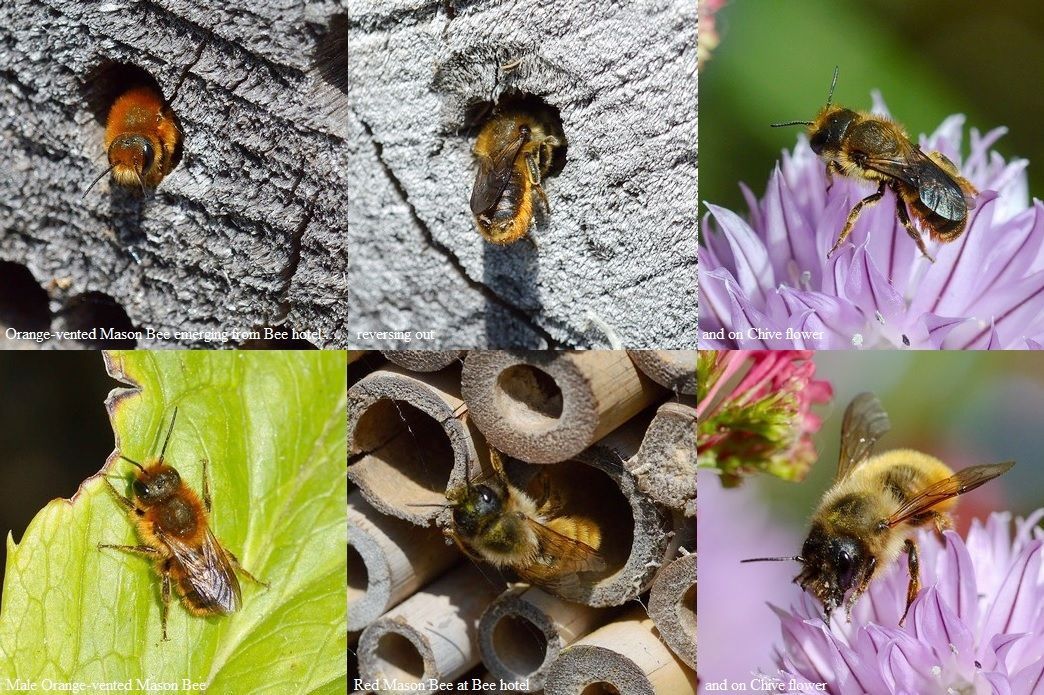

Worn female plumipes and another Orange-tail......
A worn (abdomen) female A. plumipes Hairy-footed Flower Bee was in the garden (26th) on the Red Campion and a female Orange-tailed Mining Bee was once again on an Allium flower.
8 Swifts were in the skies the most seen thus far this year from the garden.
Ready and waiting......
A Hedgehog was already waiting for food at 21.35 (25th) sitting in the small drinking bowl!
Orange-tail on Allium flower......
A female Andrena haemorrhoa Orange-tailed Mining Bee was on one of the Allium flowers (23rd). Although seen in the garden before a very welcome first sighting for the year.
Bee-wise there were also worker Early, Carder and White-tailed Bumblebees and a Holly Blue once again put in an appearance.
3 Swifts were also seen overhead.

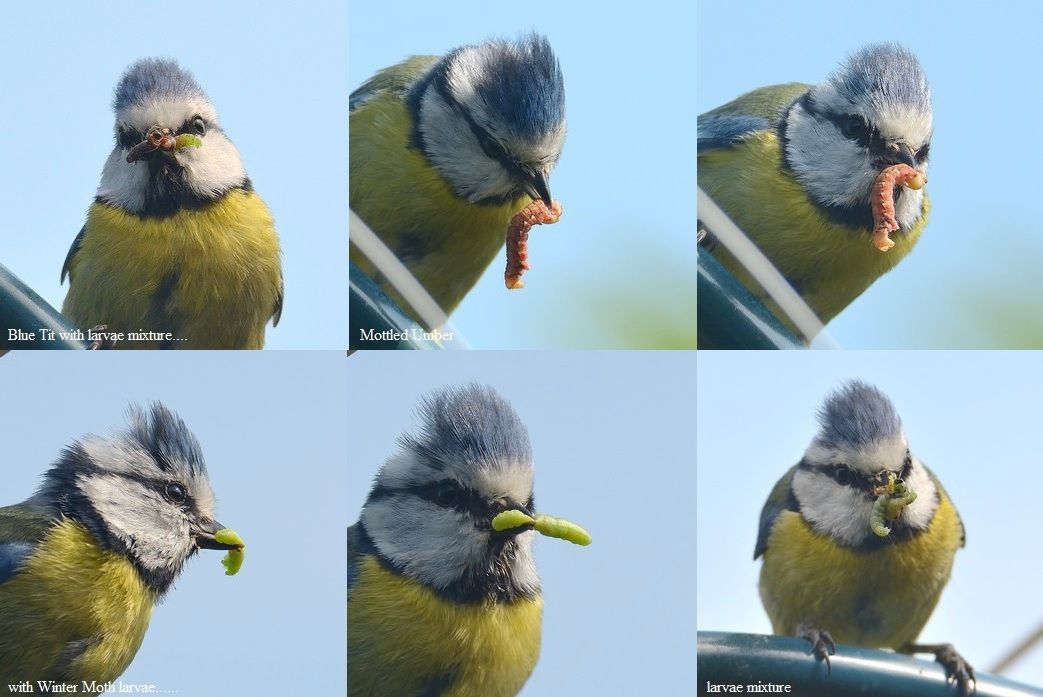
Mottled Umber larvae on the Titmice menu......
The Blue Tits (above) were once again bringing prey in for their nestbox young (22nd) and this included a Mottled Umber larvae (thanks to Ken Saul again, as I couldn’t find this larvae in the newish book on caterpillars, although not surprisingly as the this particular polymorphic form was not in the book!) along with more Winter Moth larvae and various other larvae some of which maybe Sawfly larvae.
Red Kite and Gulls used as refuse collectors......
At least 10 Lesser Black-backed Gulls were soaring around over a person’s garden just across from me (21st) that uses the large Gulls, and Crows to dispose of his waste food, even meat bones. It won’t be long before someone complains about the Gulls and it won’t be the gulls fault, but once again an irresponsible individual is again to blame!
However, whilst counting how many Gulls there were, which also included at least 2 Herring Gulls I noticed a Red Kite also in the sky.
Winter Moth larvae a favourite for Titmice feeding young......
The Red Mason Bees are still busy at the bee hotel (20th) and along with the Blue Tits feeding young, which included a Winter Moth larvae and what looked like a Cranefly species. Thanks to Ken Saul for his input with the moth larvae, which is a species Ken says has long been associated with Blue and Great Tits feeding their young. A Great Tit, which looked like it had just had a bath, was also seen, along with a Holly Blue.

Life cut short for teneral Damselfly by House Sparrow!
The first teneral Damselflies (probably an Azure) maiden flight from the garden pond (19th) was very short lived! It had barely got 5 feet from the pond before being caught in flight by a female House Sparrow.
This is not the first time I have seen House Sparrows predating dragonflies as back in the early 2000’s many of the Broad-bodied Chasers leaving my ponds in Forncett St. Peter were caught, flycatcher-like by House Sparrows during their first flight from the ponds. In fact I found pairs of dragonfly wings around the garden, where the sparrows had severed them from the protein-rich body. At other times I have seen House Sparrows looking under plants such as Butterbur around the ponds for emerging dragonflies. This was borne out one day when I saw a newly emerged Southern Hawker in the beak of a House Sparrow.
Also in the garden today was Holly Blue, Red Mason Bees around the bee hotel, Blue Tits feeding their young (sure there is more than one pair!) and 4 Swifts were in the skies.
Bees, Butterflies and Hogs......
The first A. plumipes Hairy-footed Flower Bee for some time (18th) was seen entering the bee brick and Red Mason Bees were still being very industrious at the bee hotel. It is great to see the Bees using these artificial nest sites provided for them.
A Holly Blue was again in the garden as was a male Orange-tip, which settled briefly before flying off again.
2 Swallows flew over as did 3 Swift and at 22.15 two small to medium Hedgehogs were feeding together on the cat biscuits provided but also searching in the border for more natural prey.
Blue Tit feeding......
A Blue Tit (probably the female) flew out from the middle nestbox to the tree outside the garden where she was given food from presumably the male, before flying back to the nestbox.
A hat-trick of Raptors in the late afternoon......
A late afternoon (17th) spell sitting in the garden was very worthwhile, with a Common Buzzard soaring overhead, followed by a Red Kite drifting east and then a Marsh Harrier flying north-west. 2 Swifts were also in the sky.
Bumblebees were represented by worker Early, Carder, White-tailed and a Large Red; the first for some time.
Red Mason Bees were once again utilising the bee hotel and Blue Tits were coming in with small prey items for the young.

First Orange-vented Mason Bee......
A male Orange-tip briefly settled on a Red Campion flower (16th) and also 2 Holly Blues and a ‘small’ white butterfly was probably a Green-veined White were seen.
There was a lot of Red Mason Bee activity around the Bee Hotel and the first Orange-vented Mason Bee (male) Osmia leaiana of the year was seen entering a hole in the bee hotel and on the face of the wooden drilled blocks.
Also seen and photographed was the tiny spider known as a Zebra Spider Salticus scenicus.
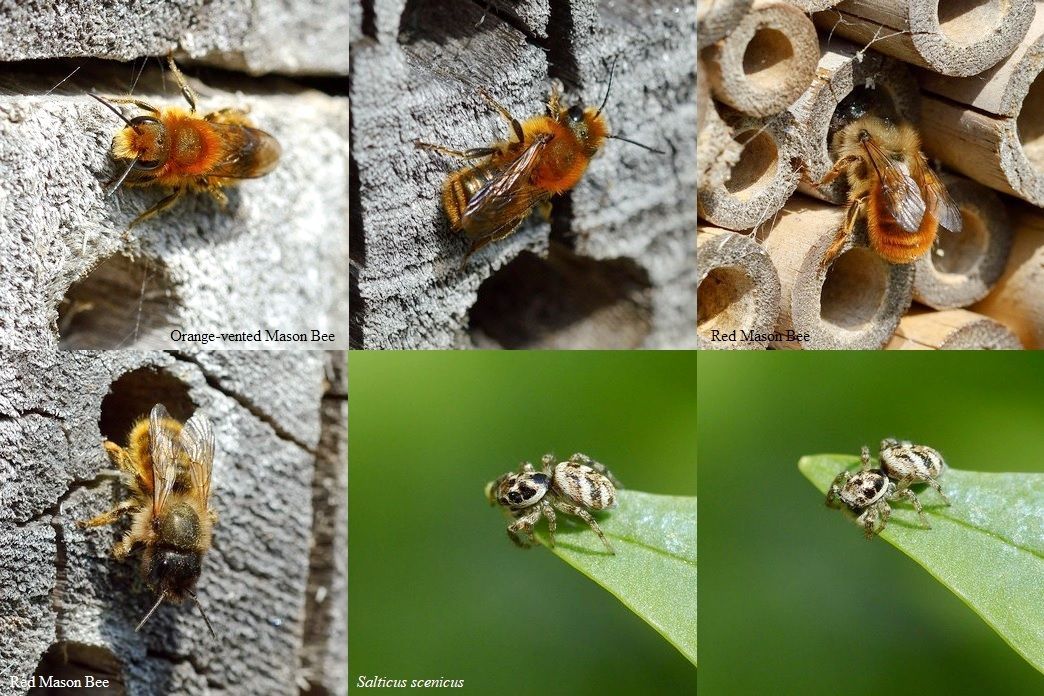
Yet another Chiffchaff in the garden......
A Swift was again seen overhead (15th) and a nice surprise, whilst sitting out in the garden was a Chiffchaff around the pond.
Blue Tits feeding young......
The Blue Tits were seen entering the middle nestbox with small green moth larvae (14th) and 2 juvenile Blackbirds along with a male with worms were also present.
Red Mason Bees continued their nesting in the bee hotel and several Early Bumblebees were on the Borage flowers. A Holly Blue was seen again and 3 Swifts were in the skies.
Starlings and Masons......
A Swift was seen again (11th) and there were lots of Starling activity involving both adults and juveniles.
Red Mason Bees were still entering the bee hotel and a Holly Blue was once again in the garden.
First Swift......
Red Mason Bees were entering the bee hotel (10th) and a Holly Blue was also in the garden.
The first Swift was seen and a Blue Tit was going into the middle of three nextboxes.
Hummingbird hawk!
A juvenile Starling and a Magpie were present (8th), but the highlight came with the first appearance of the year of a Hummingbird Hawkmoth briefly on the Red Campion flowers.
Blue Tit in the box and soaring Buzzard......
A Blue Tit was seen flying into the middle box of the three compartments, originally made for House Sparrows (1st). Whether or not there is still a pair nesting in the northern box and this is another pair is unclear at the moment.
A Dark-edged Bee-fly and a female Hairy-footed Flower Bee were also present and a Common Buzzard was seen soaring in the blue skies above the village.
April 2023
First Swallow and Dunnocks in and out of the garden......
Dunnock activity has been fairly frequent in the garden over the last few days and mating was performed after much female quivering yesterday (28th).
The first Swallow was seen heading north (30th) from the garden, but no doubt wanting to get away from the awful noise and poor taste in music coming from the Martham fair!
A Holly Blue and Peacock were once again present and a Red Mason Bee was good to see again after an absence of sightings along with Buffish Mining Bee and a female Hairy-footed Flower Bee entering the mud bricks.
Birds present were: 2-3 Dunnock, Wood Pigeon, Collared Dove, House Sparrows (approx’ 6) 4 Starling and a Blue Tit.
Mourning Bee hangs around......
A Common Mourning Bee was present on and off all day (29th) mainly on the Flowering Currant. Buffish Mining Bee was also seen and a female Hairy-footed Flower Bee made frequent visits to the Borage flowers.
Both a Peacock and a Holly Blue were also seen as was a Dark-edged Bee-fly on the Lesser Celandine and a Eupeodes luniger Hoverfly was also present.
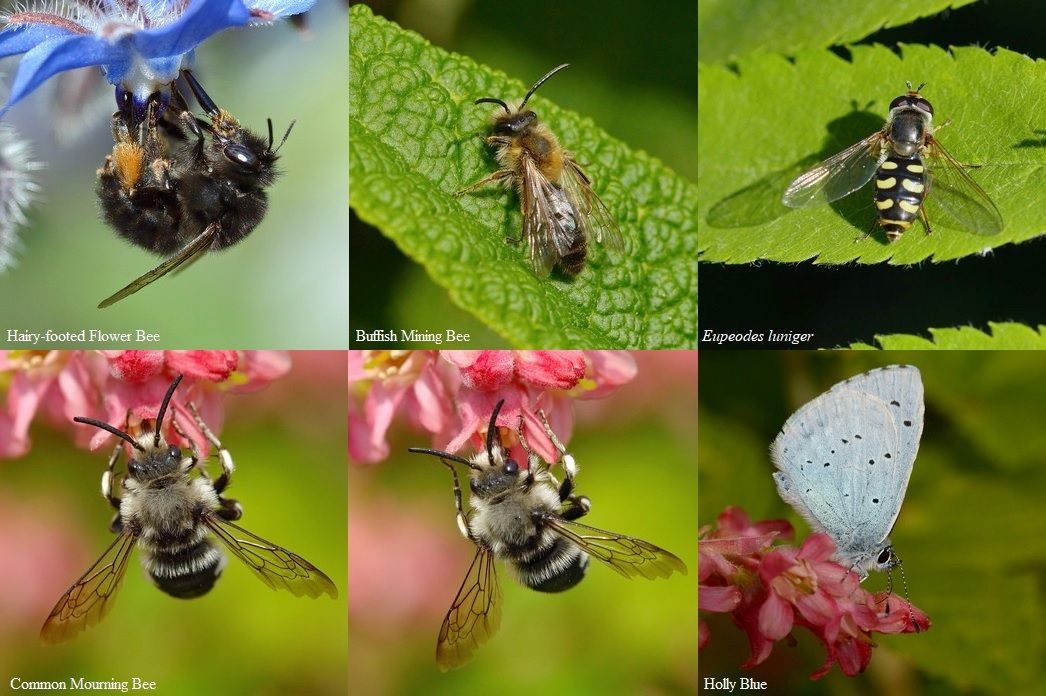
2 x Hogs......
2 Hedgehogs were present at 21.45 (27th) when they came for cat biscuits put out for them.
Blue......
A Holly Blue was seen on two occasions in between the showers (23rd) and a Tree Bumblebee was also present.
Three new Insects for the year......
Around 15.00 I decided to sit outside in the garden with a cup of tea (22nd) and that proved to be a good decision!
Three new insects for the year were seen with a Andrena fulva Tawny Mining Bee, Bombus hypnorum Tree Bumblebee and a worker Vesta crabro Hornet.
Red Mason Bees were seen on the Three-cornered Leeks, which were also visited by female Hairy-footed Flower Bees.
Both Early and Buff-tailed Bumblebees were also present along with the buff-tailed cleptoparasite, the Dark-edged Bee-fly.
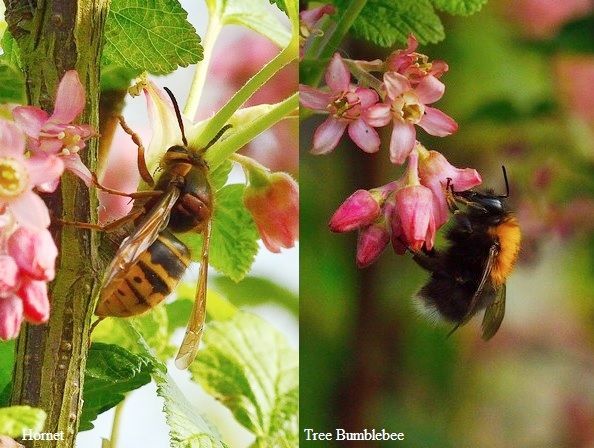


Nestbox enigma......
A Blue Tit was seen with nest material (19th) but appeared to fly to a different nestbox (on the shed wall) and not the one a pair were using!
E. elegans at rest......
An Epistrophe elegans Hoverfly (right) was found at rest on a Buddleia leaf and a female House Sparrow was in collecting nest material.
Mourning again......
A Mourning Bee was once again on the Flowering Currant (16th) and a female Hairy-footed Flower Bee was actually seen entering one of the holes in the bee-bricks, which are proving to be a success.
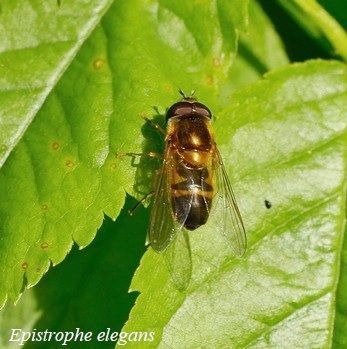
Insect variety including M. albifrons......
A nice selection of insects in the garden today (15th), where one of the highlights being a Melecta albifrons ‘Common’ Mourning Bee on the flowering current, where it was duly photographed.
Buffish Mining Bee, 2 female and one male Hairy-footed Flower Bee (M. albifrons is the cleptoparasite of these bees!), 4 Buff-tailed, ‘unknown Red-tailed’ and Carder Bumblebees.
2 Dark-edged Bee-flies (the cleptoparasite of Buff-tailed Bumblebee) were around the Grape Hyacinths, a Peacock, and Eristalis pertinax Tapered Hoverfly and a Syrphus Hoverfly species, possibly an S. torvus.
A Red Kite was good to see drifting north in the afternoon, the first from the garden this year.
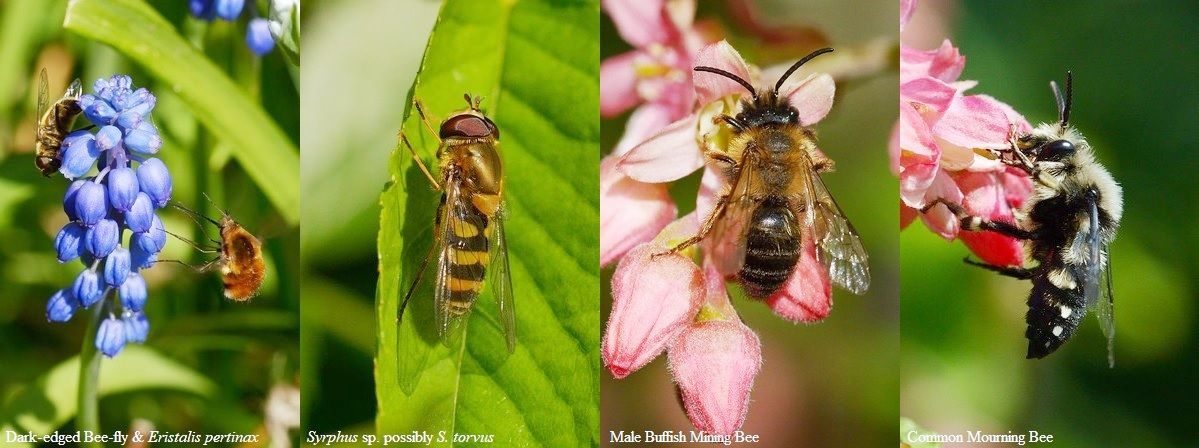

Two more Bombus and earthworks at the mud bricks!
The first Carder Bumblebee Bombus pascuorum and Red-tailed Bumblebee B. lapidarius were seen today (13th), along with White-tailed and Buff-tailed Bumblebees.
A Peacock was also present on the Forget-me-not flowers and on a Grape Hyacinth, before resting out of the brisk wind on the bark path. Also seen was a female A. plumipes on a Three-cornered Leek, followed by the discovery of earthworks at the mud brick hotel, put in place for this species and presumably the work of A. plumipes after some recent brief glimpses of a small black bee near the mud bricks.
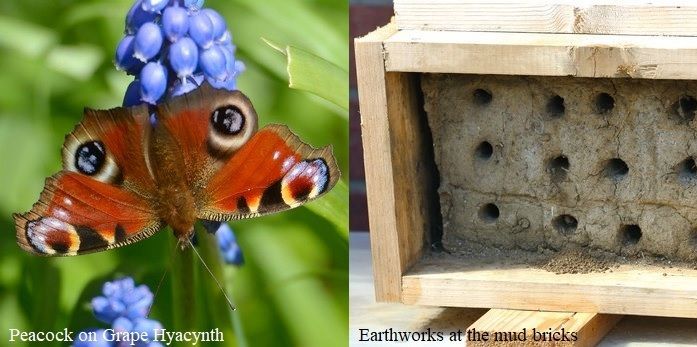
Melecta albifrons next door and Hedgehog visits......
Two visits from two different Hedgehogs occurred (12th) at 23.17 (small individual) and at 23.40 (large).
Earlier in my next door neighbours (Annie) garden, whilst helping her out with some maintenance a Common Mourning Bee Melecta albifrons flew over the garden and landed. I don’t know why this is called ‘common’ as it is only the 3rd one I have ever seen and according to Nick’s (Owens) book ‘The Bees of Norfolk’ they are not that widely spread in Norfolk.
Brambles and the Blue Tit!
A Blue Tit was once again picking up beaks full of hairs from Brambles the Rabbit, put out for that purpose. It's amazing how much help a Rabbit is in my endeavour to garden for wildlife; consuming cuttings (only plants suitable for Rabbits, supplying nest material for birds and compost for plants; well dome Brambles!
Both male and female Buffish Mining Bees, female
Anthophora plumipes and a
Bombus lucorum were also seen.
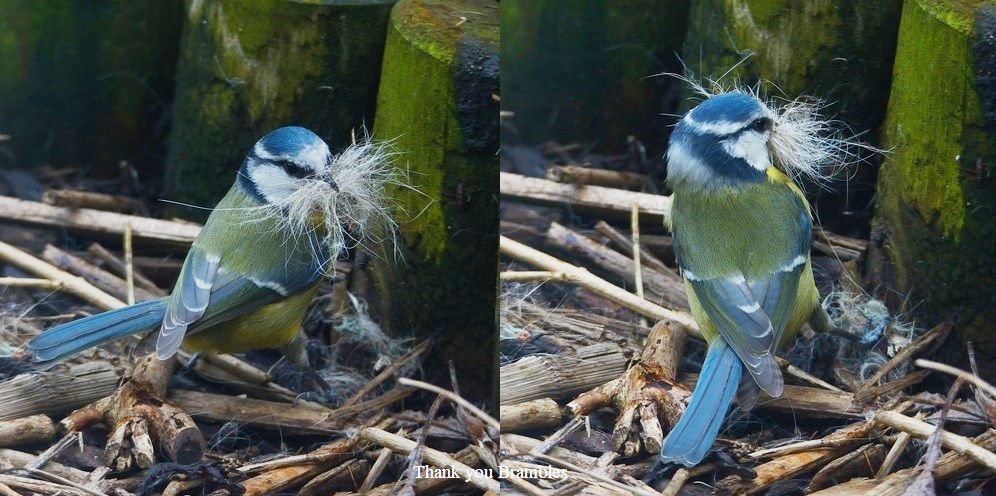
Nesting beginning......
A Blue Tit was actually seen entering the previously unused nestbox with nest material (9th).
A Peacock was again briefly in the garden along with a Bee-fly, Buff-tailed Bumblebee, Honey Bees on the Three-cornered Leek and Grape Hyacinth flowers and a Common Wasp on the Flowering Currant flowers.
A Spring Chiffchaff......
A Chiffchaff was good to see in the garden’s Flowering Currant (8th).
A Blue Tit was picking up Brambles the rabbits hairs (my great gardening companion!) put out for nest-building purposes and flew in the direction of the N.E nestbox, but I couldn’t see if it entered.
The first female Anthophora plumipes Hairy-footed Flower Bee was seen briefly and both Early and Buff-tailed Bumblebees were also present and a Peacock was also a brief visitor.
Other birds today were: 2 Dunnock, 2 Blackbird, 2 Wood Pigeon, 2 Starling and 5 House Sparrow.
Hedgehog visit and birds......
A Hedgehog came for food at 21.05 (6th) and the following day (7th) 3 Starling, 5 House Sparrow, Collared Dove, Wood Pigeon, 2 Blackbird, 2 Blue Tit, Dunnock and 2 Mallard.
So, the attack on 'taming' Nature begins again in earnest......
So it begins (5th) the constant sound of humming and it’s not Bees! It’s the ‘gardeners’, the neat and tidy, blinkered people and their hatred of ‘weeds’ with their strimmers, lawnmowers and hedge trimmers in their relentless fight with Nature.
At the end of the Second World War lawns were considered a status symbol; more like a statement of ignorance!
The council will soon be on their way too with their weed killer, strimmers, ride-on mowers and noisy leaf blowers and all this to stop the very things that help keeping us alive by producing oxygen. Whilst it would make global and indeed economic sense to treat areas of grass as wildflower meadows; councils can’t do that, but why? Is it because ignorant people telephone and complain about the so-called ‘untidiness’ or is it because Great Yarmouth Borough Council are too ignorant to make decisions for the greater good of both Nature and people in this country.
Our countryside is dying and dying fast, but what is being done? Not a lot from where I am sitting, just the occasional gesture of planting a few trees and then sitting back smugly and saying; ‘look at what we have done for the environment!’
Every square metre is precious and not to be covered with concrete, shingle and any other unnatural surface like the repulsive plastic grass. If you can’t plant a garden with plants that benefit our wildlife and like everything neat and tidy without the intrusion of plants/weeds, then go live in Tesco’s car park (other supermarkets are available) or a high-rise flat and leave properties to those that want and are willing to benefit our dying world. Too much? Not nearly enough!
Meanwhile bank in the 'sanctuary'......
Meanwhile in the sanctity of the garden the first Bombus pratorum Early Bumblebee appeared on the Flowering Currant and an Andrena nigroaenea Buffish Mining Bee was also a first for the year. 2 Dark-edged Bee-flies were also seen.
A Blue Tit was heard tapping inside a nestbox; not sure why they do that exactly but there must be a reason as I have heard them doing this for many years. 2 Robins together were good to see, but will they chose one of the open-fronted nestboxes in the garden?
Also seen were: 2 Dunnock, Collared Dove, 2 Wood Pigeon, 5 House Sparrow, Starling, Blackbird and 3 Mallard.
First Bee-fly of the year......
The first Dark-edged Bee-fly Bombylius major was seen (4th), somewhat predictably on a Grape Hyacinth!
3 Buff-tailed Bumblebees were seen; a queen and two workers on the Flowering Currant in the morning.
3 Blue Tit (including varied facial bird and one tapping at a previously unused nestbox), Dunnock, 2 Starling, 2 Blackbird, 2 Collared Dove, 2 Wood Pigeon and a pair of Mallard were also present.
Flowering Currant flowers becoming popular for Bees......
A Buff-tailed Bumblebee visited the Flowering Currant flowers (3rd) as did a Red Mason Bee.
3 Mallard, Collared Dove, Wood Pigeon, Blackbird, Starling, 2 Blue Tit (one of was the unusual facial patterned individual), 4 House Sparrow and a Pied Wagtail was on a neighbouring rooftop.
Later a Hedgehog visited the garden at 21.25 and again at 22.18.
Mason to Leek......
A Red Mason Bee visited a Three-cornered Leek flower (2nd).
March 2023
Hedgehog sightings 25th-27th......
A Hedgehog was enjoying supplementary food put out at 22.52 (27th).
A different ‘medium’ sized Hedgehog from the previous date came for food at 00.36.
A ‘medium’ sized Hedgehog was present at 23.35 (26th) and again at 23.57.
2 ‘Large’ Hedgehogs came for food at 22.00 (25th), with one curled up in a ball on the path.
Unusual facially patterned Blue Tit continues to visit garden......
A Wren visited the garden (22nd) searching for prey and also seen were: Blue Tit (unusual facial pattern individual), Blackbird, Starling, 2 Collared Dove and a Wood Pigeon.
A butterfly flew past the window, possibly a Small Tortoiseshell and a Red Mason Bee was on a Three-cornered Leek flower.
First definite Red Mason Bee of the year and a Hawfinch in a Gorleston garden!
Yesterday’s sightings of a Bee were almost certainly an Osmia bicolor Red Mason Bee, as today (22nd) I saw one whilst at rest on a Buddleia. The first of the year and here is hoping for many more bees.
A Butterfly flew past the lounge window; judging by size probably a Small Tortoiseshell, but not sure.
The Mallard were back in the garden and this time the pond was too good to resist! Although they are welcome in the garden (far safer than the village where they are a target for motorists!), I don’t want the pond made devoid of invertebrate life, so as in previous years the bamboo cover is due over the pond, although that doesn’t always stop them!
Meanwhile, in Jason Nichols’ wildlife garden at Gorleston (on a housing estate) (much to his surprise), he saw a female Hawfinch in his garden. It also came for food on his feeding table. A fantastic record for a suburban garden and just shows what rewards there are for sharing your space with wildlife!

Return of the Ducks......
A pair of Mallard entered the garden today (21st) for the first time this year.
A solitary Bee was seen but I couldn’t get a good look at it, but a Buff-tailed Bumblebee I did see well enough; the first actually in the garden this spring.
Garden Diary Notes 17th-20th and a variably plumaged Blue Tit......
The unusually plumaged Blue Tit was in the garden once again (20th) and this time I managed to get some images of it.
A Wren, 2 Dunnock (briefly mating after much quivering from the female), 2 Blackbird, Wood Pigeon and the first Wasp (presumably Common Wasp) were also seen.
2 Blue Tits were present (19th) but one of them had an unusual facial pattern. This particular bird has been seen for several weeks now and may well be part of a pair visiting the garden. The reason for the varied facial pattern is not clear and it also has a larger than ‘normal’ sized bill. Again unclear on the reason why, but it has been shown in studies on Great Tits that their bill morphology changes seasonally.
Collared Dove, 3 Wood Pigeon, 3 Blackbird and 2 Starlings were also present and a Song Thrush was heard singing somewhere to the SW of the property.
The first Goldfinch of the year was in the garden (17th).
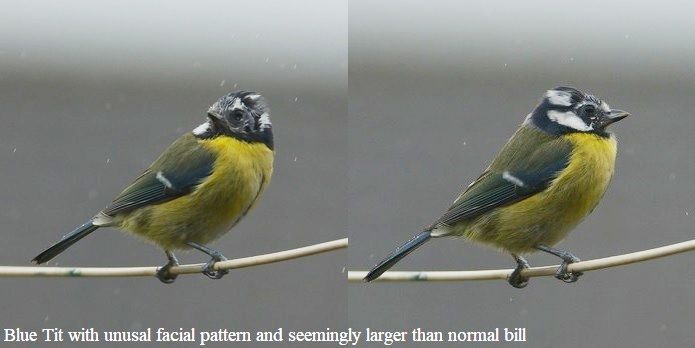
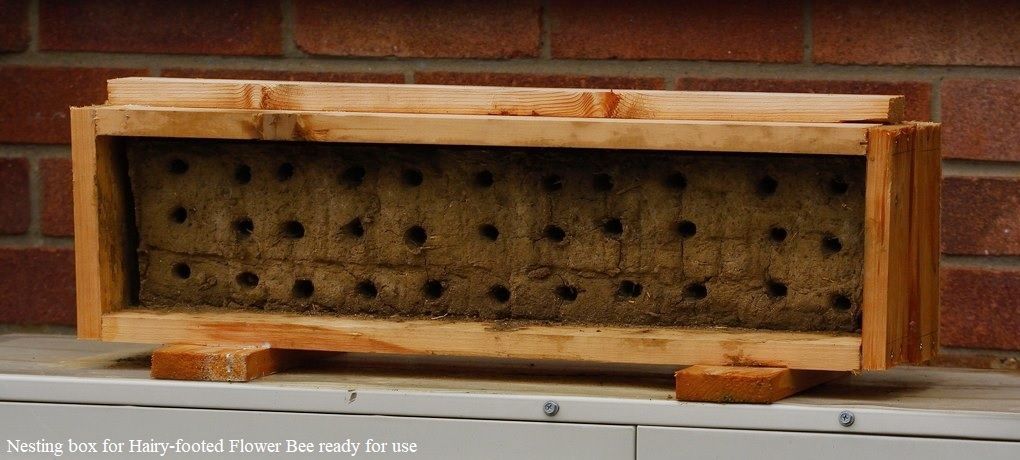
Wren; always good to see......
Always good to see in the garden was a Wren (16th) and also of note were 4 Blackbird, Dunnock, 8+ House Sparrow and a Wood Pigeon.
Hedgehog activity......
2 Starling, 3 Blackbird, Robin, Dunnock (picking up hairs but then dropped them), 2 Collared Dove and a Wood Pigeon were garden visitors (14th).
Whilst doing a spot of gardening a Hedgehog dropping was found and later in the evening food was provisioned for them.
At 4.00 (15th) the food had entirely gone and later there were Hedgehog droppings found outside the back door.
Birds in garden and Frogspawn in Gorleston......
Over two days (11th and 12th) the following birds were recorded in the garden (highest counts): 5 Blackbird, 3 Wood Pigeon, 2 Collared Dove, 4 House Sparrow, Starling, 2 Dunnock, Robin and 2 Blue Tit.
Elsewhere, on the 11th, Jason Nichols had Frogspawn in his garden pond in Gorleston. The first I have heard of locally.
For further information on the progress of Common Frogs and Toads spawning across the UK see the Freshwater Habitats Trust Spawn Survey Results 2014-2023.
Diary Notes; 1st-9th......
Prior to going out further afield; a Wren was on the fence (9th) and also present were: 2 Blue Tit, Collared Dove, 4 House Sparrow, Starling, Wood Pigeon and 3 Blackbird.
Over two days (6th and 7th) maximum numbers of birds were: 2 Blue Tit, 4 Blackbird, Collared Dove, 2 Wood Pigeon, 2 Dunnock, 5 House Sparrow, 4 Starling and a Robin
3 Blue Tits were in the garden together (3rd) with two bathing together in the Hedgehog bowl.
Also seen were: 2 Blackbird, Wood Pigeon, Collared Dove, Dunnock, Robin and 4 House Sparrow.
A Cormorant flying over north (1st) was of note at the start of the month.
In the garden saw; 2 Wood Pigeon, Robin, 3 Blackbird, 2 House Sparrow, 3 Starling, Dunnock and a Collared Dove.
February 2023
First Bumblebee, albeit outside garden......
A Bumblebee species was seen just outside the garden (20th) and several Lacewings were on the wing, whilst indoors Fly-species had awoken!
4 Blackbird, Blue Tit, 2-3 Dunnock, Wood Pigeon, 2 House Sparrow and 2 Starling were the avian visitors.
False Widow, but garden shed tidy-up took precedence!
3 Blue Tits were once again in the garden together (21st), along with 2 Blackbird, 2 Starling, Dunnock, 5 House Sparrow and a Robin.
Preparing to clear the garden shed out I found a False Widow Spider species in the doorway. As I thought it best to get on with the clear out and tidy-up, whilst I was in the mood to do it, I stopped myself from getting distracted by fetching the camera to photograph the spider!
Wren......
A Wren was searching for insects (22nd) and 3 Blackbird, Robin, Dunnock, 2 Starling, 2 House Sparrow and a Wood Pigeon were also seen.
Frogspawn update......
The latest news of Common Frogs spawning is courtesy of Herpetologist Mike Linley.
Frogspawn was laid on the Isles of Scilly on the 28th December 2022 and in Cornwall, during the last week of January 2023.
Blue Tits; hoping they breed in garden nestboxes......
Yesterday (17th) there were 3 Blue Tits in the garden with two bathing together, but today (18th) we were back to 2. However, their continued presence gives hope to them nesting in one of 5 artificial sites in the garden.
Also present were: 3 Collared Dove, 2 Wood Pigeon, 4 Blackbird, 2 Robin, Dunnock, 6 House Sparrow and a Starling.
Robins singing......
Robins were singing from various places (14th), both in the garden and outside the garden from the very top of a tree.
2 Robins were feeding together again, along with 2 Collared Dove, 2 Dunnock, 2 Blackbird, Blue Tit, Wood Pigeon and 4 Starlings; two of which were singing from a rooftop aerial and the top of the street light.
An improvement (hopefully!) on the mud bricks originally made for Hairy-footed Flower Bees (see Wildlife Articles) was constructed today, using Cricket Pitch Loam, sand and pieces of hay, moulded in a wooden box.
Whilst the Flowering Currants have buds on them and Honeysuckle also having buds there is not too much to attract insects into the garden at the present time, with the Winter Heather having seen better days!
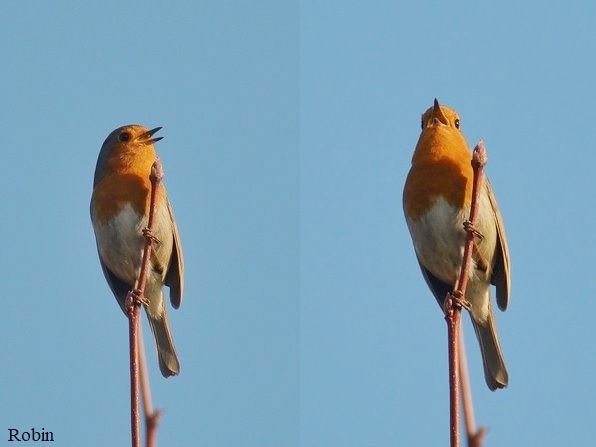
Grateful for once that I needed to do the washing-up!
6 Blackbirds were present today (11th), four of them females.
Also seen were 2 Blue Tits, Great Tit, 2 Dunnock, 2 Robin, Wood Pigeon, 2 Collared Dove, 6 House Sparrow and 4 Starling.
However, the star visitor was a Chiffchaff, which flew to just outside the kitchen window as I was about to do the washing-up. The Chiffchaff (only the second record and a different one to the pale bird seen in January), spend at least 5 minutes in the garden searching for food and albeit through the kitchen window, I managed to get some half-decent images of it.

Icy start again......
Another early morning frost (8th) warranted de-icing of the water sources again but what a pleasure to see the birds able to drink and bathe, whilst the pond remained iced.
5 Blackbird, 2 Blue Tit, 2 Robin, 2 Dunnock, 6 Starling and at least 8 House Sparrows were present.
2 Wrens and first Butterfly......
The second day of hard frosts in the morning (7th) saw 2 Wrens in the garden together. Other avian species were: 3 Blackbird, 5 Starling, 7 House Sparrow, 2 Robin, Blue Tit, Dunnock, 2 Collared Dove and a Wood Pigeon.
A butterflies’ silhouette was seen, through the vertical blind louvers as it flew passed the lounge window. It was probably a Peacock, judging by size and time of year.

Apples still in vogue with Blue Tits......
A Blue Tit arrived in the garden (6th) and went straight for the apple! This one of 2 Blue Tits to visit the garden along with 5 Blackbird, 2 Robin, Dunnock, 6 House Sparrow, 3 Starling and a Wood Pigeon.
Diary notes 4th and 5th......
2 Robins were once again in the garden (5th) feeding side by side on the path where there were mealworms. 8 Starling, 2 Blue Tit, 3 Blackbird, Collared Dove, Wood Pigeon, 7 House Sparrow and a Dunnock were also seen.
A very ‘bedraggled’ Collared Dove visited the bird table (4th), possible narrow escape from a cat! Also present were: Robin, 2 Wood Pigeon, Dunnock, 3 House Sparrow, 3 Starling and 4 Blackbird.
Both Ivy plants and Wild Privet have been planted in the hope of eventually providing nesting sites and more species.
Pheasant fly-in......
Another positive for potential breeding Robins in the garden (3rd) was one singing from the garden fence. Blue Tit/s was once again feeding on the skewered Apples at least two visits recorded to the apple and two birds present.
A surprise, was a cock Pheasant flying in and searching for food on the grass outside the back garden. This species has only been recorded once before.
Also visiting was: 4 Blackbird, Dunnock, 6+ House Sparrow, Wood Pigeon and a Great Tit.
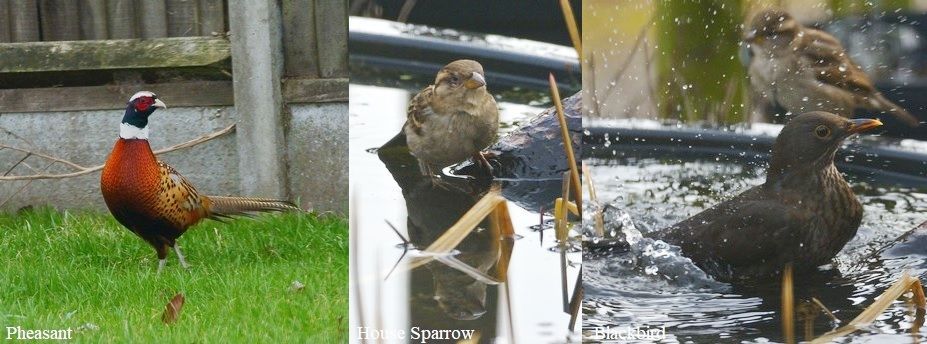
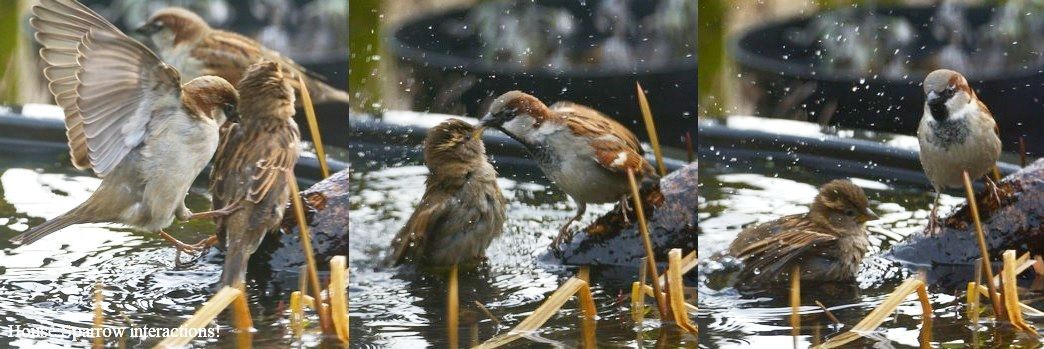
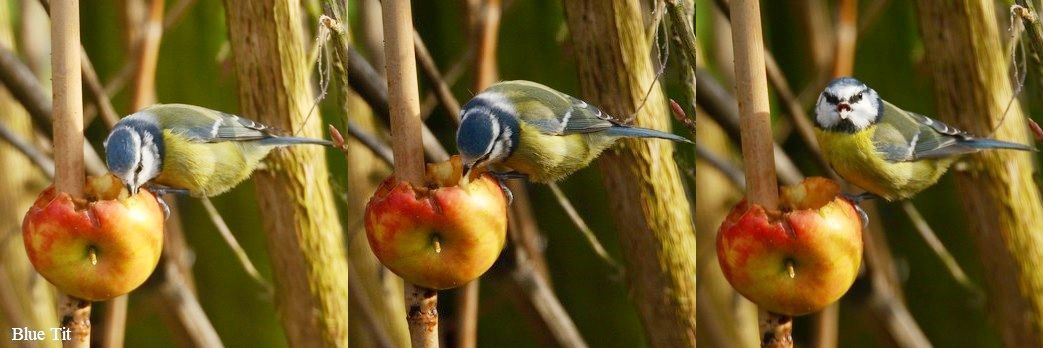
Garden Diary 1st & 2nd......
Although, I was ‘out in the field’ all day (2nd), I managed to record a nice selection of birds in the garden: 6 Starling, 5 Blackbird, 2 Dunnock, 4 House Sparrow, Wood Pigeon, a Blue Tit feeding on Apple again and a Robin.
February began (1st) with: 2 Blue Tit, 2 Robin, 2 Blackbird, Wood Pigeon, 2 Starling and a Wren.
January 2023
Co-existing birds......
2 Robins were in the garden (31st) happily co-existing, so maybe hope to a return to breeding in the garden. One of the Robins was feeding on the hanging fatballs; perhaps a shift in dietary requirements with the forthcoming breeding season looming, although Robins do go on fatballs at other times of year, but this is the first time I have seen it do it in the garden.
2 Dunnocks were present briefly, with one seeing the new arrival off. On a more congenial note, 3 Collared Doves were feeding together in close proximity, when only a short while ago there had been marked territoriality!
Other birds present were: 3 Blackbird (mainly feeing on the Pear and Apple offerings), 10+ House Sparrow and a Starling.
A very good January in the garden with three new species of birds!
First Hoverfly of the year......
A ‘small’ Hoverfly was the first this year (30th) but didn’t hang around for identification!
Avian visitors were: 8 House Sparrow, 3 Blackbird, 2 Starling, Robin, 2 Dunnock (possibly 3) and a Wood Pigeon.
Wren and Great Tit welcome additional avian visitors......
A Wren was once again a welcome visitor to the garden (29th), as was a Great Tit. Other birds were: Wood Pigeon, 3 Blackbird, Dunnock, 2 House Sparrow, and 2 Collared Dove.
Birds today......
Birds today (28th) were: Blue Tit, 4 Starling, 3 Blackbird, Dunnock, Robin, 2 House Sparrow and a Collared Dove.
Yet another Garden first; a Chiffchaff!
2 Dunnock, 4 Blackbird, 2 Wood Pigeon, at least 10 Starling, 6 House Sparrow and a Robin were seen (25th), but the star of the day was a Chiffchaff briefly in the Buddleia at 15.00. This was a first for the garden (the third new garden species for January) and only heard calling before, some distance away.
Pinks fly-over......
A total of approximately 400 Pink-footed Geese flew over north in three separate skeins (24th).
In the garden were: Robin, 3 Blackbird, Wood Pigeon, Starling, 7 House Sparrow and Dunnock.
Brief Blackcap sighting......
The female Blackcap was seen again (22nd), making a brief appearance before flying off again.
Also present were: 2 Blue Tit, 3 Blackbird, 7 House Sparrow, Dunnock, 2 Wood Pigeon, Starling, Robin and Collared Dove.
The 2nd new garden bird for January 2023!
With the morning’s hard frosts and frozen water sources continuing, it was imperative to get out there and provide for the garden birds (20th).
Once again, 2 Blue Tits were present with one of them making two visits to the skewered Apple. I wonder if this is a new food source for this species as it is certainly becoming commonly seen in this garden at least!
5 Blackbirds were also feeding on the Apples put down for them and also seen were: 2 Wood Pigeon, 8 House Sparrow, Robin, Dunnock and 7 Starling.
A visit to the kitchen for a whiskey glass found a second new bird for the garden this month-a Song Thrush (right and below)!
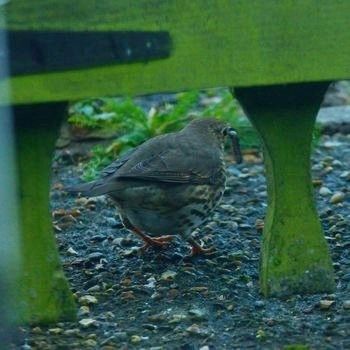
Only recorded once before outside the garden, this was a very welcome surprise and despite the presence of higher hierarchal Blackbirds, it managed to find a larvae (possibly a leatherjacket-Cranefly larvae) approximately an inch long, which it then took out through the Hedgehog entrances in the garden gate, so it could consume its prize unhindered from the several Blackbirds present.
The Song Thrush was then seen through the garden fence, before it returned and perched on the log in the pond, before deciding to continue its search for food out of sight elsewhere in the garden.
Once, an often seen Thrush, but sadly has not and haven’t been the case for a very long time now. I used to find their mud-lined nests with their pale blue, black spotted eggs in my Nan’s garden hedge but now I very seldom hear or see this bird and certainly not where I live in Martham, or indeed during my travels in Norfolk! Indeed, the last time I saw a Thrushes anvil was on the Hobbit! Just another of the majority of declining species, here and elsewhere in the world!

Blue Tits; x2 feeding on apples......
Three Blue Tits were present (18th) with all three around the skewered Apples, with two of them feeding on the fruit.
Also present were: Collared Dove, Wood Pigeon, Robin, 3 Blackbird, 3 House Sparrow and 8+ Starling.
Skewered Apples attract both Blackcap and Blue Tit......
The ‘skewered’ apples and pear (put out 14th) did their job today (17th) when a female Blackcap was seen in the morning eating the apples. It then went down to the bird bath (which luckily I had already been out and poured some hot water over the frozen water, to facilitate some drinking water) and drank from the unfrozen edges. Although it was dull and through the kitchen window I managed to record the Blackcap in the garden.
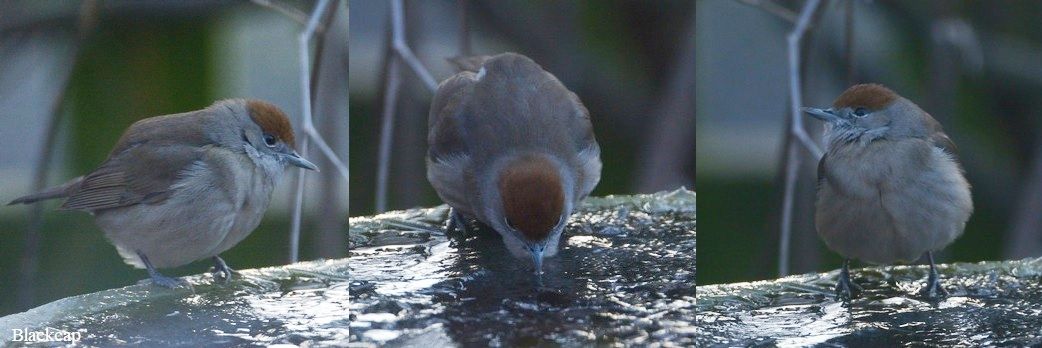
A Blue Tit (one of two present today) was once again eating an apple, after being thwarted reaching the fatballs by 2 House Sparrows, maybe the preferred option but then went directly to the 'fruit on a stick' and this time I managed to capture it doing so. This appears to be unusual behaviour judging by comments made by a couple of my ‘associates’ in the trade, so to speak.
The Blackcap returned to the apples at 12.56 and I managed to capture some more images, but once again not great light conditions. Still, great to have the Blackcap return to the garden.
Also in the garden were: 6 House Sparrow, 9 Starling, Wood Pigeon, 2 Dunnock, Robin, 2 Blackbird and a Collared Dove.
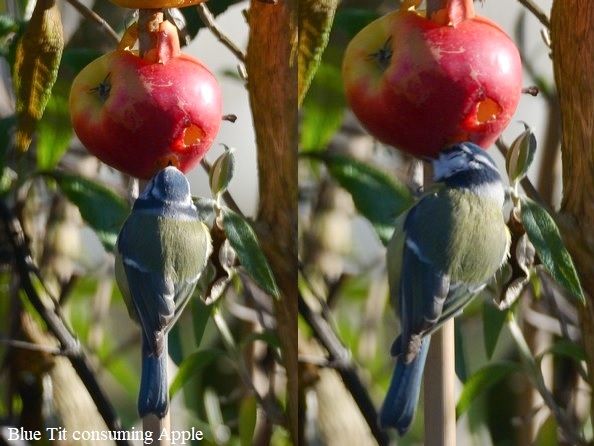
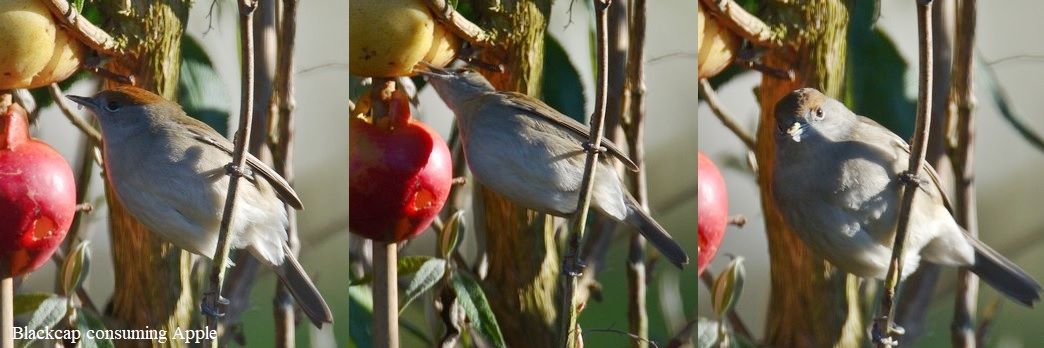
Foraging in the vegetation again......
2 Great Tits were searching for food amongst the vegetation (16th) and 2 Blue Tits were seen outside the lounge window in the Hawthorn and on the Fennel respectively.
Also here today were: Dunnock, 2 Wood Pigeon, 2 Blackbird, 2 Collared Dove, 7 House Sparrow, 4 Starling and a Robin.
Blue Tit feeding on Apple?!
Looking out of the kitchen window (15th) I saw a bird picking at one of the Apples put out yesterday on a Bamboo skewer, but it wasn’t a Blackcap, but a Blue Tit!
I can’t remember ever seeing a Blue Tit feeding on fruit before, but maybe others have!
Fruit gets skewered in anticipation of further Blackcap visits......
I skewered 2 Apples and a Pear on a Bamboo cane and pushed it into the garden (14th) in order to try and provide food for the Blackcap, but it wasn’t seen, at least not definitely.
However, 2 Blue Tit, 2 Starling, 6 House Sparrow, 4 Blackbird, Dunnock, Robin, 2 Wood Pigeon and a Collared Dove were seen.
New bird for garden!
It may have been Friday the 13th today, but it wasn’t unlucky when it came to visitors to the garden!
A female/immature Blackcap (right) was seen in the garden, raising its status from heard from the garden to actually being in the garden, after possibly seeing one briefly on the fatballs a few days ago.
Along with a first for the garden other species seen were: 4 Blackbird, Dunnock, Robin, 7 Starling, at least 14 House Sparrow, Collared Dove and Blue Tit. A Sparrowhawk was seen fleetingly as it flew out from where it was perched and flew low over the grass outside the garden.
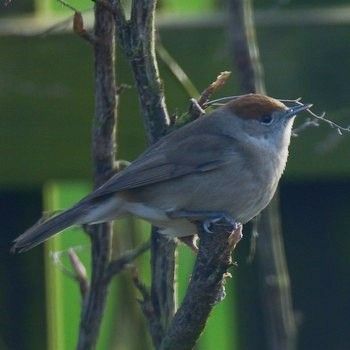
Natural foraging habitat for birds......
A Great Tit and a Wren were both looking for food in the vegetation (11th) and not taking advantage of the supplementary food put out. This amongst other reasons tells me the garden is working for wildlife. Whilst I am sure most people are tired of being told not to be too tidy in the garden it obviously works in giving insects a place to hide and in turn providing food for other animals further up the food chain.
Also present today were: Robin, Dunnock, 7 Starling, 3 Blackbird, 3 Collared Dove (one chasing a rival away), Wood Pigeon and 12+ House Sparrow.
Doves and Sparrows in the rain benefit from Starlings!
At least 11 House Sparrows were present (10th) mainly feeing alongside 2 Collared Doves in the rain picking up the dropped seed from the seed hopper.
Also seen were: 3 Blackbird, 2 Starling and a Robin.
A Wren was once again in the garden (9th), always great to see. Also in the garden were: 2 Blue Tit, 12 Starling (descending on the seed hopper and shaking the contents onto the floor, but the fallen seed was picked up, particularly by the Pigeons and Doves), 2 Blackbird, Dunnock, at least 10 House Sparrow, 2 Wood Pigeon, Great Tit and 2 Collared Dove. In all 10 species of birds a good show for my garden!
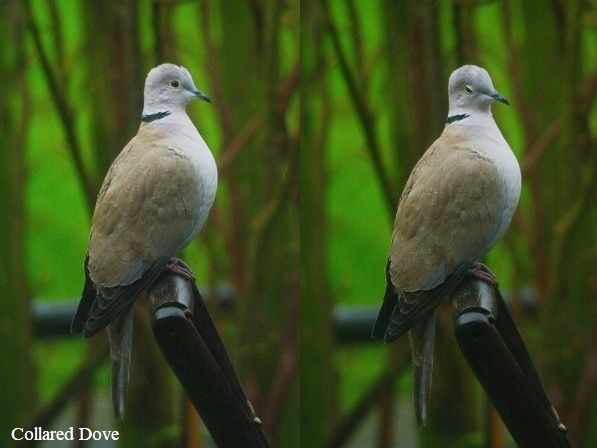
Diary Notes: 5th-8th......
6 of both Starlings and House Sparrows were present (8th), along with 2 Dunnock, 2 Blue Tit, 3 Blackbird, Wood Pigeon, Robin and 3 Collared Dove.
2 Collared Doves spent most of the afternoon (7th) sheltering from strong winds in the garden and also of note were 2 Blue Tits.
3 Collared Doves graced the garden (6th) and also seen were: 2 Blue Tit, 3 Blackbird, 5 House Sparrow, Robin, 2 Dunnock, Wood Pigeon and a Starling.
A Wren was in the garden (5th), along with: 2 Blue Tit, 2 Dunnock, 4 Blackbird, 5 House Sparrow and a Robin.
Underrated Titmice......
Now, most people would say; it is just a Blue Tit or a Great Tit, but not in my garden (3rd); no bird is common and this also reflects the world over!
2 Great and 2 Blue Tits were in and out of the garden today, not only taking advantage of the provisioned food but looking for prey in the vegetation. These are a fantastic family of birds; Titmice Paridae and both these species are members of that family, whereas the Long-tailed tit is not a Paridae/true Titmice species. One of the Great Tits had a bath in the fairly recent new small bird bath; can’t remember seeing this species having a bath in the garden before!
Also present were 4 Blackbirds, Robin (first in to take advantage of the food on the bird table), Dunnock, Wood Pigeon, Starling and 4 House Sparrow.
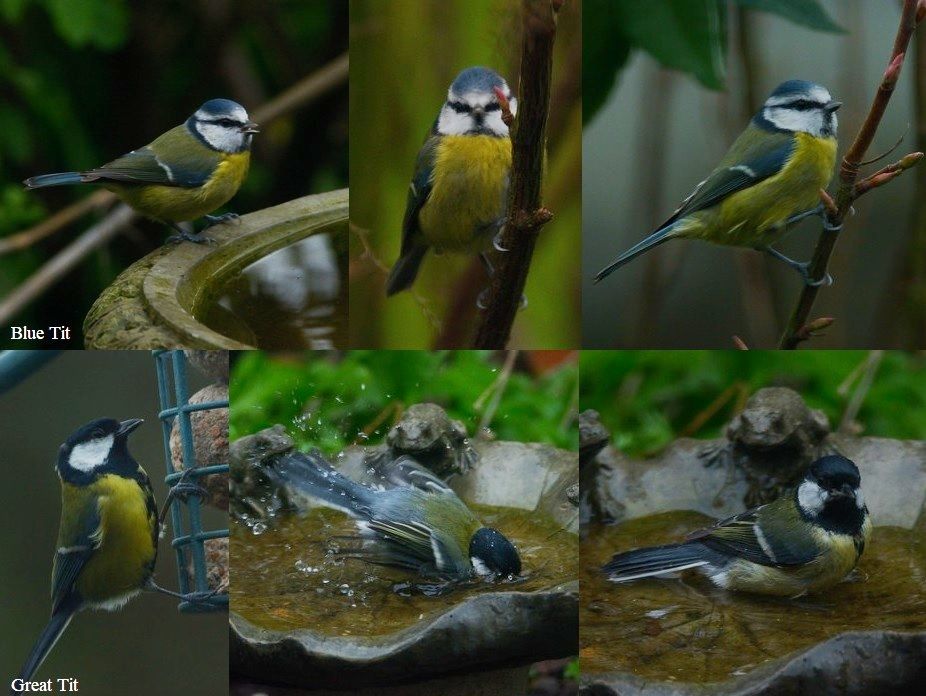
Pink-feet from the garden and Starling in the garden start 2023......
After being out all day on the 1st, the garden diary began (2nd) with the sounds of Pink-footed Geese flying over at 07.44.
The first bird to be seen in the garden was a Starling, which throughout the day the highest total was 6. Other birds in the garden were: 4 House Sparrow, Wood Pigeon, 2 Dunnock (already chasing each other around), 4 Blackbird, 3 Blue Tit and 4 Collared Dove, with another outside the garden.
Wildlife Garden Diary 2022
December 2022
Birds in the last days of 2022......
The last few days of December (28th-31st) saw a variety of birds visiting the garden. With the maximum numbers in brackets, the species were: Blackbird (4), Blue Tit (3), Starling (3), Collared Dove, Wood Pigeon (2), Dunnock, Robin, House Sparrow (7) and a Great Tit on the last day of December.
A brief synopsis of 2022; a Wildlife Gardening Year......
It’s that time of year (29th) when we take stock of the year that has passed and consider what we could improve for the coming year (although Nature does not relate to dates as we do) and my Martham garden is no different.
I think if some people don’t believe in Climate Change (the same people that still believe in father Xmas, the fairies at the bottom of their garden or some overseeing deity) and the consequences of that to the world we live in (and us too!), this year (if still in doubt) with its very dry, drought conditions should underline the fact; there is no time to waste and each and every one of us must act, even if it is in our own ‘little plot’ where Nature can flourish, if we allow it too.
So what can we do? Well, Monty Don of Gardener’s World hits the nail on the head when he says this kind of weather is not going to go away (anytime soon, if ever!) and we need to adapt to these changes in our gardens, which I completely agree with him about.
Even our own native plants are going to have trouble adapting to these temperature changes, although adapt they will or go extinct! Telling people just to grow native plants in their garden, is just not going to happen, but we must grow the plants that are best adapted to our soils and conditions, native or not and this is the key!
We must have plants that attract our native animal species, especially our pollinators; insects of all kinds; Bees (particular native bees, far superior to pollinating than the introduced Honey Bee), Butterflies, Moths etc, etc because they are the next line in the food chain for our more ‘attractive species’ in this case mainly birds, but also a variety of mammals depending on where you live, access to your garden and the size of your plot. Where these apex predators are absent (which are sometimes called indicator species) we have problems, not only for that ecosystem but for us too. Yes us too!
Predators are regulated in the ‘real world’ (not the namby pamby world most of us humans live in) by prey species; in itself over simplified, as it is far more complicated than that! Us Homo sapiens have just taken from our world and with no longer any Natural Selection have thrived above all else; but that in essence is our downfall, as conditions and more knowledge are showing.
I would like to use some emphatic swear words here, because this ignorance of what we are doing to the very resources we need to survive drives me nuts! However, this is a site for all ages and experience so I will just have to whisper it to my Rabbit Brambles!
So, the increase growth of the shrubs in the garden, I would say was very possibly the reason for attracting two new species of birds in the garden with a Lesser Whitethroat and a Garden Warbler and in turn has increased the food source to both birds and insects.
There has had to be some changes made in cutting back vegetation (due to succession) to bring in more light to what is a very small garden and in order to increase biodiversity, but at the same time, just under a hundred bulbs have been planted, mostly Alliums which work well for pollinating insects and I already have the seed for annual flowers both wild and cultured to try and increase the attractiveness to various insects to the garden.
It has not been a great year for Butterflies and whilst there was still a small diversity of species the numbers were low. However, it was a great year for Hummingbird Hawkmoths with multiple sightings, ranging all through the summer until 29th September. Another new moth was the larvae of a Ruby Tiger Moth on the 3rd October, whilst sat out in the garden Hedgehog-watching.
Hedgehogs were seen throughout most of the year and there was some fantastic close encounters, whilst sat outside, with 3 Hedgehogs feeding together 27th July close to my feet. What a shame others continue to slap paint on them to mark them!
Native species of Bees were once again present and on the 11th July, I had my first sighting of a Patchwork Leafcutter Bee cutting pieces from Rose leaves. Amongst the new species of Bees in the garden was a Common Mourning Bee on the 8th June, firstly on Red Valerian and then on a Geum flower where it was photographed; awesome!
A new species of Beetle was recorded, initially outside the garden, on the 26th June; a declining species, the Summer Chafer of which there were 10+ flying around the large tree outside the garden, but also a few around the garden Buddleias.
A surprise was found in the kitchen sink on the 21st July when a Steatoda noblis False Widow Spider emerged and was subsequently photographed; the first definite record of this spider.
A new species not only in the garden but for me also and not seen as yet by the county recorder was a Cheilosia caerulescens Hoverfly, Houseleek Cheilosia 28th August; two of which were visiting the Oregano flowers.
Along with the aforementioned Sylvia Warblers a Redwing was a surprise new bird in the garden (7th Jan) and a flyover Ring-necked Parakeet (30th April) was seen, alerted by its call.
In October (after a national influx) the unseasonal sight of a Swift was in fact a Pallid Swift flew over followed by another sighting later of the same or another bird. Finally, after the first ‘cold snap’ a Coal Tit (new titmouse for the garden) was seen coming to the new seed hopper (11th Dec). This coincided with the first Long-tailed Tits being seen.
I wish you a wildlife-filled New Year in your gardens, Perry.
Avian visits today......
Birds visiting the garden today (24th) were: 3 Blackbird, Blue Tit, Dunnock, 5 House Sparrow, Collared Dove, Wood Pigeon, 3 Starling and a Robin.
Assortment in the garden and Whoopers go on the recorded from the garden list......
A Wren was good to see once again in the garden (during a slight rise in temperature) (18th) and also present were: 2 Blue Tit, 11+ Starling, 4 Blackbird, 3 House Sparrow, 2 Collared Dove and a Dunnock.
At approximately 13.30, whilst in the kitchen, I could clearly hear ‘wild swans’ going over. In this instance the calls of Whooper Swans. I went outside both sides of the dwelling but couldn’t see them, however, a new bird recorded from the garden.
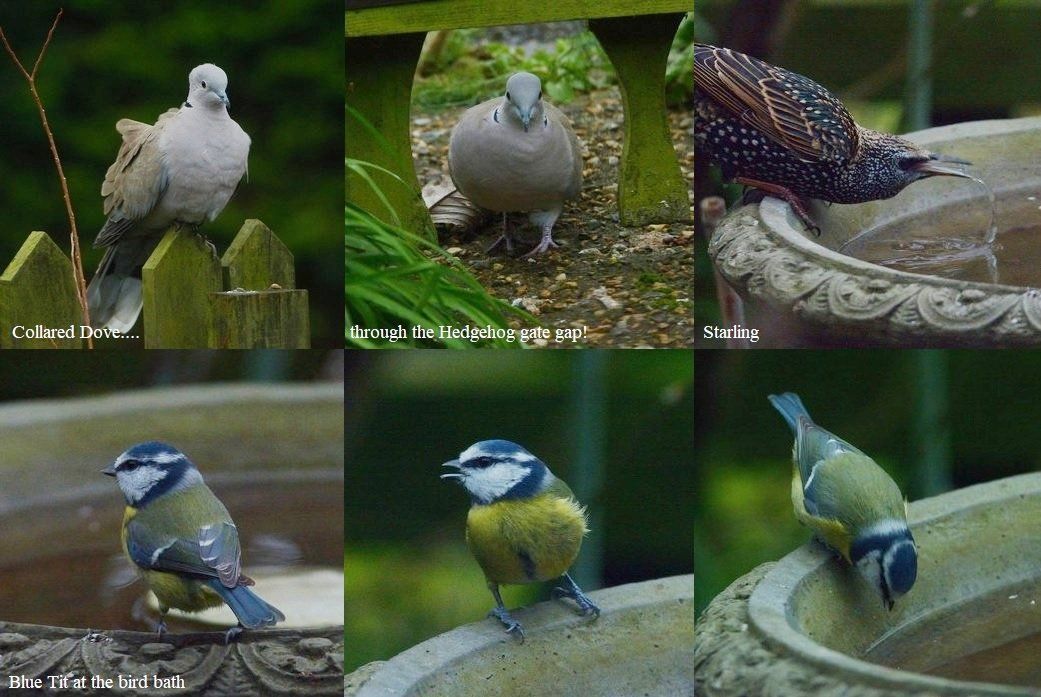
Cold weather increases territoriality in the garden......
A Magpie ‘sneaked’ in to grab some food from the bird table (12th), whilst other visitors were: Robin, 2 Blackbird, Dunnock, 3 House Sparrow, 3 Blue Tit, 3 Wood Pigeon and 2 Starling.
The cold weather has raised territoriality in the garden with a male Blackbird chasing off anything his own size and smaller, a Robin doing similar and increased defence of the bird table by a Wood Pigeon/s.
A drop in Temperature and birds need help; with rewards for you and I......
The temperature overnight (11th) reached -7.40 C in Martham, the lowest in the region since 2012, according to Dan Holley BBC Weather, so food (and indeed accessible water) put out was certainly a welcome addition to any other natural food available for the wildlife in the area.
Not only did the extra food help the wildlife today, it had a new visitor never seen before in all of the time I have lived here since February 2018.
4 Blackbirds in total were coming for the fruit put down for them as well as taking mealworms etc off the bird table. At least 6 Starlings, Robin and 6 House Sparrows also visited, as did a female/immature and then a male Greenfinch; actually in the garden, which does not happen very often.
2 Collared Dove, a Wood Pigeon and Dunnock followed before the arrival of the Titmice flock!
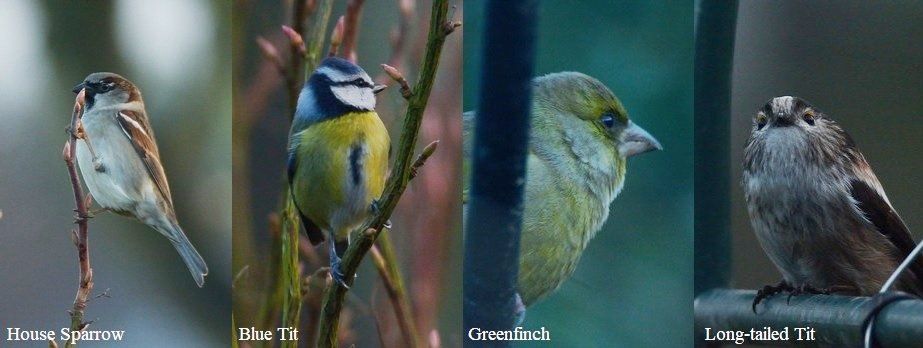
4 Blue Tits were in the garden, coming to the fat balls and seed hopper, but it was at that point I saw a Titmouse I never thought I would get in the garden, a Coal Tit! One of maybe two of these very welcome birds were present; like assassins coming in picking up a seed from the hopper and flying off again, which made getting a record image of this new species for the garden (and seen from garden) very difficult, but achieved. At least 4 Long-tailed Tits also came for the fat balls, but their exact number is a little bit hazy due to concentrating on the Coal Tit/s.
A very rewarding day in the garden; just shows when you help Nature you also get extra rewards!


First Long-tails of the year!
With the first ‘real frosts’ occurring on the 8th, there was a very hard frost this morning (10th) with temperatures well below freezing, which may account for the first appearance of the year of Long-tailed Tits.
Five of these beautiful birds visited the fat balls, whilst at least 10 were outside the garden searching for insects, mainly in the large tree at the rear of the garden. 3 Blue Tits appeared to be part of the Titmice flock passing through also.
A minimum of 14 Starlings gave the supplementary food a ‘hammering’ and also present were: Dunnock, Robin, Wood Pigeon, 3 House Sparrow and 2 Blackbird.
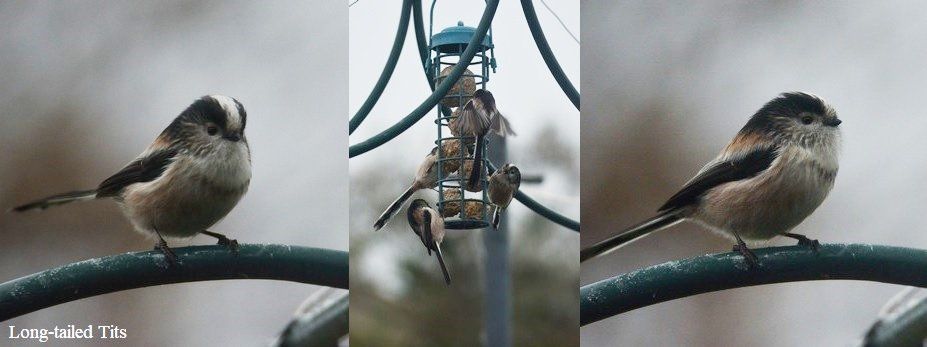
Pears and Apples a hit!
4 Blackbirds came for the Pears and Apples put out for them (8th) and also present were: 2 Collared Dove, Wood Pigeon, Robin, Dunnock, and 5+ House Sparrow.
Late feed......
A look out of the kitchen window at 15.00 (4th) saw 2 Blue Tit, 2 Dunnock, Blackbird and a Robin coming for a feed before darkness descended.
'Common' birds are stunning birds!
December in the garden began on the 2nd as I was out ‘in the field’ on the 1st.
Although, much the same birds were seen, as at the end of November it is still very pleasing to have what are determined as ‘common’ species coming into the garden, as nothing wildlife-wise is really common anymore!
So, December kicked off with: 2 Blue Tit, 2 Blackbird, Wood Pigeon, 4 House Sparrow, Robin, Dunnock, 6 Starling and 2 Collared Dove.
November 2022
Diary Notes 27th-30th......
The last 4 days of November (27th-30th) saw a nice selection of avian visitors to the garden.
Species as follows (with highest counts in brackets, singles if not otherwise stated): Wood Pigeon, Collared Dove (2), House Sparrow (12+), Robin, Dunnock, Blackbird, Starling (8), Blue Tit (2) and Great Tit (1-2).
Pinks, maybe with Beans?
Pink-footed Geese were heard somewhere to the S.E. at approximately 07.15 (25th), maybe including the 3 Tundra Bean Geese reported with Pinks recently at nearby Rollesby.
Blue Tit, Robin, Dunnock, Wood Pigeon, 5 House Sparrow, Blackbird and 2 Starling were all in the garden.
The little bird returns......
A Wren was again a welcome garden visitor (21st). 2 Blue Tit, 2 Dunnock, Robin (still seeing the Dunnocks off!), 6 House Sparrow, 2 Starling, male and female Blackbird and Wood Pigeon were also seen.
'Garden Birds'; always a delight to see......
Blue Tit, Dunnock, 4 House Sparrow, 6 Starling, male and female Blackbird and a Collared Dove were visitors today (20th).
Robin still not wanting Dunnock on its patch!
A nice selection of birds in the garden (18th) with the Robin still persisting in chasing a Dunnock out of the garden and 2 Blue and a Great Tit were nice to see.
Also seen were: Wood Pigeon, Collared Dove, at least 5 Starling and a male Blackbird.
A trio of Blackbirds......
3 Blackbirds were in the garden first thing (14th) and Blue Tit, Robin, Starling and a Dunnock were also seen, but nothing more of Ratus norvegicus!
Hog food robbed by Rattus!
At least 15 Starlings descended on the food provided (13th) and also present were: House Sparrow, 2 Collared Dove, Wood Pigeon, 3 Blue Tit, Robin and a Blackbird.
A movement on the path during the evening, had me hoping for a Hedgehog, which has not been seen for some time, but within a fraction of a second came the realisation it was a Brown Rat helping itself to the Hedgehog food before ascending onto the bird table! Hopefully this is a one-off!
Pink fly-over in a pink sky......
Birds in the garden today (11th) were: 2 Wood Pigeon, 3 Collared Dove, Robin, Blackbird, Dunnock, 8 House Sparrow, at least 10 Starling and 2 Blue Tit.
Between 16.05 and 16.20 at least 1300 Pink-footed Geese flew over northwards.
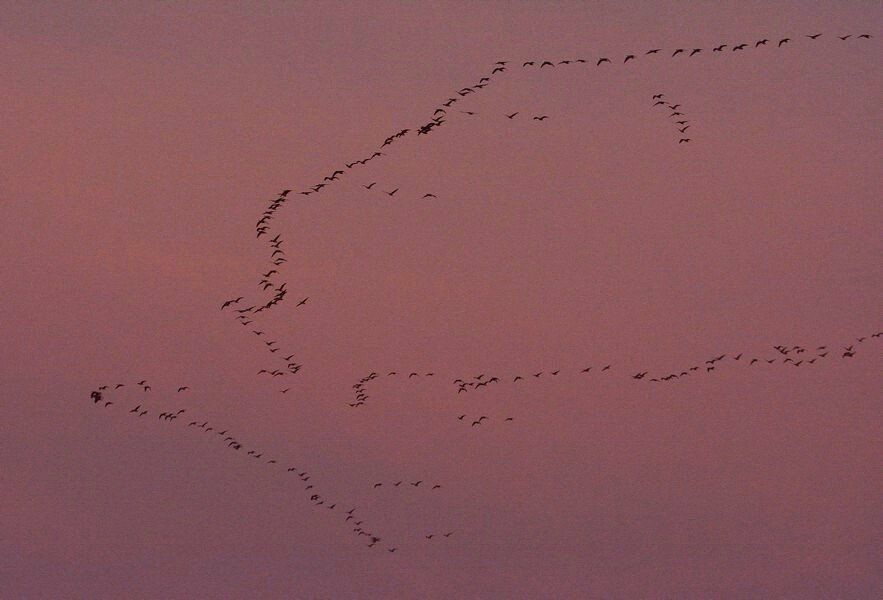
Starling Invasion......
A minimum of 20 Starlings descended on the garden (9th) to plunder the food on offer and one even had a Rose hip.
A male Blackbird was on the bird table and there were visits here by 2 House Sparrow, Collared Dove and a Robin.
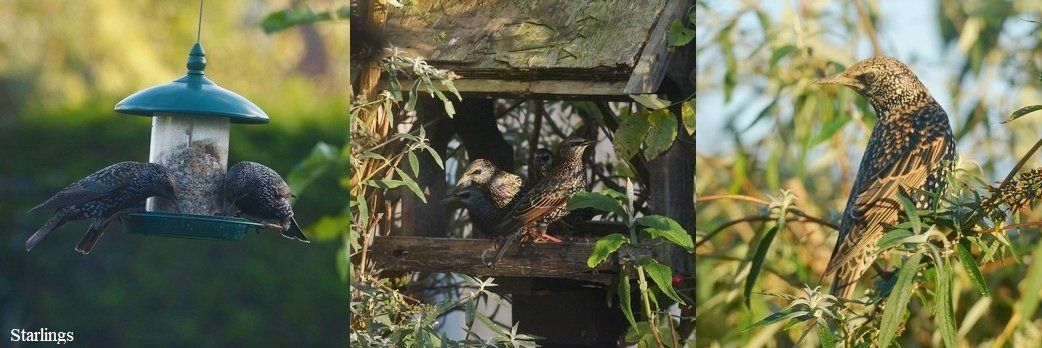
House Sparrow café!
A flurry of activity, just before 15.00 (8th) saw 10+ House Sparrows coming in to feed and bathe; wonderful to see the garden alive with these charismatic little birds, once ‘common’ but not no more!
Collared Dove, Wood Pigeon, Starling, Robin and a Dunnock were also seen.
Fireworks; what are they good for, absolutely nothing!
The first week (1st-7th) saw a variety of birds in the garden. These included Blue Tit, Dunnock, Robin, House Sparrow, Collared Dove, Wood Pigeon and Blackbird, although the fireworks around this time of year didn’t help!
Why is it people still ‘celebrate’ a completely meaningless event now, spend extortionate amounts on devices that produce sparkly lights and loud bangs for fleeting moments in time (when most people are struggling for money; obviously not those buying fireworks!).
Put these reasons together with our declining populations of wildlife and climate-change and all the evidence is there for the ‘powers that be’ to ban fireworks for good. No doubt there would be protests over ‘freedom of rights’; well there is no right in aiding the destruction of our climate for selfish motives!
Early mornings saw Pink-footed Geese flying over S.E. and during the night. The sounds of very disturbed Pink-feet could also be heard during firework ‘celebrations’!
October 2022
New feeder, a worthwhile investment......
The introduction of a new seed hopper/feeder placed on one of the arches was a good move (30th) with a Goldfinch (one of three) attempting to land on it but put off by the squabbling Starlings (10).
4 individual Blackbirds were present (2 males, female and 1st W), along with Wood Pigeon, Collared Dove, a Robin chasing a Dunnock (again) and 4 House Sparrow with more outside the garden.
A veritable flock of Titmice!
3 Blue Tits and 2 Great Tits (29th) (a veritable flock in this area!) were, amongst other things, picking up short pieces of decaying vegetation and investigating inside them for food (see below-not the best of images through glass and dull light!). This is testament that so-called ‘untidy gardening’ benefits wildlife at all trophic levels.
Robin, Wren, 5+ House Sparrow, Wood Pigeon and 7+ Starling were also garden visitors.
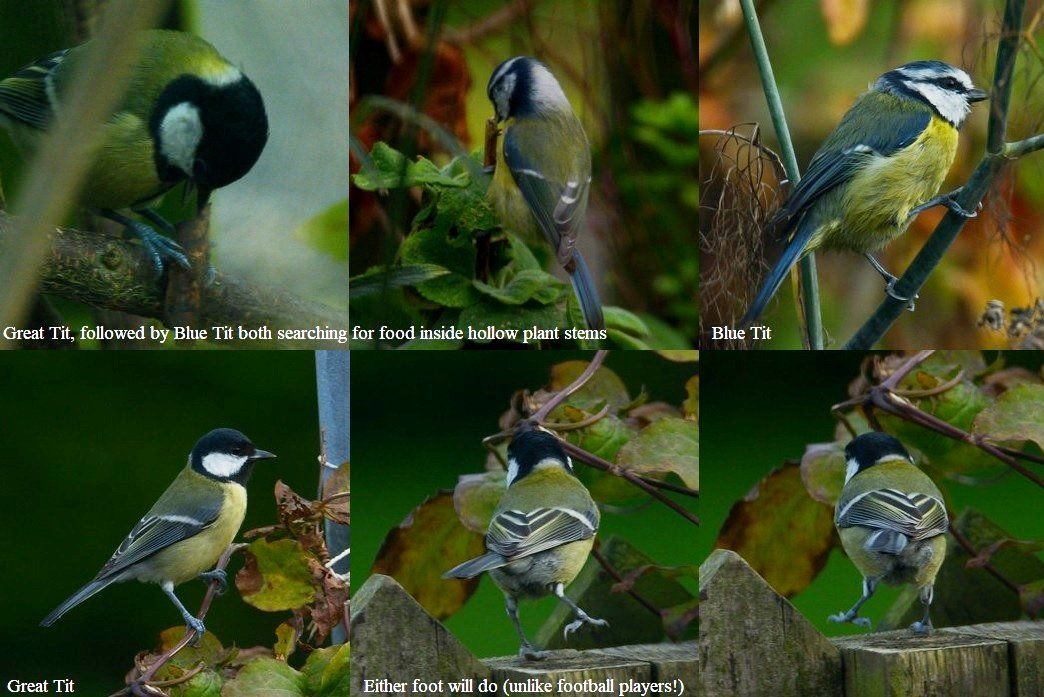
Bath-time......
2 Blue Tits were present (28th) along with a Wren having a bath on two occasions in the late afternoon.
An eventful day in and outside the garden!
A Robin was chasing away a Dunnock in the garden hedge (27th) and Blackbird (feeding on recently put out Pears), Wood Pigeon, 4 House Sparrow and 11+ Starling were also seen.
In the afternoon with the sun on the bird table roof a Wren was sunning and I even managed to get some photos of it without having to shoot through the glass of the kitchen window. Whilst some might overlook this little ‘brown’ bird, I certainly do not; its plumage is stunning!
A Carder Bumblebee and several Honey Bees were in the garden, whilst what looked like a Migrant Hawker flew past outside the garden.


At approximately 16.45, whilst sat outside in the back garden I saw a Swift species flying in from the south, heading north. Now, I have never seen a Common Swift Apus apus this late in the year before, in fact I have never seen one outside of September so with several Pallid Swifts Apus pallidus reported recently in Norfolk and the near continent this was very much of interest.
Luckily, I had brought the camera and 600mm lens out with me to capture anything of interest for the Garden Diary, but I wasn’t expecting a swift! I tried to get images of the swift as it flew over but just managed to get a few at distance in the fading light, as it headed towards Martham Church, where I lost sight of it.

However, at 19.05 I saw another or the same coming in, again from the south. I must admit, I failed miserably to get any further photographs before it disappeared into the distance eastwards. What I did notice was some very shallow, quite slow wing beats and it appeared to be feeding. Also see: John Cantelo’s description of Pallid v Common Swift, where he says; that Pallid’s flight is less acrobatic, with slightly slower wing-beats, more frequent gliding and much less twinkling turns:
Later I found a winged-Ant species on my arm, maybe this was what the Starlings were feeding on recently? However, at present I can find no further information about ‘flying’ Ants at this time of year as this usually happens in the UK in July and August; another effect of Climate-change?!
I have seen Pallid Swift on many occasions in the Mediterranean and once in Suffolk but this is a rare species in the UK, so some research was carried out with what I had observed and the few silhouetted images I had managed to take. However, I can bet this kind of scrutiny is not carried out for Swifts seen in the Med’ where Pallid are known to be and any light coloured Swift is ‘ticked-off’ as a Pallid!
One of the links I found was an old article (28-10-2006) by Martin Garner: Focus On: ‘Common and Pallid Swifts’. This article and the following comments by Garner and others clearly show that there are a lot of subtle differences between Common and Pallid Swifts but most of which are difficult to see in the field, except on a ‘good day’! Then put a sub-species of Common Swift into the mix Apus apus pekinensis and you have a further identification headache, depending on where you are in the world!
Martin Garner suggests: ‘Perhaps the best way to claim the vagrant Pallid Swift might be to see it badly, and briefly, and not to get any good photographs!’
Also of interest in this article; in the comments that follow is from a Michael P on the breeding ecology comparison of both Common and Pallid Swifts, which points to the breeding strategy of Pallid supporting the more likely occurrence of this species at this time of the year in the UK as opposed to Common Swift, which has largely (always an exception to the rule!) ‘Done and dusted’ it’s breeding and has long gone back to Africa! Another article (in this case a scientific paper) of interest is about the Breeding biology of Pallid Swifts in Italy.
I dare say other people have got far better images than I managed, but from what I have seen thus far, I wonder if they would survive the scrutiny of the BBRC (British Birds Rarity Committee)?
The Swift/s I saw certainly fitted the overall criteria of the bird/s being Pallid as opposed to Common Swift/s, but I didn’t see all of the plumage features. However, on what I observed, what I have experience with and the laws of scientific probability Pallid is the conclusion, but everyone will have their own take on what is an identity conundrum, especially outside of this species' breeding areas!
Later, Pink-footed Geese were heard as they flew over in a mainly northerly direction around 18.00-18.20. Three skeins passed over and the first skein was visible and contained approximately 100 birds. A very interesting day, in the garden!
Fatballs a hit with the Starlings......
A few birds in the garden today (26th) with; a Dunnock, 3 Starling initially followed by 9 later (mainly on the fatballs), Collared Dove, Wood Pigeon and several House Sparrow.

Activity in the sky but relatively little in the garden......
The last few days have seen very little bird life in the garden, partially due to the presence of a cat (same one as before) on a couple of occasions. However, today (25th) there was a little more life.
A Blue Tit was consuming fat balls on the recently placed fat ball basket on one of the garden arches and a male Blackbird was curiously moving along the rim of the bird bath and then bobbing in and out of the water!
A Robin was not best pleased with the presence of a Dunnock and was seen on several occasions chasing the Dunnock off. 7 House Sparrows and a Wood Pigeon were also present as were 2 Common Wasps and a Carder Bumblebee.
There was more activity outside the garden with 2 Common Buzzards soaring in the afternoon. 4 Goldfinch, 2 Greenfinch and a Pied Wagtail (heard) were also recorded outside the garden, as was a passing Common Darter.
Starlings were ‘fly-catching’ with more passing over, at least 100 Black-headed Gulls flew east and Pink-footed Geese could be heard in the distance.
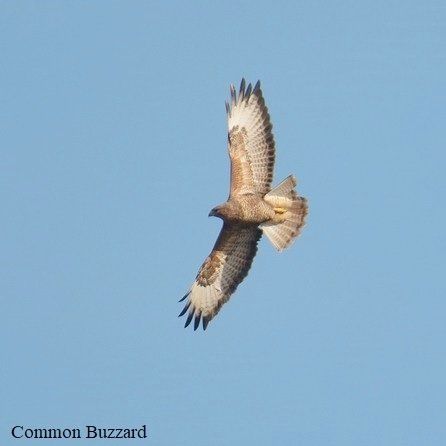
Birds return to the garden!
2 Wood Pigeon, 2 Blackbird, 8+ House Sparrow, Starling, Robin, Dunnock and a Wren visited the garden (16th), but once again a cat (same one) had to be ushered out of the garden.
Pink-footed Geese were once again heard flying over in the evening.
Why is no laws to stop the unlimited breeding of predatory 'pets'?
A Sparrowhawk in hunting mode (15th) disturbed a Wood Pigeon and then House Sparrows, just outside the garden.
A Buff-tailed Bumble Bee was seen but no birds due to a cat being present twice during the day and then again coming for the food put out for the Hedgehogs.
I think the laws about cats being allowed to go where they want and the irresponsibility of their owners are absolutely despicable! The impact they have on a declining population of wildlife is enough on its own, but when you consider the support for this introduced tertiary predator, with advertisements wanting you to leave cats something in your will or to help protect cats is beyond any reasonable thinking person’s comprehension. The unlimited breeding of cats, dogs and other so called ‘pets’ in this country needs to be addressed and laws brought in to stop this increasing population of non-native predatory animals. Why is this; the foundation of the problem not being addressed?
Sitting outside (mainly to protect our native animals food source), there were visits by Hedgehog/s at 20.36, 20.42 and two more visits up until 21.00 with a further visit at 23.47.
Pink-footed Geese were heard going over, mainly in a northerly direction from 21.41 until at least 21.09.
Hog visit......
A Hedgehog visited the garden (14th) at 22.30.
Avian assortment......
An assortment of birds visited the garden (11th): Dunnock, Blue Tit, Robin, 8+ House Sparrow, Wood Pigeon, 2 Collared Dove, 10+ Starling (with more outside the garden), 3 Blackbird (male, female and 1st W) and a Redwing was seen briefly when it banked near the end of the Hawthorns but then promptly disappeared.
A single of both Carder and Buff-tailed Bumblebees were in the garden and 2 Common Buzzards soared over and 2 Greenfinch, 2 Goldfinch and an unidentified charm of 20+ Finches were outside the garden.
Slugs; love them or hate them a necessary ecosystem detritivore......
Pink-footed Geese were heard flying over in the evening (10th) and a Hedgehog (the grey spined individual) came for food at 21.08.
As usual several Slugs were present feeding on the cat biscuits, but the only one with any definite identification was a Black Slug- Red form Arion ater agg.
Slugs are not that easy to identify (as I have found out!) and yet again identification in a lot of cases is through dissection, which is definitely not happening here! Whilst Slugs are not my favourite animal they still have an important role in ecosystems as detritivores and are therefore as welcome in the garden as any other species.
Five years ago (during the evening of 14th Aug, 2017), whilst living in Burgh Castle I witnessed an event, which I had only seen on TV before and will probably never see again-a pair of presumably Leopard Slugs (again variable in colour and markings) mating (see below), absolutely fascinating! See David Attenborough’s account of this event:
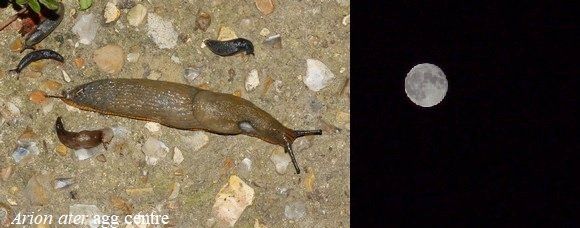
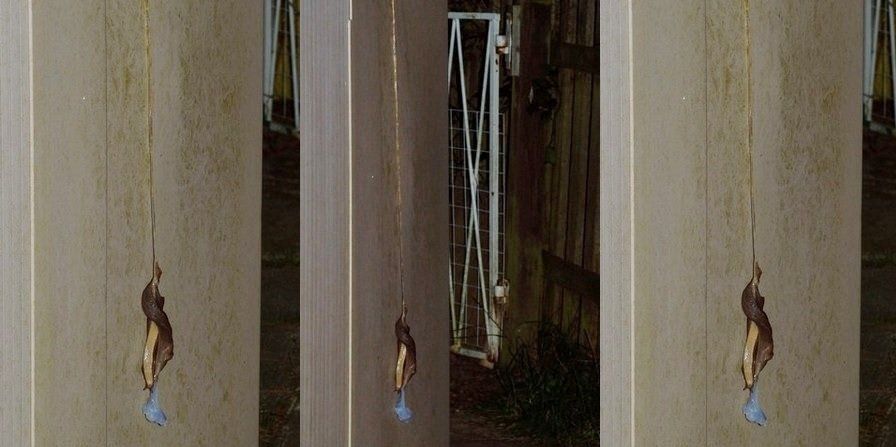
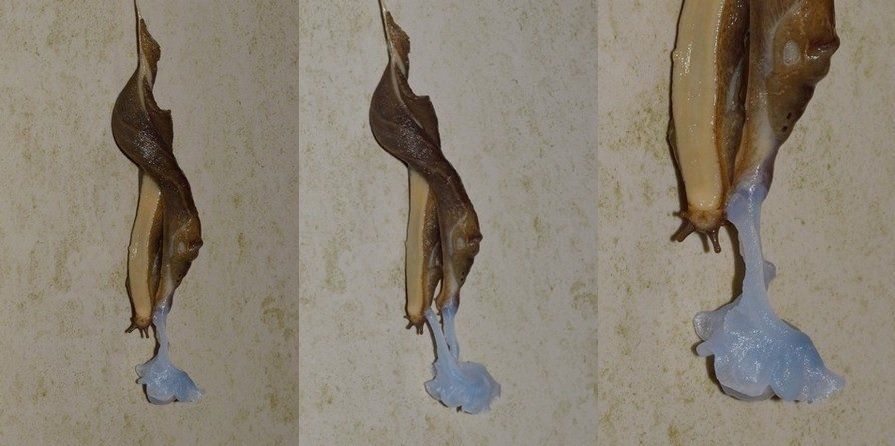
1st Winter arrivals and a new species from the garden (distantly!)......
2 Blackbirds were new arrivals in the garden (9th) with another of these 1st winter birds outside the garden.
A Blue Tit was picking up the peanuts left from feeding the Hedgehogs and Dunnock. Wood Pigeon and 6+ House Sparrow were also seen and a Butterfly probably a Red Admiral was seen briefly when it flew up and away from the garden.
In the evening 2 Chinese Water Deer could be heard distantly somewhere to the south as was a Tawny Owl.
Bumbles still present......
A Wren was present again (8th) along with Robin, Dunnock, 10+ House Sparrow, Collared Dove and Wood Pigeon and both Carder and Buff-tailed Bumblebees were also seen.
Garden birds and pinks......
Robin, Dunnock, Collared Dove, 2 Wood Pigeon and 8+ House Sparrow were all in the garden (7th) and 61 Pink-footed Geese flew over south, whilst 26 went north.
A caterpillar in the dark......
2 Wrens were once again present (3rd) with one very vocal and finding food amidst the Sweet Peas. A Blackbird, Wood Pigeon and 10+ House Sparrows were also of note.
A Hedgehog appeared at 22.58 and there was also 5 ‘grey’ slugs coming for the cat biscuits.
Whilst sat outside (in the dark, like you do, or I do!) a ‘brown caterpillar was seen crossing the path, emerging from the border mainly containing Red Valerian; the ‘migration’ under the cover of darkness is probably to avoid predation. The caterpillar was photographed and was identified (by Ken Saul) as a Ruby Tiger Phragmatobia fuliginosa, a very attractive moth as an adult (not bad as a larvae) and a new species for the garden.

Large White, Hedgehogs and Slugs!
At 01.06 a Hedgehog was feeding in the garden (2nd) and during the day 2 Wren, Robin, Dunnock, House Sparrows, and a Blackbird were seen.
A Large White was once again in the garden, as were both Carder and Buff-tailed Bumblebees.
Both Pink-footed and Grey-lag Geese were heard flying over in the evening and at 21.24 a ‘large’ Hedgehog came for food.
A Large White (right) was still in the garden at the beginning of the month (1st) and at least 10 House Sparrows and a Wood Pigeon were also noted.
A Hedgehog with noticeable grey spines at the front of the body appeared at 21.04, when there were also 2 'orange' Slugs also feeding on the cat biscuits. Another Hedgehog appeared at 23.00 and another or the same seen just before midnight.
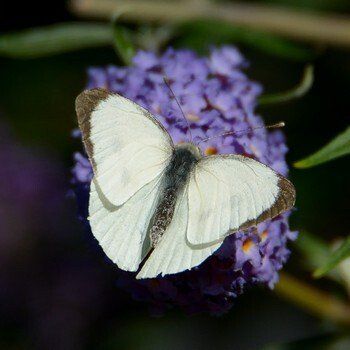
September 2022
Pink-feet and a surprise Hummingbird hawk......
Several small skeins of Pink-footed Geese were either heard or seen (29th) and Collared Dove, Robin, House Sparrows, Wood Pigeon, Blue Tit and Wren were in the garden.
A Hummingbird Hawkmoth was somewhat of a surprise at 18.12, when it visited the Buddleia and Verbena.
Garden Diary Notes; 23rd-25th......
A Hedgehog was seen at 22.35 (25th).
Birds present (23rd) were: Wren, Collared Dove, 10+ House Sparrow, Dunnock, Robin and Wood Pigeon.
Garden Diary Notes; 11th-22nd......
A Wren was once again in the garden (22nd), along with Great Tit, Blackbird and several House Sparrows.
Wren, Robin, 2 Blackbird, Wood Pigeon, Collared Dove and several House Sparrow were in the garden (19th) and the first Pink-footed Geese (12) of the autumn flew SW.
A Hedgehog was seen as it emerged from the Red Valerian at 02.00 but took one look at the food put out for it and immediately ran out of the gate!
A Hobby flew over NW (14th) between 18.15 and 18.30 and a small Bat was over the garden at 19.38.
3 Large White and a Small White were present (13th) and 2 Great Tit, Wren, Robin, Dunnock, Magpie, Wood Pigeon and 20+ House Sparrow were also seen.
A small Bat was seen (12th) at 19.38.
Red Admiral, Large White and a Wren were garden visitors (11th) and two small Bats were seen at 19.45.
Wildlife Gardening; an inspirational programme from Gardener's World......
In a world that is forever changing (largely negatively); for those trying to protect and enhance biodiversity and affect climate crisis even in a small way it can feel a very lonely and uphill fight, as we look around us and see that nothing is being done to change the very things that are destroying our world.
However, sometimes moments of inspiration happen, when others of our like are highlighted, making us experience a sense of camaraderie and the knowledge that we are not alone in this fight to protect our flora and fauna and the war against climate change, albeit in our own gardens (of various sizes) where we can make a difference.
I am talking about (not for the first time) Friday 9th’s edition of Gardener’s World on BBC2 20.00 where the whole hour was dedicated to ‘wildlife gardens’.
The whole episode was a delight and I watched it again today (11th) at 06.00 on BBC2 when it was repeated, but it is still available on BBC iPlayer and don’t just take my word for it watch it either as a confirmation of what you are doing is right, for ideas and explanations you may not of considered or for those who are not yet supporting our planet’s biodiversity, reducing climate impact as they could do with a bit of guidance and inspiration from the people featured in this programme.
There are so many good points about the content of this Gardener’s World episode, that I cannot cover briefly, but the ideology of living alongside ‘all creatures’ great and small’ and preserving the ecosystems and the food webs they encompass is the main stay of the programme. Indeed, the majority of the flora and fauna we find in our gardens were once species of woodland edge, which our gardens now stand in for. I can also testify that being with nature and getting to know all the other organisms we live alongside and need for our own existence is very special indeed and has been a constant crutch for the mental health issues I face each day and I am sure it is for many more like me.
There was one lady on the programme who just had to photograph anything she came across in order to find out what it was. If everyone had this fascination and intrigue, then more would be done to protect our wildlife, because you just wouldn’t want it to disappear and therefore garden with wildlife in mind.
Please watch this programme if you have not seen it and here on the Ecological Experiences website I continue to offer help with gardening for wildlife and the identification of what you see in your own nature reserve. We could do with gardening for wildlife programme on the TV every week!
Leave Hedgehogs alone!
A small-medium Hedgehog appeared at 20.42 for food (7th).
At 21.59 another Hedgehog appeared which had been marked with two angled white stripes on its back.
I thought this marking of Hedgehogs had stopped but evidently it has not. The reasons for not marking Hedgehogs has been discussed here before and is also frowned upon by the Hedgehog Preservation Society, so If you know who is continuing to do this in the Martham area LET ME KNOW as I will try to do something about it! Hedgehogs are under enough pressure, without humans interfering for their own rewards: STOP THIS NOW!
The ‘marked’ Hog turned up again at 22.10 and was joined by another medium-sized hog, which had some desires on the marked individual!
Female Furrow Bee on the Oregano......
A female Lasioglossum calceatum Common Furrow Bee was on the Oregano flowers, along with several Honey Bees (6th) and a Large White was also sampling the Verbena flowers.
Later, a ‘small’ Hedgehog was feeding on the food put out even though this was a bit damp, thanks to some welcome rain.
An evening with......
In the early evening (5th), a Hummingbird Hawkmoth flew into the garden and briefly flew around the Buddleia. A minute or so later, it or another returned and was feeding on the Verbena flowers, where it was quickly joined by another at approximately 19.18! Both Hummingbird hawks visited both the Verbena and Red Valerian flowers before one departed and eventually both had gone.
A ‘small’ Bat was seen flying around outside the garden at 19.54; probably a Pipistrelle species, but good to see whatever the case.
At 21.03the first Hedgehog came for food and was happily devouring the cat biscuits and peanuts for at least 10 minutes, before moving off. Later there were two Hedgehogs feeding together, with another one underneath my chair!
Several Moths were seen, mainly on the Oregano, Garlic Chives and Verbena flowers; a very enjoyable two plus hours spent in the garden, in relative peace!
Garden Diary Notes; 1st-4th......
A Wren appeared on the garden picket fence (4th) and other birds in the garden were: 2 Robin, at least 24 House Sparrow, Blue Tit, Dunnock, 2 Wood Pigeon and both a male and sub-adult female Blackbird searching the bark path for food.
A Red Admiral and a Migrant Hawker also visited the garden, a House Martin flew over and a small Hedgehog was seen at 22.35, although there may have been other visits, which is always the case without constant vigil!
A Common Darter was perched on the spade handle (3rd) and 2 Red Admiral, Small and Large Whites were also seen.
Whilst sat in the garden a small Hedgehog came for food at 20.38, just 2 feet away from my feet, such a privilege!
Whilst sat there 2 ‘medium-sized’ Moths appeared and it was interesting to note, which flowers they were attracted too, which were Garlic Chives, Red Valerian, Perennial Wallflower and Oregano. No idea of speciation but interesting nonetheless.
There were further visits from Hedgehogs at 21.18 and again at 23.05.
Small and Large White, Red Admiral and a Migrant Hawker were all garden visitors (2nd) and a Swallow flew over.
A ‘small’ Bat (likely to be a Pipistrelle sp.) was seen at 20.04 and a medium-sized Hedgehog came for food at 21.06.
2 Red Admirals, and both Large and Small White began September (1st) and a ‘small’ Hummingbird Hawkmoth also paid a visit.
Hedgehogs were present with a medium-sized hog at 21.12, 2 medium-sized at 21.48, a small-medium individual at 22.12 and again at 22.23.
August 2022
Butterflies, Birds and Hedgehogs; 29th-31st......
2 Red Admirals were on the Buddleia (31st) and there were also 2 Robins of different ages.
An adult Mediterranean Gull flew over and later there were visits from Hedgehogs: Medium-sized at 21.10, again at 21.48, both a large and a small-medium together at 21 52 and a large (presumably the one seen earlier) having a drink at 22.23.
A Red Admiral and a Large White were seen (30th) and there were two visits by a Hummingbird Hawkmoth; the second one a small individual.
A small Titmice flock were in the garden (29th) with at least 3 Blue Tits and 3 Great Tits, which was nice to see as Titmice in the garden are few and far between!
A Hedgehog was seen at 20.49.
A new 'imported' Hoverfly for the garden......
Both Large and Small Whites continued to visit the garden (28th), but the highlight of the day was a new Hoverfly for the garden and indeed me; a Cheilosia caerulescens aka Houseleek Cheilosia.
There were at least two of these visiting the Oregano flowers (yet another species to visit this ‘garden staple’) and the one featured in all of the photographs was a female.
The indicated fieldmarks of this species from various cross-referenced identification guides were all there including the distinctive projecting face, leg colour and the hairy protrusions, especially behind the eyes and on the abdomen, although the dark wing cloud was difficult to make out on the folded wings, but was there.
A bit of research from various internet sites and books such as Britain’s Hoverflies by Ball and Morris suggested that this was once a rare species in the UK, which was most likely been imported by the horticultural trade from growers in Holland, but the map on Hoverfly UK http://hoverfly.uk/hrs/taxonomy/term/457/map suggests that this species is spreading quite quickly, as predicted from the experiences in the Netherlands, where Cheilosia caerulescens is well established.
The larvae mine the leaves of Houseleeks and two of the internet sites state that it was first recorded in the UK in Surrey 2006 (Collins & Halstead, 2008, Dipterists Digest 15: 23-26).
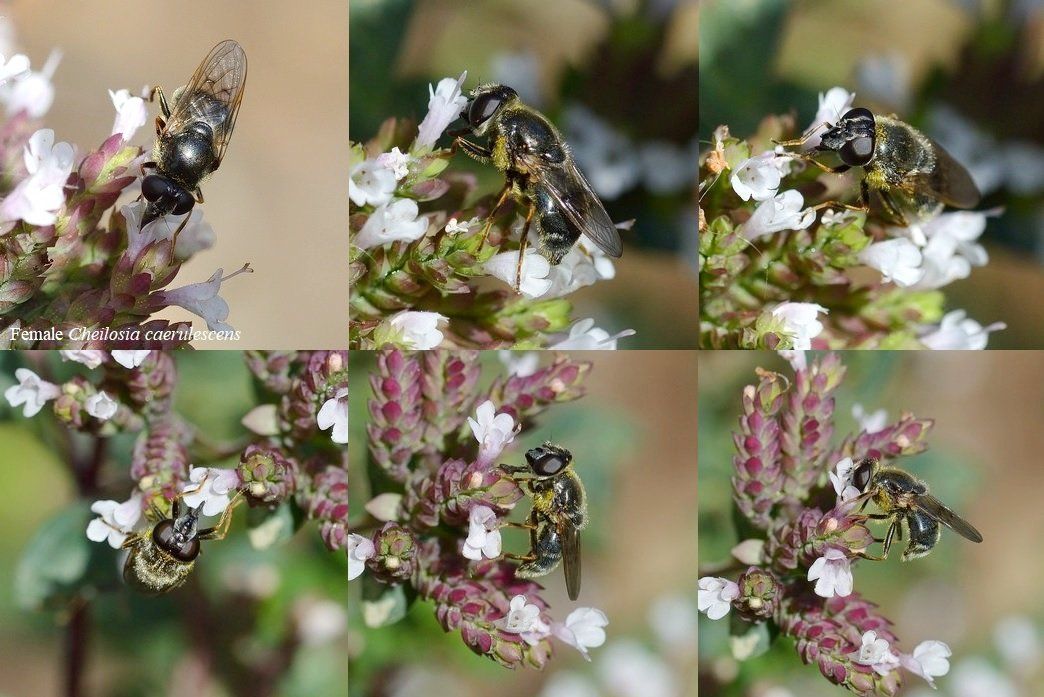
Med' Gull flyover......
A total of 25 adult Mediterranean Gulls flew over heading inland (27th), the most ever seen here and a Hummingbird Hawkmoth was also in the garden.
Darter and hog visits......
A male Ruddy Darter was perched beside the pond (26th) and at least 3 adult Mediterranean Gulls flew over NW.
Hedgehog sightings were a ‘medium’ sized hog at 20.38, 2 largish hogs feeding together at 21.19 and a med-large hog at 21.42.
Hummingbird and Hedgehogs......
A Hummingbird Hawkmoth was briefly in the garden around the Buddleia flowers at 19.50 (25th).
A ‘large’ Hedgehog was feeding at 20.45, followed by a large (the same) and medium feeding together at 20.50. A large hog was seen once again at 21.26.
A Volucella again on the Oregano......
A Volucella inanis was once again on the Oregano flowers (24th). Both Large and Small White (2) were also seen along with a Migrant Hawker and an adult Mediterranean Gull flew over SW.
Hedgehog visits were at a ‘medium’ sized hog at 20.30 and 2 of similar size were feeding together at 20.35.
Hog visits......
Hedgehog visits to the garden (23rd) were at 20.40, 21.07, 22.00, and 22.09 and again at 23.05 when food and water was consumed, possibly by the same individual.
A Silver Y in the kitchen......
Female Brimstone was again visiting the Buddleia flowers (22nd) and both Large and Small White were also present. A Silver Y was found flying around the kitchen before being captured and released outside.
The insect enticing Oregano flowers works again......
At least two male Lasioglossum calceatum Common Furrow Bees (both dark and red-forms) were visiting the Oregano flowers (21st) as were several Honey Bees. The Oregano grown in the garden for many years now is a very valuable plant to have; not just because of its culinary uses but for the flowers, which attract a wide range of insects.
Both Small and Large White were seen and female Brimstone visited the ever decreasing Buddleia flowers. A Hummingbird Hawkmoth was once again in the garden visiting the Red Valerian flowers, which I have managed to keep going by constantly dead-heading.
A Small Purple and Gold micro moth was also seen, but this year there have been nowhere near the sightings of this pretty little moth as there was in 2021.
A juvenile Robin was once again in the garden, as was a juvenile Blackbird and there were at least 10 House Sparrows, some of which were dust-bathing.
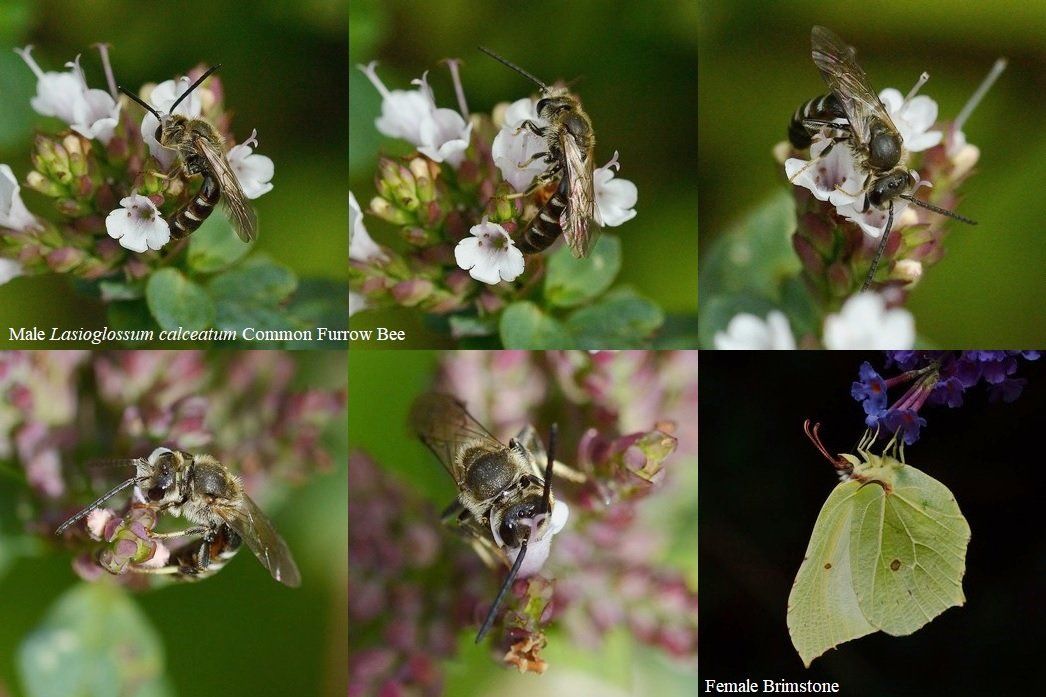
Hogs begin and end the day and and meaningful eyes pass over the garden......
A Hedgehog started off the day (20th) at 03.50.
A late afternoon/early evening watch from the garden chair saw a Migrant Hawker and with House Martins (approx’ 6) up in the sky, I decided to get the camera and a spot of photography ensued. There were also 2 Swallows, which flew low over the garden and a juvenile with the House Martins.
Whilst photographing the Martins a larger shape suddenly appeared over the large tree, outside the garden. With the bird heading towards and over the garden, I instinctively fired off four single shots and in that brief moment saw that the bird was a female Sparrowhawk. There is something about those eyes, which were looking down at the garden that tells you that this is an apex predator and dinosaurs are very much still here!


The evening garden watch; or should I say Hedgehog watch continued beginning with 2 ‘medium-sized’ Hedgehogs feeding on the cat biscuits and peanuts together, with one still there munching away (audible from the kitchen, so I always know the hogs are there before I see them) at 20.57.
Hedgehog sightings continued with a ‘medium’ hog seen at 21.04, 21.08 and again at 21.15, therefore the day ended like it began with Hedgehogs!
A Hawkmoth and Hedgehog day, again-nice!
There were two visits from Hummingbird Hawkmoth/s (19th) and a Small White was also seen.
A Wren, Blue Tit, juvenile Robin, 14+ House Sparrows all dust-bathing in the dry garden borders and Dunnock were all garden visitors and a Swallow flew over.
‘Medium-large’ sized Hedgehog/s were seen at 21.10, 22.45 and at 23.38.
Possible egg-laying by Hummingbird Hawk......
A Hummingbird Hawkmoth paid two visits (18th) to both Red Valerian and Verbena Bonariensis and the second visit suggested a female ovipositing on the Valerian; landing on the flowers and bringing the tip of the abdomen forward!
Small and Large White were seen singularly and Blue Tit, at least 10 House Sparrow, Robin and Dunnock were in the garden, whilst at least 6 House Martins and a Swallow were in the skies.
Two ‘small-medium’ sized Hedgehogs were feeding together at 21.14 and a similar-sized hog was seen later at 22.45.
Hummingbird Hawks and Hedgehogs......
Visits from Hummingbird Hawkmoths (17th) continued with 3 visits; the first visit a ‘small’ individual followed by two more visits from a noticeably larger individual.
A ‘small’ Hedgehog was seen making three different visits after 21.00 and again at 21.41.
A Hummingbird Hawkmoth was seen visiting the Red Valerian on three occasions during the day (15th).
A Volucella species was seen (probably a V. Zonaria), a Hobby flew over and a Hedgehog paid a visit at 20.57.
A ‘worn’ male Black-tailed Skimmer was perched on top of the garden fork, just in front of the kitchen window (14th) and a Common Darter was seen later.
A Hummingbird Hawkmoth was once again in the garden and there was also Large and Small White, Peacock, Gatekeeper and a possible Common Blue briefly.
A Hummingbird Hawkmoth was good to see again after a break from sightings (13th) and a ‘medium’ sized Hedgehog was seen at 21.12 and again at 21.32.
Hedgehog sightings (12th) included two feeding together at 21.10 and one was still there at 21.30. More food was put out and there were further visits at 21.58 and again at 22.30.
First Common Darter and another new avian species.....
A Painted Lady was good to see (11th) and a Large White were also present, mainly on what is left of the Buddleia flowers.
The first Common Darter of the year was perched on the linen line and a Migrant Hawker was patrolling the garden.
The male Blackbird was sunning again and the slightly bedraggled Collared Dove spent most of the day in the garden. 2 juvenile Blue Tits, Robin, Starling and at least 10 House Sparrows visited and in the early evening another new bird for the garden appeared in the Buddleia; a Garden Warbler!
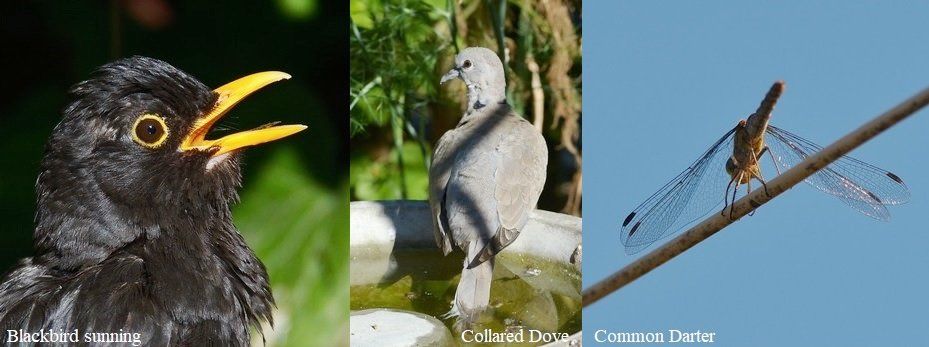
Garden Diary 6th-10th......
A rather ‘under the weather’ Collared Dove was perched on the arch for long periods (10th) but seemed to be eating and drinking ok. A Dunnock was also seen, a male Blackbird was sunning and there was a visit from one of the Hedgehogs at 21.20.
Small and Large White, Holly Blue and Gatekeeper were present.
A Migrant Hawker flew over and a Volucella inanis was on the Oregano flowers.
A ‘large’ Hedgehog paid a visit for food at 21.09 (8th).
A Holly Blue, Gatekeeper, and Large White were in the garden (7th), along with Robin, 15 House Sparrow, Blackbird and Wood Pigeon.
A ‘medium’ sized Hedgehog visited the garden (6th) at 21.26 and again at 21.55.
New bird for garden!
A Lesser Whitethroat was a new bird for the garden (5th) seen in the Buddleia briefly before flying off.
Sat outside in the evening; I was joined by a ‘small’ Hedgehog which ate its fill of cat biscuits and then came right in front of me for a drink!
Juvenile Blue Tits......
4 juvenile Blue Tits were around the Buddleia (4th) and a Wren was seen searching for food along the bark path, just before 06.00 were seen again 12 hours later.
Snuffling noises in the dark......
A male Blackbird with three juveniles was in the garden (3rd) along with a Robin.
A Brown Hawker (right) perched in the shrubs and a Hummingbird Hawkmoth flew through the garden.
A ‘small’ Hedgehog came for food at 21.20 and just after 23.00 some fairly loud snuffling noises was heard and eventually a ‘large’ Hedgehog emerged and went to the water bowl, where it had a drink, which must have lasted not far off 2 minutes!
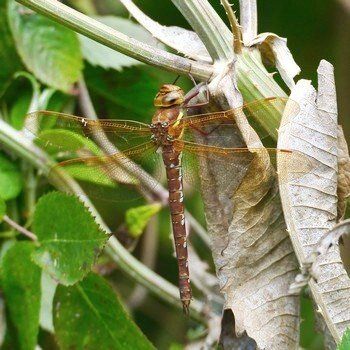
House Martins still but no signs of any Swifts......
6+ House Martins were in the skies (2nd) and later visits from a ‘small’ Hedgehog were at 21.20 and at 22.00.
Oregano flowers very popular......
A Volucella inanis was on the Oregano flowers (1st), along with Holly Blue and 3 Gatekeepers. Other butterflies seen were all the three Whites; Large, Small and Green-veined and a Peacock.
A male Migrant Hawker perched in the shrubs and at 21.15 a small Hedgehog came for food.
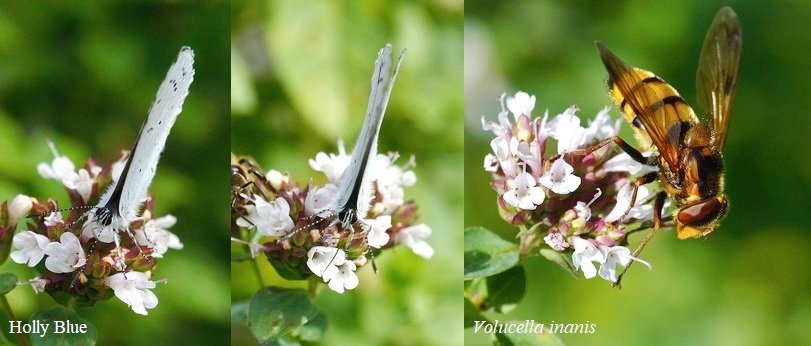
July 2022
Garden nursery......
A Wren was searching for insects in the Clematis (31st) and a male Blackbird was feeding a fledgling.
Hog......
A Hedgehog was seen drinking at 23.22 (30th).
Fresh Painted Lady and Red Admiral......
A Wren looked all set to have a bath in the pond (29th) before it was disturbed by a Wood Pigeon.
A Holly Blue was good to see as was a fresh looking Painted Lady, along with Red Admiral, 3 Gatekeeper and a Large White.
Juveniles bathing......
5 juvenile Blue Tits were in the garden (28th) with 4 of them bathing together in the bird bath. A juvenile Robin was again present.
A ‘small’ Hedgehog was seen at 21.20, 22.18 and again at 22.23.
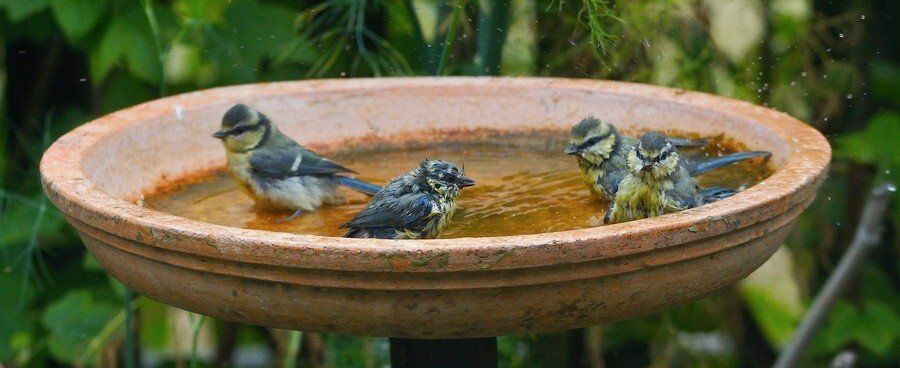

Hat-trick of Hedgehogs!
At approximately 00.10 (27th) a Hedgehog was heard crunching on the food put out for it before I even saw it from the kitchen. This was a fairly small hog and before long it was joined by another of similar size. On turning away for some reason when I looked back out again there was now three Hedgehogs feeding together, the latest a much larger hog; fantastic!
Later, at 01.15 a ‘small’ hog was seen again and then again at 03.35 when a similar sized hog ate and drank.
A Wren was good to see in the garden, along with Collared Dove, Blackbird and at least 9 House Sparrow.
A Migrant Hawker landed in the garden (right) and a single Swift was seen again.
There was more Hedgehog action at 21.35 and again at 22.02, when on both occasions a ‘small’ hog was indulging in the food and water put out for the Hedgehogs.
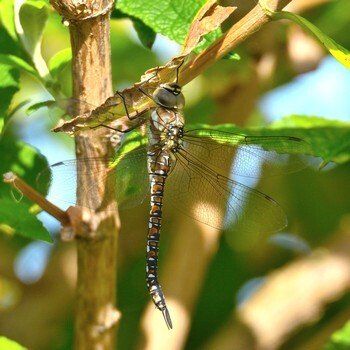

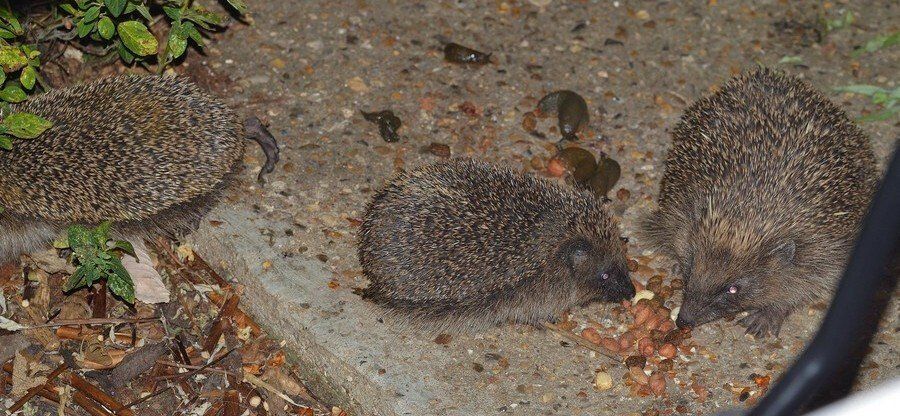
All White......
All three White Butterflies were in the garden (26th); 2 Large and single Small and Green-veined.
A juvenile Dunnock was sunning again and 3 Robins; a sub adult and 2 juveniles, 3 juvenile Blue Tits around the Buddleia again and a single Swift over were all worthy of note.
Hawkers patrol the early evening garden......
Both a Migrant and a Brown Hawker were patrolling over the garden (25th) and at least 6 House Martins a Swallow and 6 Swift were in the skies; the latter soon to depart?
At 21.40 a ‘small’ Hedgehog came for food and water, followed by a much larger Hedgehog at 22.00 and then returned again after approximately 5 minutes before returning northwards along the bark path, towards where one of the hedgehog boxes is situated.
A couple of Hirundines......
A Robin was once again the garden (24th) and a Swallow flew over as did a House Martin.
Butterflies seen were: Large White, Gatekeeper, Peacock and a Meadow Brown outside the garden. A Migrant Hawker also visited the garden.
Hedgehog 'magic'......
6 Swifts were in the skies (23rd) but the real ‘magic’ happened later that evening!
Whilst sitting outside enjoying a glass of Cider (or two!) I looked down to see a very small Hedgehog coming towards me (at approximately 21.40) along the bark chipping path. It walked in front of me, barely 2 feet away from where I sat and then went up onto the concrete path to enjoy the cat biscuits and peanuts I had put out for it.
It fed next to me for about 5 minutes before ambling off to the south of the garden, where I lost sight of it. However, it was seen again at 22.56, feeding again and having a drink; bloody awesome!
Juvenile Blue Tits in the Buddleia......
A Hedgehog was once again in the garden (22nd) at 02.20.
Three juvenile Blue Tits were searching for food on the Buddleia seed heads and flowers. A male Blackbird was still collecting food for its young and 3 Swifts were of note.
Another Hedgehog visit occurred at 22.56, great to see these fast disappearing species utilising the garden’s offerings.
The 'notorious' False Widow in the kitchen sink!
A small Hedgehog visited the garden for food and a drink (21st) at 00.30; no doubt one from this years’ brood.
Seeing a Spider in the kitchen sink I went to move it out of the sink and it then ran from my cupped hand up along my arm and up to my shoulder, where I captured it in a jar to examine before letting it go out in the garden.
I was fairly sure of its identity, at least to genus as being one of the infamous (not deserved) False Widow Spiders;
Steatoda
sp. After looking closely at it I was fairly sure it was a male
Steatoda noblis
(image below). I took it out to release in the garden and was hoping to get more photographs in natural light (flash used initially), but it was not hanging about and speedily ran into cover in the pond surround. I am fairly sure this is not the first Steatoda on the premises as I have seen what looked like one in the brick shed and in the electricity box, but on both occasions moved quickly out of sight. Don’t hang around these False Widows!
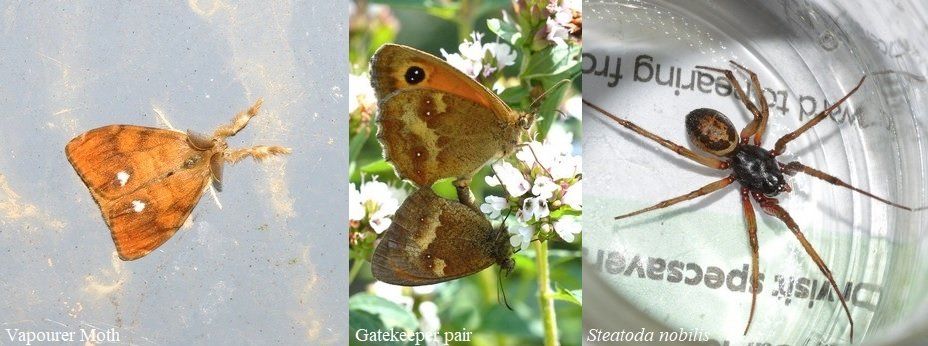
Vapourer; cracking moth and larvae......
4 Gatekeepers were on the Oregano flowers (20th), including a pair mating (image above). Other butterflies seen were: Large and Small White, Peacock and Red Admiral.
A male Vapourer Moth flew across the garden and landed on the gutter where it was photographed (image above); an impressive little moth as are its larvae.
A Volucella zonaria (Hornet hoverfly) also visited the Oregano flowers and a Migrant Hawker was seen outside the garden.
Two Robins came for food and to bathe; a juvenile nearly in adult attire and a juvenile, which enjoyed a bath in the pond, whilst I was sat outside. I cannot remember seeing so many sightings of Robins in the garden as there has been this year. Maybe now the shrubs have grown there is more cover for them, particularly during moult. 7 Swifts were in the skies.
Butterflies today......
Butterflies recorded today (19th) were: Red Admiral, Peacock, Small and Large White and Gatekeeper.
First Migrant Hawker......
The first Migrant Hawker was seen around the tree outside the back garden and indeed over the garden (18th) in the late afternoon/early evening. Ken Saul also had his first at his Filby garden earlier today.
Butterflies recorded were: Peacock, Small Tortoiseshell, Gatekeeper and Large White and a worker Large Red Bumblebee and both White-tailed and Buff-tailed Bumblebees were also of note. Honey Bees are also visiting the flowering Oregano and their presence has attracted their predator the Bee-wolf in previous times!
With the temperatures reaching 300C + I made sure all my 5 water sources, including the pond were topped up and they were needed, especially by House Sparrows (10+) and Blackbirds (male and female and 2 juv). The male Blackbird was taking more time than usual and one of the juveniles was looking for food in the aquatic vegetation, even pulling out pond weed throwing it out of the pond and then dropping down to investigate further ! A Robin was also seen and the juvenile Dunnock was once again sunning; I doubt any feather lice survived the heat today! A Blue Tit visited the garden briefly, at least 6 Swift was in the skies and 2 House Martins drifted past.
There are no breeding House Martins this year in the two places I have seen them nest before, within view of the abode. Maybe this is down, once again to decline or have their nests been eradicated by the usual suspects around here!
It’s nice to report that a Hedgehog was once again in the garden, there having not been any sightings for a while, coming for cat biscuits and peanuts and a drink at 23.22 and was there for at least 5 minutes.
Hard-cut grass useless for Hedgehogs and anything else!
A Brown Hawker briefly appeared (17th), whilst a Darter species (probably a Ruddy) was seen in the back garden and out the front around the Tomato plants.
Earlier a small Hedgehog was seen fruitlessly searching for food out the front of the property on the GYBC’s barren landscape! It is very important to make sure Hedgehogs have a constant supply of fresh water and in the dry weather we are having, help them out with supplementary food as their natural food will not be in any abundance; especially where I live!!
Butterflies today......
Butterflies present today (16th) were: 2 Small White, 2 Large White, Peacock and a Gatekeeper.
A Cormorant flew over heading inland in the late afternoon.
New brood Holly......
A new brood Holly Blue flew through the garden (15th), with Ken (Saul) at Filby also seeing one in his garden.
A Large White was also present and a Sparrowhawk drifted over.
Newly emerged Comma and more visits by Hummingbird hawk.....
A newly emerged Comma was in the garden (13th), along with 2 Peacock, 2 Gatekeeper, Large White, Green-veined White, Small White, Meadow Brown (small individual), and Small Tortoiseshell.
A queen Tree Bumblebee was present, as was the Hummingbird Hawkmoth on three occasions; twice on the Buddleia and once on the Red Valerian.
Never seen before Bee-haviour!
The highlight of the day (11th) was watching and photographing a Patchwork Leafcutter Bee actually cut a piece of leaf!
The ‘wild’ Rose already had plenty of evidence to show that Leafcutters had been working there, but I had never actually seen a Leafcutter Bee carry out this behaviour, but whilst sitting in the garden (about the middle of the afternoon) I saw a small insect land on one of the Rose leaves and immediately recognised it as a bee and then a Leafcutter.
I watched as the Bee began cutting the leaf and then decided to run in and get the camera. Of course, when I got back in the garden the Leafcutter had gone after a process that lasts only a few seconds. Nevertheless, I waited, watching the Rose and eventually I saw something land that looked like a Leafcutter. After getting closer, I fired off shots in an orderly fashion to try and capture what was going on and I watched and photographed the leaf-cutting behaviour two more times after that.
This process, which is so fast and carried out with precision revealed in the resultant photographs that as the leaf is cut with the mandibles the piece of leaf, is gathered up between the Bee’s legs, which it then flies off with. Unfortunately not to any of my bee hotels! Still, a fantastic experience, I have never in my life experienced to watch and capture.
A Hummingbird Hawkmoth was once again in the garden and butterflies seen were: Large White, Small White, Small Tortoiseshell, Peacock and Ringlet.
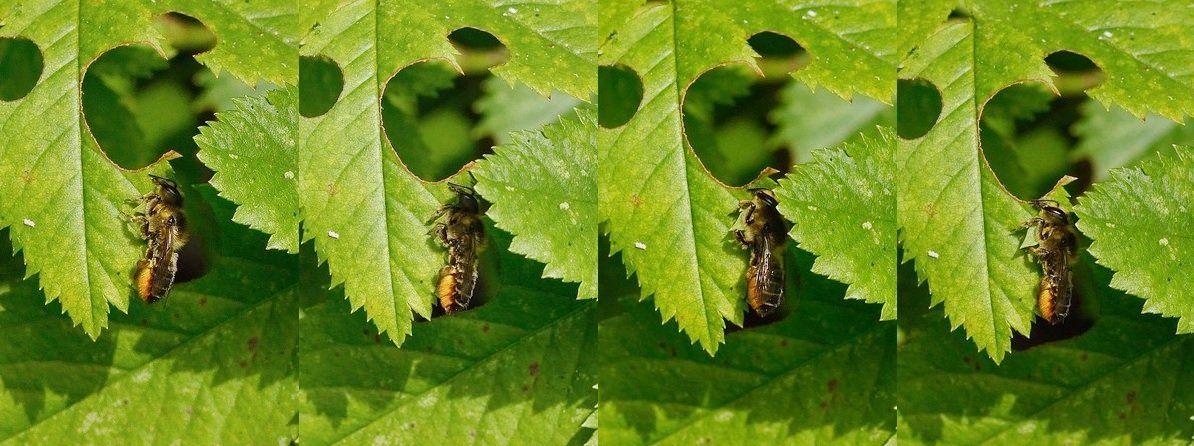
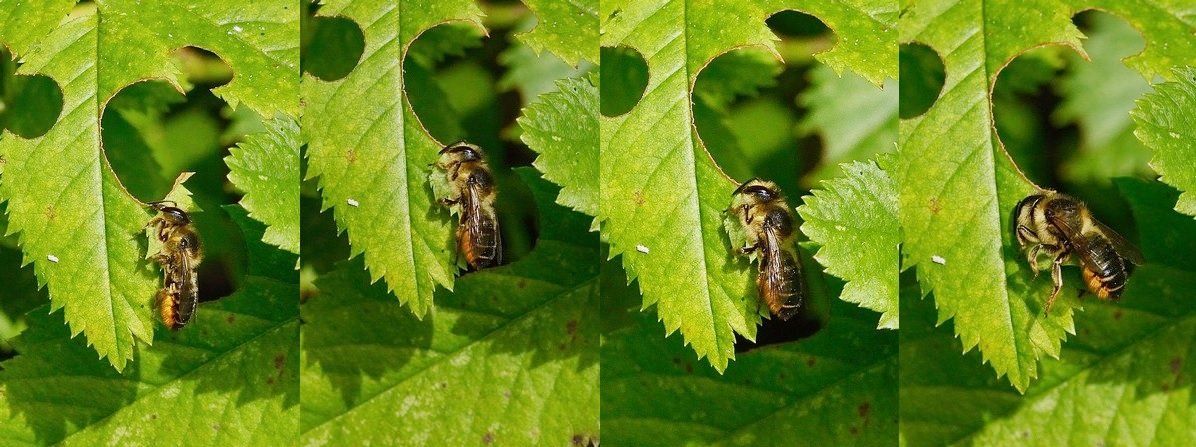
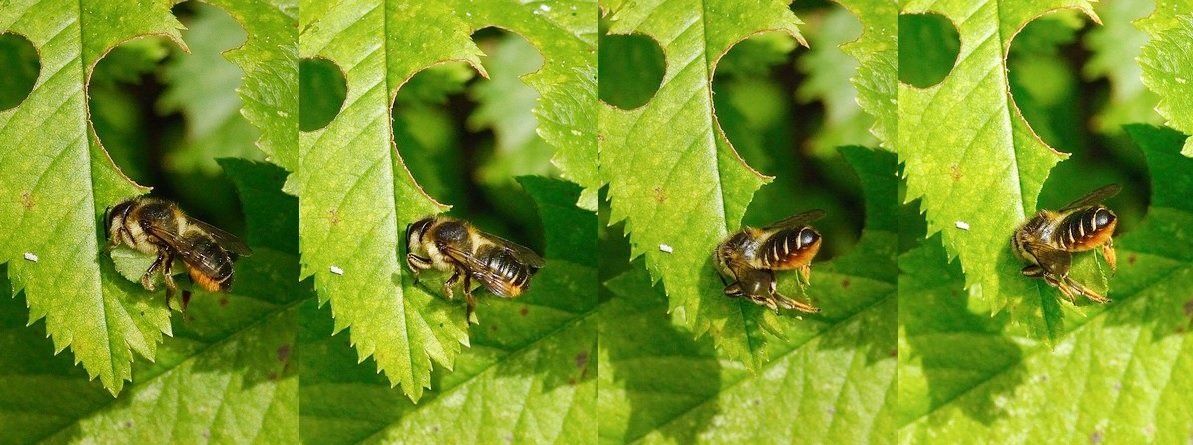
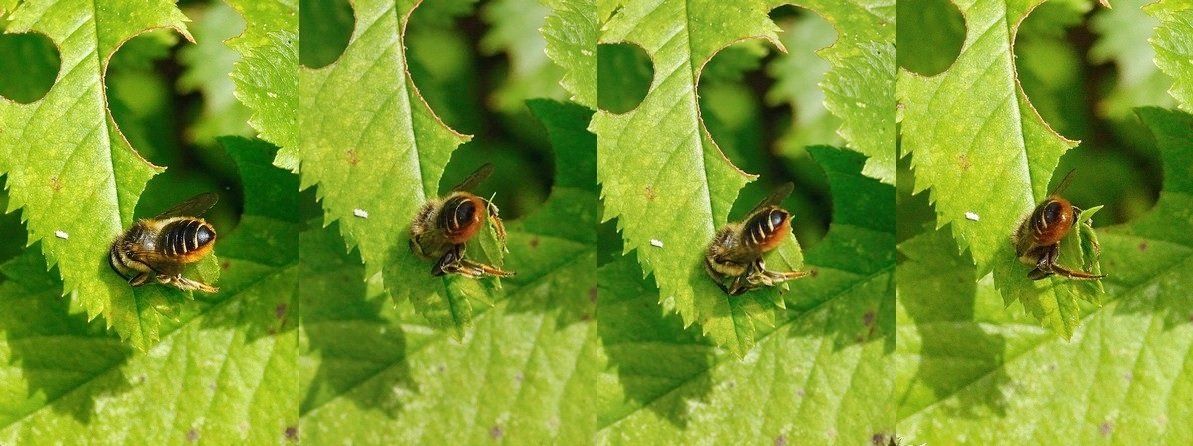
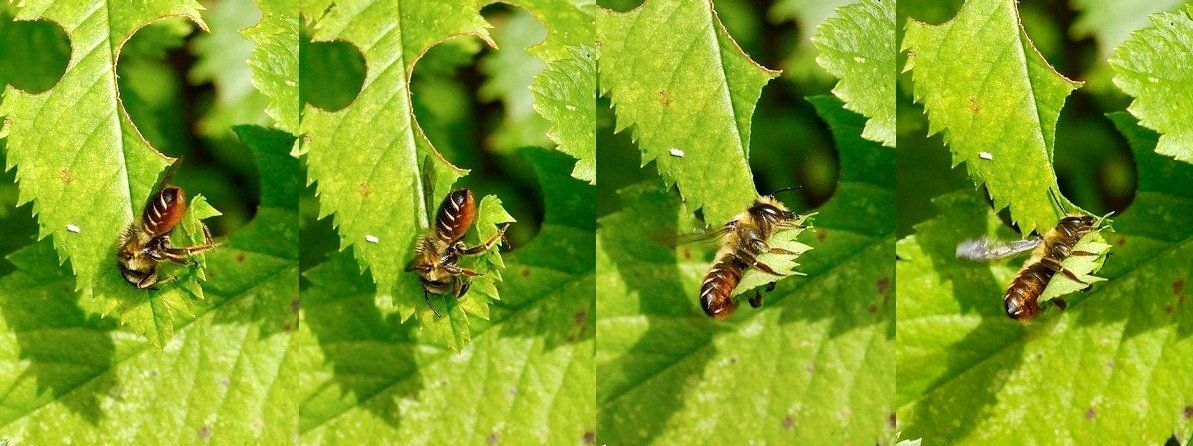
Swifts see off the Sparrowhawk......
On returning from a trip to Foxley Wood (10th), a Hummingbird Hawkmoth was seen visiting the Buddleia flowers.
In the skies, there were 8 Swifts and a Sparrowhawk flew over with two Swifts hot on its tail!
First Ringlet and our largest Hoverfly pays a visit......
Single Butterflies seen today (9th) were the first garden Ringlet, Peacock, Large White, Small White, Small Tortoiseshell and Red Admiral, Meadow Brown and Gatekeeper.
A Hummingbird Hawkmoth was once again on the Buddleia at 17.35 and a ‘Hornet Hoverfly’ Volucella zonaria (our largest Hoverfly species) landed on a leaf to rest.
The juvenile Dunnock was back ‘sunning’ again and another Robin appeared, this time with a tail!
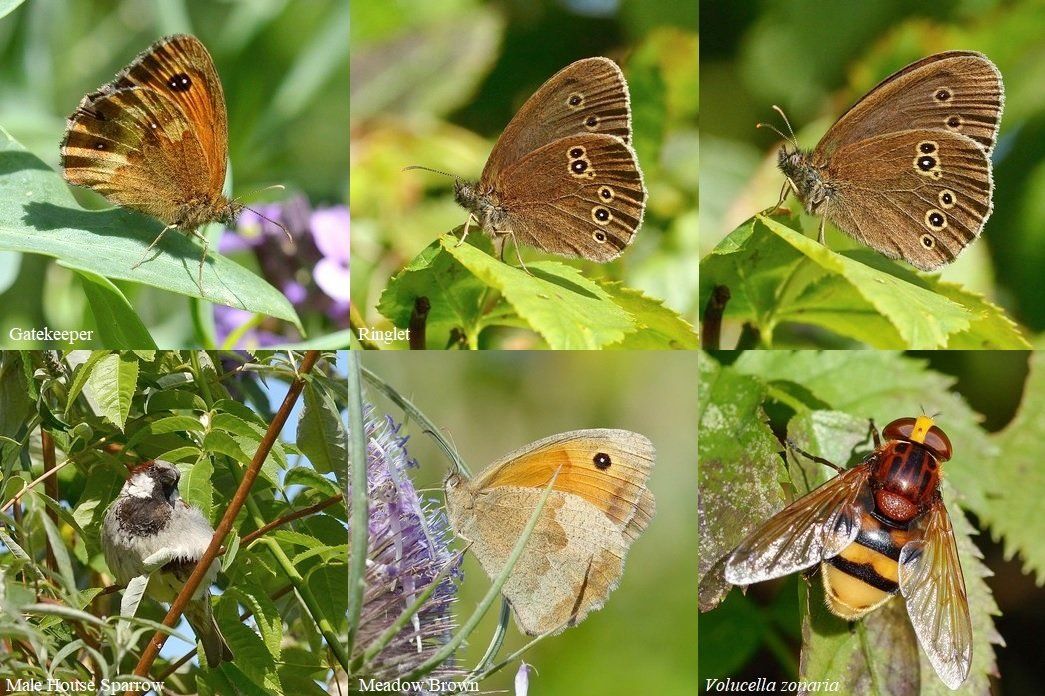
A juvenile Dunnock was ‘sunning’ in the garden (8th) on a bare branch exposed from the recent pruning of the Buddleia globosa. This behaviour, often seen particularly by Dunnocks and Blackbirds is thought to be a way of removing parasites, in particular feather lice, which are difficult to remove by preening alone. For further information please see:
https://www.audubon.org/news/hot-bothered-and-parasite-free-why-birds-sun-themselves
The tail-less Robin was once again in the garden, using the well grown shrubs as cover, whilst in a more vulnerable position to escape from predators.
A Hummingbird Hawkmoth was again present on two occasions, both on the Buddleia, with the second visit being at 20.03.
Butterflies seen (again in single numbers!) were Peacock (the first of a new brood), Large White, Small White, Small Tortoiseshell and Gatekeeper.
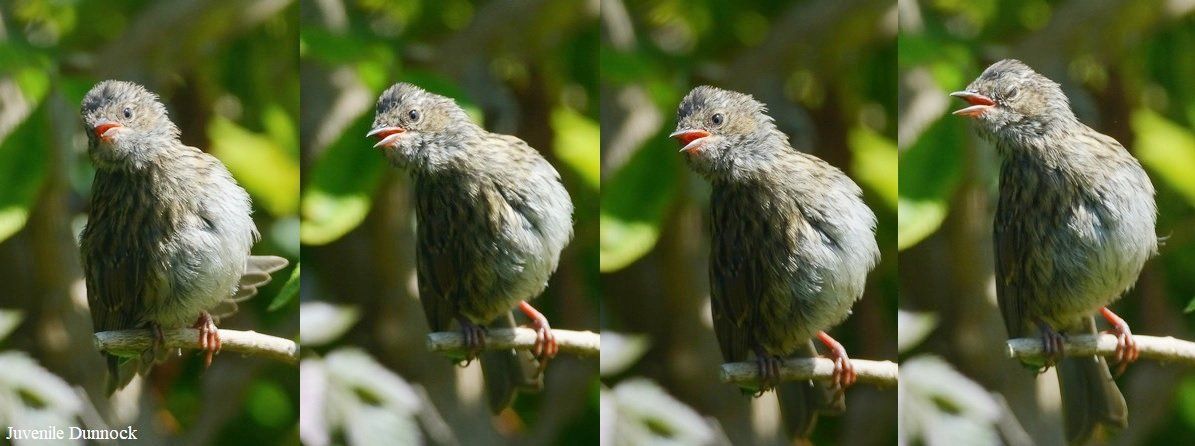

Double hawkmoth visits and first Gatekeeper and Brown Hawker......
The first Gatekeeper of the summer appeared (5th) briefly on a Clematis flower. Other butterflies present were all the whites; 2 Green-veined, 2 Large and a Small and 2 Small Tortoiseshell, 2 Red Admiral and a Comma.
Hummingbird Hawkmoths once again featured with 4 separate visits, but today’s visits were not just of single moths! The first visit was made by two hawkmoths, one on Red Valerian and one on the Buddleia, followed by another visit of 2 hawkmoths, this time both on the Buddleia. Two subsequent visits were of singles both on the Buddleia, fantastic!
The first Brown Hawker of the year made a darting dive towards the Buddleia before departing again and a Common Blue Damselfly perched on my knee briefly!
A Patchwork Leafcutter Bee settled briefly on a leaf, a Robin with no tail was in the garden and in the skies 6 Swift and a House Martin were seen.
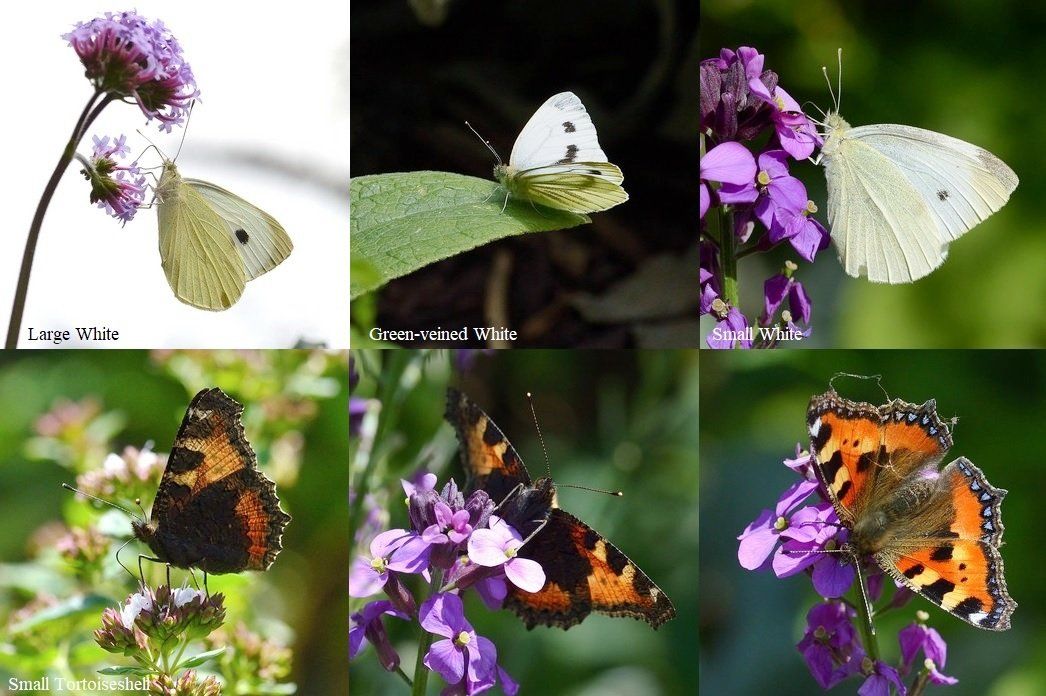

Summer Chafers in the garden......
Summer Chafers were very much in evidence this evening (4th) with at least 20 flying around the tree out the back of the garden but also in the garden, where one landed (but I couldn’t find it to get a better look) and later at least 3 flying around the Buddleia-garden tick! 5 Swifts were to be seen overhead.
Hummingbird visits......
Hummingbird Hawkmoths were present again (3rd), with one briefly on a Perennial Wallflower and a second appearance briefly at 20.30 during a light shower!
Four visits by Hummingbird hawks and breeding news......
The month started off well (1st) with four occurrences of Hummingbird Hawkmoth/s in the garden: 1st visit on Red Valerian, 2nd on Buddleia, 3rd briefly on Buddleia and finally another late visit on Red Valerian at 21.25.
Of interest was an email conversation with Ken Saul on Hummingbird Hawkmoths, who informed me that: ‘Hummingbird Hawkmoths do breed here successfully now, especially the summer brood (i.e. resulting in progeny of the insects we're seeing at the moment). Possible evidence of them successfully overwintering here (in Norfolk) was provided some years back when Mike Hall saw one flying up the inside of a shop window in Diss in February. Whether the ones we are seeing have originated in SW England or continental Europe, I couldn't say.’
Three species of Butterflies were present; Small Tortoiseshell, Red Admiral and Small White, although only in single figures and a juvenile Dunnock was good to see in the garden.
June 2022
Butterflies on the Buddleia (2!), Hummingbird hawk and other insects of interest......
At last (29th), ‘some’ Butterflies on the Buddleia davidii, the first a Small Tortoiseshell and then a Small White, but that was it! A Large White, Red Admiral and nice to see, a 'fresh' Comma were also seen, but in all cases just one of each; catastrophe for butterflies!
A Hummingbird Hawkmoth was seen on three occasions during the day; firstly on the Red Valerian’ secondly briefly on a Geum, and lastly on the Buddleia briefly.
A young Wood Pigeon was in the garden and there were two visits from 2 Goldfinches (presumably a pair) to the pond to drink. On the second occasion one drank and flew off but the second whilst trying nervously to drink was disturbed by two dogs barking, which, yes were making the bird very nervous! Just another way in, which all these beloved Cats and Dogs are doing nothing but harm to our wildlife.
Two species of Hoverfly were identified; a Syrphus vitripennis and a Helophilus pendulus (aka ‘The Footballer).
Also of interest was a Plumed Moth, in this case a Beautiful Plume Amblyptilia acanthadactyla and unless I had seen it land I would not have seen this delicate but well camouflaged moth (thanks to Ken Saul for the ID) and the first Ruddy Darter of the year (anywhere!).
Meanwhile, I suddenly noticed that Leafcutter Bees had been busy cutting out pieces of leaves for the ‘wild’ rose, which they use for the chambers in their nests, something I have yet to see them actually do!
However, please find below a video taken by Jason Nichols of a Leafcutter, at least with a piece of leaf after he watched it cut the piece, on top of an ornamental Owl!.
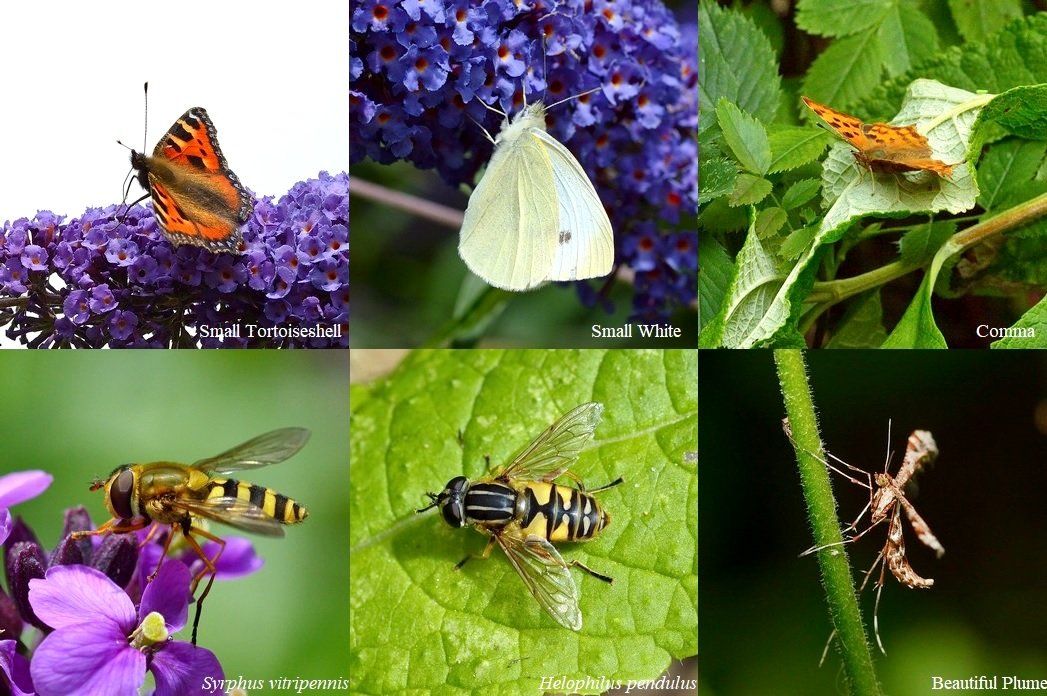

It was a warm sunny afternoon in June and I was watching the Bees feed in my wildlife garden, when I noticed a Bee land on a leaf of Broad-leaved Willow herb, presumably (I thought) to rest. However it repositioned to the edge of the leaf and very quickly cut out a section and flew away. This happened far too quickly for me to film. The same or another Leafcutter returned a few minutes later but to a willow herb too far away to film and cut out another segment, this time instead of flying immediately away out the garden, it flew towards me and onto the ornamental owl where I was able to film it before flying away, again out of the garden.
Jason Nichols.
More Hummingbird Hawkmoth visits but no insects on the Buddleia?!
Another visit from a Hummingbird Hawkmoth on the Red Valerian (27th) is always welcome.
A Wren sought cover in the garden shrubs just before a heavy downpour and thunder and lightning and a Robin attempted to bathe in the pond but was saw off by size alone from a juvenile Blackbird.
What is rather troubling is the absence of any Butterflies or Bees on the Buddleia davidii, which has been in flower for at least 5-7 days, to the point where some flowers are already ‘going over’!
Summer Chafers?
A Wren went along the fence (26th) and 2 Goldfinches were briefly in the garden.
Much later, after 21.00 at least 8 insects, thought to be Beetles were flying around the tops of the tree outside the back garden. Based on some awful photos and research; time of year, size etc, I thought them to be Summer Chafers
Amphimallon solstitialis, a species in decline, but then aren’t they all!

Young Blackbirds enjoy the pond and garden......
Four juvenile Blackbirds were in or around the pond (25th), so nice to see them using the garden as a source of refuge (not many other places to go around here!) and for drinking and hunting purposes.
A Robin came into bathe in the pond and a young Magpie was identified as the culprit of pushing my plants in pots off the table!
Late visit fro Hummingbird hawk......
A Small White and a Small Tortoiseshell were present (24th) with the Small White ovipositing on the developing Nasturtiums.
A Hummingbird Hawkmoth was once again present but a very late visit (or is it?) after 21.00.
Juvenile Goldfinch and Hummingbird hawk......
A juvenile Goldfinch landed on the arch (22nd) about 6 feet away and then tried to drink from the pond, without drowning! This it eventually achieved by perching on one of the lily pads, unlike the Hose Sparrows who know how to edge themselves down the log, put in for the purpose of drinking birds and anything wishing to escape!
A Hummingbird Hawkmoth was a visitor to The Red Valerian ones again and a Meadow Brown was briefly in the garden.
Hummingbird Hawk two days running......
Today (20th) was very similar to the previous day with visits from both Hummingbird Hawkmoth and Red Admiral.
At least 14 House Sparrows visited the garden and a Robin, Blue Tit, 2 Blackbird and a Collared Dove were all good to see.
A Hummingbird Hawkmoth was once again present (19th) visiting the Red Valerian flowers on two occasions during the day. A Red Admiral was also in the garden.

Eyes skywards......
A late afternoon spent in the garden (18th) was rewarded with flyovers of Red Kite, 2 Common Tern, 5 Swift and Oystercatchers were heard.
Two appearances from Hummingbird Hawkmoths......
A Hummingbird Hawkmoth made two appearances (17th), on both occasions visiting the Red Valerian flowers.
A Patchwork Leafcutter Bee was again present (Geum flower again) and a House Sparrow was seen eating the emerging Buddleia davidii flowers.
4 Swift were in the skies, with one very low down over the garden.
First Megachile......
The first Leafcutter Bee a
Megachile centuncularis Patchwork Leafcutter Bee appeared in the garden (16th) on a Geum flower.
Hawkmoths x 2 species!
A new moth species this afternoon (13th), when a Broad-bordered Bee Hawkmoth was seen visiting the Red Valerian. It visited several Red Valerian flower heads, but eventually flew off.
However, the afternoon was not over for day-flying moths because a short while after the visit from the Broad-bordered a ‘humming’ was heard coming from a relatively large insect. When it came into the light I could see it was A Hummingbird Hawkmoth and like its predecessor visited the Red Valerian flowers.
A pair of what looked like Azure Damselflies was seen flying in tandem and a Meadow Brown was once again present along with at least 4 Small Tortoiseshells.
Later, 2 Goldfinches landed on the top of the arch, not 6 feet away from me and then went down to drink from the pond. A rather satisfying afternoon in the garden!
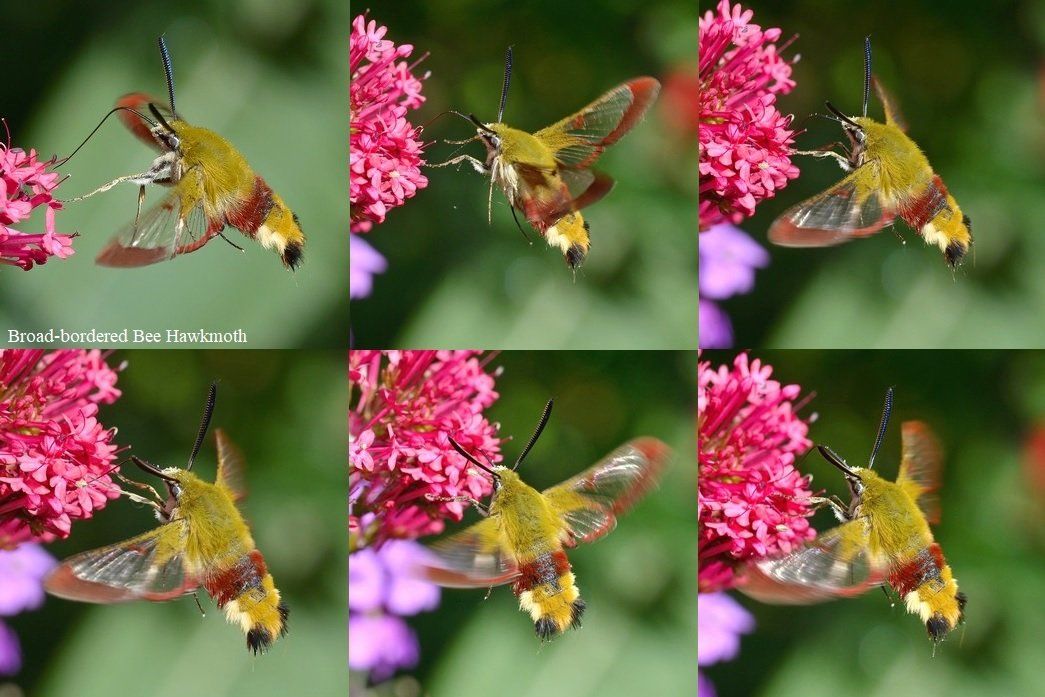
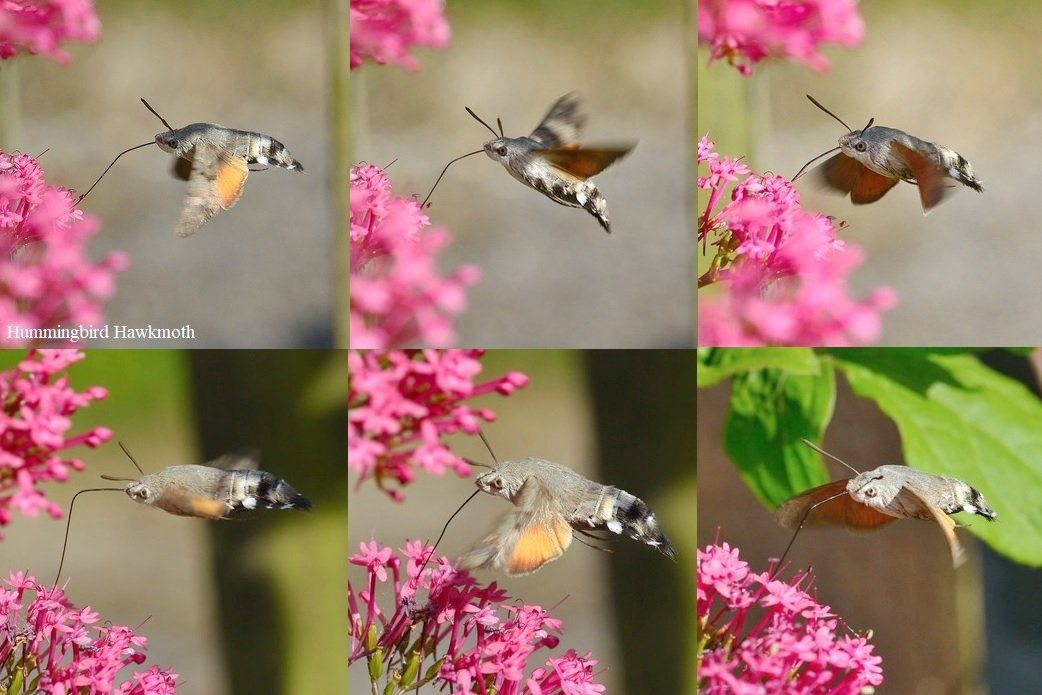
Meadow Brown emergence......
The first Meadow Brown of the year (12th) was in the garden, briefly visiting an Aquilegia flower.
2nd Hobby appearance......
A Hobby was seen soaring around before heading of east in the latter part of the afternoon (10th) and 4 Swifts were also present.
In the garden a Painted Lady remained along with 2 Red Admiral and 9 Small Tortoiseshell.
Calling Oystercatchers......
A Painted Lady was once more in the garden (9th) on returning from a day out. Also still present were at least 2 Small Tortoiseshell and a Red Admiral.
Two calling Oystercatchers flew over and also in the skies were 2 Swift and 3 House Martin.
No mourning for a new garden Bee!
It is kind of ironic, that after putting the article about Anthophora plumipes and their use of ‘mud bricks’ on the website’s Wildlife Articles page I get a first for the garden (8th);
A. plumipes cleptoparasite
Melecta albifrons Common Mourning Bee (8th)! The new Bee species did hold on long enough for me to dash indoors and get the camera as it visited a Geum flower, but then moved briefly to a Red Valerian flower before flying off, as if it knew what was coming very soon after; a gusty wind and a fairly heavy downpour!
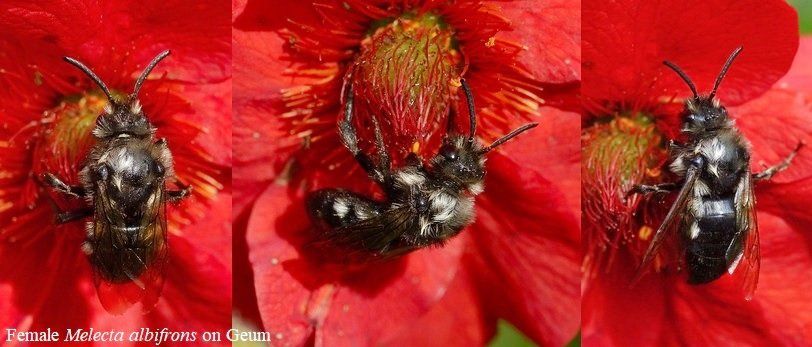
Buddleia globosa draws in the insect crowds and a 2nd Hummingbird hawk......
During the last few days (between 2nd and7th) the Blue Tit young must have fledged and disappeared, as there was no more calls coming from the nestbox and no more feeding visits from the adults (7th).
The garden was buzzing with Bumblebees and at least 6 Small Tortoiseshell, 5 Red Admiral and a Green-veined White (actually feeding in the garden on Daisies and Perennial Wallflower!) were also present. Most of the attention by both Bees and Butterflies was given to the Buddleia globosa flowers. These orange flower spheres are highly attractive to insects, going all the way back to when I was a small boy watching them cover the rather large specimen in my Nan’s garden.
Flowers also popular were: Perennial Wallflower, Geum, both species of Clematis, Railway Daisies, Foxglove, Purple Toadflax (particularly favoured by Carder Bumblebees), Cotoneaster, Chives (now turning to seed) and last but far from least Red Valerian.
A Pied Hoverfly Scaeva pyrastri was also seen and 6 Swifts were overhead and a House Martin (not seen since the first arrival!).
A 'Common' Pug Eupithecia vulgata was found outside on the kitchen wall, thanks to Ken Saul for confirming the identity of this very variable moth.
Just after 17.00 the second Hummingbird Hawkmoth was visiting the Red Valerian. Unfortunately, by the time I had got indoors and out again with the camera it had gone!
*If you have not yet looked at it there is an
article on
Anthophora plumipes and their use of ‘mud bricks (Cobs), with a video by their ‘inventor’ John Walters. A way in which to give this charismatic bee a place to breed in the garden is most welcome!
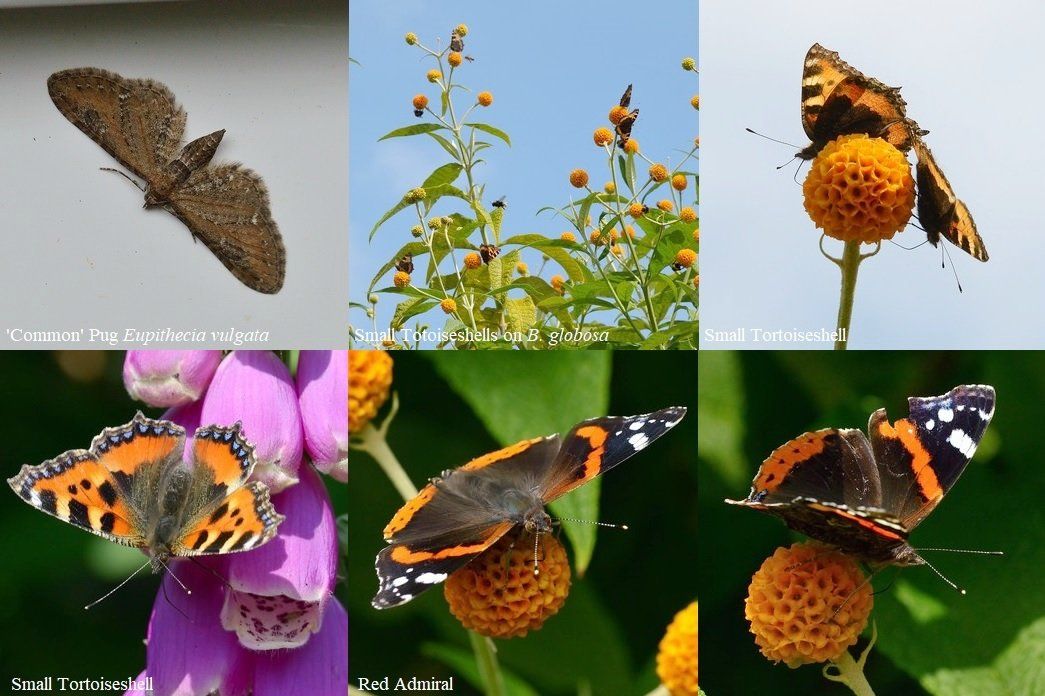

First Small White appears, along with 2 Osmia Bees......
The first Small White of the year was in the garden (2nd), a very ‘small’ individual with a slightly deformed wing and spent off and on all day in the garden. A Large White, Small Tortoiseshell and a Painted Lady were also seen.
The first Osmia leaiana Orange-vented Mason Bee this year was seen entering one of the bee hotels and another first was another Osmia species Osmia caerulescens Blue Mason Bee settled on a leaf briefly.
A Hedgehog came for provisioned food at
22.47.
Med Gull over......
An adult Mediterranean Gull flew NW (1st) and 4 Swifts were overhead.
The Blue Tits were still feeding their young in the nestbox and one of the adults had a much needed bath in the pond yet another Black-tailed Skimmer flew over and a Small Tortoiseshell was also present.
5 species of Bumblebees were in the garden: Buff-tailed, Large Red, White-tailed, Early and Tree and an Eristalis intricarius Hoverfly were also seen.
May 2022
Queen Hornet flyover......
A flyover queen Hornet was the highlight today (30th), with 2 Common Buzzards also in the skies.
The second record of a Black-tailed Skimmer this year was in the garden and 2 Painted Lady, Large White and a Small Tortoiseshell were also recorded.
Hummingbird Hawk!
The first for sometime were 2 Small Tortoiseshells, 2 Painted Lady (right) and a Large White (28th).
A queen Large Red Bumblebee was good to see and at 17.45, whilst sat outside with a glass of wine a Hummingbird Hawkmoth visited the Red Valerian flowers, albeit in rather dull weather; nice!
Butterflies and Bumbles......
A Peacock was present (27th) along with Painted Lady (also present the past two days), Red Admiral and 2 Large Whites.
Bumblebees included Early and Tree workers.
An underrated Songster......
Outside this evening (23rd), sheltering from the rain (at least my annoying neighbours were not out!) under the kitchen overhang, I was serenaded (not by the bird’s choice!) by the beautiful song of a male Blackbird, just to the right and above me.
Being so close I could hear every note from this beautiful songster; a match for any Nightingale, if not more! The range of notes and tones, with melodic interventions, flute like passages and cadences were something to behold
How beautiful this so-called ‘common’ garden bird is, please let it not be part of Carson’s Silent Spring, which at the moment seems inevitable!
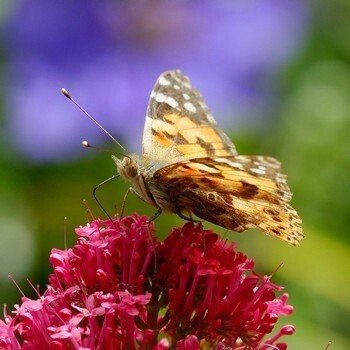
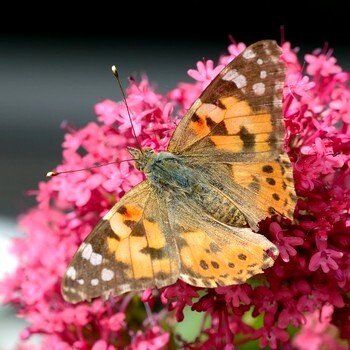
First Orange-vented Mason and new for the garden, a Grey-patched Mining Bee......
An Osmia leaiana Orange-vented Mason Bee was seen entering one of the bee hotels (22nd), which was the first of the year.
Another first, but this time for the garden was a female Andrena nitida Grey-patched Mining Bee with a preference for the Chive flowers and on one occasion an Allium flower. Thanks to Dr. Nick Owens for his identification, once again.
Other Bees present were Large Red Bumblebee worker, again favouring the Chive flowers and worker Carder Bumblebees plus a queen of the species.
A female/immature Black-tailed Skimmer was a first for the year as was a Painted Lady. A Red Admiral, Large White and Holly Blue were also present, as was a male Azure Damselfly.
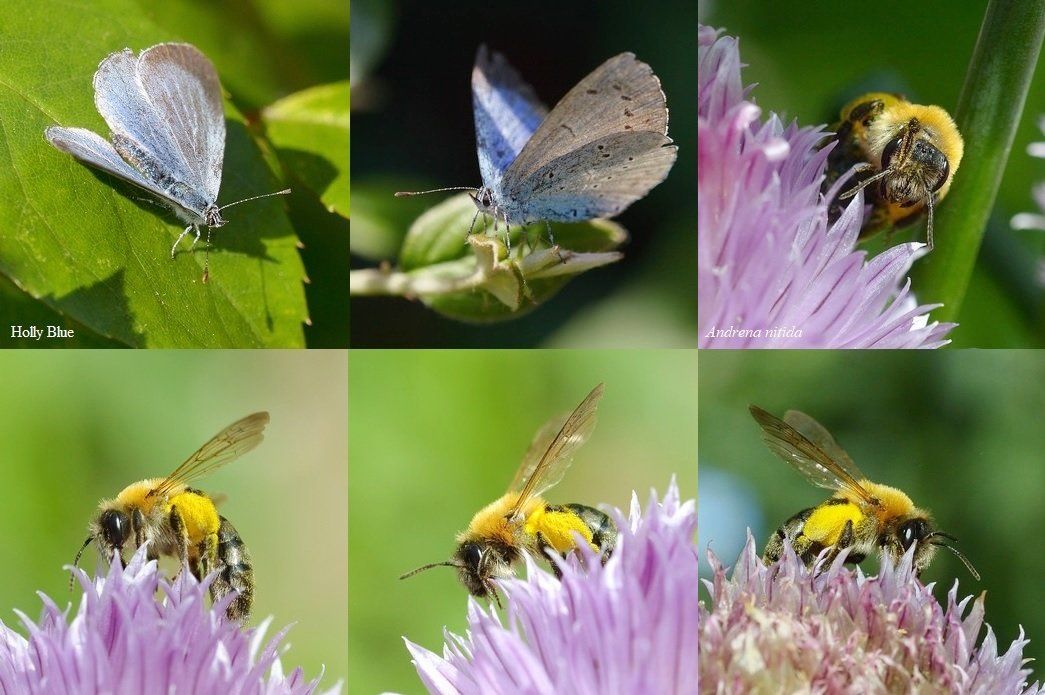

Tree Bumbles gradually returning......
A Tree Bumblebee worker was in the garden (21st) and with the Buddleia globosa beginning to flower, maybe there will be even more as there was in 2021.
Red Admiral; first of the year......
The first Red Admiral was in the garden (17th), as were Holly Blue and Large White.
A Garden Bumblebee was seen and more Azure Damselflies exited the pond.
A Swallow over was the first of the year from the garden.
Hobby fly-over......
The first Hobby of the year flew over in the early evening (16th) and 5 Swift were also in the skies.
A Holly Blue and a Large White were in the garden.
New Furrow Bee for garden......
A Marsh harrier flew over (15th) heading NW.
In the garden were Carder and Buff-tailed Bumblebees, Red Mason Bee and a female Lasioglossum calceatum Common Furrow Bee on one of the newly planted Allium flowers, which was a first for the garden (thanks to Nick Owens for confirmation).
The first Dragonflies began emerging from the pond, with two immature Azure Damselflies seen leaving the pond.
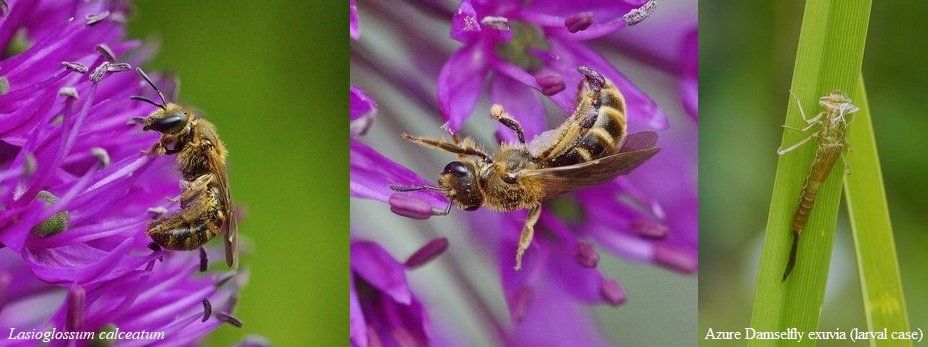
A Large Red Bumblebee worker was visiting the Chive flowers (14th) and also in the garden were Red Mason Bee, Large and Green-veined White, Holly Blue and a Bee-mimic Hoverfly sp.
A Great Tit visited the garden briefly, whilst its smaller Blue cousins were still busy feeding young and 5 Swift were overhead.
Swifts from the garden chair......
A spot of Swift photography (13th) from the garden chair made for an enjoyable early evening, watching these highly agile fliers; the Red Arrows 'eat your heart out'.
Busy Blue Tits......
The Blue Tits were busy feeding the young in the nestbox (12th) and a Red Mason Bee was also in the garden.
3 Swift and 3 House Martin were in the skies and 5 Goldfinch were seen outside the garden.
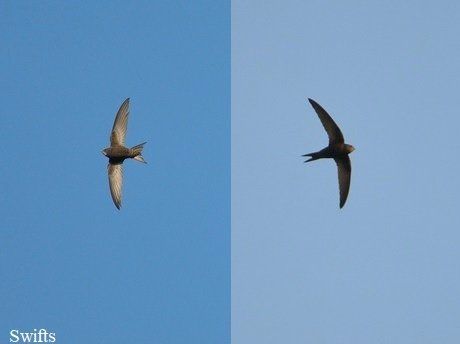
First House Martin and Swifts arrival......
A Holly Blue, Large White, Dark-edged Bee-fly and a Carder Bumblebee were in the garden (10th), but the highlight of the day came at approximately 16.20 when our first House Martin was in the skies, followed a few minutes later by the first Swifts of the year (3).
A Hedgehog in waiting......
The Hedgehog was already waiting for me to put food out 21.05 (9th) and I risked going out and putting some food down. The hog didn’t move but on retreating quietly indoors he or she exited the garden via the gate. However, by 21 10 the hog was back enjoying the free supplement of cat biscuits and peanuts.
Red Mason Bees and a Hedgehog quick off the mark......
At last, Red Mason Bees Osmia bicolor were in the garden today (8th).
A Hedgehog came for food at 21.05, one minute after I put it out!
Orange-tip and immanent danger to wildlife......
The first male Orange-tip of the year was in the garden (6th), actually settling before flying off again. A Large White fluttered over the garden, whilst a Green-veined White flew over the garden relatively high.
Early, Carder and Buff-tailed Bumblebees were also present, but insects are not common; in terms of both biodiversity and numbers, a trend that seems to be a common occurrence now and for some time now! I see no future as not enough is being done and as quickly as required. Mankind will only react to legislation and effects directly to him and nothing is being done on that front.
So many little celebrations (e.g. Bitterns according to the idiot on Bird Guides, who slated me for my more holistic approach!) but none of any consequence!
My good friend Mike Linley; who has seen many things on this planet as a world-leading Herpetologist and a world-wide film producer; via a telephone conversation the other night sees hope but that it will take a long time to put things right. For once I have to disagree with Mike. The danger is not imminent enough, although to those who know it is beyond that!
May Hedgehog sightings and first Large White......
The first Large White was seen over the garden (3rd) and a visit from the ‘small’ Hedgehog was at 22.45.
A Hedgehog was once again in the garden at 21.25 (2nd).
A Hedgehog came for food and water at 21.08 (1st).
April 2022
Parrot from the garden and Picture-wings in the garden......
A surprise appearance of a calling Ring-necked Parakeet (30th) was a new species from the garden, heading in a southerly direction and a Garden Warbler was heard singing somewhere to the east of the property.
A new addition to the garden invertebrates was a Picture-winged Fly probably Euleia heraclei (aka Celery Fly) seen on a Buddleia globosa leaf waving its wings and sometimes disappearing under the leaf, as these flies tend to do; fascinating little animals! Also in the garden were: Carder and Early Bumblebees, female Anthophora plumipes, Dark-edged Bee-fly and a Sawfly species, possibly Macrophya alboannulata.
However, insects are far from ‘common’ in the garden, at this time and take some finding!

Hedgehog Diary 25th-27th......
A Hedgehog came for food and water at 22.10 (27th).
Hedgehog sightings (26th) were at; 20.59 and again at 23.26.
A small Hedgehog visited the garden for food (25th) at 22.51.
On which we depend......
An impromptu visit to the kitchen (22nd) at 22.08 saw a ‘small’ Hedgehog entering the garden via the enlarged partitions in the garden gate (not required in this instance!). The hog then had provisioned food and water before setting off to explore the northern path of the garden at 22.27.
At 22.35 a Hedgehog was seen up until 22.42, when it then departed the ‘feeding station’ for an exploration of the northern end of the garden.
A second Hedgehog appeared at 23.14, unfortunately still exhibiting the pale spines of indiscriminate human marking and came to partake in the provisioned cat biscuits and peanuts. Another ‘small’ Hog appeared in the garden at 23.37.
What is good about this, is that the garden is supplying much more than artificial food for the Hedgehogs; result! If you have one of these, dare I say Ecological Experiences, pat yourself on the back and feel good that you are helping the environment and the very creatures that are related to us and on, which we depend upon.
Hedgehog evenings etc......
A ‘small’ Hedgehog came for food (23rd) at 04.06.
Later, a small hog visited the garden at 22. 32 until 22.38 and then visited again at 23.57, when provisioned food and water was consumed.
A ‘small’ Hedgehog was in the garden at 00.41.
A Tapered Drone fly Eristalis pertinax was holding territory in the garden and the first Holly Blue appeared on at least three occasions and a Peacock also came to sun itself on the bark chipping path.
An Andrena fulva Tawny Mining Bee was new in on the Flowering Currant, where there was also an Early and Buff-tailed Bumblebee, but the brisk N.E. was not allowing insects to settle for very long.
Both male female Anthophora plumipes were again present as was a Dark-edged Bee-fly and the now almost residential pair of Mallard. Better off in my garden than out in Martham village where they are targeted to be run-over or killed by other means. All wildlife is welcome in the garden.
A Hedgehog appeared at 21.15 and again at 21.36, when the ‘small’ hog appeared in the border and immediately came to the provisioned water and then ate before going off into the garden borders.
At 21.55 a second Hedgehog appeared and again at 22.35 when it went straight to the water supply.
A very small Hedgehog (possibly the third of the evening) was seen at 22.41, which ate some food, drank from the water bowl before exploring the bark path.

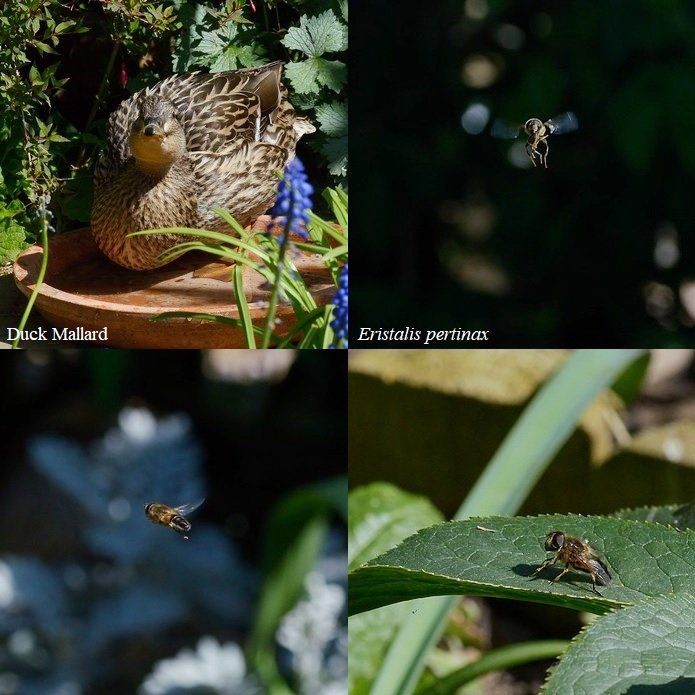
Gull alarm for Raptors......
The alarm calls of Lesser Black-backed Gulls (17th) had me looking skywards and there I found the reason for their angst; 2 Common Buzzards and a Sparrowhawk soaring above the village.
Carder Bumble and Brambles and Blue Tit association.......
A queen Bombus pascuorum Carder Bumblebee was the first one spotted in the garden this spring (14th). The queen visited Flowering currant flowers and also those of Three-cornered Leek. Other Bees present were both male and female Anthophora plumipes Hairy-footed Flower Bee (always find the common name more of a mouthful than the Latin-proper name for it), Buffish Mining Bees and both Early and Buff-tailed Bumble Bees, all in small numbers, however.
What looked to be a male Green-veined White fluttered across the garden without stopping, a Small Tortoiseshell was also briefly present and a Dark-edged Bee-fly visited the Grape Hyacinths.
A Blue Tit had been seen earlier taking the same white feather towards one of the nestboxes on at least 3 occasions, why it was having trouble with the feather is unknown. However, after Brambles (Rabbit) had deposited a nice clump of tail fur, this was collected and placed on the Iceberg Rose near the nestboxes (small hole and multiple (3) small hole).
Later in the early evening, from the kitchen window, I observed a Blue Tit gathering up the fur and heading to one of the nestboxes, confirming that the titmice are nesting in the garden and also the nest is nearing completion. Well at least it makes hoovering more tolerable, when there is an end product for Nature!
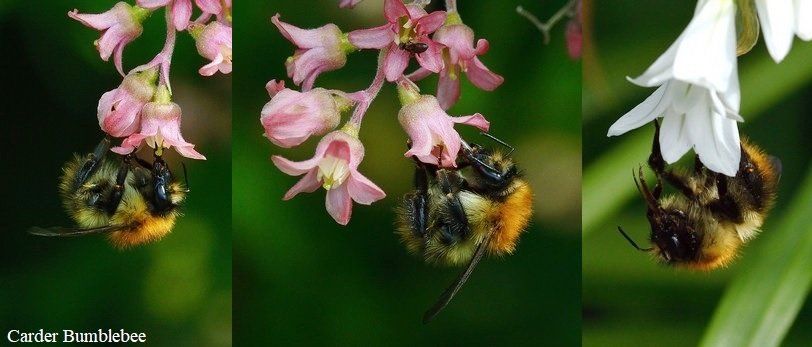
Hedgehog Street do not condone the marking of Hedgehogs, either......
Following a recent inquiry to Hedgehog Street, regarding the marking of Hedgehogs and receiving a reply from them (11th), there is an article on their website stating they do not condone the marking of Hedgehogs.
As mentioned on more than one occasion on the Wildlife Garden Diary, I am disgusted by what I am seeing in my garden, with respect to Hedgehogs with large areas of presumably paint on them, put there by some ignorant individual/s who have no respect for the welfare of the animal, which this marking practice affects.
Female A. plumipes......
A female Anthophora plumipes was present visiting the Flowering Currant (9th) as was a queen Buff-tailed Bumblebee.
See Nick's Beemails for an indication of what Bees are about during the year.
The first Bombylius appears......
The first Dark-edged Bee-fly Bombylius major was in the garden (8th) visiting Grape Hyacinth flowers.
Also found were a Common Drone Fly Eristalis tenax and at least two female Buffish Mining Bees visiting the Three-cornered Leek flowers.

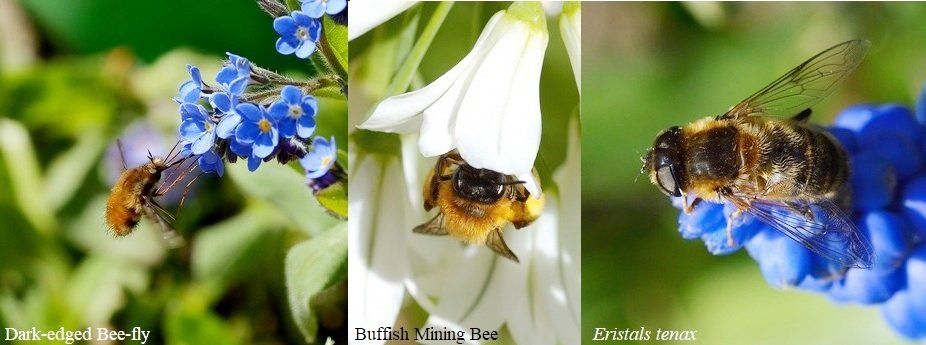
Early queen on the Ribes......
A queen Early Bumblebee was seen as it visited the newly emerged Flowering Currant flowers (4th).
Hog and Mouse (good name for a pub?!)......
The first sighting of a Hedgehog for some time occurred during a sleepless night for me at 2.40 (3rd). The Hog consumed peanuts and what was left of the cat biscuits (after a cat had been scared out of the garden earlier) put out for it, before having a drink and then leaving under the gate at 2.53.
Unfortunately, once again the Hedgehog had been ‘marked’ with a bleached out ‘squiggle’ on its spines. If anyone knows who is doing this (Martham, Norfolk area) please let me know.
During the Hedgehog’s visit a Mouse (more than likely a House Mouse) was seen zigzagging across the path and daring to grab a piece of food before quickly returning to cover.
I was far more surprised to see the Mouse than the Hedgehog, as the density of domestic/feral (feral on the basis of the time they are not cared for by their owners) is high around here and has recently been augmented by two more cats, which the aforementioned was one of, having seen it in the new ‘neighbour’s’ window!
A cold start to April......
The beginning of April (1st) saw some wintry weather return (and over the last few days of March), but the following birds visited the garden: Blue Tit, Robin, Blackbird, Jackdaw, Collared Dove, Wood Pigeon, Dunnock and Starling.
March 2022
Birthday Ducks!
A pair of Mallard returned to the garden (29th). They were not any of the individual ducks that had returned year after year but nice to see. However, the pond had to be covered over with an expanding trellis to stop the Ducks eating all the invertebrates!
More 'Lazy Gardening' and Dunnocks displaying in the shadows......
Some time was spent sowing seed today (27th), the lazy way, but nothing wrong with that, as many seeds are not dispersed with accordance to a seed packet’s depth guide!
Several seed mixes, including a packet mix of meadow flowers entitled The Bee’s Knees, Cosmos, Hyssop, Cornflower, Red Campion and Viper’s Bugloss were all mixed in to a bucket of sand and scattered over the presently bare areas in the borders. These areas were then ‘raked’ over with a fork and watered in. And so we wait!
A ‘pair’ (who knows with Dunnocks!) was in the garden (image below excuses for bad image; taken through the window and in dark shade) with the female showing wiliness to mate by quivering and raising her tail. A very quick mount by the male and it was over, with both birds tumbling forward on release.
I absolutely adore these little birds, with their various striated markings and mouse-like movements over the ground and for their beautiful turquoise eggs lain in a neat little nest, which I used to find in my Nan’s orchard as a young boy, so Dunnocks have always been a favourite bird of mine.
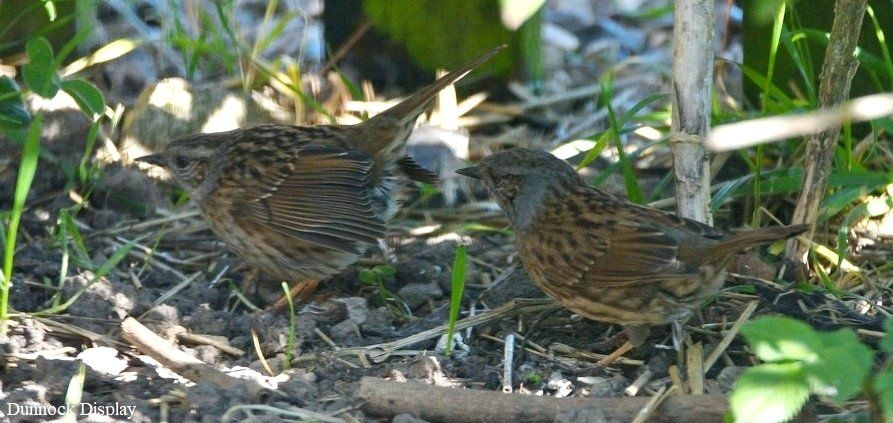
Active Garden......
Another active day in the garden (23rd), with Buffish Mining Bee, Anthophora plumipes (male), queen Buff-tailed Bumblebee, Small Tortoiseshell, Peacock and a fresh Green Shieldbug, which flew in landing on the Flowering Currant and identified from the kitchen window with binoculars.
Blue Tits were still showing in the garden and one was heard tapping inside a nestbox. This has been recorded several times before, although why exactly they do this is not clear; although my friend Sally did suggest they were testing for dry rot!!
Other Avian species were: Robin, 3 Dunnock, House Sparrow, 2 Jackdaw, 5 Starling, 2 Wood Pigeon and once again a Wren.

First Peacock and interest in one of the nestboxes......
With the weather now much warmer and reaching 15 degrees the first Peacock was in the garden (22nd), sunning on the bark path. 2-3 Small Tortoiseshells were also seen, along with a male Anthophora plumipes and a queen Buff-tailed Bumblebee.
A Blue Tit was showing interest in one of the nestboxes (can’t see round the shed wall from the kitchen!), a Robin was present as well as one heard singing nearby and 2 Dunnock, 4 House Sparrow, 2 Wood Pigeon, 2 Starling, Collared Dove, a male Blackbird (also singing from the tree outside the back garden) and a Wren, which gave song from the garden fence.
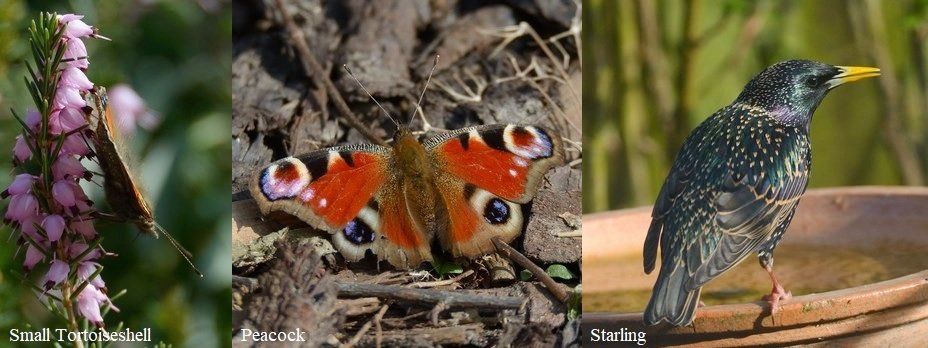
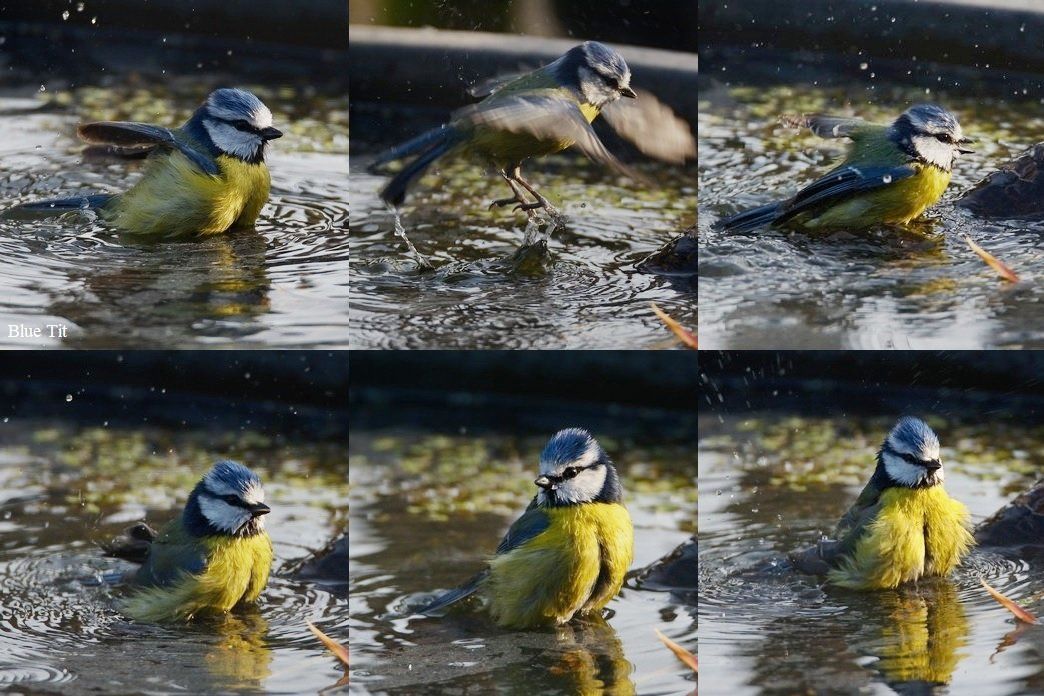
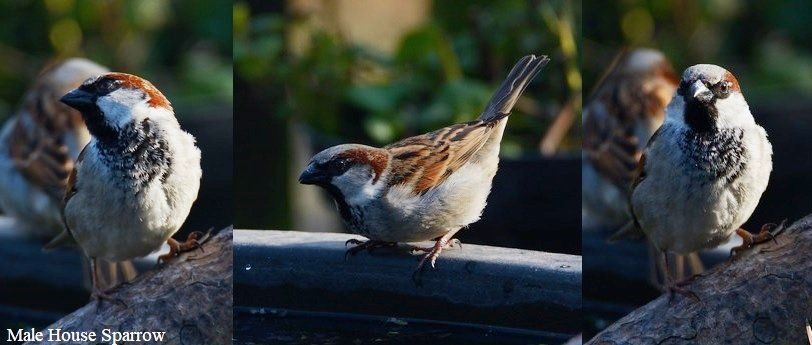
Wren appearance......
A Wren was good to see in the garden (19th), along with 2 Jackdaw, Blue Tit, 2 Blackbird, 2 Dunnock and 3 Wood Pigeon.

New Bees for 2022 in the garden......
Anthophora plumipes Hairy-footed Flower Bee made its first appearance in the garden (18th), as did Andrena nigroaenea Buffish Mining Bee, both visiting the Three-cornered Leek flowers.
A Rook was a slight surprise on the bird table and 2 Blue Tits were once again spending a good amount of time in the garden and Dunnock and a Wood Pigeon were also present.
Butterfly appearances building up......
The first Small Tortoiseshell was resting on the Winter Heather (17th).
Birds recorded were: 2 Blue Tit, Blackbird, 2 Dunnock, House Sparrow and Wood Pigeon.
More garden use from birds building nests......
A female was collecting nest material by digging into the soil and gathering compost (16th).
Brimstones and Greenfinches......
On a sunny Spring-like day, the first female Brimstone of the year (15th) briefly settled on the winter Heather, but was followed a short while later by a male Brimstone flying through the garden and the first queen Early Bumblebee Bombus pratorum visited a Three-cornered Leek flower.
In the 4 years I have been here, I can count on one hand (with plenty of digits to spare) the number of Greenfinches there have been, actually in the garden, so a female today gathering nesting material, by breaking off old Flowering Currant leaf stems was not only a very welcome sight, but great that this Finch was utilising the wildlife garden.
During the initial visit, I couldn’t get the camera quick enough to obtain images of the Greenfinch, but the female came back and collected more leaf stems and a Wood Pigeon’s breast feather and at the same time a male Greenfinch was also in the garden having a drink from the bird bath before showing interest in the Fennel. When the female flew off the male followed suggesting this was in fact a pair.
3 Dunnocks were once again in the garden together and there were also visits from Collared Dove, 2 Wood Pigeon, 2 Blackbird, Blue Tit and a Starling.
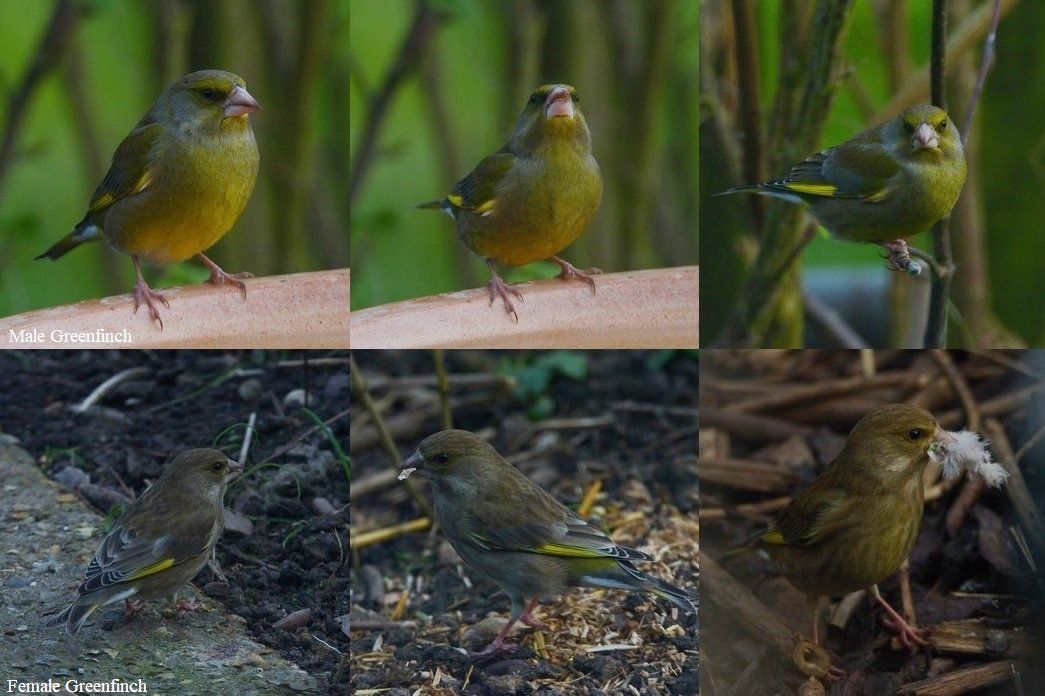
First Comma......
The first Comma (and indeed the first butterfly of 2022) flew through the garden today.
A Greenfinch was heard singing outside the garden, whilst in the garden were: 2 Starling, 4 Wood Pigeon, 2 Dunnock, Jackdaw, 2 Blue Tit, 4 House Sparrow and a Blackbird.
Birds today......
Birds in the garden today (13th) were: 2 Jackdaw, Blue Tit, Robin, 2 Wood Pigeon, 3 Blackbird, 2 House Sparrow, 2 Dunnock and 4 Starling.
Spring on its way?
It was nice to see 2 Great Tits in the garden today (7th), along with 2 Blue Tit, 3 Dunnock, 2 Wood Pigeon, Collared Dove, 4 House Sparrow and 3 Blackbird.
The Flowering Currant Ribes sanquiem is beginning to come into leaf, so it would seem that Spring is on its way, but probably not without fluctuations!
No sign of any Hedgehogs recently, as a new report comes in citing even more problems in their population for this native and iconic mammal.
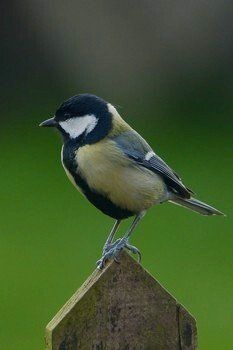
March (2nd-4th) Garden Activity......
3 Dunnock were in the garden together (4th), well known for their polygany and polyandry, so not surprising really! Other birds present were: Collared Dove (still collecting nest material), Jackdaw, House Sparrow, 2 Blue Tit (one bathing in pond), Robin and 4 Blackbird.
A Buff-tailed Bumblebee was once again visiting the Winter Heather as was a Honey Bee.
A Collared Dove was collecting pieces of vegetation for nest building (3rd). It was nice to see the garden able to facilitate wildlife once again; #Lazy Gardening.
At the start of the month (2nd) 3 Blackbird, 2 Wood Pigeon, 2 Blue Tit, Starling, 2 House Sparrow, 2 Dunnock and a Robin singing were all recorded.
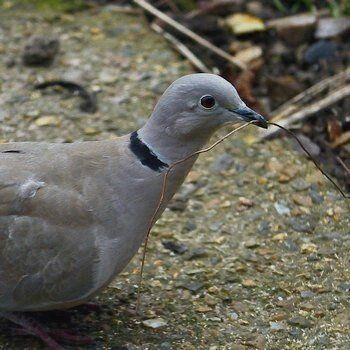
February 2022
Hope for the Garden Breeding Season......
The last day of February (28th) found quite a bit of activity in the garden, with a few unidentified insects around. Of those that were identifiable was a Common Wasp still alive in Bramble’s (Rabbit) water bowl, which was put outside to dry off and the welcome sight of a queen Buff-tailed Bumblebee feeding on the Winter Heather.
Significantly, with respect to possible breeding in the garden were 2 Robins present and also 2 Blue Tits, which spent a lot more time than normal in the garden and wing-fluttering was also seen. Both species were also using the bathing facilities!
A Goldfinch paid a fleeting visit (the first this year) and 4 Blackbird, Wood Pigeon, Dunnock, 4 House Sparrow, and good to see 2 Collared Doves (compared to the singles seen so far) were also seen.

Garden Nature Notes 19th-27th......
Two Dunnocks were both in the garden together (27th) and also seen were: 5 Blackbird, Wood Pigeon and 2 House Sparrow.
4 Blackbirds were once again in the garden (26th) attracted by the Pears and Apples put out purposely for them. Other species were: A Wren again (also heard singing), Blue Tit, Collared Dove, 2 Wood Pigeon, Dunnock and 2 House Sparrow.
The first Wren for some time was good to see searching for food amongst the dead vegetation (don’t be too hasty to tidy up!) (25th) and other avian visitors were: 2 Blue Tit, 4 Blackbird, 2 Wood Pigeon, Dunnock and 4 House Sparrow. It is interesting how the number of House Sparrows has decreased (at least those visiting the garden) from the small flock of around 10 individuals back in January. Why this is, is not certain, but could be linked to other activities like territoriality and nesting, which have become a preference.
Birds in the garden (23rd) were: Blue Tit, 4 Blackbird, Dunnock, House Sparrow, 2 Wood Pigeon and a Starling.
A Hedgehog came for food at 21.06 (19th) and also in the early morning at 04.48 and in the late evening 22.36 (20th).
Hedgehog sightings - first of 2022, thank you Winter Olympics!
The food put out for the Hedgehogs had well and truly disappeared by the morning of the 14th and one was seen again at 1.33 (15th), seemingly a larger hog than the one first seen on the 12th.
At 23.57 (13th) a Hedgehog came for cat biscuits, in between times doing a lot of scratching; amazing how they can reach the middle of their back with their hind feet! After a good drink the hog went towards the southern end of the garden, but a few minutes later were seen walking along the path to the north end.
Getting to sleep is a constant problem for me, so I decided to watch the Winter Olympics (12th). A decision to go and make a cup of tea in the kitchen, as it turned out was a good decision, as on looking out of the window (2.45), I saw something moving in the garden; the first Hedgehog of 2022. I quickly got a handful of cat biscuits and put them on the path and within 5 minutes, the said Hedgehog was having a good feed and it was seen again up until 3.00 when it was seen walking along the garden path.
First Bumblebee of 2022......
The first Bumblebee of the year was seen on two occasions in the garden (8th). It appeared to be a medium sized Bombus terrestris Buff-tailed queen, but I couldn’t be 100%. However, a welcome sight, although not too much for it to feed on apart from Three-cornered Leek flowers and a Winter Heather coming into flower.
Birds for the week.......
The first week of February saw the following birds visiting the garden: Collared Dove, Wood Pigeon, Robin, Dunnock, House Sparrow, Blue Tit and Blackbird.
January 2022
9 Species of Birds......
An assortment of birds in the garden (26th) with 2 Collared Dove, 2 Wood Pigeon, 4 Blackbird, 7 Starling, Blue Tit, Robin, 4 House Sparrow, Dunnock and 3 Jackdaw.
Robins and no territoriality......
Two Robins were in the garden at the same time (17th) without any territoriality displayed, so this hopefully bodes well for the Robins nesting in the garden again this year.
Also seen were Blue Tit, Dunnock, 3 Blackbird, Wood Pigeon, Collared Dove and at least 9 House Sparrow.

Return of the Redwing......
The Redwing returned (8th), but its stay was shortened by the constant harassment by the Blackbirds (6-7 present).
At least 12 House Sparrows were coming for food, as were Collared Dove, 3 Wood Pigeon, Dunnock and Blue Tit.
A sad day and requiem for my friend Lucy......
However, today was going to be a very fraught and mournful day, when I got the news that my little Rabbit Lucy (taken to the vets the previous day) was ‘shutting down’ and the kindest thing to do was to help her suffering, which along with Sally Clarke I agreed too.
The cause of her illness was an infection in her Pancreas; Pancreatitis and it would seem not much is known about this infection in Rabbits, except to say it can be fatal!
I guess, as I held her in my arms before her going to the vets with Sally, I knew she was not coming back. But like we do, I prepared for the worst and hoped for the best, but the latter was not to be and I lost one of my two best friends. The other, Brambles, Lucy’s partner I now need to care for, which I do with all my heart, although I know the absence of Lucy will never leave me and it is with great sadness I have had to say goodbye; you will be sorely missed my Lucy Blue.
New Bird for the Garden......
After a day out in the field (7th) with Jason Nichols I looked out of the kitchen window, on my return and to my amazement I saw a Redwing in the garden (right)!
This was a first for the garden and ironically Jason and I had been discussing garden sightings and I had stated that it was highly unlikely I would ever get either a Redwing or a Fieldfare in my small garden, due to their rather nervous nature, but here was a Redwing.
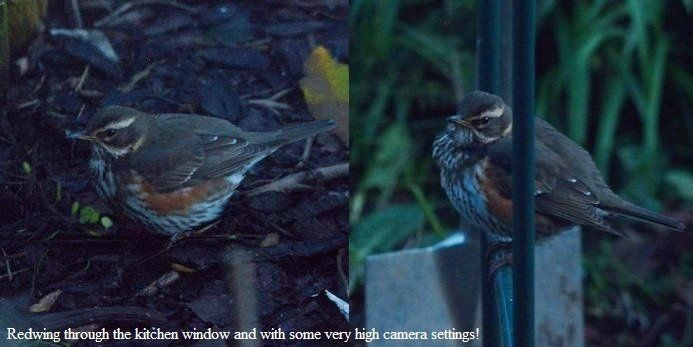
The Redwing turned over leaves and the bark on the path in its search for food and seemed to have a certain amount of success, although the territoriality of the resident male Blackbird was a constant ‘thorn in the Redwing’s side’.
In an effort to capture this first for the garden with the camera, some rather excessive camera settings had to be used, as the diminishing light was hardly a good time for photography! Still, this was a great new bird for the garden.
Better bird count and a Pug in the kitchen......
Far better productivity of birds in the garden today (4th) with 2 Starling, Blue Tit, Dunnock, 5 Blackbird, 2 House Sparrow, 3 Wood Pigeon, Great Tit and a Robin.
A Pug moth was found perched on the inside of the kitchen window. As I am far from an ‘expert’ when it comes to Pug moths I sent my finding to Ken Saul, who told me that:
It looked like a Double-striped Pug (right), although it was obviously very early in the year for any Pug and he wouldn’t expect to see this species until March. However, because it looked remarkably fresh Ken said that it had probably pupated indoors or the larva/pupa had been accidentally brought in and it has emerged early because of the ambient temperature.

As I have had the heating on for some time now at a fairly constant rate and I remember seeing several very small larvae climbing the kitchen walls, amongst other places in the dwelling last Summer, it would seem that what Ken hypothesized was what happened. Intriguing nonetheless; and thanks to Ken for his ongoing assistance with Moths.
Approximately 100 Pink-footed Geese flew over heading west in the afternoon.
A few more birds!
The garden was hardly full of life (3rd), despite the provision of food, but visits from a Collared Dove, Wood Pigeon, 2 Blackbird, 6+ House Sparrow and a Robin gave a slight indication that birds were returning to the garden.
Fireworks: Not a New Year's celebration for wildlife!
After being out all New Year’s Day seeing how many avian species Jason and I could see it wasn’t until the 2nd I could see what was in the garden.
Until just after midday the garden and indeed the surrounding area was virtually lifeless and only then did a single male Blackbird arrive to feed on the Pear halves put out, primarily for the Blackbirds.
At 14.20 a Wood Pigeon came to feed on seed on the bird table and at 14.20 a female Blackbird visited the garden, followed by two female Blackbirds present at 13.35. They was the only birds recorded for the whole of the day and it brought back memories of previous day’s avian abundance in the garden, after the now ‘traditional occurring’ fireworks of New Year’s Eve. The question arises that is the explosive sound of fireworks affecting our wildlife far more than is realised?!
Wildlife Garden Diary 2021
December 2021
Gardens: A responsibility and a reward for our indulgence......
It would seem a good time, coming to the end of 2021 to look back at what has been attracted to what is a very small garden (see The Inherited Garden) at Martham, Norfolk since its beginnings in February 2018. So, almost three years on what has the conversion of a patch of concrete, gravel and plastic amounted to?
It’s not like the surrounding area is wildlife conducive, with neighbouring gardens stifled with concrete and gravel and plants that have no use for our native wildlife, whilst the grass is cut so hard back by Great Yarmouth Borough Council it turns brown and is useless for wildlife.
The one hedge at the back of my property is also cut hard back, even during the nesting season! Whilst mostly Leylandii, one end has Brambles growing amongst other plants so is good for wildlife but frowned on by the local anti-neighbourhood wildlife brigade and indeed the council. The number of times I have contacted GYBC about their cutting regime and what they are doing for biodiversity and climate change has met with, at best: ‘Sorry you don’t like our cutting regime’!
However, as Sir David Attenborough said every place is important and on that basis I continue to provide as best as I can a refuge for wildlife and it has worked, despite the aforementioned!
Progress was slow initially but perseverance with hard work (initially, although don’t forget the ‘Lazy Gardener’ mantra) and with very little money to spend on plants the biodiversity increased continually.
Whilst 72 species of birds have been seen from the garden, 44 of these have been either in the garden or associated with it and nesting species have been Mallard, Blue Tit and Robin thus far.
6 Mammal species have been recorded, of which 4 have used the garden and I am especially proud of the Hedgehogs (a mammal in serious decline) that have visited the garden, not only for food put out for them, but also for habitat to hunt in and places (two Hedgehog boxes) to rest and sleep in. Oh how I would like to see hoglets in the garden!
Insects are vitally important and provisions were made from the start to provide for them with a place to feed at the least. 16 species of Butterfly (with two more outside the garden) have been recorded and highlights were a Swallowtail and a Grayling but they all count!
13 species of Dragonflies have been seen in the garden, which is quite something considering where the nearest suitable water habitat is and that I only have a small raised pond, but again every water body counts.
8 species of Bombus Bumblebees have been in the garden plus 20 species of Solitary Bees including a rare Dark Bee species in Norfolk Stelis phaeoptera and the awesome Wool Carder Bee, Stachys Lamb’s Ears a particularly good plant to have for this ‘hair’ collecting species. A very big thank you too Dr. Nick Owens for being my ‘Bee mentor’.
21 species of Hoverfly have been discovered in the garden with the Hornet Hoverfly Volucella zonaria, our biggest species included amongst them.
Lots of other invertebrate species have been included in the garden ‘list’ and hopefully more to come, but hopefully this shows you what you can do with your own ‘little patch’; create the habitat and wildlife will come.
Gardens are so important now, perhaps more now than ever for the Natural World on which we all depend. So I wish you all the success I can give for your own nature reserve and the delight it will give you if you let it. Closeness to nature is one of the best self-help courses for people suffering with mental health issues; I know this because I am one of those people.
Boxing Day Birds......
It was wonderful to see so many birds in the garden today (26th) coming for provisions put out for them and indeed bathing in the pond.
I never get tired of seeing Blackbirds and today there were 7 in the garden at once (5 females), even though that didn’t last long due to territoriality!
Also here in numbers were House Sparrows; at least 15 although there might have been more as there were Starlings, with at least 10 in the garden with more outside on the grass at the back of the garden.
Also seen were: Robin, 3 Wood Pigeon, Dunnock, Magpie, Collared Dove, 2 Blue Tit and 3 Jackdaw.
Return of the Hedgehog......
A Robin bathing in the pond (24th) was followed in the evening by a Hedgehog (the first visual for some time) coming for mealworms and cat biscuits at 22.05.
Visiting birds......
2 Great Tits were good to see today (16th) with Blue Tit, Robin, House Sparrow, 2 Wood Pigeon and 2 Blackbird also seen.
2 Blue Tits were in the garden (13th), along with Robin (right), 3 Blackbird, 3 Wood Pigeon, 10+ House Sparrow, Dunnock and 2 Jackdaw.
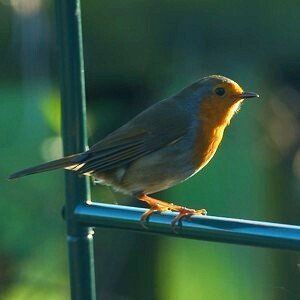
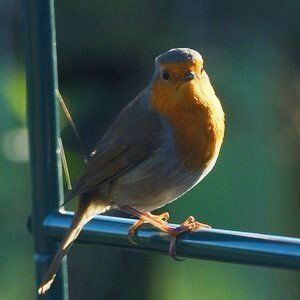
Three day bird list......
A small variety of birds (and indeed numbers) were visiting the garden (10th-12th). The highest totals over the three days were: 7 House Sparrow, 3 Blackbird, Blue Tit, Dunnock, Starling, Robin, 2 Wood Pigeon and a Collared Dove.
Birds at the beginning of December......
At the beginning of the last month of 2021 (2nd) saw several avian visitors to the garden, mainly for food, but also to bathe.
These were: Blue Tit, 3 Wood Pigeon, 10+ House Sparrow, 3 Blackbird, Robin and 5 Starling.
November 2021
Birds in the Garden......
Birds in the garden today (26th) featured: 2 Wood Pigeon, 10+ House Sparrow, 5 Starling and 4 Blackbird.
A flurry of avian activity......
A spot of avian biodiversity in the garden this morning (24th), which featured a Wren the first of the autumn and indeed not seen for some time.
Five different Blackbirds (2 F, 2 1st Winter and an adult M) were also present, along with Blue Tit, 2 Dunnock, 3 Wood Pigeon, 7 House Sparrow, Robin and a brief visit by 15+ hungry Starlings.
The BBC's Wild Gardener-a good watch......
It is also worth mentioning a new programme on BBC2 on a Friday at 20.00; The Wild Gardener. It features wildlife cameraman Colin Stafford-Johnson who prepares a piece of land from his childhood to be attractive to wildlife.
I watched the first programme tonight (19th) and it is very good, so if you missed it get it on BBC iPlayer.
I hope the programme will inspire people further into making their own gardens wildlife-friendly as I also hope this diary does in some way or another.
Avian visitors, plus Hog......
During the past few days (15th-18th) there have been a few avian visitors to the garden, although not in any great numbers. The highest number of any species visiting the garden has been at least 11 House Sparrows. Also seen were: Blue Tit, Dunnock, Robin, Blackbird, 2 Collared Dove, up to 3 Wood Pigeon and a Jackdaw. The 18th also saw a Hedgehog visit at 21.44 feeding on cat biscuits.
First Hedgehog for a while......
A Hedgehog paid a visit (15th) at 23.41, the first actual sighting for a while.
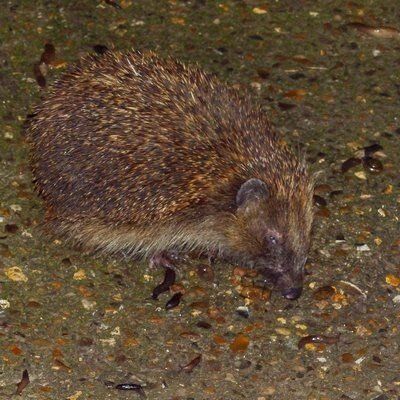
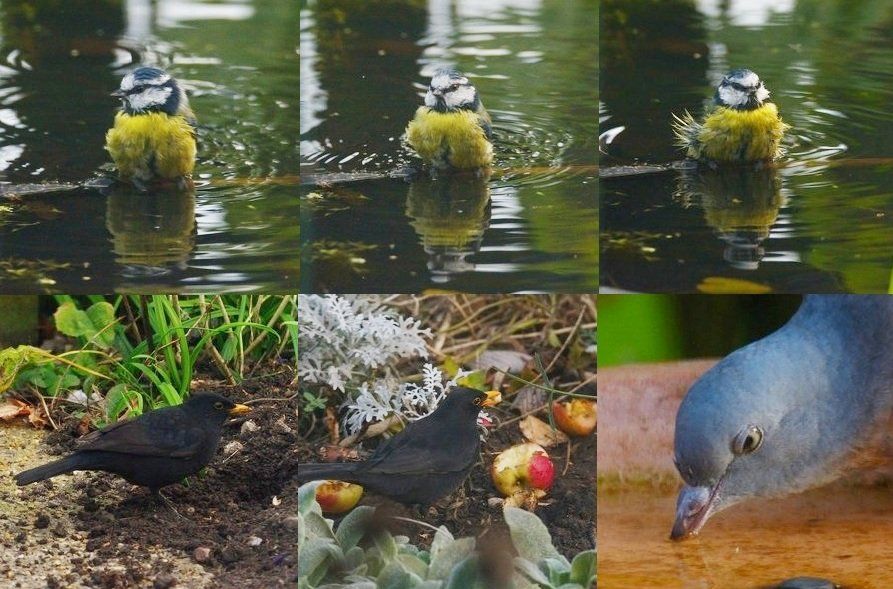
Collared Dove; first for a while......
Good to See a Collared Dove back in the garden (7th) after a considerable absence.
A Starling also ventured into the garden, along with 2 Wood Pigeon, 3 Blackbird (one making a mess of my path, but hey!), 7+ House Sparrow and a Blue Tit, which bathed in the pond.
Photos through the kitchen window above of Blue Tit, Blackbird and juvenile Wood Pigeon.
Fireworks/bonfire night what is it good for: Absolutely Nothing!
4 Blackbirds were in the garden (5th) coming for Cotoneaster berries and apples (see above photo) put out for them.
Also seen were: 6+ House Sparrow, Dunnock, Wood Pigeon and a Robin coming for a bathe it the late afternoon, as they often do.
I do wish the government would ban fireworks and bonfire night, it is an out of date ‘tradition’ and detrimental to our wildlife and in so-called ‘Climate Week’ definitely not helping!
A few November Birds......
A few birds came to feed and bathe in the garden (2nd) and these were: Blue Tit, 3 Wood Pigeon (including juvenile), Magpie (coming to clear up uneaten Hedgehog food), male Blackbird, 4 House Sparrow and a Dunnock.
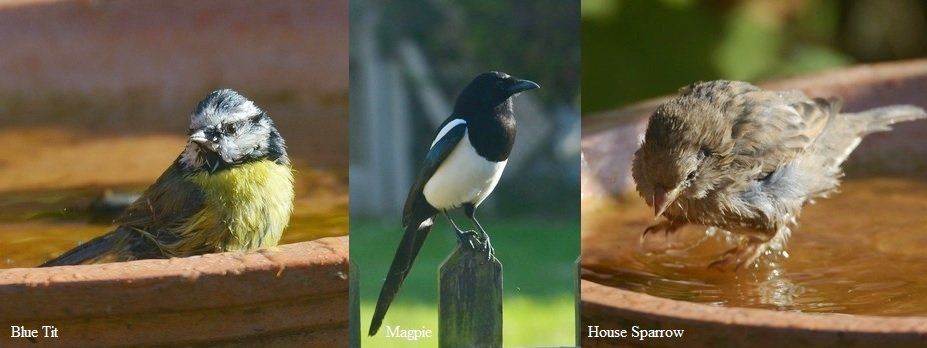
October 2021
A taste for Rose hips......
A juvenile Wood Pigeon was feeding on the Rose hips (30th). I have not seen any of the adults feeding on the hips in the garden and this may well be due to hierarchal dominance over the seed on the bird table.

Bird notes......
Birds visiting the garden (29th) included: Dunnock, 10+ House Sparrow, 2 Wood Pigeon, male and female Blackbird and a Magpie picking up the remains of the Hedgehog food.
Hedgehog Sightings......
A Hedgehog was present at 2054 (23rd), 21.16 (24th) and at 21.00 (27th).
Birds, bumbles and hog......
At least 12 House Sparrows were in the garden (22nd) along with a Dunnock and a female Blackbird and one or two Carder Bumblebees are still visiting the garden’s Verbena flowers.
A Hedgehog was again visiting the garden for food at 22.02.
Bees still present......
At least 12 House Sparrows were in the garden (22nd) along with a Dunnock and a female Blackbird and one or two Carder Bumblebees are still visiting the garden’s Verbena flowers.
A Hedgehog was again visiting the garden for food at 22.02.
Hedgehogs, Pink-feet and Darter......
A Hedgehog was present (21st) at 20.48.
A Hedgehog paid a visit for food (20th) at 22.35.
At least 300 Pink-footed Geese flew over heading south (18th).
A Hedgehog was present (15th) at 20.10.
A late Common Darter was in the garden (15th).
Hedgehog evening sightings (14th) were at 19.47, 20.45 and at 21.32.
Watching Birds in the Garden; 'Still crazy after all these years'!
I have always loved seeing wildlife utilise what I have provided for them, whether it be habitat, water or food, or indeed all of the aforementioned and today (8th) was no different.
I have never lost my enthusiasm for watching birds in the garden and the 10+ House Sparrow, 3 Blackbird, Blue Tit, Magpie (clearing up the cat biscuits put out for the Hedgehogs), 3 Wood Pigeon and 2 Robin, one in pursuit of the other were no exception, whilst observing through the kitchen window.
Hedgehogs from start to finish......
The day began and ended with Hedgehog sightings (7th) with a ‘small’ Hedgehog seen at 6.00 and after a day out ‘in the field’ in North Norfolk further records of Hedgehogs were at: 21.05, 21.16, two at 21.18 and singles at 21.34, 21.44, 22.02, 23.12 and finally (at least for my observations) at 23.19.
Garden sightings 1st-5th......
A Hedgehog was recorded at 22.32 (5th).
A worn Common Darter was in the garden (4th).
A Hedgehog at 20.33 got the month (1st) off to a good start and this was followed by only the third record (since moving here) of a Tawny Owl calling somewhere to the S.W.
September 2021
Interference with Hedgehogs continues......
A ‘medium’ and ‘small’ Hedgehog were feeding together at 21.28 (26th) but unfortunately, yet again both had been marked with the larger hog’s spines almost completely covered. I wish the individuals doing this would stop for the reasons already mentioned (12th).
Flittermouse......
A Pipistrelle species was seen at 19.15 (24th) over the back garden, followed by a ‘small’ Hedgehog feeding on cat biscuits at 20.35 and then two hogs feeding together at 21. 36.
Later a ‘large-medium hog was present at 22.56 and a ‘large’ hog at 23.20.
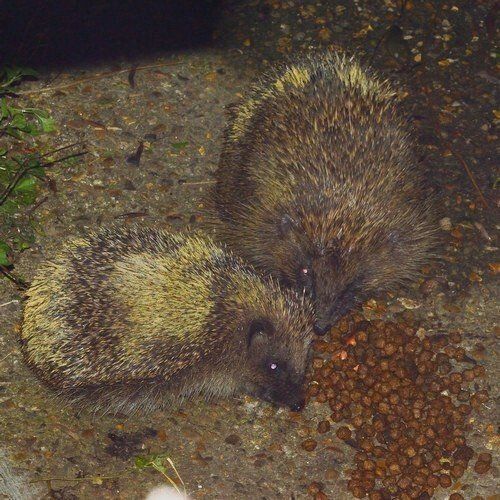
Hedgehog sightings and a few insects too......
A Painted Lady was on the Buddleia flowers (21st) (small amount produced by cutting the shrub back) and 2 Large Whites were also seen.
2 Small White, Red Admiral and a male Migrant Hawker was in the garden (15th) and there was a visit from the ‘small’ Hedgehog at 21.44.
Hedgehog sightings (14th) were at 20.00, 20.55 and again at 22.12. All sightings relate to the same small individual.
Hedgehogs sighting continued (13th) with a ‘small’ hog visiting at 19.55, 20.21 and 21.10, followed by a ‘large’ individual at 21.42.
Two different Hedgehogs visited the garden for food (12th) with a ‘small’ individual at 20.02, 20.36 and again at 23.25. A ‘large’ hog was present at 21.36 and again at 22.51.
As on the 9th, all the Hedgehogs had pale patches on their spines. After an exchange of emails with The Hedgehog Preservation Society it would appear that someone is marking the animals and making a right mess of it too! There are other ways of identifying Hedgehogs without disrupting their daily routines, without causing stress and without affecting mate recognition.
See the article on Hedgehog Street, which is very helpful:
https://www.hedgehogstreet.org/forums/topic/identifying-hedgehogs-from-their-natural-markings/
Please do not artificially mark Hedgehogs; they are suffering enough, without the involvement of ‘pseudo scientists’ disturbing them for their own entertainment. Sure, it is nice to know how many hogs are visiting your garden, but the animal comes first and it doesn’t if they are being caught or have to roll up in a ball for defence.
A ‘small' Hedgehog was present at 22.12 (11th).
Migrant fly-around......
A male Migrant Hawker flew around the garden for a while (9th) and a queen Tree Bumblebee was present.
Butterflies seen were: Small White, 2 Large White, Red Admiral and a Painted Lady.
Three Hedgehog evening......
Hedgehog sightings (8th) were a ‘large hog at 21.45 and again at 21.58, followed by a ‘small’ individual at 22.20 and a ‘medium sized hedgehog at 23.22.
Food was put out twice tonight and on all three hedgehogs were pale areas to the spines, especially on the largest individual.
Insects and 'small' hog......
Two Darters were present (7th), but with insufficient views they couldn’t be identified to species level.
Butterflies were: Painted Lady, 2 Red Admiral and 3 Small Tortoiseshell and a Volucella zonaria alighted briefly on a Verbena flower.
A ‘small’ Hedgehog came to cat biscuits and peanuts at 22.15.
Addition to a North Walsham Garden; a Wasp Spider!
Although the Wildlife Garden Diary is centred around my own garden at Martham, Norfolk, I like to highlight other people's efforts (e.g. Composting for Slowworms) to make their gardens 'wildlife friendly', which in the midst of a serious climate crisis is much needed.
Another point in case is my friend Roy Andrew's garden in North Walsham. I know Roy has many native plants growing, which includes Ragwort, which support a healthy population of Cinnabar caterpillars amongst many other species catered for by the inclusion of native plants.
Recently Roy found that another inhabitant had moved in; a female Wasp Spider. Now this species requires undisturbed grassland and Grasshoppers etc to eat (see: Wasp Spider in the Wildlife Articles menu), so based on that, the habitat created by Roy passes with flying colours!
Below are images of the female Wasp Spider taken by Roy.
Vapourer larvae a 1st for the garden......
A Green-veined White was once again in the garden (6th), as were 4 Red Admiral, 2 Small Tortoiseshell, 2 Large White and a Painted Lady (not seen for a while).
A Common Darter perched on the linen line and 2 Vapourer Moth larvae were found on the Buddleia and Hawthorn leaves, a first for the garden.
Not 'rare' but uncommon in the garden......
A Green-veined White visited the Verbena flowers (5th), a rather uncommon event in the garden! 2 Large White, 2 Red Admiral and 3 Small Tortoiseshells were also present.
Coneflowers a hit with the Butterflies......
The Coneflowers continue to be the favoured flower by visiting butterflies (4th). Three each of Red Admiral and Small Tortoiseshell were present with Large White outside the garden.
August 2021
Hedgehog, sighting at last......
A Hedgehog was seen in the early morning (1.10) at the garden gate (29th) and food was put out and had gone later in the morning.
Gatekeeper, 2 Small Tortoiseshell and Red Admiral were present.
Brimstone......
Good to see a lovely male Brimstone flying around the garden (24th). Other butterflies saw an upsurge in Small Tortoiseshells with 8 (maximum count), Red Admiral, Small and Large Whites, 3 Peacock, Gatekeeper and a possible fly-by Comma.
A Volucella inanis (Hoverfly Hornet mimic) was also present.
Holly Blue and other butterflies......
Holly Blue, Gatekeeper, Red Admiral, Peacock and Small Tortoiseshell were all recorded (23rd), with at least 2 Painted Ladies outside the garden.
Another 'Bug in the bathroom'......
Another ‘bug in the bathroom’ (22nd) when a female Speckled Bush Cricket was found in the bathroom sink! Only the second record for this species of Cricket for the garden, which was taken outside, photographed and left to resume its business.
Another fascinating animal, this time a Hoverfly was on the Fennel flower-heads; a Syritta pipiens. Only a small fly but the thickened rear leg is hard to miss.
Another Hoverfly, a Myathropa florea aka Batman Hoverfly with its bat-like symbol on its thorax was also on the Fennel and a Volucella species (Hornet mimic) was not seen clearly to ascertain identity, but likely to be a V. Inanis.
Butterflies recorded were: Gatekeeper, Red Admiral, Peacock, 3 Small Tortoiseshell, and a Large White.
Insects in the Garden 19th-21st......
A Painted Lady was amongst the assortment of butterflies (21st), which also included 3 Red Admiral, 2 Small Tortoiseshell, Peacock and 2 Large White.
A Ruddy Darter and a Migrant Hawker were both seen (20th) and butterflies present were: Holly Blue, Gatekeeper, 2 Peacock, 3 Red Admiral, Small Tortoiseshell, 2 Large White and 2 Small White.
A Red-tailed Bumblebee was present today (19th) and also a Migrant Hawker.
Butterflies seen were: 3 Red Admiral, Peacock, 2 Small Tortoiseshell, 2 Meadow Brown and 2 Large White.
A Bug in the Bathroom!
Another first for the garden (15th), although found in the bathroom originally; a Pentatoma rufipes Red-legged Shieldbug (right), which was photographed outside before it took off.
A Migrant Hawker was once again in the garden and butterflies seen were: Small Tortoiseshell, Red Admiral, and Large and Small Whites; the Red Admirals and the Small Tortoiseshell being attracted to the Red Coneflowers.
New Damselfly for garden......
A first for the garden today (14th); a female Willow Emerald (right) was seen perched on a thistle stem. 3 Red Admiral, 3 Large White and a Gatekeeper were also seen.
Diary notes 9th-13th......
At least 12 House Martins were in the skies (13th) and Red Admiral, Peacock and a Painted Lady were in the garden.
The first Comma of the year was seen on a Red Coneflower (11th) and 3 Gatekeeper, Meadow Brown, 3 Red Admiral, 2 Peacock, Painted Lady, Small Tortoiseshell, Large and Small Whites made for a nice selection of butterflies.
Butterflies in the garden today (10th) were: 3 Red Admiral, 2 Peacock, Gatekeeper, Painted Lady, 2 Small and 2 Large Whites.
A Painted Lady, 3 Red Admiral and 2 Large White were present (9th).
Composting for Slowworms! Really? Yes indeed!
Slowworms, like most of the UK's herpetology (Amphibians, Snakes and Lizards) are becoming scarcer and scarcer, so its always nice to hear a story like this one from Jason Nichols and his population of Slowworms in his suburban garden in Gorleston, Norfolk.
The following video is taken by Jason and the photo is one I took 14-8-2014 and the words are also from Jason, entitled 'Lifting the lid on Wildlife':
'When we moved in 20 years ago the neighbour said he saw the odd slowworm so I got one compost bin almost immediately in the back garden. I saw the odd one in there but no more than singles occasionally.
Once the kids got a bit older, about 10-years ago I got two more compost bins (where they are currently) and placed them in a south facing direction and started seeing Slowworms more often and in more than just single numbers.
Now, sightings are almost daily during the warmer months, mostly in the bins but occasionally out in the garden, which are surrounded by long vegetation.
We top up 2-4 times a week with mostly kitchen waste; including vegetables, fruits, boiled-egg shells, odd bits of garden waste and also dry leaves or shredded paper (if no leaves), when it looks too wet or soggy. We never take any compost out and leave gaps at the bottom of the bin for anything to go in or out of.
I only emptied the bins once in their history when I was looking for and found a King Snake in one of them!'
Diary Notes 2nd-6th......
A Meadow Brown, 3 Red Admiral, Peacock and Large White were present (6th) and a Swift and 4 House Martins were in the skies.
A Meadow Brown and a Holly Blue were two additional species in the garden (4th) and a Volucella inanis Hoverfly was present (5th).
Butterflies in the garden (3rd) were very much the same as 2nd. However, a Migrant Hawker was also seen and both a Silver Y and a Wainscot sp. came to light.
A Painted Lady was once again on the Buddleia (2nd), with 2 Red Admiral, 3 Peacock, Gatekeeper, 3 Large and 2 Small Whites also present.
July 2021
First Migrant Hawker and Butterfly sightings......
Butterflies continued to be seen with 2 Red Admiral, 2 Peacock, 2 Large White and a Small White.
A Migrant Hawker was present again (29th) and Red Admiral, Peacock, Large and Small White also present.
The first Migrant Hawker of 2021 was seen (28th), whilst 2 Large White, Small White, 2 Red Admiral and a Gatekeeper were the butterflies seen.
2 Peacock, 2 Red Admiral, Large White and a Blue sp. were in the garden (26th) along with an unidentified Aeshna sp. possibly a Norfolk Hawker.
4 Swift were still in the skies.
First for the year and first for the garden......
The first Ringlet of 2021 was seen flying around the garden (25th). Butterflies also present were: 2 Red Admiral, Small Tortoiseshell, Gatekeeper, 2 Large White and a Small White.
A first for the garden (although suspected individuals not identified have been seen in the past) was both a male and a female/immature Ruddy Darter, whilst what looked like a Brown Hawker flew over the garden.
Along with the flowers of Fennel, Geum, Achillea, Verbena, Honeysuckle, Buddleia davidii and Geraniums, amongst others it was nice to see two Water Lily flowers, out on the pond.
Butterfly diversity up, numbers not!
5 species of Butterflies today (22nd): Red Admiral, Painted Lady, Small Tortoiseshell, Large White and Small White, but mainly in single numbers. A Silver Y was also in the garden, while a Brown Hawker was over the grass outside the garden.
Hoverflies included: Eristalis tenax Common Drone-fly and Episyrphus balteatus Marmalade Hoverfly.
2nd darter of the year......
A female Common Darter was near the pond (20th).
Diary Notes 14th-18th......
A teneral Brown Hawker was seen flying over the grass at the back of the garden (18th).
Large White, Red Admiral and the first Peacock for this time of the year were also present, albeit one of each! The Buddleia davidii is full of flowers but despite the warm spell very little attention has been paid to it by butterflies.
The first Gatekeeper of the year was in the garden (17th) and a Meadow Brown and a Red Admiral were also seen.
A juvenile Magpie (right) paid a visit to the bird bath (14th)
Robin still utilising the garden......
A Red Admiral was in the garden (2nd) and a Robin was also there collecting food for its dispersed Young.
June 2021
Hold back the Borage dead-heading!
The last day of June (30th) saw only the 2nd record of a Greenfinch, actually in the garden.
Just as I was having thoughts about cutting back some of the Borage, out of the kitchen window, I saw a male Greenfinch feeding on un-ripened Borage seeds by stripping the vegetation covering them.
Seeds for seed-eating birds are still relatively scarce at this time of year and it just shows that leaving behind ‘traditional gardening methods’ we can help these birds. I have never seen this before, so a special observation!
You just never know what you will find on your fence gate!
Not quite in my garden (29th) but next door, where Annie McCabe found a pair of Privet Hawkmoths in mating position on the outside of her garden gate.
A wonderful find; and takes me back to when I found a larva of this species in my Nan’s Privet hedge on my 7th birthday.
Also found in Annie's garden (22nd) were two-three female Osmia leaiana Orange-vented Mason Bees on some Daisy-type flowers. It just shows what you can attract into a garden by putting the right plants in. Also, with both our gardens planted with wildlife in mind the area for wildlife has doubled!
2nd brood Robins completed......
The adult Robins were seen around the garden and out of it carrying food (25th) but no food was taken to nestbox, so as expected at this time, the young have fledged. Like the first brood, there have been no sightings of the fledglings’.
Hummingbird hawk revisits the Valerian......
A Hummingbird Hawkmoth was once again visiting the Red Valerian (24th) before being chased off by a Bumblebee!
A Red Admiral, Small Tortoiseshell, Painted Lady were once again on the B. globosa and the first Meadow Brown of the year was in the garden.
First Small Tortoiseshell......
3 Red Admirals were on the Buddleia globosa along with the first Small Tortoiseshell and another Painted Lady (23rd).
1st Painted Lady and Robins bring in a well camouflaged prey item......
The first Painted Lady of the year (22nd) was attracted to the Buddleia globosa, as was a Red Admiral and a Peacock was also seen briefly.
The Robins were still bringing in prey for the nestlings and on one occasion this included a Large Yellow Underwing (thanks to Ken Saul for confirming the ID).
Underwing moths are incredibly well camouflaged at rest, so it makes you wonder how birds such as the Robins are sourcing this food! However, I have seen Spotted Flycatchers hunting and amongst several hunting techniques; they fly into foliage, thus disturbing any potential prey hidden and in the case of Underwings revealing the bright colours otherwise hidden and therefore are able to see and capture the prey.
Similarly, other birds tend to do this (e.g. Warblers) too and I have seen Robins adopting a similar method by hovering close in to vegetation and going in when a potential meal reveals its presence by moving.
Red and Silver 1st for the year......
A Red Admiral (15th) was the first of the year in the garden as was a Silver Y.
Buddleia globosa a great attraction to Bees......
A juvenile Great Tit came into the garden (14th) and a Blue Tit was having a bath. 3 Small Purple and Gold and an Osmia leaiana Orange-vented Mason Bee on Red Valerian, were the first of the year and a queen Red-tailed Bumblebee and Holly Blue were also seen.
A new Bee for the garden was thought to be (by Dr. Nick Owens) a Nomada panzeri Panzer’s Nomad Bee on the Buddleia globosa. The B. globosa (raised from cuttings in 2019) is attracting many bees and insects. I have never seen so many Tree Bumblebees in one place before and there is good numbers of Early Bumblebees predominantly males.
The propagation of this shrub was inspired by my Nan Ida Drewery, who taught me much about gardening, probably without meaning too and the visions of one of these bushes in Nan’s garden, when I was a small boy, covered in bees. Obviously
B. globosa is a massive draw for pollinating insects especially
Bombus
species!
A Holly Blue continued to be the most sighted butterfly in the garden this year (13th) and a Tree Bumblebee was also present.
The garden is now packed to the boundaries with plants, with a range of flowers. Amongst the insect attracting plants are: Red Valerian, Geum, Foxglove, Chives and Borage with more coming through (North-side of the garden see above).
Since its humble beginnings; after clearing plastic, paving slabs and shingle when I first moved in (See: 'The Inherited Garden') this small cottage-style garden has now become a haven for wildlife, with native plants grown alongside cultivated plants and even vegetables such as Broad Beans sown in the borders.
It now has two 'Bee Hotels and two Hedgehog boxes, 4 places for wildlife to drink and bathe (including a raised pond on the inherited lump of concrete), two open-front, two small hole and a communal House Sparrow nestbox and of course a bird table.
The only trouble is, apart from my neighbour Annie the area is devoid of many wildlife habitats e.g. neighbouring properties and council owned land, which is cut to an inch of its life; actually shorter than that until its the council's favourite colour, brown!
I dare say there are many other people who are surrounded by unfriendly areas (and people) for nature, but if you are someone who does make provisions to live in harmony with other forms of life on this planet, you should be very proud!
There is one basic rule applied in the garden; if it doesn't benefit wildlife it is out!
Garden Diary entries 7th-11th......
The Robin’s eggs have hatched (11th)! The Robins are now taking small insect prey to their nest.
A female Orange-tip was in the garden (10th).
A Grey Squirrel ‘strolled’ past the garden gate (7th), only the second I have seen here from the garden.
Both the Robins are present in the garden, away from the nest, but at present they have not been seen carrying food.
At least 2 adult male Azure Damselflies were present and later a pair was seen in tandem, although no ovipositing was witnessed. Perhaps they did it when I wasn’t looking! A Holly Blue and a Small White were also seen.
First 4-spot, return of the Hedgehog and a Common Swift in the bedroom......
A teneral Four-spotted Chaser (right) I saw out of the window (5th) as it landed on the far from successful White Willow plants was the first Anisoptera dragonfly of the year.
Later, after putting out some cat biscuits, a Hedgehog came for the food at 22.02 and a Common Swift moth Korscheltellus lupulina came in through the open kitchen window into the bedroom.
Wood Pigeon communal bathing......
A glance out of the kitchen window (2nd) saw three Wood Pigeons all in the pond, perched along a branch I had put over the pond, having a wash and preen.
As most people know, the spring with its variable temperatures and rain, sleet and hail showers have not been good for insects and those animals that feed on them. So it was good to see a Holly Blue in the garden along with a brief visit from a Small White and a male Orange-tip outside the garden, albeit in single numbers!
Although there is a wide variety of flowers in the garden currently, with Borage flowers seemingly the favourite amongst worker Bumblebees, the number of insects appears very low and maybe this is why I have not seen any feeding visits from the Blue Tits nesting in the nestbox, in fact at this point in time, I don’t know what the outcome of that nest is!
However, the Robins on their second brood in the same nestbox are still present. Singing from the garden fence I took the Robin as a sign to me that what I do to provide a home and protect animals is not all in vain!
Teneral Azure Damselflies continue to emerge from the pond and I counted at least 30 exuvia (the larval case left after metamorphous) on the Soft Reed.
May 2021
First Orange-tip......
A male Orange-tip was in the garden (28th) followed by a Holly Blue there (29th).
First Dragonfly breeding in the garden pond......
Three Azure Damselflies took their maiden flight from the pond (27th). This is the first breeding record for dragonflies in the garden, where there was also a Red Mason Bee.
A difficult Spring!
Two Red Mason Bees were good to see (24th) visiting the Borage flowers, after a very poor spring for bees in the garden and other insects.
An Early Bumblebee was also visiting the Borage (one of those must have garden plants), but this spring with its plenteous rainfall, sleet, hail and fluctuating temperatures has been far from a ‘usual’ one by any means. Anyone who doubts climate change requires some additional brain cells!
The return of the Robins!
After a very short break, Robins had returned to their original nest in the open-front nestbox in the Honeysuckle and were topping the nest up with compost again (22nd), ready to lay eggs again!
Bathing Dunnock and Robin with food......
I finally got round to editing some photos from the 10th May, so although this is a bit out of sync with the May diary entries I have included them at this juncture.
The first are of a Dunnock having a bath; a species I cannot remember photographing having a bath before and the second (images without the kitchen window being between the camera and the subject) are of one of the Robins bringing in food for the nestbox nestlings.
Do excuse the second Robin image if you are of a nervous disposition and remember shadows can lie!
Orange-tip fly-past and compost a hit with the birds!
A Holly Blue was in the garden (18th) and the first male Orange-tip in the area passed over the grass outside the garden. Obviously (and not surprisingly), it found nothing to its liking!
After being fairly convinced that I heard juvenile Starling’s harsh calls for food from their parents 3 days ago, today I actually saw 2 juveniles with their parents. Meanwhile, an adult Starling was collecting nest material from one of the large pots containing homemade compost. Obviously, the compost is a hit with the birds, with the Robins constructing the majority of their nest with the compost; just hope it’s a hit with the plants!
Robin young fledged, but to what avail?
With no sign of any incoming feeds from the Robin pair feeding nestlings (17th), it would appear that the young have fledged.
Whilst I have neglected to do anything in the corner of the garden, whilst they were nested they are now on their own. Unfortunately they will not be on their own! There are enough natural predators around to prey on them as it is.
Unnatural Predators, Irresponsibility and the Council......
However, nowadays there are numerous domestic cats, people getting rid of their human kitchen waste by attracting large Gulls and Crows into gardens and people in general with no concern for the environment, who ‘plant’ their gardens with concrete, plastic and shingle to put unfathomable pressure on our songbirds.
Meanwhile, in my area, Great Yarmouth Borough Council continue to practice their destruction of potential habitat for wildflowers and pollinating insects’ ‘policy’ and have mown the expanses of grass in each of the last two weeks. Despite my email to them asking them why they do this, what they are doing to promote biodiversity and why they are still poisoning my environment with weed killers (when they decided in 2018 not to put weed killer on natural areas!)? The email has still had no response to my questions and is coming up to two weeks since I sent it!
The areas of grass where I live are not managed as lawns or as a meadow. In fact they do not fit any criteria except to make these areas ecologically unproductive, when they could be so much more benefiting to wildlife and indeed climate change. The council’s ‘lazy management’ of spraying the grass edges of paths and around tree roots is at least disgusting to look at. I wonder if people realise what they are paying their council for or if they even care.
I recently saw a Tweet by Iolo Williams stating that:
‘Lots of councils needlessly cutting flower-rich verges and green spaces at the moment. Please stop! You are killing tens of thousands of flowers, food for pollinators. This includes you, @PowysCC and @CyngorGwynedd.’
At the moment Iola has received 2.674 likes, 82 Quote Tweets and 715 retweets, whilst when I retweeted this Tweet adding: ‘This includes you too, at Great Yarmouth Borough Council! @greatyarmouthbc @GYMercury’ I received only 2 likes and 2 retweets!
Yes, Mr Williams has far more popularity than I, but you would think that more would have supported this. However, I have seen other individuals pointing out, the various council’s destruction of land on Twitter and they too have had no support via likes or better still retweets. Until all of us who care about our environment speak out together (e.g. email their councils) and support each other, councils will ignore what is happening to our world and do nothing to change it, when clearly they could make a hell of a difference and save money in the process!
Ragwort on the finch menu, again......
A Goldfinch was once again feeding on Scenecio (ornamental Ragwort) leaves (13th).
Firsts for May......
A Red Admiral was in next door’s garden (11th) and the first Swift (19.20) and House Martin (19.28) were in the skies, with 2 of each being present later in the evening.
Single Butterfly visits......
A Peacock was in the garden (9th) with a Large White there (10th).
Hatched!
The Robins, nesting in the open-front nestbox in the Honeysuckle are now bringing in food (right), obviously the eggs have hatched!
Blackcap song at distance......
A Blackcap was heard singing (2nd) from somewhere to the east and a female Sparrowhawk flew over.
White-tailed and Carder Bumblebees were in the garden, along with a female Hairy-footed Flower Bee.
Blue beginning......
The month began (1st) with a Holly Blue in the garden.
April 2021
Large White......
The first Large White was seen today (30th) as it flew through the garden.
New species from the garden......
A Gadwall flying over, heading NW was worthy of note (28th), as it was a new species seen from the garden.
Good selection of birds......
A ‘small white’ butterfly was outside the garden, possibly a Green-veined White (27th).
A good selection of birds in the garden today were; Great Tit, Blue Tit, 2 Robin, 2 House Sparrow, Jackdaw, 4 Wood Pigeon, Dunnock, Blackbird and Starling.
New record for garden woodies......
A female Tawny Mining Bee was seen again on the Flowering Currant (26th), as were Hairy-footed Flower Bee and White-tailed Bumblebee.
5 Wood Pigeons in the garden at once was a new record.
First Red-tailed appears......
The first queen Bombus lapidarius Red-tailed Bumblebee was in the garden (25th) as were White-tailed and Carder Bumblebees.
2 Great Tits were once again in the garden and the Robin nesting in the open-front nestbox in the Honeysuckle was sitting tight, despite me being a short distance away planting seeds; as quick as I could!
Goldfinches again......
2 Goldfinch were once again present in the garden (24th), which lately is becoming a regular occurrence.
Goldfinch dietary requirements; a new one on me!
The first Holly Blue of 2021 was in the garden (23rd) on the Flowering Currant flowers and another first of the year was a Bombylius major Dark-edged Bee-fly visiting (as usual) the Grape Hyacinths.
A Peacock also passed through the garden and Tawny and Buffish Mining Bees, Hairy-footed Flower Bee and Tree Bumblebee were also present.
2 Goldfinch were consuming
Senecio leaves and pieces of Fuchsia, which I have not seen them, do before and 2 Great Tits and a Blue Tit were also searching for food. Overhead; a Sparrowhawk and 2 Common Buzzards were seen.
Calling Oystercatchers......
2 Oystercatchers flew over calling (21st) and a Common Buzzard was also seen.
A female Hairy-footed Flower Bee was in the garden visiting Three-cornered Leek flowers.
Flowering Currant; once again a hit with the bees......
A female Tawny Mining Bee, 3 Tree and a single Early Bumblebee were visiting the Flowering Currant flowers (19th). Buffish Mining Bees continue their presence with several constantly in the garden.
A Blue Tit was taking white feathers to one of the shed wall nestboxes and 4 Wood Pigeons, 2 Dunnock, Collared Dove, Robin, 2 Blackbird and several House Sparrows also visited the garden.
Finally, the Tawny obliges the camera!
A female Tawny Mining Bee was seen again on the Flowering Currant flowers (16th) and this time it was a bit more obliging for the camera.
The following day (17th) the first definite
Bombus lucorum White-tailed Bumblebee was in the garden.
Tawny Mining Bee and Carder Bumble; first for the year......
A female Andrena fulva Tawny Mining Bee was visiting the Flowering Currant flowers (13th) and a Bombus pascuorum Carder Bumblebee was also the first of 2021.
Buff-tailed Bumblebee and Buffish Mining Bees were also in the garden and as said here before; Flowering Currant is a must for the wildlife garden, supplying an early source of food, particularly for eusocial and solitary bees.
A Butterfly emergence from the garden.......
The first Small White was in the garden (11th). Judging by the folds in the wings, it had recently emerged and it seems very likely it emerged in the garden; further evidence that the garden is being managed in the right way.
A female Buffish Mining Bee Andrena nigroaenea was resting on the table outside the kitchen window (hence the rear-view photos!) and once again both Tree and Buff-tailed Bumblebees were on the Flowering Currant.
Nest material collections in the garden......
Nesting activity in the garden today (10th), with a Robin gathering nest material, mainly from the pile of compost emptied out the previous day and taking it to the nestbox in the Honeysuckle, where it built a nest in 2020 but did not lay eggs in it. A Great Tit was also finding the heap interesting too.
A Blue Tit was carrying hair, perched on the linen line and appeared to head for one of the nestboxes on the side of the brick shed, whilst a Starling was picking up dry vegetation from the borders and flying off with it to the N. E.
The benefits and rewards of not being too tidy in the garden were proven once again! Images taken through the glass, as usual, so not as good as I would like but necessary to record the wildlife without disturbing it.
A Tree and 2 Buff-tailed Bumblebees were visiting the Flowering Currant flowers.
Hedgehog......
A Hedgehog paid a visit to the garden (6th) at 22.56.
First Tree bumble and Swallow......
The first Bombus hypnorum Tree Bumblebee was on the Flowering Currant flowers (4th). Both Early and Buff-tailed Bumblebees were also seen.
Another first for 2021 was a Swallow flying northwards, during the late afternoon/early evening and a male Greenfinch in song flight was good to see too.
Early bumble......
The first Bombus pratorum Early Bumblebee was seen on the Flowering Currant flowers (3rd).
3 Wood Pigeon, Collared Dove, 2 Dunnock, 6 House Sparrow, Starling and 3 Mallard (Lucy 2-2 and 2 drakes) were also garden visitors, as was a Hedgehog at 21.02.
March 2021
Gull calls serve as an indicator......
A Common Buzzard flew over, harassed by Lesser Black-backed Gulls (31st) and a Hedgehog was seen at 20.25.
Flowering Currant attracts the first A. plumipes......
The first Anthophora plumipes Hairy-footed Flower Bee in the garden (30th) was a female coming to the Flowering Currant flowers.
Buffish Mining Bees and a queen Buff-tailed Bumblebee were also present and a female Sparrowhawk flew over.
First Buffish Mining Bee......
The first Buffish Mining Bee Andrena nigroaenea was in the garden (29th) and both a Small Tortoiseshell and a Peacock were also in the garden and a Wasp species was also seen.
Blue Tit, Dunnock, 4 House Sparrow, 2 Wood Pigeon, 2 Collared Dove, Blackbird and 2 Mallard all came for food.
Peacock and hedgehog.......
A Hedgehog was seen at 00.06 and again at 00.50 (25th). A Peacock was in the garden, the first of 2021.
First Butterfly......
The first butterfly of 2021 was seen (23rd) from my neighbour’s garden; a Small Tortoiseshell.
Overhead there were two sightings of a Common Buzzard, brought to my attention from the calls of Lesser Black-backed Gulls.
2nd appearance of a Black Redstart......
The, or another female/immature Black Redstart (below) was seen again today (22nd), this time outside the garden, perching on roofs, from where it was also seen fly-catching.
In the garden were: 2 Blue Tit, Great Tit, 2 Dunnock, 2 Jackdaw (after peanuts again), 2 Wood Pigeon, Collared Dove and 4 House Sparrow.
Great Tits; always great to see!
2 Great Tits were nice tom see in the garden today (21st), as were 4 House Sparrow, 2 Dunnock, Blackbird, Blue Tit and 3 Mallard. A queen Buff-tailed Bumblebee was also of note.
An avian first for the garden and the first Red Mason of the year......
The first Red Mason Bee Osmia bicornis of the year was seen, first on Heather flowers, then Three-cornered Leek and then on Grape Hyacinth (19th).
A first for the garden was the surprise sighting of a female/immature Black Redstart on the boundary rail of the garden, although it was not there for long. One has been seen before in the past outside the garden on rooftops.
The Reed Bunting was also seen again visiting the bird table and a Wren was seen on five separate occasions in the garden. The maturing of the garden with mores shrubs and vegetation, providing more potential food sources seems to be the reason for the increase in visits in the last few months.
Also present were Dunnock, 2 Blue Tit, Blackbird, Wood Pigeon, Starling, 2 Collared Dove, Jackdaw and a Robin outside the garden.
2nd record for Reed Bunting in the garden......
A Reed Bunting (right) was in the garden (18th), only the second record in the garden; the last being in 2018 at the time of a very cold spell-called ‘The Beast from the East’. Initially it was seen briefly perched in one of the Buddleias and later feeding on the fatballs.
A Wren made a brief appearance, along with 3 Mallard (a pair plus ‘Lucy 2-2’ now without her two attending drakes and struggling to get past the drake of the pair, in order to obtain food), 2 Dunnock, 4 House Sparrow, 2 Blackbird and a Collared Dove.
Later, a largish Hedgehog visited the garden at 20.20.
'Piggy' Diary 7th-17th March......
Hedgehogs continued to be present in the garden (17th) from 19.15 to 19.26, feeding on peanuts and again at 19.48, 20.17, 20.22 and 20.41.
Two Hedgehogs (med and small) were side by side on the path at 20.44 and then fed together before the smaller one exited the garden at 20.51. Both were seen again at 20.54 for 4 minutes.
A medium-sized Hedgehog was seen at 19.37 and again at 19.55 (16th) when it foraged in the borders. It was seen again at 20.03, when it came for peanuts and again at 20.20.
Two Hedgehogs were in the garden at the same time at 21.14 (15th).
A Hedgehog was seen at 21.13 (14th).
Hedgehog sightings continued (13th) with one (med) at 19.45 till 19.54, when it went to drink before moving into the borders for 3 minutes at 19.58.
A med-large individual came for peanuts at 20.18 and then moved into the border at 20.20. There were two more Hedgehog sightings at 21.06 and 21.33.
A smallish individual came for peanuts at 21.35 and fed until 21.53 when it went for a drink, making a total of three individual Hedgehogs present during the evening.
A Hedgehog was present at 20.23 and again at 23.54 (12th).
There was several Hedgehog sightings (11th), beginning with a largish individual at 20.20, a medium-sized individual at 20.33, with both present at 20.35 when the largest went in pursuit of the smaller one.
Further sightings came at 20.45 when one (medium) was seen drinking before exiting via the gap in the gate at 20.51.
A Hedgehog first appeared at 20.18 and fed on peanuts until 20.27 (10th).
A largish Hedgehog came for peanuts at 19.38 and again at 21.02 (9th), but also spent time foraging in the borders and drinking from the dish of water put out for it.
A Hedgehog was seen in the evening (7th).
Goldfinches outside the kitchen window......
Walking into the kitchen (2nd) it was good to see that by leaving the Verbena seed heads, they had attracted 2 Goldfinches. The first Goldfinches in the garden for 2021 and one also used the bird bath for a drink.
Also in the garden were: 2 Blackbird, Blue Tit, 5 House Sparrow, 2 Collared Dove, Robin, Jackdaw, Wood Pigeon, 2 Starling, 3 Mallard and a Dunnock.
As my neighbour told me that there is activity in her Hedgehog box I made and installed, I put out a few peanuts, in case of a hungry wandering Hedgehog. At some point during the evening or early next morning the peanuts disappeared; in all probability consumed by a Hedgehog.
February 2021
Avian notes (21st-27th) and the first Bumblebee for 2021......
2 Jackdaws were on the bird table (27th), coming for peanuts in the seed mix. Also seen were: Great Tit, Blue Tit, 3 Mallard, Blackbird, Dunnock, Wood Pigeon and 2 House Sparrow.
A Grey Heron was seen flying south (23rd) and in the garden: Starling, 2 Collared Dove, Dunnock, House Sparrow, Blackbird, Blue Tit, Wood Pigeon and the usual 3 Mallard.
The first Bumblebee of 2021 was seen in the garden today (21st); a queen Bombus terrestris Buff-tailed Bumblebee.
2 Collared Dove, 3 Mallard, Dunnock, Blue Tit, Blackbird (one singing late afternoon), Jackdaw and 7 House Sparrows were also seen.
A variety of birds......
9 species of birds visited the garden today (17th), with the ever hungry Mallard trio, Wren, 2 Dunnock, 2 Blackbird, Blue Tit, 5 House Sparrow, Wood Pigeon, 2 Collared Dove and a Robin.
The provision of food and accessible fresh water; a must for our garden visitors during the current cold spell and a must for our interaction with nature and our own mental health......
Freezing temperatures with the wind-chill factor have made the last 6 days (9th-14th) a challenge for wildlife and the birds (along with other wildlife) visiting the garden will be helped by provisional food put out for them and very importantly, accessible fresh water.
Let’s face it not much else you can do in the garden, except supply food and water and watch (with a certain amount of satisfaction) the wildlife you have attracted and indeed helped.
4 Blackbird, 2 Blue Tit, Great Tit (constantly chased off by a Blue Tit), 2 Starling, 4 House Sparrow, Dunnock, Robin and Wood Pigeon were all seen (14th).
Similar species were present (13th), with 5 Blackbird, 2 Blue Tit, Great Tit, Dunnock, Wood Pigeon and Starling.
2 Blue Tits were in the garden (12th), along with 2 Wood Pigeon, Collared Dove, Dunnock, Robin and a single drake Mallard.
A Wren was good to see (11th), as were Blue Tit, Great Tit, 5 Blackbird, 2 Wood Pigeon, Collared Dove, Dunnock, 4 House Sparrow and a Robin.
A Pied Wagtail was once again present in the garden (10th), the harsh conditions pushing this species into somewhat unfamiliar territory, which has been reported elsewhere with this species recently.
4 House Sparrow, Blackbird, Wood Pigeon, 2 Blue Tit, 2 Collared Dove and the regular 3 Mallard also searching for food in the garden, with the Mallard eating me out of house and home!
The usual 3 Mallard were garden visitors once again (9th), along with 2 Blue Tit, Great Tit, 2 Wood Pigeon, Collared Dove, 3 Blackbird, 3 House Sparrow and a Dunnock.
NB All images are taken through the glass of the kitchen window and all records are based on casual visits to the kitchen and looking out into the garden.
Snow cover forces a Pied Wagtail into the garden......
More falling snow, with strong winds, forced a Pied Wagtail into the garden (8th) to search for food, which it managed to find.
2 Dunnock, 3 Blackbird (often sheltering under a shrub in the driving snow), 2 Collared Dove, 2 House Sparrow, and the usual 3 Mallard were in need of food and water, which was provisioned on several occasions during the day.
Below: Pied Wagtail (3 images) and pair of Collared Doves.
Mouse and bird visitors to the garden as the snow arrives......
The predicted snow-fall, with strong winds arrived (7th) and attracted 2 Collared Dove, 3 Blackbird, 2 House Sparrow and 5 Mallard, all hungry for food, especially the ducks!
Visitors to the garden for food today (6th) were: 2 Great Tit, Blue Tit, Collared Dove, 2 Wood Pigeon, Blackbird, 2 Dunnock and 4 Starling.
A House Mouse was seen again (5th) when it jumped out of the compost bin. Not sure who was more surprised!
5 Mallard were in the garden (the usual 3 plus a ‘small’ duck and a drake, which were seen last year).
Other avian species were: Robin, House Sparrow, 2 Dunnock, 2 Blackbird and a Great Tit.
The return of the Ducks and the peanut-loving Mouse......
After a long absence, three Mallard were seen outside the garden from the kitchen (2nd). On rattling the door handle the three ducks made an instant bee-line for the garden gate and I was fairly sure these two drakes and a duck were those that had visited the garden in the past two years at least.
Certainly the duck looked very familiar with an almost complete whitish neck band and other familiar features, led me to believe with almost certainty this was the duck I named Lucy two-two after one of the rabbits in my household.
One of the drakes came in the kitchen door to investigate any food sources, to the total intrigue from both rabbits; Lucy and Brambles, who I had to keep an eye on so they didn’t get any ideas about joining the ducks outside to also eat grain, which both rabbits absolutely love!
A couple of handfuls of bird seed were ravenously devoured by the ducks who then went out of the picket gate, with its enlarged bottom gaps for both ducks and hedgehog access, but hopefully to be seen again.
A House Mouse was once again darting out from the border to collect peanuts put out for any passing Hedgehogs (1st).
January 2021
Garden Diary Notes 22nd-24th......
A Robin was once again the garden (24th) after an absence of sightings, along with Blue Tit, 3 Wood Pigeon, 5 House Sparrow, 3 Starling, 2 Dunnock and a Jackdaw.
7 Blackbirds (3 males and 4 Females including the tail-less female), 2 Dunnock, Wood Pigeon, 3 House Sparrow, Jackdaw, Collared Dove and 2 Wrens (the most seen in the garden to date) were also avian visitors.
The first Long-tailed Tits appeared (23rd) with 3 present briefly. 3 Great Tits were the most seen in the garden together, along with a Blue Tit.
5 Blackbirds were in the garden (22nd), along with Wren, Wood Pigeon, Collared Dove, 2 Great Tit, Blue Tit, Dunnock and 4 Starling.
'Short-tailed Blackbird'!
A female Blackbird, minus its tail was in the garden (17th) along with 4 other Blackbirds, some of which were feeding on rosehips by placing them on the ground and dismantling them.
Other species seen were: 2 Great Tit, 2 Blue Tit, 4 House Sparrow, Dunnock, 2 Starling, 2 Wood Pigeon and 2 Collared Dove.
Snow!
A light snowfall (16th) enticed a Wren into the garden once again, along with 2 Collared Dove, 3 Blackbird, Dunnock and 2 House Sparrow during the afternoon.
Later on 16th......
At 22.48 a Hedgehog was seen coming for food in the garden. Although I have been regularly putting food out for them and they might well have been in the garden unnoticed, this is the first actual sighting in 2021. Great to know this declining species is still present.
As well as the new Hedgehog box in the garden (14th) I also made one, again out of a bedside cabinet for my neighbour Annie. There is evidence that this box has been used, at the least investigated.
Extended Wren presence and a new Mammal......
A new species of Mammal was recorded for the garden (15th), a House Mouse. Seen as it speedily ran across the paths and into the vegetation, but it took the third sighting to confirm its identification.
Audible evidence and chewed up sunflower seeds in the shed suggest this mouse species or another one of its relatives has been on the premises before, but this is the first actual sighting.
6 Blackbirds were in the garden (4 female, 2 male), feeding on breadcrumbs, rosehips and searching for food in the soil, as well as a male bathing in the pond. 2 Collared Dove, 3 Wood Pigeons were coming for the mixed seed put out on the bird table and Dunnock, 4 House Sparrow, Starling and Blue Tit were also seen.
A Wren was in the garden, on and off for most of the day; seen on at least six casual looks out of the kitchen window before it was photographed through the glass.
New Hedgehog Box and the first flowers of 2021......
2 Great Tit, Blue Tit, 2 Dunnock, Robin, 4 House Sparrow and a Wood Pigeon were the avian visitors today (14th).
A new Hedgehog box made out of an old bedside cabinet was positioned under the shrubs at the northern end of the garden (near the previous box) and one of the Three-cornered Leeks was in flower the first flowers of the year!
'Lazy Gardening'; a benefit to Wrens......
The garden with all its vegetation still left un-pruned proved a bonus to the ‘Lazy Gardening’ approach as a Wren was once again in the garden (9th). These beautiful little birds with their surface area ratio greater than their mass (therefore greater energy loss) need all the help they can get, especially in the below zero temperatures of recent days, when the water sources in the garden required some attention!
A Starling was a first in the garden for 2021 feeding on the fatballs. Dunnock, Robin, Blackbird, Blue Tit, House Sparrow were also noted.
A Wren (below) was once again in the garden (8th) and also seen were 4 Blackbird (below), Robin, 2 Dunnock, Collared Dove, 4 House Sparrow and both Blue and Great Tits.
2021 begins with a Wren......
A very happy and Wildlife-filled garden for 2021 to everyone who follows the Wildlife Garden Diary.
As I was on a field trip on the 1st, the first chance to see what was visiting the garden came the following day (2nd), when a Wren looking for food amongst some bricks was the first bird in the garden for 2021.
Several glances out of the kitchen window followed, finding 2 Blackbird (female consuming Rosehips), Robin, Dunnock, 2 Wood Pigeon, 3 Collared Dove, Blue Tit, House Sparrow and a Great Tit calling from outside the garden.
Wildlife Garden Diary 2020
December 2020
Biodiversity of birds in under an hour and further plant additions......
9 species of birds were seen within an hour of casual looks out of the kitchen window (23rd), with Great and Blue Tit, Robin, 2 Dunnock, 10 House Sparrow, Jackdaw, Wood Pigeon, 2 Starling and a Wren all seen.
Plant additions to the garden recently have been 6 White Willows and 5 Elderberries, planted to form a mixed hedgerow and to achieve privacy from the unintelligent adjacent hominid life-forms.
Garden Diary 8th-10th......
2 Wrens were in the garden (10th), the first time two have been seen at the same time. Dunnock, Blue Tit, 10 Starling, Collared Dove, Blackbird and 4 House Sparrows were also seen.
Approximately 35 Pink-footed Geese flying east greeted me on my return from a day out.
A Magpie ventured into the garden (9th), but was seen off the bird table by Wood Pigeons (3). 4 House Sparrow, Blackbird, Robin and a Blue Tit were also garden visitors.
Pink-footed Geese were heard flying over at 2.00 (8th).
Appreciation for our 'common' species......
Whilst preparing to go out for the day (3rd) a look out of the kitchen window saw 2 Blue and 2 Great Tits in the garden searching for prey amongst the vegetation. Also present were 2 Collared Dove, 3 Blackbird and a Dunnock.
Whilst these avian species might be seen as ‘common’ to some, there is no longer any species which could be considered as ‘common’ on this planet, except for Homo sapiens! So, all these species are appreciated in the garden, which at the present time (and since I have lived here) is basically an oasis in an ecological desert!
Long-tails; 'The 9' (but not The Lord of the Rings kind!)......
The month began well (2nd) with 9 Long-tailed Tits visiting the garden. They spent some time searching for food amongst the dead Clematis growth and in the shrubs, before descending on the fatballs, after which they flew out of the garden to a solitary tree.
A Blue Tit was another visitor among the titmouse flock and other birds visiting the garden were: 2 House Sparrow, 3 Blackbird and a Wood Pigeon.
November 2020
From the kitchen window......
A glance out of the kitchen window (16th) saw a good number and selection of birds in the garden at the same time. At least 8 House Sparrows (bathing in groups), Starling (bathing), Blackbird, 2 Dunnock, 2 Collared Dove and a Wood Pigeon were all good to see, either coming for food, bathing in the water dishes or using the garden in general.
Later a Beautiful Plume moth
Amblyptilia acanthadactyla was in the property.
Few flowers, but plants provide cover......
A Wren was a welcome visitor to the garden (12th) and other avian visitors were: Blue Tit, Robin, Dunnock, House Sparrow, Starling, Collared Dove and Wood Pigeon.
At this time of year there is a temptation to ‘tidy-up’ in the garden, but the foliage gives invertebrates cover and still sustains natural food for birds, as well as Hedgehogs.
There are still a few flowers in the garden, including self-set Borage, a second flowering of Perennial Wallflowers, Nasturtiums and Coreopsis, but most plants, including the Verbena (after a long sustained flowering period) have stopped flowering now and the first frosts will certainly put pay too much of the green plant matter that remains and plants like nasturtiums and any other half-hardy annuals still out.
However, when those frosts will happen would be pure conjecture, as the reasonably mild temperatures continue due to the shift in climate, relating to the seasons, we once conformed too with respect to conventional tasks in our gardens.
Large Whites favour Nasturtiums......
The first few days of November (1st-5th) have seen the following species of birds visiting the garden: Blue Tit, Great Tit, Robin, Dunnock, House Sparrow, Starling, Blackbird, Collared Dove, Wood Pigeon and Jackdaw.
Pink-footed Geese were heard flying over during the evening of the 3rd, something I have witnessed at various places in the past.
Back in the garden, there are still Large White caterpillars, of various stages of development on the Nasturtium leaves. Large Whites have a liking for Nasturtiums, which are of use for culinary purposes (e.g. leaves and flowers in salads) and although during the larvae’s presence the leaves are skeletonised the plants soon set seed and come back again.
October 2020
Increase in avian garden visitors and a Shieldbug in the kitchen......
Birds have been visiting the garden more frequently in the last two weeks (6th-14th), with Robin, Dunnock, Starling, House Sparrow, Blackbird, Collared Dove, Wood Pigeon and Jackdaw all being recorded.
Arriving back from a fieldtrip to North Norfolk (15th) a Great Spotted Woodpecker was heard and then seen in flight over the trees at the front of the property and a Common Green Shieldbug was found on the inside of the kitchen window (19th).
Bumbles and Hummingbird hawk......
A queen of both a Tree Bumblebee Bombus hypnorum and a Carder Bumblebee B. pascuorum visited the garden’s Verbena flowers (5th).
Later in the afternoon the Verbena flowers were once again in favour, this time for yet another Hummingbird Hawkmoth visit, this time staying for at least 10 minutes, visiting many verbena flowers.
Two Long-tailed Tits were in the garden’s bushes, the first for some time.
Avian visitors and October Hawkmoth......
Whilst in the kitchen making a cup of tea (4th) a cursory glance out of the window saw a Hummingbird Hawkmoth visiting several of the Verbena flowers before flying off; a colourful and nice surprise on an overcast day.
The beginning of the month (1st-3rd) saw a few birds in the garden with, 2 Dunnock, Robin, 6 House Sparrow, 4 Collared Dove and a Wood Pigeon.
September 2020
Hedgehogs and first Pinks of the Autumn......
The first Pink-footed Geese were overhead (24th), with a skein of approximately 90 heading inland.
A very small Hedgehog was seen at 21.43 (21st).
A small Hedgehog appeared at 21.13 (20th) followed by an adult at 23.58.
Garden Diary notes; More visits from Hedgehogs and Hummingbirds......
After returning home (17th) after a few hours away from the garden looking at more ‘non-garden stuff’ a Hummingbird Hawkmoth was once again in the garden on the Verbena flowers. A Large White was also seen.
There were two visits from a ‘small’ Hedgehog (15th) at 20.08 (when it came for food a foot away from my shoe, whilst sat outside) and again at 20.18.
During the early hours of the morning (13th) a ‘small’ Hedgehog visited the garden for food.
A Peacock, Small and Large Whites were seen, along with a queen Buff-tailed Bumblebee and a Common Darter, whilst a Migrant Hawker flew over.
Two House Martins remained in the sky and a female Sparrowhawk made a lightening pass between two houses in order to capture any unwary prey!
A Hummingbird Hawkmoth visited the garden’s Verbena flowers on two occasions at 17.54 and again at 18.42.
More Hedgehog visits......
A ‘small’ Hedgehog came for food at 20.09 (9th) and the same sized hog was again present at 19.45 (11th) and this was followed by a visit from an adult at 22.00.
Little & Large Hog-watch......
A minute or two after putting the food out for the Hedgehogs (8th) an adult appeared at 21.51 and fed until 22.03.
A cursory look out of the window later at 22.39 saw the smallest ‘fully armoured’ hog (found a litter of newly born hedgehogs under some plastic sacks in the 80’s, whilst working as a gardener in Lincolnshire) I have seen thus far in the garden. The little hog was constantly pushing its snout into the vegetation in pursuit of a meal, rather than the hedgehog biscuits and peanuts put out for the hogs.
As far as I am concerned, this is further evidence that the garden is working for wildlife, by providing natural prey, whilst in nearby gardens there is barely any plants and most of the terrain is covered in shingle, with plastic underneath and or paving slabs. The area of grass outside the garden is cut to within a centimetre of its life by GYBC (favourite colour Brown as long as its tidy!) egged on by the mindless morons who like everything ‘tidy’ and under control! A bit like most nature reserves; my garden is just an oasis in a hardcore world.
The adult Hedgehog returned again to feed on the supplementary food at 23.00.
Another visit from the small spiky one......
A small Hedgehog visited the garden for food at 21.40.
Return of the Robin and the advantages of watching the skies from your garden......
A Robin on the bird table was nice to see (3rd) after a long absence from the garden.
A birdwatch from the back garden was very rewarding despite the grey skies, beginning with approximately 10 Sand Martins flying through; a new species from the garden. These were followed by a latish Swift and House Martins and Swallows.
3 Mediterranean Gulls flew S.E. and a Common Buzzard was brought to my attention by Lesser Black-backed Gulls.
Two Hobbies then appeared together and one was seen again on two occasions later. Darkness began to fall but that didn’t stop yet another appearance of a Hummingbird Hawkmoth at 19.23, visiting the Verbena flowers. Not a bad couple of hours sat in the garden!
NB Whilst photographing in the garden (insects) and in the skies above (birds), which I have been doing for over two and a half years I was reported to the GYBC estate manager for photographing people in their gardens! The small-minded people, I unfortunately have to live amongst and who do not like me have nothing better to do; I dare say I am not the only person who has pathetic 'neighbours' #getalife.
August 2020
Skeins of Geese, but still waiting for the Pinks......
A Migrant Hawker, and Large and Small Whites were in the garden (31st) and a visit from a ‘small’ Hedgehog occurred at 21.50.
Small skeins of Grey-lag Geese were passing over during the late afternoon, the number of skeins accumulating into reasonably high numbers of this goose with approximately 200, plus a few Canada Geese also.
Diary Notes 26th-29th; visits from Hedgehogs and a new species of Fly......
In the early hours (29th) visits from two Hedgehogs were observed from the kitchen window. The first was from a very small hog (04.41), most likely one of this year’s youngsters and then two visits for food from a ‘large’ individual hog at 04.45 and again at 05.00.
A Hedgehog was in the garden at 23.24 (27th).
Small and Large White, Small Tortoiseshell and a Silver Y were present in the garden (26th).
A Nowickia ferox a Tachinid Fly was a new addition to the garden list, feeding on the Coreopsis flowers.
A male Common Darter appeared in the afternoon as did a Hummingbird Hawkmoth briefly on the Purple Toadflax flowers.
Diary Notes 23rd-25th; a new Cricket for the garden......
A female Speckled Bush Cricket was found in the bedroom (25th) and later released into the garden; a new species of Cricket for the garden/property.
One each of Small White, Small Tortoiseshell, Red Admiral and Holly Blue visited the garden (24th).
A single Swift was seen in the skies (23rd) along with 10+ House Martins and a Swallow.
A Wren was in the garden, as were 10+ House Sparrows, Red Admiral and Small White.
Tortoise......
Whilst sitting outside the front of my abode (21st), something landed on my arm. Looking at it (without my glasses!), it was clear that it was a Bug and most probably one of the Shieldbugs. After photographing the bug, identification was confirmed as a Tortoise Shieldbug Eurygaster testudinaria, the first record for the garden and possibly me.
This bug is very similar to the Scarce Tortoiseshell Shieldbug Eurygaster Maura, but separated by the head not having a central depression and the 2nd antennal segment being as twice as long as the 3rd. This Tortoise had a depression on its head and the 2nd and 3rd antennal segments were very much the same length (2nd only slightly longer).
Diary Notes 14th-18th......
A Wall was briefly in the garden (18th) and at least 21 House Martins were nice to see hawking for insects overhead.
Butterflies today (17th) were Holly Blue, 3 Small White, Large White, 2 Small Tortoiseshell, Red Admiral and a Gatekeeper.
Insects also within the garden boundaries included a juvenile Green Shieldbug, Ornate-tailed Digger Wasp, female Common Darter and Migrant Hawker. Meanwhile, in the skies 50+ Black-headed Gulls were feeding on flying insects, probably Ants as were Starlings, 2 Mediterranean Gulls and an unexpected Swift with the House Martins.
A Holly Blue was visiting the Coreopsis flowers (16th) and a Red Admiral, Large White and a Common Darter were also seen.
A Female Helophilus trivittatus hoverfly (below left) was in the garden (14th), as was a Bee-wolf (yet again) and a Rhopalid Bug Corizus hyoscyami second sighting this week.
Bees were visiting the Smooth Sow Thistle flowers and this included an Anthidium manicatum Wool Carder Bee (below middle and right), the first record (of one of my favourite Bees) this year.
Two evening visits from the 'spiky one'......
There were two evening visits from a Hedgehog (11th), at 22.42 and then at 23.40 consuming the peanuts and hedgehog biscuits put out for the hogs.
Grayling visit......
A Grayling in the garden (below) was a nice surprise (10th) and only the second ever record for both the Martham Garden and the three gardens I have designed and managed in Norfolk. Once again the flowers visited were Oregano related; Marjoram, surely a must for anyone wishing to attract a diversity of insects into their garden.
Peacock, Red Admiral, Small and Larger White and Gatekeeper were also present, as was a Bee-wolf and a Mason Wasp Ancistrocerus sp. possibly A. gazella or A. parietum but without seeing the sternites amongst other things (not available in the few images I took) it is very difficult to get a firm species identification
A flash of orange in the tree opposite the garden revealed a Robin; nice to see after a long absence of sightings in the general area.
A rare Dark Bee in Norfolk, in the garden!
A very active garden again today (9th) with a new Bug for the garden: Rhopalid Bug Corizus hyoscyami.
Orange-vented Mason Bees were once again in the garden and what was thought to be a Blue Mason Bee yesterday was confirmed, when it posed for photos on top of the Bee-hotel.
The presence of Osmia leaiana in the garden might well account (at least in part) for the presence of a new species of Bee; not only for the garden, but me also! A very tiny Bee was photographed on the Smooth Sow Thistle flowers. As my Bee ecology is still a work in progress (and will no doubt remain so, as always something new to learn!) I consulted Dr. Nick Owens and was pleasantly surprised to find that this was a rare cleptoparasite Stelis (Dark Bee) in Norfolk, a Stelis phaeoptera Plain Dark Bee, which is a cleptoparasite of Osmia leaiana. Well worth checking out Nick’s book, ‘The Bees of Norfolk’ P. 129 for records of this Bee and more information.
2 Red Admirals, Small and Large White and Gatekeeper were in the garden, as was a Bee-wolf and an indoor visit from a Silver Y.
A Hedgehog came for food (preference for peanuts) at 22.29 and fed until 22.35 followed by a scratch before visiting the water bowl for a drink.
'Batman' in the garden!
Holly Blue, Small Tortoiseshell, Red Admiral, Peacock, and Large and Small White were all in the garden (8th).
An Ornate-tailed Digger Wasp was again the garden as was a Bee-wolf, a Patchwork Leafcutter Bee and a possible (but all too brief) Osmia caerulescens Blue Mason Bee on the Bee hotel and the first sighting this year of Osmia leaiana Orange-vented Mason Bee.
A Myathropa florea aka Batman Hoverfly was a first for 2020.
Below: 'Batman Hoverfly', Patchwork Leafcutter Bee, Orange-vented Mason Bee.
Leafcutter on the Sunflowers and in praise of Gardener's World......
A Bee-wolf was once again in the garden (7th) and a Patchwork Leafcutter Bee was on the Sunflower heads.
A Common Darter made perching use of the bamboo cane Tomato supports and Holly Blue, Gatekeeper, Small and Large White were in the garden and a Small Tortoiseshell and a Peacock were seen outside the garden. 3 Swift still remain in the skies.
I must admit that my interest in BBC's Gardener's World programme had waned for some years, but recently I have been watching episodes, which are now far more wildlife-friendly, informative and well presented by Monty Don, who said some very poignant words:
‘If we all looked after our gardens how we would like the world to be looked after, we would be heading in the right direction’.
Very well said!
A 'wolf' in the garden again......
Returning from a ‘day out in the field’, a Small Tortoiseshell was seen in the garden (6th). Small and Large White, Gatekeeper and Red Admiral were also recorded during the late afternoon, along with a Bee-wolf visit.
4 Swift were still in the skies over Martham along with House Martins.
Busy Garden and two new species......
After having a female Common Blue in the garden (first for garden) at the end of July,
A male of the species was very welcome (5th). The male Common Blue was feeding on the Oregano flowers, but also showed a liking to the relatively recent introduction into the garden of Coreopsis (Golden Joy), so that plant can stay!
Further to the Coreopsis’s credit a Patchwork Leafcutter Bee was also collecting pollen from its flowers and a Short-fringed Mining Bee was also seen. The very small bee a female Halictus tumulorum Bronze Furrow Bee was photographed and the identity of this new Bee for the garden is due to Dr. Nick Owens.
Several Eriothrix rufomaculata Tachinid Flies were also on the Oregano flowers, where also several Small Purple and Gold continue their presence in the garden and a Bee-wolf was also in search of Honey Bee prey in the same area.
An Ornate-tailed Digger Wasp was once again in the garden, as was a female Common Darter.
New for the garden was the fourth species of Volucella Hoverfly to be recorded. This time a Volucella inanis, another Hornet mimic.
Small and Large White, Gatekeeper, Peacock, were also in the garden and young House Sparrows were being fed by their parents, Wood Pigeons were taking long drinks from the pond and 3 Swift and a Sparrowhawk were in the skies.
Oregano flowers very much in vogue......
Four Gatekeepers were on the Oregano flowers in the morning (2nd), along with 2 Small White. Holly Blue, Large White, Red Admiral and a Migrant Hawker were also seen.
Late afternoon/evening garden entertainment......
A Brown Hawker was in the garden (1st,) which is becoming a regular occurrence. This was followed later by a female Common Darter.
A Holly Blue was coming to the Achillea flowers and other butterfly species noted were Red Admiral, Peacock, Gatekeeper, Small and Large White, the latter’s caterpillars have now absolutely ravaged one of the Nasturtium plants, but ‘hey ho’!
Honey Bees continue to visit the Oregano and Marjoram flowers as do Small Purple and Gold micro moths.
It was nice to see a Dunnock again in the garden, this time feeding on the hedgehog biscuits left the previous night, which the Hedgehog does not find to its taste. In fact, this seems to be a common occurrence, as reported to me by other people. It would appear that the only brand of hedgehog food they will eat is ‘Spikes’!
The House Sparrows have obviously raised another brood as fledglings were on the bird table begging their parents for food and a male Blackbird visited the bird bath to drink and remained perched on the edge of the dish for at least 10 minutes a few feet away. I swear he was listening to Black Sabbath playing in the background!
At least 7 Swift was still in the skies and a Wren (not seen for some time) was in the hedge opposite the garden. At around 17.00 a Long-tailed Tit landed in the garden’s Buddleia calling and this was followed by even more Titmice (the like in terms of numbers I have not seen for a very long time), approximately 24 Long-tailed, 10 Blue and 4 Great Tits!
To further add to the late afternoon/early evening’s entertainment, a Hummingbird Hawkmoth paid a brief visit to the Buddleia.
July 2020
The night shift: 29th continued and 30th......
At 23.35 (29th) a Hedgehog was in the garden feeding on peanuts and hedgehog biscuits. I am happy to report this individual looked in very good condition and nothing like the last one infected with ticks.
The Hedgehog returned at 01.10 (30th) for a second sitting of peanuts and hedgehog biscuits and was also seen ‘rummaging’ around the garden plants, no doubt looking for more natural food.
New species of Butterfly, 2nd gen Wall and our largest Hoverfly......
Biodiversity was very good in the garden today (29th), especially with respect to insects.
A new species of Butterfly was recorded for the garden, when a female Common Blue (small individual) was seen feeding on the Oregano flowers and later a male of the species flew rapidly over the garden. A 2nd generation Wall landed all too briefly in the garden and a total of 9 species of butterfly were seen today. Along with the two aforementioned species; Peacock, Red Admiral, Gatekeeper, Small and Large White (larvae are now devouring the Nasturtiums, with gusto!), Small Tortoiseshell and Meadow Brown were also in the garden.
The flowers of the Oregano plants were alive with insects today with constant attention from Honey Bees, Red-tailed, Buff-tailed and Carder Bumblebee workers, Small Purple and Gold and a new Tachinid for the garden an Eriothrix rufomaculata.
Common Wasps were constantly coming to the bird bath to drink and what I first thought was the first Hornet of the year very briefly, was in fact a Volucella zonaria aka Hornet Hoverfly. This is our largest hoverfly and although it may look quite fearsome it is absolutely harmless and a fantastic insect.
A Common Darter female visited the garden, as did a low-flying Brown Hawker looking for somewhere to perch-up followed later by the first definite Migrant Hawker, also looking to land.
A Dunnock put in an appearance again today and overhead 2 Mediterranean Gulls were looking to feed on flying ants, which were causing some impressive aerobatics, especially from a Black-headed Gull and a Jackdaw. House Martins also patrolled the skies but there were very few Swifts today.
Patchwork!
A female Patchwork Leafcutter Bee was collecting pollen (26th) on its scopa (the underside of the abdomen) from Smooth Sow Thistle flowers.
This is a very important plant in the garden; although there is very little difference between it and a Rough Sow Thistle and is encouraged to grow, to the point of collecting seeds and spreading them around the garden. Whilst this may sound a very strange thing to do to so-called ‘conventional gardeners’, as mentioned in the article earlier in the month entitled ‘WEEDS’, not a strange thing to do at all if you garden for wildlife and garden in a Cottage Garden style. If a plant attracts insects it’s in and these Thistles certainly do that!
Comma, Gatekeeper, Large and Small White, Peacock and Red Admiral were all seen in the garden as was a Dunnock loitering in the dark recesses of the undergrowth.
Sow Thistles produce again!
A new species of Bee for the garden (25th), when a female Dasypoda hirtipes Pantaloon Bee was seen feeding on a Smooth Sow Thistle flower. However, despite rushing indoors and then out again with the camera the bee had gone! But still, a very good record for this species.
Firsts for 2020 and a 'long-staying' Hummingbird......
Ringlet, Painted Lady and Common Darter, were new sightings today in the garden (24th) and a brief fly-past from a Yellow Wagtail (luckily it called!) was a new species from the garden.
Along with the Ringlet and Painted Lady, 2 Large and 5 Small Whites (both ovipositing on the Nasturtiums), 2 Gatekeeper, Meadow Brown and 5 Peacock were also recorded, with a further 3 species; Red Admiral, Holly Blue and Small Tortoiseshell seen outside the garden.
In the afternoon the Lepidoptera theme continued with two appearances on the Buddleia flower spikes of a Hummingbird Hawkmoth. Although the first appearance was a fleeting one, the second appearance saw the hawkmoth feeding on the Buddleia for at least 10 minutes, which allowed for the best photography of this species to date in the garden.
A Common Buzzard passed over whilst being chastised by Lesser Black-backed and Herring Gulls and both Swifts and House Martins soared around overhead.
Below: Hummingbird Hawkmoth, Painted Lady and Large White.
Hobby overhead......
Male Brimstone was fleetingly in the garden, the first one for some time (18th) and a Brown Hawker was flying over the garden.
A Hobby gave splendid views in the sky and at 19.40 a Hummingbird Hawkmoth (fourth sighting in the garden this year) was briefly on a Buddleia flower spike.
8 species of butterfly but few in numbers and a new species of bird from the garden......
The new generation of Holly Blue appeared (17th) with a single individual briefly in the garden and this made for 8 species of butterfly seen in the garden, which also included: Small and Large White (the latter ovipositing on the Nasturtiums), Peacock (Opposite bottom image), Red Admiral (opposite-top image), Meadow Brown, Gatekeeper and Small Tortoiseshell.
A male Brown Hawker (opposite) was perched on the Buddleia (which made a change from one just flying over!), a Common Blue Damselfly was perching on various plants and a Southern Hawker was seen in flight outside the garden.
Overhead, Flying Ants were attracting 80+ Black-headed Gulls, along with 15+ Swift, House Martins, Swallow and Starlings also attracted to this flying feast. A male Sparrowhawk was also in attendance but the familiar calls (just after 17.00) of 7 Crossbills flying NW was a first from the garden, of this dispersing species, especially at this time of year.
Evening birdwatch 16th continued......
At least 20 Swifts were in the sky (16th continued), plus several House Martins and 2 Swallows (many more sightings of Swallows this year compared to 2019).
A Sparrowhawk flew over, as did 3 Common Terns heading inland, an adult Mediterranean Gull and an Oystercatcher was heard.
'WEEDS'!
A report by the Wildlife Trusts see: https://www.birdguides.com/news/pesticide-use-must-be-reduced-in-the-uk-demands-new-report/ has made it very clear that land-use needs to be changed and legislation needs to be brought in to make this happen. With this in mind (and not for the first time!), I have contacted Great Yarmouth Borough Council’s Strategic Director Paula Boyce to give her access to a report that all councils should be listening too, as they do not seem to be doing anything constructive on the say so of the likes of myself, despite me offering my help (for nothing!) in my capacity as a professional environmentalist/ecologist with many years of experience!
One of the problems here is the ‘tidy people’ who see any plant growing above a quarter of an inch, or not bought (‘pre-tamed’, allegedly!) from a garden centre as something resembling ‘The Day of the Triffids’, the term used is ‘WEEDS’!
So what is a weed? According to the Cambridge Dictionary it is:
‘Any wild plant that grows in an unwanted place, especially in a garden or field where it prevents the cultivated plants from growing freely’.
Alternatively, according to Dictionary.com:
1. A valueless plant growing wild, especially one that grows on cultivated ground to the exclusion or injury of the desired crop.
2. Any undesirable or troublesome plant, especially one that grows profusely where it is not wanted.
Weed is a term created by humans and not acknowledged by evolutionary processes and I dare say there are many more interpretations. Nevertheless, basically they all say that our native plants are surplus to requirements anywhere near where the ‘tidy people’ live, or indeed look out of their windows, although rubbish laying around, such as plastic is OK, all of which is something that is very prevalent where I live at Martham, Norfolk. You know, Norfolk; that place where people like to come on holiday (in many cases live) and enjoy the ‘wild landscape’ of our marshes and broads, or walk through what is left of our woodlands and flower and grass filled fields or our sandy coastline!
The major problem is down to the Christian/Judaism anthropocentric sociological upbringing outlook on the world and this makes repairing our environment on which humans totally depend upon, a really difficult challenge, if indeed it can be repaired with the mindset that rules.
The 70 plus age group of the UK, in part is resistant to change and there is a percentage who are neither reflective enough nor educated enough to change their ways. This is a huge stumbling block for any up and coming age group, who have ‘seen the light’ as many of this 70+ age group own businesses, have positions of power or own land and also if you are in ‘God’s waiting room’, why should you care? Other life-forms don’t care, so why should we?
For myself, I care because the Natural World in its ‘raw state’ has been highly beneficial to me, especially as a point of constant curiosity, knowledge accumulation (wealth to me) and with my constant battle with anxiety and depression. Also, because the other life on this planet cannot defend itself against an animal that is marching unabated and no longer conforms to Natural Selection, which all other life forms have too and because I know the very things we are destroying are the very things that made life possible for Homo sapiens and which maintains the conditions we evolved to live in; without them, we are nothing!
The great thing about what we will call here a ‘Cottage Garden’ is that you can grow and let grow anything you want; fundamentally there are no rules. People tend to forget that many of the plants bought in nurseries and garden centres etc were cultivated from wild plants and look around you, our native plants are spectacular, beautiful and above all else evolved beside our native wildlife, making them far more useful than for instance Rhododendrons! If you were to put the tiny beautiful and delicate Scarlet Pimpernel in a garden centre people would pay for them, but growing wild in their gardens they are the dreaded ‘weeds’.
There seems to be a misconception that all plants, which are cultivated and bought from garden centres, have been bred to ‘behave’ themselves and not to grow out of control and displease the precious human so-called gardeners, but I will say just two words Russian Vine! There are many more garden centre plants that will, if left to their own devices will run rampant. But isn’t this the same for all species of plants, including our native ones? Unless you consider Gauze’s Principle!
In my own little plot/nature reserve I do sod all (excuse the pun), what I call ‘Lazy Gardening’ (as mentioned on the Wildlife Garden Diary a few times), therefore allowing me more time to watch all the nature, which visits the garden and to drink a glass or two of Shiraz! Apart from a bit of dead-heading, cutting back the odd plant and collecting seed not much to do except enjoy!
The reason I can do very little apart from the ME/CFS (probably not more than 8 hours-a year) is because I ‘got the soil right’ when I moved in, the garden is planted to cover all of the soil and I know everything I planted. Plants, which I didn’t plant that appear I let grow if at first I don’t know what it is, as it is easily pulled out if unwanted and composted (what comes out of the garden stays in the garden). The basic rules I make for my garden is that if the plant is useful to our native wildlife (e.g. insects land on it collect pollen/nectar, eat it, use it for nesting etc) it stays, irrelevant of where it came from.
I love sitting in an area surrounded by plants and the life these autotrophs (organisms that make their own food, as opposed to heterotrophs, like us who depend on an autotrophic based food chain) attract to the point that starving me of this would be like cutting my oxygen supply, which would/will eventually happen in the absence of plants.
I am sure in many cases the people who read this website are already aware (preaching to the converted maybe) of many of the issues and points raised here but please ‘hound’ the councils and try and get your not so nature -sympathetic neighbours and relatives to adopt the Lazy Gardening way!
*16-7-20 (14.11) Just received the following:
Hello Perry,
Thank you for the link; I’ve copied it to my colleagues who are involved in re-thinking how we maintain our green and open spaces.
Kind regards,
Paula
An 'end' to the Hedgehog saga......
Very sadly the Hedgehog passed away at the Vets last night (14th). Along with the heavy infestation of ticks, the hog was dehydrated and under-weight, whilst there was possibly other health issues. Very sad to lose yet another of this massively declined mammal in the UK.
A Meadow Brown was seen (13th) and now at least 8 Peacocks were on the Buddleia, whilst a Brown Garden was seen over the garden on four occasions, albeit briefly on each occasion.
The tick-infested Hedgehog was taken to Toll Barn Vets at North Walsham, where it was handed over to the vets and if it survives (although ‘eye-brows were raised’ when the vet was told how many ticks had been removed, over the course of the weekend!) it will be cared for by an animal sanctuary. I await the outcome!
More ticks removed from Piggy......
A further 34 (total removed 71!) ticks were removed from the Hedgehog (12th), with some still remaining. An infestation by anyone’s standards and definitely detrimental to the animal’s health, let alone anything else that was going on! With still no reply, asking for help from a rescue centre at Norwich, my care continued and the hedgehog spent another night tucked up in its box of straw in the bathroom. However, the decision to ring the vets the following day was made.
There were now at least 6 Peacocks on the Buddleia, along with 2 Red Admiral, Small Tortoiseshell, 2 Small and 1 Large White and a Large Yellow Underwing was found amidst the laundry.
7 species of Butterfly but a very unhealthy Hedgehog......
An adult Mediterranean Gull was good to see against the blue sky (11th) and a Kestrel was seen flying over later.
Seven species of Butterfly were in the garden (mainly visiting the Buddleia) and included the first two Peacocks of the summer. Comma, 2 Red Admiral, Small and Large White (both ovipositing) and a Small Tortoiseshell were also seen, followed by a very brief appearance on a Buddleia flower by a Hummingbird Hawkmoth.
During the afternoon, I saw a Hedgehog moving very lethargically along the path, just outside the garden approaching the garden gate. This daytime appearance and the manner in which it was moving set the ‘alarm bells ringing’ and after sourcing a suitable receptacle I went and picked the hog up. Then, at least 10 ticks became very noticeable and I realised (but not in its entirety!) this hedgehog was in trouble!
Not having the correct tick removal equipment I telephoned my friend Sally Clarke, who came over, armed with tick removal tools and a variety of other hedgehog items!
After getting the hedgehog on to the table it became very apparent that there were a great deal more than the obvious 10 ticks seen earlier! Over three sessions (allowing the hog to rest in between) I removed a total of 37 ticks and there were still plenty more of varying sizes.
If you have not had the experience of removing ticks from a hedgehog, I can tell you it is not easy, as you are not dealing with a flat surface, in order to get the loop at the base of the tick and pull the decreasing in size loop underneath the tick’s body and remove it.
The bathroom was then made into a ‘Hedgehog room’ and at this point the hog was eating and later discharged a few droppings, but not the size or shape of a normal hog. Also the animal (a boy; noticed when at one time it flipped over in an attempt to escape) was making ‘wheezing noises’, still moving very lethargically and had very dry skin under the prickles.
This was no doubt the hedgehog, which appeared in the garden on the 10th was the same individual now in my care.
Below, L-R: Collared Dove eyeing up the bird table food, Small White, Comma.
Norfolk Hawker and a surprise afternoon appearance from a Hedgehog......
At approximately 18.00 a Hedgehog appeared in the garden (10th), right in front of me. A Norfolk Hawker was seen later over the garden, quartering briefly before moving off.
L-R: Hedgehog (one tick visible!), Small Tortoiseshell.
Dunnocks; intriguing birds......
A juvenile Dunnock was seen on the bird table (9th). Although I am pretty definite it was not a breeding success from the garden, with the bushes and shrubs continuing to form a hedge, it is hoped that one day this species will nest in the garden
I studied Dunnocks as a very young man (so not exactly scientific paper stuff!) and regularly found their nests, containing their turquoise blue eggs. So, my love of this particular species comes from a long way back, but at the time having no knowledge of their very intriguing sexual behaviour.
A good start to July (3rd-7th), in and above the garden......
3 Dunnocks were in the garden (7th) so good to see these attractive and ecologically fascinating birds again. A Hobby also put in an appearance overhead.
A queen Red-tailed Bumblebee appeared (6th) and Meadow Brown, Small Tortoiseshell, Red Admiral (3!), Large and Small Whites also and the first Dunnock in the garden for some time was seen at 18.54 a Hummingbird Hawkmoth visited the Red Valerian and then the Honeysuckle flowers, before heading towards the Buddleia. This was followed at 18.52 by a Hobby, once again over the village heading south.
Red Admiral, Small Tortoiseshell, Large White and 2 Small Whites were present (5th), as was a Silver Y and a Patchwork Leafcutter Bee.
Swifts and House Martins were still in the sky and for the second night running saw a Sparrowhawk over and a Hobby powering its way across the sky.
A Common Tern flew over heading inland (4th) and an Oystercatcher was heard calling. 7 Swift, 8 House Martin and several juv Swallows were in the sky and Starling alarm calls led to a sighting of a female Sparrowhawk in the sky. Similarly, later in the early evening, House Martin alarms saw the first Hobby of 2020 over the village.
Two juveniles and both a male and female Blackbird all visited the garden during the day (3rd) and a Large White was also present briefly.
A welcome visitor......
The first Patchwork Leafcutter Bee Megachile centuncularis was in the garden, collecting pollen from the Scenecio, a genus of Asteraceae, which included Ragworts and Groundsels. I have seen Leafcutters and other insects visiting this plant before and this is the main reason this plant is encouraged in the garden. The Scenecio was also attracting Flower Beetle species.
A Red Admiral and a Small Tortoiseshell were seen and overhead a minimum of 6 Swift, 4 House Martin and 5 Swallows (flew past), whilst a female Sparrowhawk did a fly-past fairly low over the grass at the back of the garden.
Walking back into the kitchen I found a Common Froghopper Philaenus spumariuson the inside of the back door’s glass.
Hummingbird Hawk and a surprise visitor on the Borage!
Thousands of Swifts had been reported from the east coast moving south (27th) but there were still at least 8 in the sky (28th). Whether this movement was actually an exodus or following a food source due to the rains is unclear, but appears to be the latter.
Small White, Small Tortoiseshell and Red Admiral were seen, but during the afternoon a familiar hovering insect over the Red Valerian, revealed a visiting Hummingbird Hawkmoth.
The hawkmoth would have made a good day in the garden on its own but more was to come later in the afternoon, when whilst enjoying a glass or two of Shiraz a ‘wasp’ was seen on one of the Borage plants (self-seeded from a few plants last year now a fairly large mass) that had attracted a mini influx of Honey Bees, during the last few days.
Eyesight not being what was it once was, I went in to get my glasses, which was very quickly followed by fetching the camera after seeing a facial pattern on the wasp that did not match any of the social wasps. The wasp was carrying prey and after getting a few photos, it flew off eastwards with its prize; a female Philanthus triangulum aka Bee wolf!
This is the first record of this species in the garden, but is a species that has been spreading north for some time. I first encountered P. triangulum in the New Forest many years ago, at the time not knowing what these wasps carrying Honey Bees (described at the time by myself as resembling double-decker buses!) into a hole in a sandy bank were.
Whilst away, I had set the video to record an episode of Countryfile on climate change, so it was a bit of a surprise on returning to find these honey bee-carrying wasps were featured on the programme, as a species that were spreading north due to climate change.
At the time these wasps had been designated the name ‘Bee-killer’ and this name alongside the Latin name was to be found in Michael Chinnery’s book on insects, a invaluable resource for insect identification at the time and which still has its place now.
I have seen and photographed this species in quite a few places in recent years, but was not expecting one in my garden. Although this species preys on Honey Bees to provision its nest chambers for its offspring, for those who might think this is awful (a predator of the ‘beloved’ honey bee!) don’t forget there are many other species that predate honey bees, including colourful bird species e.g. Shrikes, Waxwings and indeed Bee-eaters! In addition, there are many more species of native bees in the UK and worldwide (which are far superior pollinators) that need the flowers the non-native honey Bee competes with them for!
Hedgehog crossing a barren landscape!
A Hedgehog was seen crossing the ‘deforested’ grass area (thanks to Great Yarmouth Borough Council’s anti wildlife cutting regime; favourite colour-Brown!) at the back of the garden at 21.20 (27th).
Comma......
A Comma was seen resting on the Flowering Currant (26th), but had disappeared by the time I had grabbed the camera! A Meadow Brown was once again in the garden.
Harriers overhead......
2 Small Whites were visiting the Nasturtiums to oviposit (24th) and Meadow Brown, Large White and a Small Tortoiseshell also visited the garden.
In the afternoon a male Marsh Harrier flew over heading northwards, closely followed by a female Marsh Harrier.
Housing estates still attract Wildlife!
My good friend Jason Nichols lives in Gorleston, Norfolk, where he gardens for wildlife and I am pleased to say I was able to help a few years ago by helping him install a wildlife pond. However, the garden is all about Jason's endeavour to provide a habitat for wildlife.
Fairly recently, Jason purchased a Trail-cam and was able to see the nighttime visits by Hedgehogs and surprised but delighted when he caught a Fox on camera too. The Fox was also filmed drinking out of the said pond!
The exert opposite finds both Hedgehog and Fox visiting the garden for provided food.
Warm day, Insect day......
On a very warm day with many insects on the wing in the garden, the first Meadow Brown was seen (23rd), after one flew past, outside the fence earlier in the day. Large White and Red Admiral were also present and a Small Tortoiseshell was the first butterfly species seen on the recently blooming Buddleia flowers.
A Goldfinch was seen visiting the bird bath on two occasions and House Sparrows are exploring the plants for food. 3 Swallows flew over, one actively hunting for prey over the garden.
Both a Red Admiral and a Small Tortoiseshell were in the garden (22nd) and in the late afternoon/early evening a Norfolk Hawker flew over.
Large White emergence......
2 Small Tortoiseshells were visiting the Perennial Wallflowers (21st) and a male Azure Damselfly was around the pond. A Large White was in the garden again and in the afternoon a newly emerged Large White (from one of the chrysalis outside the kitchen) eventually flew off, landing on my head as it did its first maiden flight!
Azure Damselflies ovipositing......
A Large White visited the garden (19th) and the warmer weather the following day (20th) saw two pairs of Azure Damselflies in-tandem (male and female attached together) ovipositing (egg-laying) in the pond. A Small Tortoiseshell was also in the garden and 10 Swifts were overhead.
January 2020
The Inherited Garden
I moved into a small bungalow in Martham, Norfolk in February 2018, around the time of what was called the ‘Beast from the East’, where at the rear of the property there was a ‘small garden’.
What I inherited was an area of approximately 28 x 14 feet with a picket fence, a brick shed, which took up 6x3 ft of the garden, a 3 ft wide path leading from the back door to the back gate and an area of concrete 9ft x 4 ft 6 inches where an oil tank had previously been sited.
The rest of the garden consisted of paving slabs, plastic membrane, shingle and some areas of very compacted soil which was very much clay-based!
However, on the plus side 3 Fuchsias, a Honeysuckle, a Rose, 2 Clematis and what I discovered to be Three-cornered Leeks represented the plant contingent.
This was very much a ‘blank canvas’, but required some basic hard work, to prepare the soil (after removing the very things, which were there to prevent plant growth) and to re-utilise the hard landscaping (e.g. paving slabs) to good effect, in order to create a wildlife-friendly garden.
A Win, win situation!
Like many people, money to spend on the garden was very limited, as was energy to do the work, because of the ME and mental health issues I suffer from. However, after spending the vast majority of my life gardening, being brought up in the building industry and my ecological knowledge pertaining to soils and plants, wealth of knowledge and know how was not in short supply!
The point here is that many people have health issues and a lack of finance but do not necessarily have the knowledge to create a garden for wildlife and that is the main point of this Wildlife Garden Diary, along with the great importance in helping to create areas where other life-forms can live, in a world where habitat loss is accelerating at an alarming rate!
There is also the added benefit to our own wellbeing and mental health and I can testify that working with and for wildlife is highly beneficial on both counts!
Re-designing and introducing Wildlife-friendly features
One of the first things I did was to provide food and ‘hostelries’, so a bird table, drinking bowls, nestbox and a ‘bee hotel’ were installed. This was followed (after the big freeze!) by re-positioning the plants I had inherited into areas (where applicable) where they would be more successful and add shape to the overall garden redesign.
Planting was introduced from donations of plants from friends, planting seeds and occasional visits to garden centres, where I knew I could purchase plants for very little money!
The trick here is to buy greatly reduced plants, which due to them being no longer in flower and/or dying back, in respect of their growing season end up on the ‘Reduced to clear’ benches. Knowing the ecology of different species of plants can save you an absolute fortune, when purchasing plants as can buying ‘crammed’ pots, which can then be divided up into many more plants; if you can manage to think long-term and avoid paying over inflated prices for ‘showy’ plants!
Further additions to the garden, included incorporating a pond to stand on the unsightly area of concrete, which is currently undergoing landscaping to make it no longer an unbeneficial area for wildlife, re-positioning of the paving slabs to create pathways, which also are useful as sunning areas for insects and a home underneath for various creatures and a Hedgehog box following the discovery of their presence in the area.
The Wildlife Garden Diary
So, there you have the basic history of what has occurred thus far to develop an area to benefit wildlife and indeed myself; altruism really does not exist!
The aim of this new feature is to show how to create an area attractive to wildlife with very little expense and indeed energy. Knowing how to plant limits how much time you have to do any work, allowing the great majority of your time to enjoy your garden.
The way of gardening here (or lack of it!) is very much based on a ‘Cottage Garden’, where species of plants are just that and not divided up into the concept of ‘weeds’! What is a weed? A human term for an unwanted plant, or a plant of predetermined human judgement that is out of situ.
As the year progresses I will endeavour to show how to make features, which are attractive to wildlife and identify and show the great biodiversity that occurs in a garden. Think of it not so much as a ‘garden’ but how to create you’re very own ‘nature reserve’, where the wildlife comes to you and where that much forgotten aspect of interacting with the other organisms, which we share this planet with can happen.
All Rights Reserved | Perry Fairman, Ecological Experiences
